- Meet the Team
- Work with Us
- Czech Republic
- Netherlands
- Switzerland
- Scandinavia
- Philippines
- South Korea
- New Zealand
- South Africa
- Budget Travel
- Work & Travel
- The Broke Backpacker Manifesto
- Travel Resources
- How to Travel on $10/day
Home » Asia » Nepal » The Annapurna Circuit and Beyond: Ultimate Guide to Hiking in Nepal (2024)

The Annapurna Circuit and Beyond: Ultimate Guide to Hiking in Nepal (2024)
Until 1951, Nepal was off-limits for foreign travellers; a secretive, isolated kingdom kept under wraps from outsiders…
But a change of regime gave birth to a new era of travel, and Nepal has remained a magnet for intrepid adventurers for over 70 years.
It was the summiting of Annapurna I – before that of Everest – that captivated the world of mountaineering and turned the spotlight on Nepal as an outdoor-lover’s haven in the Indian subcontinent.
This guide will offer everything you need to know to explore the majestic Annapurna region and get to grips with experiencing Nepal on foot. There’s a magical culture of generosity and kindness to discover, against a backdrop of some of the most impressive peaks to be found anywhere on earth.
There are three main routes we’ll cover here – the Annapurna Circuit , the Annapurna Base Camp ( Sanctuary ) trek, and the Mardi Himal Trek . These are each superb journeys in their own right, and escape the much heftier permit fees that visits to some parts of the Annapurna Conservation Area require.
Read on for all you need to wander your way through the Annapurna massif.
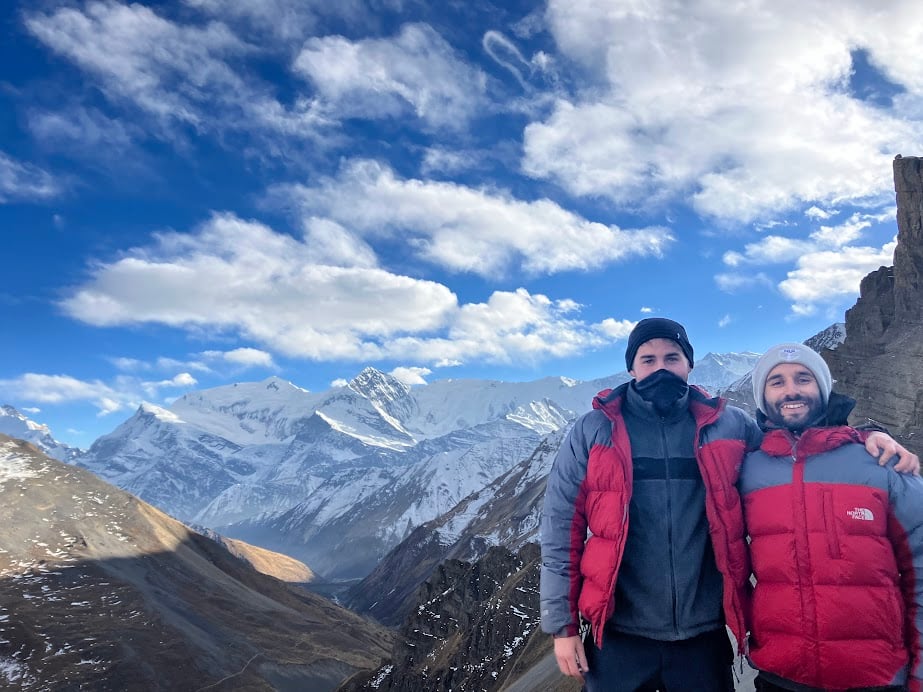
Do You Want to Travel FOREVER??
Pop your email in below to get a FREE copy of ‘How to Travel the World on $10 a Day!’.
Where is the Annapurna Region?
A household name when it comes to backpacking Nepal , the Annapurna Conservation Area covers nearly 3000 square miles of stunning terrain, and spans five districts in the central part of the country.
This includes the Annapurna massif, a monstrous range of mountains home to thirty peaks over 6000m. Here you’ll find Annapurna I , the tenth-highest mountain in the world, and the first over 8000m on earth to be summited.
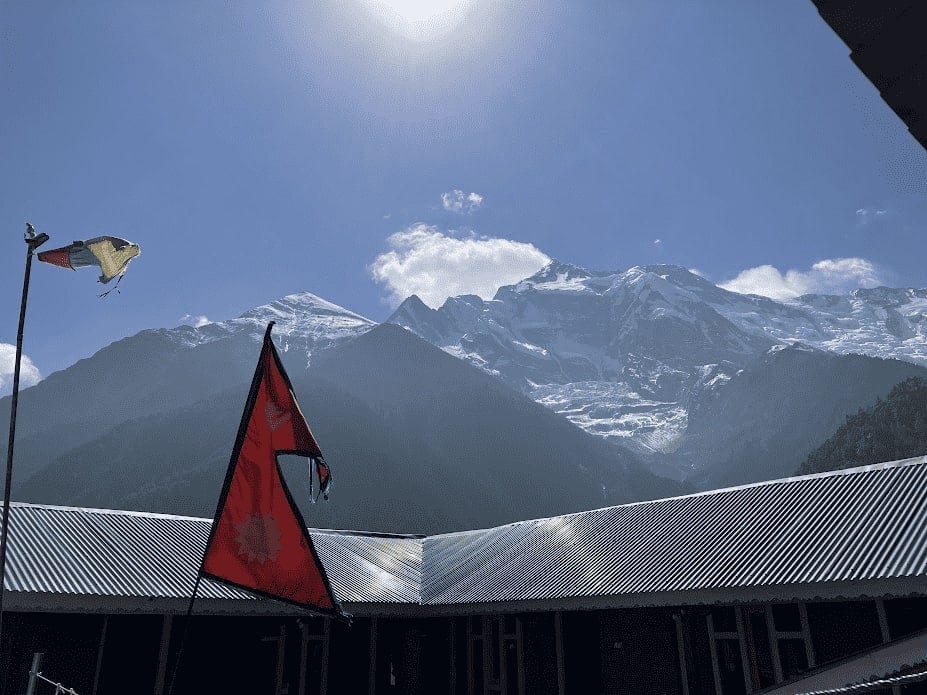
If that’s not enough, the Khali Gandaki gorge – which the Annapurna Circuit weaves through – is believed by many to be the deepest gorge in the world . Across the gorge lies Dhaulagiri , the world’s seventh-highest peak at 8167m.
As you’d expect, it’s a ridiculously impressive and unique part of the world that feels almost ethereal at times.
The starting points for most treks in the area are easily reached from Pokhara . This backpacker hangout is also an ideal place to sort your stuff. Shop for nearly-genuine but well-made outdoor equipment for your foray into the mountains, and stash any surplus travel gear while you’re away.
When is the best time to visit the Annapurna Conservation Area?
There are two main trekking seasons in Nepal: Autumn and Spring .
The Autumn season includes September, October and November , when clear skies should permit superb panoramic views of the jagged skyline. Temperatures are typically quite mild and the chances of heavy snow are relatively low. The trail and teahouses may well be quite lively. Across October, you’d also catch the festivals of Dashain and Tihar , giving rise to an abundance of kites, lights, and bamboo swings.
The Spring season covers March , April and May . As it melts, the preceding snowfall breathes new life into the rhododendrons (Nepal’s national flower), and, like Autumn, the temperatures should be manageable. The weather can be changeable, however. For example, this year, a relatively dry and mild February gave way to heavy snow and extremely nippy weather throughout March. Pack wisely, whatever season you’re aiming for.
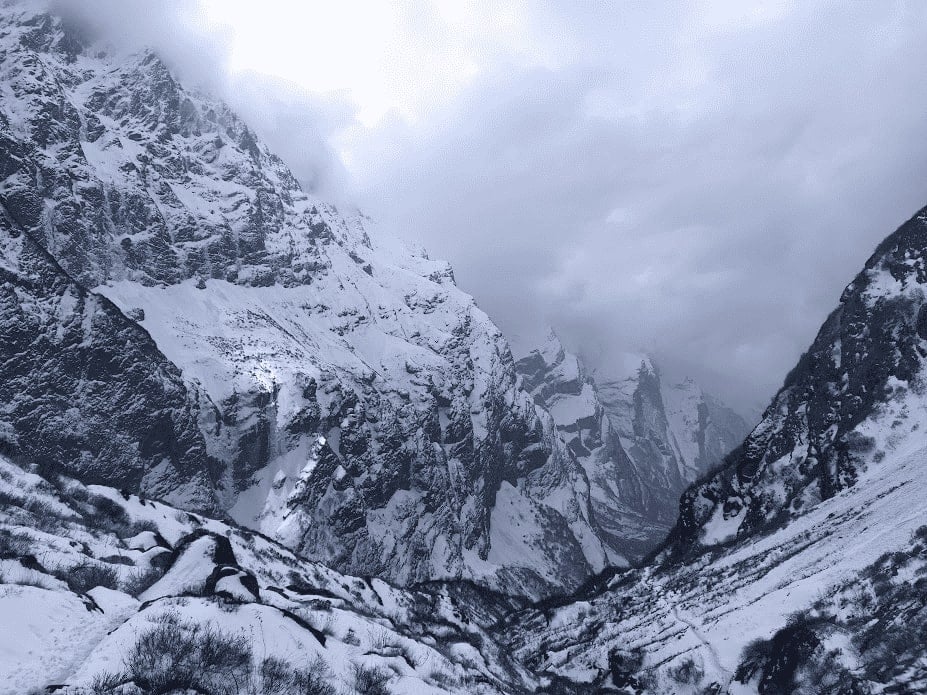
Trekking in Winter is less common, but certainly possible: December, January and February can be uncompromisingly chilly. We’re talking lows of minus 20 degrees Celsius. On the Circuit, be prepared for the possibility of days spent in teahouses waiting for the pass to reopen, and invest in a proper winter sleeping bag (read on for the low down on gear).
But there are enough teahouses that remain open to take on the treks discussed here, and your resolve will be rewarded with clear views of snow-capped peaks and a relatively empty trail.
Last and least appealing, is the monsoon season ( June, July and August) . The rains obscure the views, the trails become sodden and mudslide-y, and the leeches come out to nibble. (If you want to trek in the summertime, you’re better off heading to the Karakoram Mountains of Pakistan , the Indian Himalayan region, such as Ladakh or Himachal Pradesh, or Nepal’s Upper Mustang which is protected from the rains.)
Introducing the Routes…
I would urge you not to overthink which trek to do: the main thing to consider is time, as something like the Circuit takes a good chunk of the calendar, and it’s better not to be rushing around. Each route has its charms and challenges, which are likely to change on each and every journey on foot. Read on and see which takes your fancy.
1. The Annapurna Circuit
The Annapurna Circuit Trek is one of the most renowned and cherished trekking routes in the world, found on many travellers’ bucket lists.
First opened in the late 70s, the circuit takes you high into the Annapurna massif and right to the edge of the Tibetan plateau, crossing the Thorong La Pass at 5417m. This is one of the highest mountain passes in the world . Not too shabby.
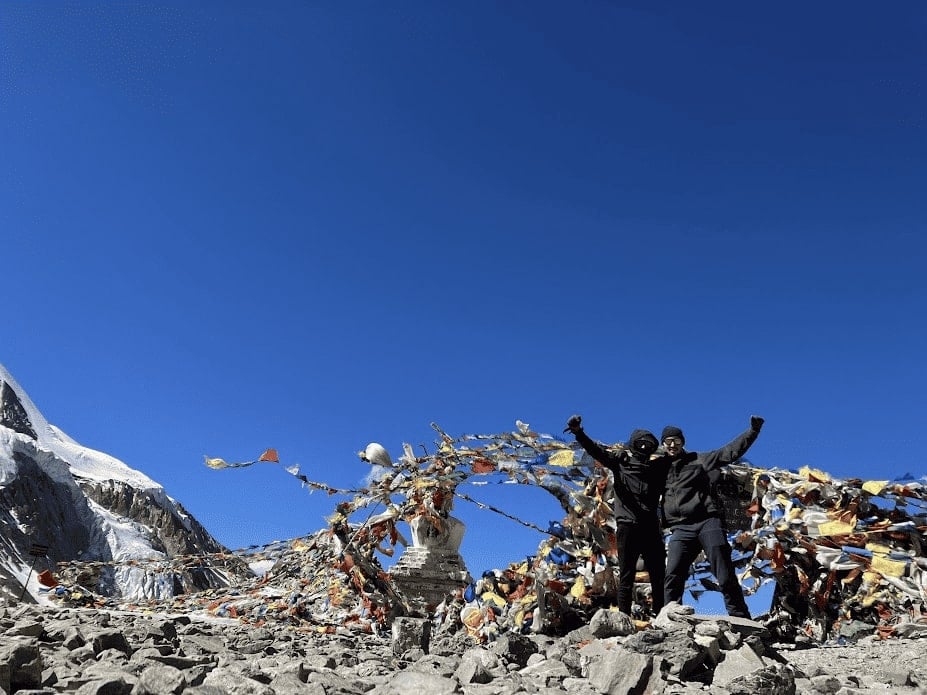
The circuit is a significant undertaking. Completing the full route usually takes around three weeks. However, this can be shortened by taking a jeep up and down the valleys either side of the pass for some of the way…
If you have time, it’s certainly worth going all in by starting in Besisahar and finishing in Nayapul. It’ll be better for both the body and gaining respect from hippie-trail hikers who did it back in the day…
Get ready for a stunning stroll: the Annapurna Circuit is a classic for a reason.
How many days does the Annapurna Circuit trek take?
The full circuit takes around 20 days, while variations on the route can massively reduce the distance covered and time taken to around 10 days.
It may be tempting to skip walking parts of the ‘road’ section, but to be honest, the traffic is usually minimal on the track and the views are still excellent so don’t be too quick to hop in a 4×4. Climbing from the original start point of Besisahar or nearby will pay dividends in terms of acclimatisation.
Suggested Annapurna Itinerary and Notes
The trail is well supplied, with teahouses scattered relatively frequently along the path. The below table contains a suggested itinerary but can also be used to plan your own, using the village names, altitude and distances between them.
Keep things flexible on your trek, both by stretching, and building in some leeway in case you need an extra day of acclimatisation (or just don’t fancy leaving the hot springs in Tatopani).
How do I visit Tilicho Lake?
On the Annapurna Circuit, you’ll have the option for an out-and-back trip to Tilicho Lake, the highest glacial lake in the world !
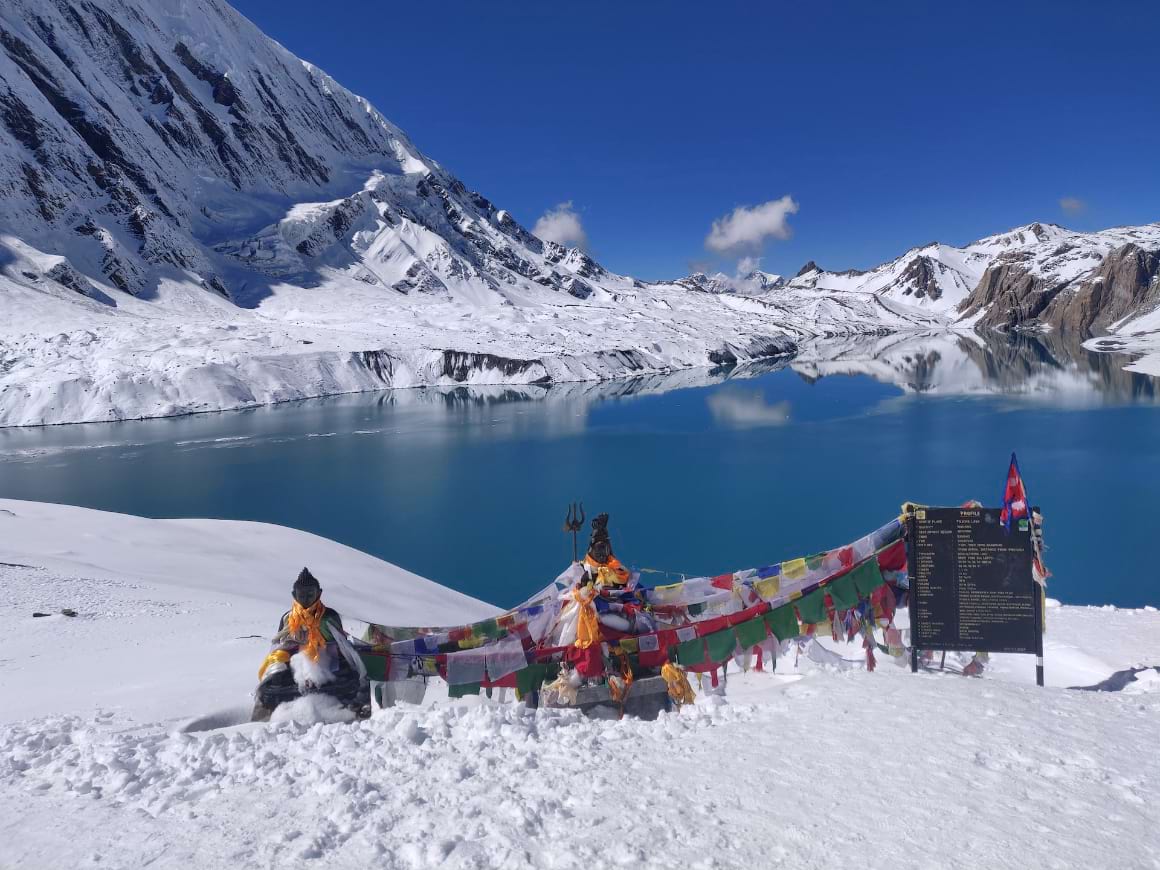
It’s not an easy side-quest. You’ll start from Manang at 3519m, and climb up to above 4900m to reach Tilicho, usually over two or three days. Along the trail you’ll find Shree Karka and Tilicho Base Camp for overnighting, as you can’t stay at the lake itself.
In winter, don’t be too surprised or disappointed if the water is frozen…it’ll still be a wicked couple of days out.
2. Annapurna Base Camp (Annapurna Sanctuary)
The Annapurna Base Camp lies right in the heart of the ‘Annapurna Sanctuary ’ which is a protected area but not an official Nepali national park .
The full trek can be completed in around a week, covering 100km and reaching 4130m, although route variations can be made.
This place is something special, both physically, and culturally. Held as sacred by the Gurung people, this glacial basin is only accessible via a thin pass between the peaks of Hiunchuli and Machhapuchhre .
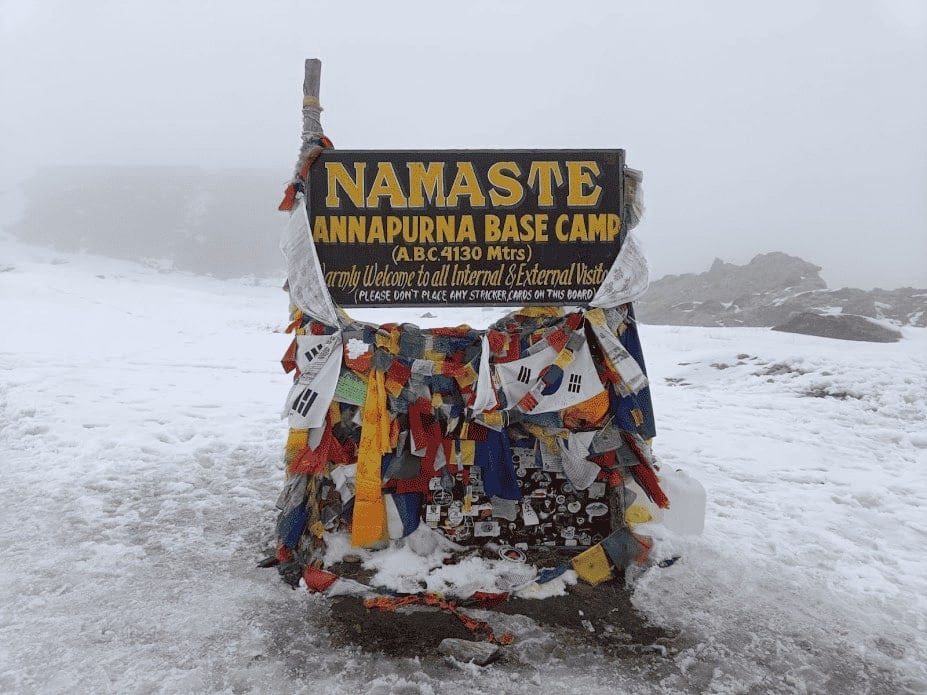
The Base Camp itself can feel quite bizarre. You’ll find statues of climbers lost on epic expeditions in years gone by, yet today, you might wake up to skiers and wedding parties being dropped off by helicopter to catch the morning sun…
However, you’ll sip your chai with a sense of satisfaction having reached this surreal spot on foot and braving the weather. Watching the sunrise hitting the dramatic skyline is a just reward for taking on this outstanding Nepali adventure.
How many days does the Annapurna Base Camp (Sanctuary) trek take?
The Annapurna Base Camp trek can take between 7-10 days, depending on fitness, whether you’ve previously acclimatised to the altitude, and route options. See the suggested itinerary below for inspiration, but don’t be afraid to use the list of villages to create your own plan (being mindful of altitude gain).
Suggested Itinerary and Notes
It would be very difficult to get lost on the Annapurna Base Camp trek, as all villages tend to lie on the single trail leading to the basin. A list of places to stay can be found below.
Popular ‘linkages’ include adding on a day at Ghorepani for a sunrise at Poon Hill, or joining the Base Camp route at Ghorepani having completed the Annapurna Circuit anti-clockwise.
These options are noted on the table below.
3. Mardi Himal
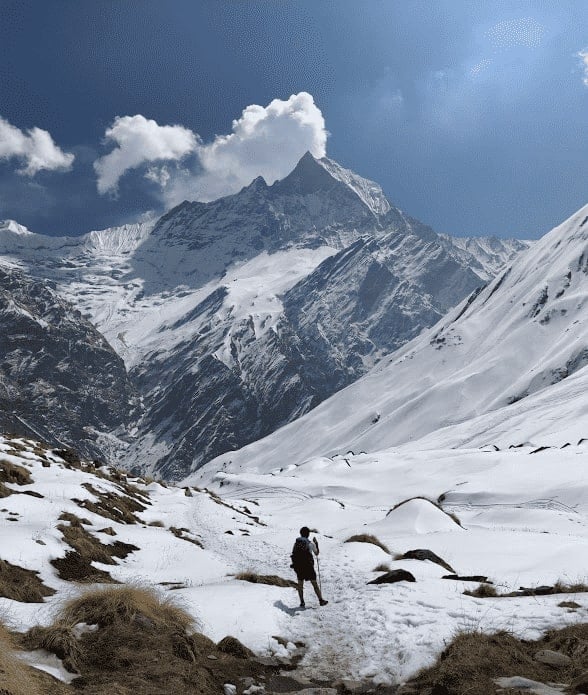
Mardi Himal is a relatively new trekking route, and it’s an absolute cracker.
On the Annapurna Base Camp trek, you look across the valley at an imposing landscape that appears unattainable. This is where the Mardi Himal route takes you.
Passing through rich rhododendron forests, you’ll eventually reach the High Camp teahouses, which seem to be dotted precariously on the ridgeline. It’s a truly remarkable place , and the final push to Mardi Himal Base Camp is equally majestic.
Plus, if you’re short on time, the trek can be completed in well under a week, and the Himalayan views are up there with the very best to be found.
What’s not to like?!
How many days does the Mardi Himal trek take?
The Mardi Himal trek is usually completed in 4 days. The elevation gain is quite fierce if you head straight from Forest Camp to High Camp, so if you’re struggling at all with fitness or the altitude, add in an extra sleep at Low Camp.
For the immersion in the mountains you’ll be rewarded with, this it’s a superb shorter trek option that’ll take you up to 4500m.
Like with the other routes discussed, you can use the following list and a paper map to devise your own plan, however, you can’t sleep at the Base Camp, so sleeping at High Camp is certainly the best option.
The itinerary for the way back just depends on personal preference and speed, but don’t go so quick you miss savouring the views.
After an early out and back to Mardi Himal Base Camp, you can then stay again at High Camp.
Alternatively, there’s certainly time to continue back down the trail towards Low Camp, or even get a 4×4 back to Pokhara that same evening from Sidhing (public bus from Lumre) if you’re speedy.
Beware, in the depths of winter or otherwise, if the snow is thick, it may well be that reaching the Base Camp isn’t possible and that the Upper Viewpoint stops you in your tracks. The trail can easily disappear in the snow and clouds, and it can become unclear what is solid ground and what is the edge of a steep drop.
Don’t take stupid risks at this point in trying to push on. Even if the viewpoint is the furthest trekkable point, it’s still super exciting being up on the ridgeline freshly covered in snow.
The Mardi Himal Trek is gaining in popularity, and rightly so. It almost feels as though you can reach out and touch Machhapuchre (‘fishtail’) from the upper reaches of the trail, while the dense forest below provides some cool variation in terrain.

We’ve tested countless backpacks over the years, but there’s one that has always been the best and remains the best buy for adventurers: the broke backpacker-approved Osprey Aether and Ariel series.
Want more deetz on why these packs are so damn perfect? Then read our comprehensive review for the inside scoop!
A Few Other Options in Annapurna Region…
Here’s a quick overview of some other trekking routes in the region to consider. There are so many ridiculous spots in this area, grab a map and head somewhere – it’s likely to be a winner.
4. Manaslu Circuit
An epic 12-14 day excursion over the Larke Pass, reaching 5100m . This route is more expensive than the Annapurna Circuit, as additional permits are required.
These include the Annapurna Conservation Area Permit (needed for the ABC, ACT and MH treks too), the Manaslu Conservation Area Permit (MCAP), and a Restricted Area Permit (RAP). During the Autumn season (September to November), the RAP is $100 for the first week and then $15 for each extra day in the restricted area.
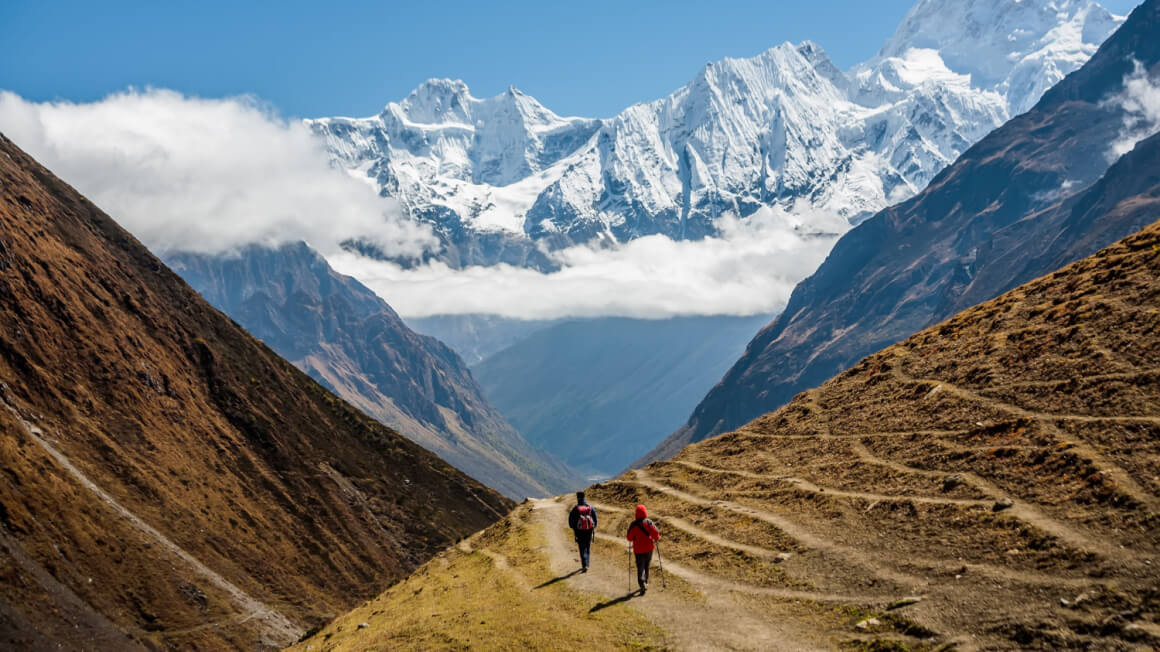
These figures are lowered to $75 and $10 for the rest of the year. It’s also rightly essential to take a guide on this route – this was always the case, well before the recent rule changes, due to the area being restricted and more remote than other routes.
If you’re able to shell out for the permits and guide, this beast of a trek is guaranteed to be a grand adventure.
5. Poon Hill
Poon Hill is an introductory-level trek, over 3 or 4 days. The climax is waking up early in Ghorepani to witness sunrise at Poon Hill, offering panoramic views of both Annapurna and Dhaulagiri.
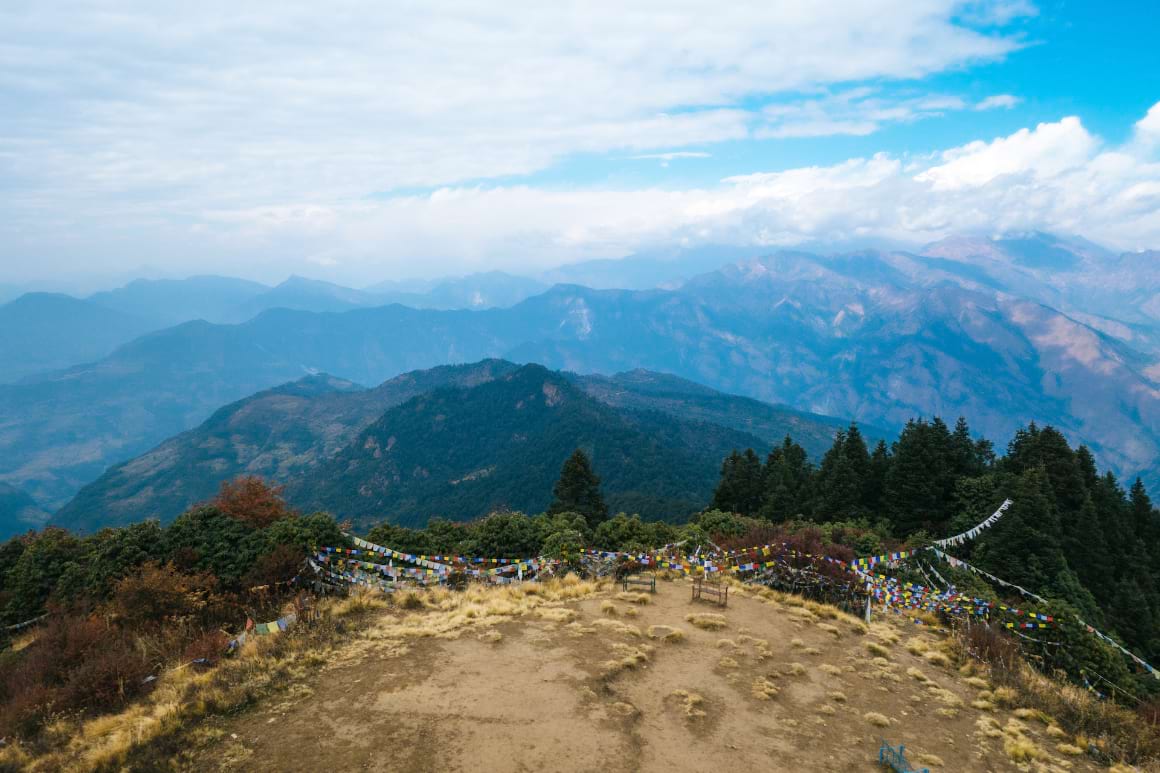
Be ready for a chunky number of stairs on the first day from Nayapul, and some potentially busy trails: this route can become quite a highway in busy season. But if you’re short on time or new to trekking, the reward/effort ratio is strong as the views are still spectacular.
6. Mohare Danda
A fantastic alternative option for a short trek, just outside the Annapurna Conservation Area, which requires no permit or guide! The route is much more off the beaten path than the likes of Poon Hill, which means quieter trails, more peace and lower costs. It is outside the Annapurna Conservation Area, but still affords enviable views of the Himalayan ranges.
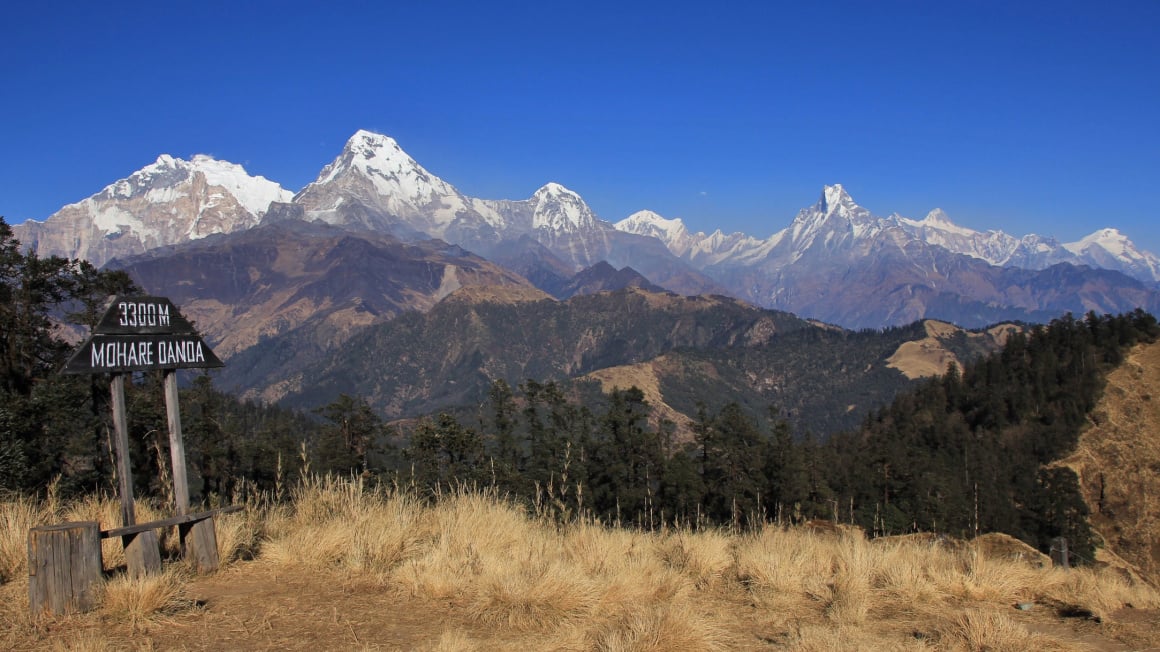
This 3-4 day route is reached from Pokhara by taking a bus to Beni. The trek peaks at the 3300m station of Mohare Danda (‘Danda’ is equivalent to hill in Nepali) for a scenic sunrise across Annapurna and Dhaulagiri. Finish in Tiplyang (buses run back to Pokhara).
This local outing should not be overlooked!
Once you’ve got the hang of it, why not try and construct your own route? Be mindful of the permit zones – this is easier outside of the Annapurna Conservation Area – but don’t be afraid to head to places off the tourist trail.
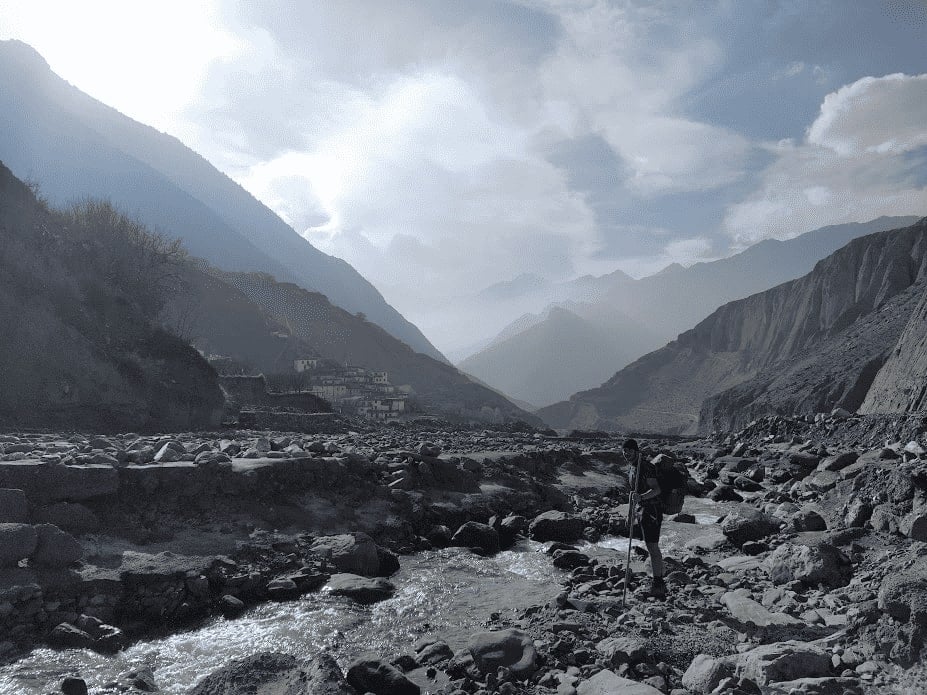
Spending 10 days on foot in the mid-hills between Pokhara and Kathmandu was one of the best travel experiences I’ve ever had. The kindness of Nepali villagers means you’ll be treated like family, and after your trip, longing to return soon!
Permits, Rules and Regulations
In April 2023, new rules were introduced that compel all trekkers to hire a guide when undertaking treks in the Annapurna Conservation Area. This decision was made citing (reasonable) safety concerns for FITs (‘free independent trekkers’), but remains controversial. This means there are three things to sort out for the routes covered in detail here: a TIMS card , an ACA permit , and a guide .
On the usual trekking trails, there are ‘checkpoints’ in certain villages, where you’ll have your ACAP permit checked and stamped (this has always been the case, before the new rules were introduced).
You must obtain this permit before starting the trek, at the Immigration Offices in either Pokhara or in Kathmandu (opening hours are reduced during off-seasons; check on the door in advance of your trek). This is also where you’ll grab your TIMS card. Take your passport, insurance policy details, and passport photos if you have some (if not, you can usually get them taken in the office for free).

The ACAP costs 3000 rupees and the TIMS card 2000 rupees, for a total set-back of around $38.
In addition, hiring a guide can cost between $20-40 per day, meaning the new rules add greatly to the backpacker’s budget.
On one hand, the news rules seem to benefit trekking agencies. On the other hand, many teahouses and local restaurants are concerned less FITs will lead to reduced income for their businesses and families.
However, some trekkers have recently been completing the circuit independently, and reported having no issues at all when getting their permits checked, despite being guideless. This is obviously not guaranteed, and the situation is likely to evolve over the coming months and seasons.
The Annapurna Circuit Trek group on Facebook is a useful source for the latest deets on what’s happening week-by-week .
Here are some commonly raised pros and cons of hiring a guide:
- You’ll gain added insight into Nepalese culture and history.
- You’ll have experience and expertise on hand for navigating more risky areas like the Thorong La Pass.
- Guides will usually help organise permits and the trekking itinerary – less admin for you.
- Significantly increases daily costs (extra $20-40 per day).
- Limited flexibility on schedule in case of altitude sickness or individual preference (particularly if in a group).
- Guides often have deals with tea-houses that may limit your choice.
Preparing for your Annapurna Trek
Preparing for a big trek may seem like a daunting task. There are things to prepare, like gear, route-planning and some permit-related admin.
Fortunately, you don’t need to be a sponsored athlete, master orienteer or avid form-filler to swiftly get your ducks in a row and be ready to head high into the mountains.
Aside from gear, it’s also extremely important to be aware of weather conditions before hitting the trail or even starting the trek. On 14 October 2014, a record-breaking storm dumped nearly 1.8 meters of snow in the Annapurna region which led to a series of devastating avalanches that resulted in the deaths of at least 43 people, 21 of these trekkers.
While mountain weather can change quickly, I highly recommend having a satellite device with you, and to ensure you get updates on conditions at each teahouse you stop at.
What should you pack for Annapurna trekking?
Firstly, if you’re reading this on the bus and realise you’ve left something at home on the bed, rest assured you can find all you need for trekking at the shops in Pokhara or whilst backpacking Kathmandu .
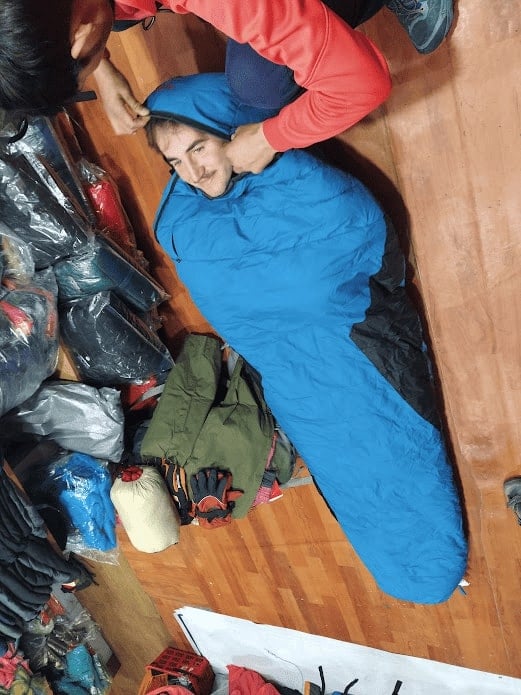
What to pack exactly will depend on personal preference and weather. Use the list below as a checklist.
A word of warning/comfort: don’t pack a different t-shirt for every day, there’s simply no need.
If desired, you can hand-wash items along the way and dry them above the fire in a teahouse, but nearly everyone stinks to high heaven by around day eight, so don’t overly stress. You’ll be in good – probably nose-blind – company.
If you’re looking to make a long-term investment in some clothing for multi-day hiking, check out merino . It’s a breathable, temperature-regulating and odour-resistant blessing for backpacking in colder climates.
There’s usually a healthy supply of gear circulating in the hostels on Lakeside, with backpackers selling, trading or giving away items after finishing their treks. Kiwi Backpackers Hostel on 5th Street is a hub of backpacker activity, and one of the best hostels I’ve ever stayed in.
What to Pack for an Annapurna Trek:
Here’s exactly what you should bring on any trek in the Annapurna Region.
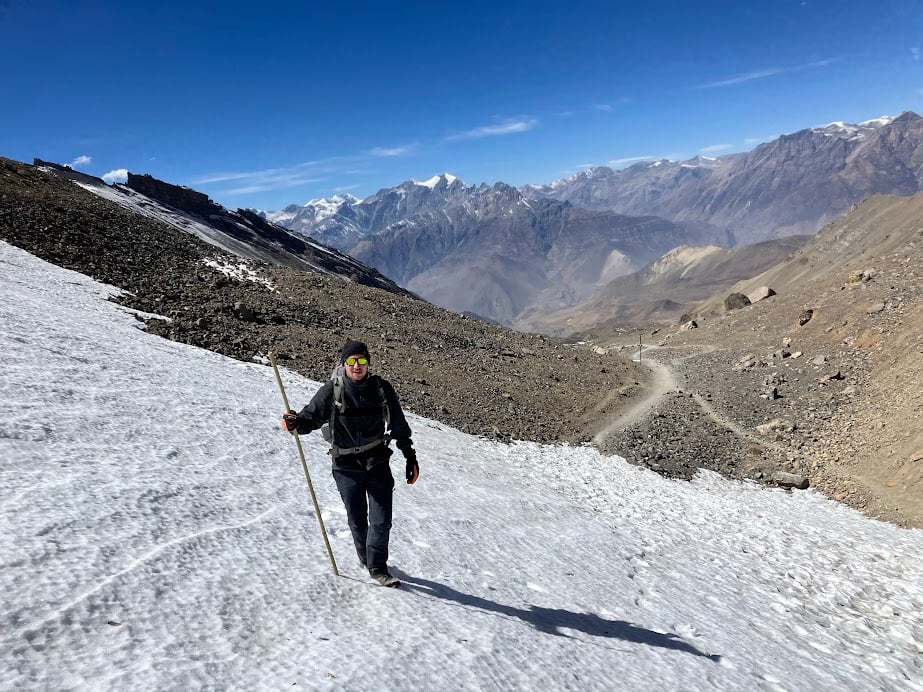
- Osprey Aether Backpack : Sturdy and comfy, with good support and a rain cover. It’s truly the best pack out there.
- Clothing : (Ideally) lightweight, quick-drying shirts, trousers, and shorts.
- Base layers : It can be numbingly chilly at the high points of each route.
- Mid Layer(s) : Go for fleece or soft shell.
- Arc’teryx Beta AR Jacket : Or hiking poncho (good for keeping cool).
- Waterproof Trousers : Ideally can be put on over shoes.
- Patagonia Down Sweater Hoodie : Like a portable hug.
- Hat and Gloves : Sun hat if desired; warm beanie and gloves for higher elevations.
- Abaco Sunglasses : Protect your eyes!
- Water Bottle(s) : At least two litres of capacity.
- Marmot Never Summer Sleeping Bag : Rated at 0F and -18 C, you can’t be better prepared than with this epic bag.
- Water Treatment : Purification tablets or a water filtration system (like the Grayl Geopress).
- First Aid Kit : Grab basic medications and blister treatment from a pharmacy before leaving. Consider Diamox (see altitude section).
- Lip Balm : Chops may otherwise become drier than a moth sandwich.
- Headtorch : With spare batteries/ charger. A real adventure isn’t complete without one.
- Sunscreen : High SPF for sun protection.
- Hanging Toiletry Bag : Toiletries themselves are cheaper in Pokhara than on the trail.
- Physical Map : Found all over the place (shops, hostels, etc).
- Micro Fibre Towel : Compact, dries fast and gets the job done.
- Footwear : More to follow…
- Black Diamond GTX Gaiters : Particularly if wearing low-rise walking shoes or trail runners.
- A good travel camera : The scenery justifies the extra weight.
- Black Diamond Carbon Trekking Poles : Can be an absolute boon on uphill sections. Alternatively, pick up a sturdy bamboo stick en route, with which you will become inseparable.
- Kahtoola Microspikes : ‘Micro-spikes’ can be found cheaply in Pokhara. Highly recommended in Winter.

Wanna know how to pack like a pro? Well for a start you need the right gear….
These are packing cubes for the globetrotters and compression sacks for the real adventurers – these babies are a traveller’s best kept secret. They organise yo’ packing and minimise volume too so you can pack MORE.
Or, y’know… you can stick to just chucking it all in your backpack…
Can I rent rather than buy gear for my Annapurna Trek?
Yes ! The trekking shops on Lakeside in Pokhara and Thamel in Kathmandu will allow you to rent all sorts of gear without breaking the bank.
A down jacket and sleeping bag will each cost around 150-200 rupees to rent per day ($1.15-$1.50), and if you want to stay out in the mountains for longer than planned, you can usually just pay the difference on returning. (Just in case, take photos of the condition of the gear you hire as you leave the shop.)
What footwear is best for Annapurna trekking?
A hotly debated topic.
What type of footwear to go for is largely down to personal preference, within the reasonable bounds of frostbite prevention.
Hiking boots are the most popular choice, as they provide top-notch ankle support, superior weatherproof protection in case of snow, and shielding from rocky ground beneath. Be sure to wear them in advance though, to prevent a blistery first few days on the trail.
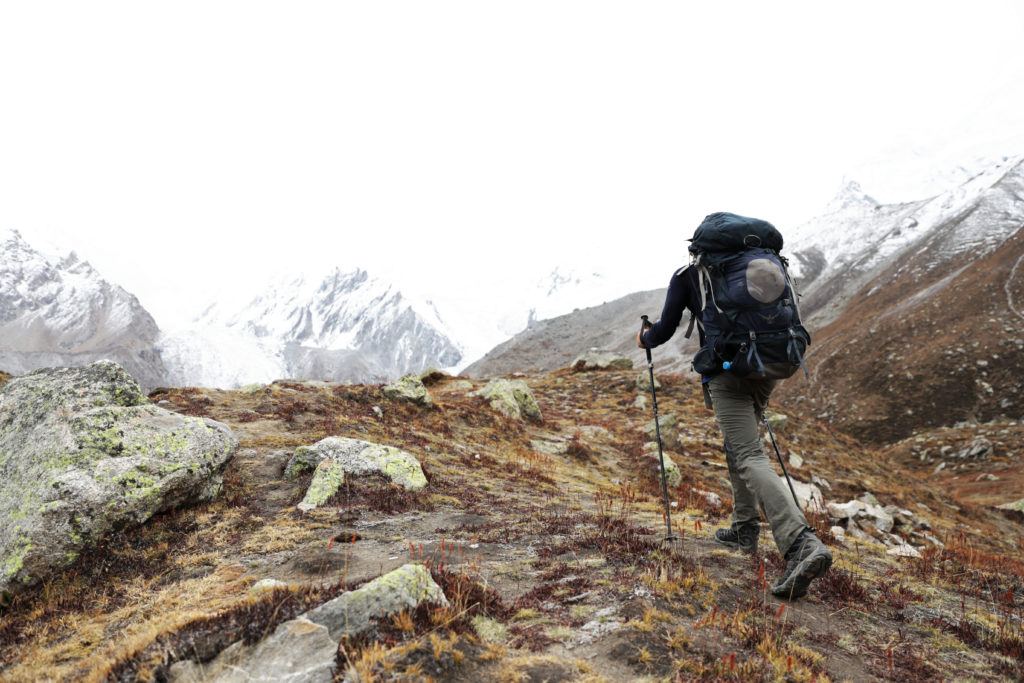
Boots are a shrewd choice. However, they can feel clunky, and you may find yourself hankering for something more nimble.
An increasing number of trekkers are using trail running shoes, when not in the depths of winter. A pair of waterproof (look for Gore-tex) trail running shoes can provide solid support while remaining light and agile. You’ll want a pair with deep treads (grip) on the sole and a sturdy construction. Combine with a pair of gaiters in case of snow.
Chuck in some flip-flops/ jandals/ slippers for downtime in the teahouses. Your feet will be eternally grateful.
Why You Should Travel With a Water Bottle
As travellers, we have a joint responsibility to reduce the environmental impact of our excursions, and plastic waste is one of the biggest problems facing Nepal’s Annapurna Region.
Travelling with a filtered water bottle is a wise move. There’s no better option than the Grayl Geopress: this water bottle and filter system removes all manner of threat, including viruses and heavy metals – no mean feat. This bottle is a popular choice amongst trekkers and backpackers in Asia.
It’ll last for years, reduce plastic waste, and save you money. The Grayl Geopress is a sound investment for anyone taking on some Annapurna trekking.

Drink water from ANYWHERE. The Grayl Geopress is the worlds leading filtered water bottle protecting you from all manner of waterborne nasties.
Single-use plastic bottles are a MASSIVE threat to marine life. Be a part of the solution and travel with a filter water bottle. Save money and the environment!
We’ve tested the Geopress rigorously from the icy heights of Pakistan to the tropical jungles of Bali, and can confirm: it’s the best water bottle you’ll ever buy!
Life on the Trail
Are there places to stay on an Annapurna Trek?
On all treks discussed in this guide, there are a plethora of accommodation options available. This means you won’t need a tent or shelter to take on these Annapurna treks. Luxury!
These are in the form of teahouses – some large, some small – and you’ll find them in the villages along the trails, plus some extras dotted in between.
What’s more, your room for the night is usually offered very cheaply or even for free, provided you eat dinner and breakfast at the teahouse where you stay. Here are a few things to keep in mind when choosing your residence for the night:
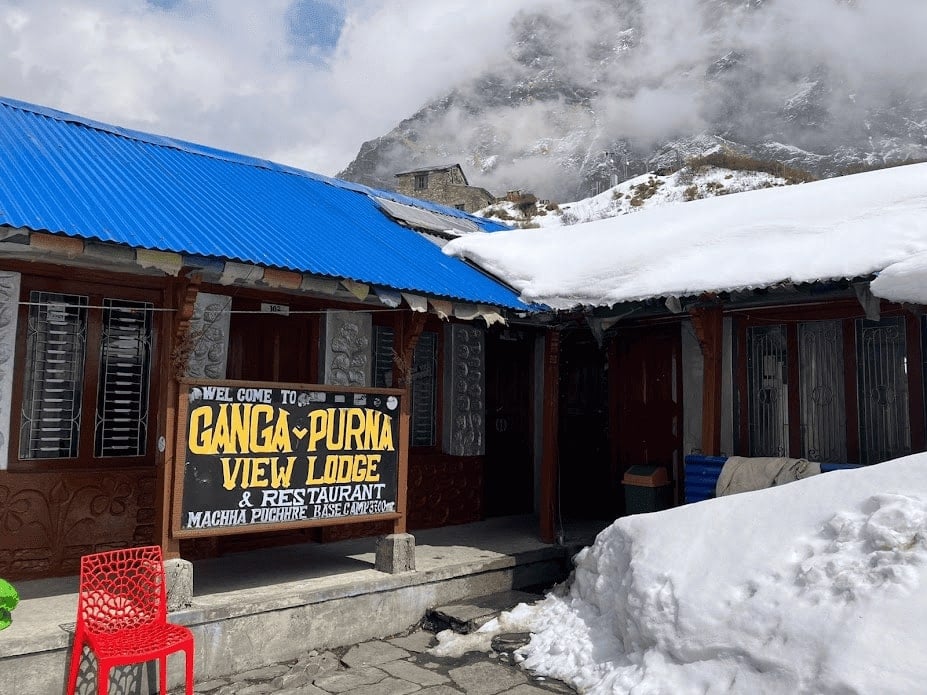
- Check out the views for sunrise and sunset!
- Ask if using a hot shower, wi-fi and e lectricity is available and included in the rate agreed, or whether you’d have to pay extra. You can often strike a ‘package deal’ if you chat to the owner.
- If it’s cold, a fire to sit around is an unrivalled treat. (Even if it’s a yak dung inferno..)
- Of course, the price !
You’ll be given a simple private room for the vast majority of stays, which come with beds, blankets and pillows.
You’re more likely to get a plug socket at lower altitudes. Otherwise, there’ll probably be a shared extension cable in the kitchen area but you may have to pay.
Gas-heated showers can be found throughout the treks, except near the highest points of each route. Toilets are a mix of squat style toilets and Western designs, but take your own loo roll! It grows crushingly expensive further up the hillside, and splashing your behind from a bucket of icy shards in the early hours might not be ideal.
Sitting round the table in a teahouse after a long day’s trek is a quintessential part of a Nepali trekking experience; playing cards and sharing tales with locals and fellow travellers is sure to leave lasting memories to treasure.
What food is available while trekking in the Annapurna Region?
The Nepali word ‘Annapurna’ can be translated as ‘everlasting food ’, which certainly seems fitting when it comes to Dal Bhat.
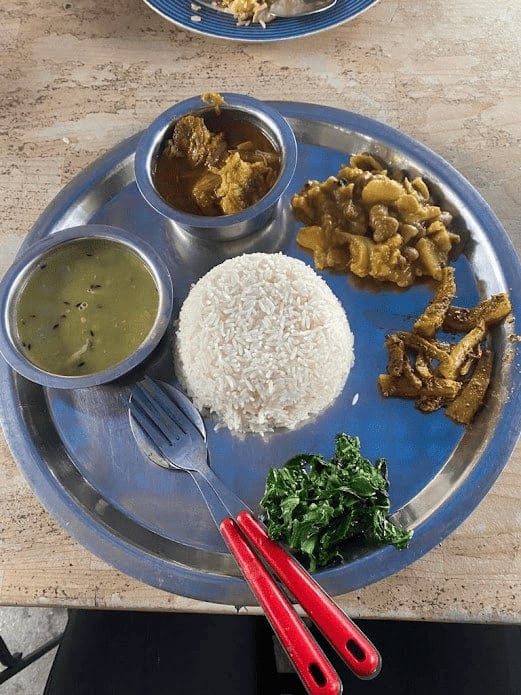
This national dish is a staple for people all across Nepal, and is likely to become a dearly treasured feed when trekking in the Annapurna region.
Dal bhat consists of steamed rice paired with dal (cooked lentils or other pulses), accompanied by a varying array of saag (spinach cooked in spices), papad (poppadom), vegetable tarkari (seasonal vegetables) and pickle amongst other things. You can order small bowls of meat to go with it too.
And, in very healthy news for us lovers of value, most elements of dal bhat can be replenished at no extra cost!
You’ll also find things like fried rice, noodle soup, curry and even some surprisingly good pizza, cooked on a stove. Try thukpa, a classic Nepali noodle soup with a warm broth.
Porridge, omelettes and toast are all usually there too. At least once, give ‘Tibetan bread ’ (or ‘Gurung bread ’) a go, with honey. For breakfast, this is an absolute triumph.
Food is expectedly more pricey than in Pokhara but not outrageously so. See an example menu below, typical of those found on the Annapurna Base Camp trek. For reference, one US dollar is currently equal to around 130 Nepalese rupees.
Dealing With the Altitude While Trekking in Nepal
Trekking in the Annapurna region naturally means you’ll be dealing with some serious loftiness.
For example, Thorong La – the pinnacle of the Annapurna Circuit – is just about the highest mountain pass in the world .
The sub-par oxygen levels found here are likely to have some kind of effect on all trekkers, and the severity of its impact doesn’t seem to be linked to physical fitness. Your gym-obsessed mate could find themselves back of the pack, being overtaken by heavy smokers flying up the hills.
While it’s a bit of a lottery in that sense, there are things you can do to reduce your risk of feeling groggy or worse, which I’ll cover here. Altitude sickness is not something to mess about with, and one of the most dangerous aspects of Nepal , so here’s a breakdown of some key tips and information surrounding AMS , HACE , and HAPE .
What is altitude sickness?
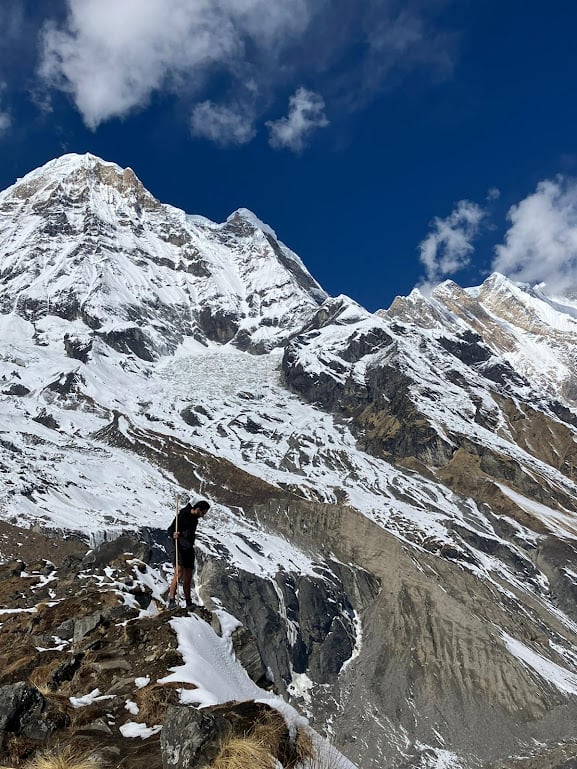
Altitude sickness essentially refers to the ill effects on the body of being exposed to lower levels of oxygen.
Acute mountain sickness (AMS) is the mildest form of altitude sickness, but should certainly not be ignored. Symptoms include:
- Nausea/vomiting
- Loss of appetite
If these crop up, it’s important to STOP ascending. Acclimatisation and rest can give the body sufficient time to adjust to the conditions, before continuing with care.
On the other hand, the more serious high-altitude pulmonary edema (HAPE) and high-altitude cerebral edema (HACE) require rapid descent, and are life-threatening emergencies. HACE refers to fluid buildup in the brain, while HAPE refers to fluid buildup in the lungs.
Symptoms of HACE include:
- Severe weakness
- Acting drunk
- Personality changes
- Balance issues
Symptoms of HAPE include:
- Pink sputum
- Breathlessness at rest
Keep an eye on each other and report any symptoms to mates and locals at teahouses. HAPE and HACE require immediate attention. Descend down the mountain right away, while limiting physical exertion as much as you can while doing so.
How to Minimise Risk of Altitude Sickness:
As mentioned previously, developing symptoms of altitude sickness when trekking is seemingly unrelated to overall fitness. However, there are things you can do to reduce your risk. Here are some tips for trekking in the Annapurna region:
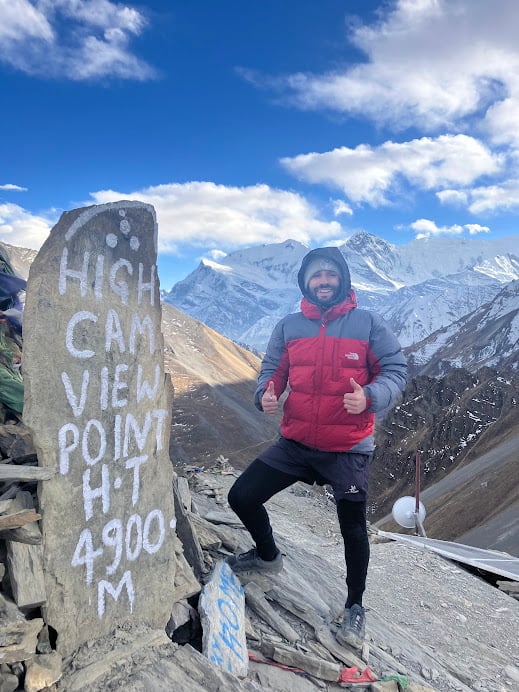
- Limiting daily ascent when above 2500m is the best way to reduce your risk. Ascending no more than 500m a day is optimal, while more may be manageable for some. It’s quite common for trekkers to climb more than this in a day on occasion , but be careful in doing so, and be sure to stop and rest for a day or more if you develop symptoms.
- Drink loads of water ! Increase your intake as you ascend.
- Consider using Diamox (acetazolamide). This is by no means essential, but taking Diamox a day or two before ascending to high altitudes can speed up acclimatisation. (If you have any other health conditions, check with your doctor before doing so). Side effects can include tingling fingers and lips – a quite odd, but not particularly troublesome sensation.
- Keep plans flexible to build in any acclimatisation days that become necessary.
- Walk high, sleep low ! Walking to a new ‘high point’ but sleeping below it when possible can be great for your body.
- Look after your mates ! Check in on one another and keep an eye out for anyone struggling or showing changes in personality.
Getting Insured BEFORE Trekking Annapurna
Altitude sickness is no joke. Make sure you’ve got some good travel insurance before heading up there!
ALWAYS sort out your backpacker insurance before your trip. There’s plenty to choose from in that department, but a good place to start is Safety Wing .
They offer month-to-month payments, no lock-in contracts, and require absolutely no itineraries: that’s the exact kind of insurance long-term travellers and digital nomads need.

SafetyWing is cheap, easy, and admin-free: just sign up lickety-split so you can get back to it!
Click the button below to learn more about SafetyWing’s setup or read our insider review for the full tasty scoop.
How Much Does it Cost to Complete an Annapurna Trek?
This will greatly depend on whether you opt for a ‘package tour’ or not.
For broke backpackers, going without a tour is certainly the more budget-friendly option, and you can easily meet trekking mates on the route itself, or in hostels before setting off.
Without a package tour, a decent budget is around $25-30 per day , excluding the cost of hiring any gear and a guide . Rooms are very cheap ($2-3 per night) or even free when you eat there, so the main daily costs go on calories and any toiletries.
A guide costs around $20-35 a day, which can be shared amongst a group.
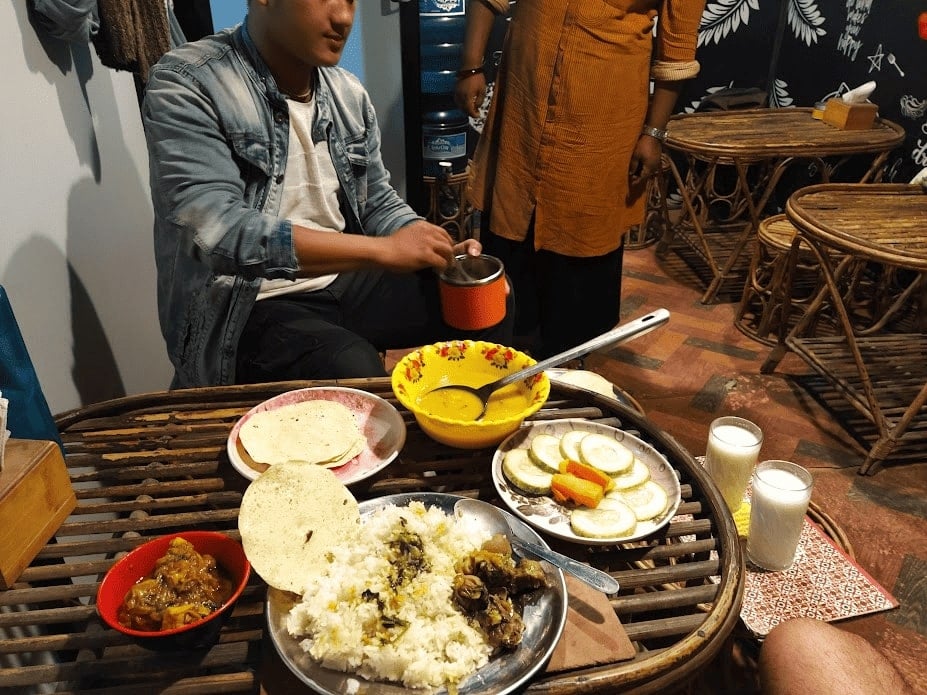
There are no ATMS on the circuit – take more cash than you think you’ll need! You never know if you might need an extra day of rest due to altitude, or fancy the occasional beer. (My mate and I didn’t heed this advice, got addicted to Snickers, and ended up with a budget of $7 each for the last couple of days, which was far from ideal.)
Another key money-saving tip: take your own loo roll! Its price seems to rise exponentially with the trail.
Overall, trekking in the Annapurnas isn’t a great deal more expensive than backpacking in other parts of Nepal, largely thanks to the generous portions of Dal Bhat served up of an evening.
Nepali Customs and Phrases
Travelling in Nepal is an immense privilege. Along with some introductory Nepali to get to grips with, here are some tips to help you remain a conscientious rambler.
- Order food together , and if asked, make breakfast choices the night before. This will reduce the amount of fuel needed to heat food.
- Minimise plastic waste! Take a filter bottle instead of buying water as you go.
- Ask before taking photos of anyone.
- Reduce your meat intake, as most is not fresh and carried up the mountains from lower villages.
- Learn some lingo!
Nepali is not a particularly difficult language to learn for English speakers, especially for a handful of essential phrases. Make an effort and it’ll be hugely appreciated!
- Namaste = hello/ greetings (polite).
- Dhanyabaad = thank you.
- Kasto cha = how are you?
- Ramro cha = it is nice/ beautiful/ good.
- Baya tira = leftwards.
- Daya tira = rightwards.
- Bhaato = ‘path’ or ‘way’.
- Mitho = tasty/delicious.
- Deraye = very (e.g. Deraye mitho = very tasty).
- Pheri bhetaula = see you again.
- Kukhura ko maasu = chicken meat.
- Bhaisi ko maasu = buffalo meat.
- Pani = water.
- Tarkari = vegetable curry.
- Shauchalaya = toilet.
- Kati tadha = how far?
- Tapaaiko nam ke ho ? = what is your name?
- Mero nam —– ho . = my name is ——.
- Bhetera khoosi laygo = nice to meet you.
Final Thoughts on Trekking the Annapurna Circuit
Stuck in a rainy city, fantasizing about booking that travel extravaganza, your mind might conjure up images of pristine beaches and pina coladas. ‘Landlocked’ may not seem conducive to your dreams of a blithe, hostel-hopping existence…
But trust me: central Nepal is as laid back and inviting as anywhere on the planet, offering a simply unrivaled combination of its superb lakeside hostel scene and the best mountainous scenery around. The fact this guide is full of “ Xth biggest/longest/tallest in the world ” says enough in itself.
Memories forged on the trails over endless portions of dal bhat and games of cards are bound to be precious, as are any moments spent in the company of the ever-hospitable Nepalese people. The routes featured in the guide have been found on backpackers’ bucket-lists for generations, for very good reason.
Backpacking has changed greatly in many places in recent years, as mobile data and online bus booking systems abound. Traveling on foot through the mountains, with an actual, physical, paper map is a uniquely gratifying experience that no technological advancement can replace.
Trekking in the Annapurna Region -whether you choose the classic Annapurna Circuit or one of the other majestic options – is guaranteed to be an epic adventure that you should not think twice about booking!
Just don’t forget to wear in your boots first…
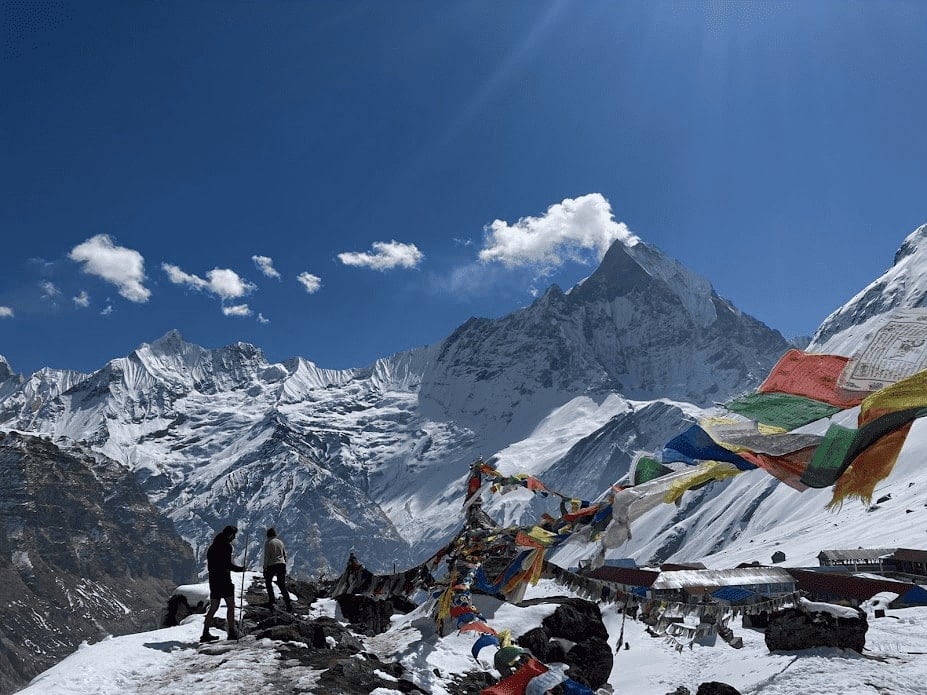
And for transparency’s sake, please know that some of the links in our content are affiliate links . That means that if you book your accommodation, buy your gear, or sort your insurance through our link, we earn a small commission (at no extra cost to you). That said, we only link to the gear we trust and never recommend services we don’t believe are up to scratch. Again, thank you!
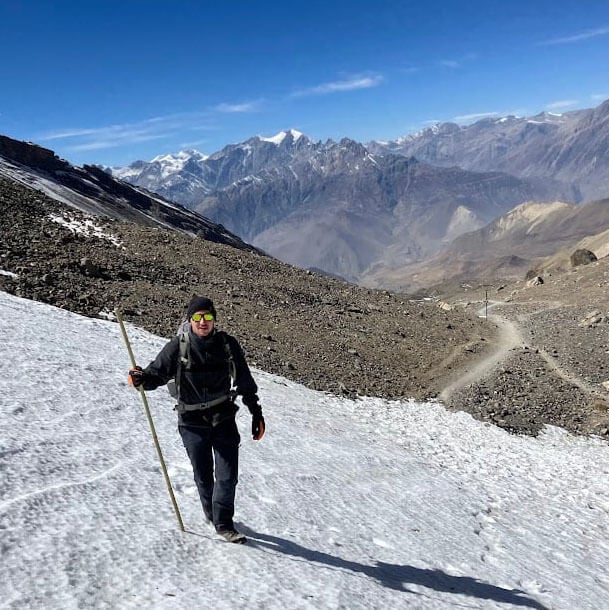
Share or save this post

Leave a Reply Cancel reply
Your email address will not be published. Required fields are marked *
Save my name, email, and website in this browser for the next time I comment.
Notify me of followup comments via e-mail.

Annapurna Circuit Trek
Planning to trek the annapurna circuit in nepal a great decision here's everything you need to know before your annapurna trek, including trekking permits, hiking solo vs in a group, what to pack, when to go, and all the money matters..
Annapurna Circuit Trek is a popular classic trek of Nepal. Each year, more than 60,000 trekkers come for this trek from all around the globe. In this trek, you encircle the Annapurna massif and cover between 110-130 miles by walking.
The Annapurna Circuit trek usually takes about 14–21 days, leaving from Kathmandu with a stopover in Pokhara before returning to the capital. The trail is moderate to fairly challenging and makes numerous river crossings over steel and wooden suspension bridges.
Our 19 days Annapurna Circuit Trek begins from Besisahar. You begin your trek alongside Marshyangdi river all the way to its waterhead beyond Annapurna range. You then enter into Manang, cross the famous Thorong La Pass (5,416 m) and go down to the restricted region of Mustang.
After visiting some popular settlements of this semi desert-like region, you travel a few hours in a bus and trek to Poon Hill viewpoint.
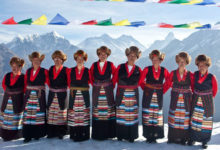
Annapurna Circuit Itinerary has often been voted as the best long-distance trek in the world, as it combined, in its old full form, a wide variety of climate zones from tropics at 600 m asl to the arctic at 5416 m asl at the Thorong La pass and cultural variety from Hindu villages at the low foothills to the Tibetan culture
There are two types of trekking permit required by anyone wishing to do the Annapurna Circuit trek. No matter when or how you’re hiking the Annapurna Circuit, you’ll need to organise both a Trekking Information Management System (TIMS) permit, and an Annapurna National Park Permit (sometimes also known as the Annapurna Conservation Area Permit).
As of 2019, the permits should set you back about USD $50 total: the APC Permit is USD $30 / NPR 3,000 per person, while the TIMS Permit is USD $20 / NPR 2,000 per person.
Since the trail opened in 1977, most trekkers have followed an Annapurna Circuit itinerary that begins in Besishahar and heads in an anti-clockwise direction over the Thorong-La Pass and down into the Jomsom Valley.

Special Note for Annapurna Circuit Trek
Facts about annapurna circuit trek:, annapurna circuit trek highlights.
- The peaceful and pristine nature trip.
- Witness stunning views of Annapurna, Lamjung Himal, Dhaulagiri, Nilgiri and more.
- Stay in tea-houses of small villages.
- Cross highest pass – Thorong La Pass(5,416m).
- Visit Muktinath, other holy temples, and monasteries.
- Explore beautiful villages of Braga, Manang, Kagbeni, Jomsom, and Marpha.
- Gaze at the breathtaking Annapurna range from Poon Hill.
- Natural Hot spring at Tatopani.
- Enjoy the lively evening of Pokhara.
- International & domestic airport transfers as per the itinerary.
- 2 nights accommodation in Kathmandu with Bed and Breakfast plan.
- 2 nights accommodation in Pokhara with Bed and Breakfast plan.
- 18 breakfast, 14 Lunch, 15 dinner during the trip.
- Kathmandu Sightseeing by professional English speaking tour guide.
- Kathmandu – Pokhara – Kathmandu domestic flight.
- Pokhara – Jomsom – Pokhara Flight.
- 3 meals a day during the trip (Breakfast, Lunch & Dinner) as mention in itinerary.
- Accommodation while trekking in twin sharing basis in guesthouses.
- Annapurna conservation area permit and TIMS card.
- Upper Mustang Restricted area permit fee.
- Professional government license holder English speaking trekking guide.
- Sleeping bag and duffel bag during the trek. (Refundable after finish the trip)
- Medical supplies (first aid kit will be available).
- 1 farewell dinner in Kathmandu
- All government and local taxes.
- All entrance fees for sightseeing places
- Alcoholic, hot and cold drinks.
- Your international flights
- Nepal visa fees & airport taxes
- Personal travel insurance (strongly recommended)
- Gear or equipment for your trek
- Personal expenses along the trek
- Tiji Festival Camara fees, and other donation
- If you would like to ride on pony
- Tips for your city guide, drivers, hotels, restaurants, etc.
- Extra night accommodation then mention plan
How difficult is the Annapurna Circuit Trek?
Is annapurna circuit dangerous, do i need a sleeping bag for annapurna circuit, is there any luggage limit for porter, do i need vaccinations for this trip.
When to Go Annapurna Circuit
Monsoon season in Nepal is June through September. That’s when most of the rain falls and when rock and mudslides are most likely to occur. The spring, between mid-March and mid-April, is when the rhododendron forests bloom, but the weather is still wet this time of year and the leeches are a nuisance at lower elevations.
The best time to do the Annapurna Circuit is October, thanks to reliably pleasant weather (80°F and humid at 2,000 feet; 20°F and dry at 17,000 feet) and clear skies.
Annapurna Circuit Trek Difficulty
The path reaches its highest point at Thorung La pass (5416m/17769 ft), touching the edge of the Tibetan plateau. Practically all trekkers hike the route anticlockwise, as this way the daily altitude gain is slower, and crossing the high Thorong La pass is easier and safer.
To be very blunt about it, Annapurna Circuit Trek difficulty level is quite challenging. What make the Annapurna Circuit trek difficulty level so tough is the high altitude that the route covers. The trekking route takes you as high as 5416 m, which is the height of Thorung La, the highest altitude pass in the region.
Accommodation, Food And Drink Facility
All guesthouses have blankets you always can ask for an extra one or two if it’s really cold. You had light summer sleeping bags but most of the time slept without them under the blankets. Even at Thorung Phedi where it will quite cold, you sleep in warm clothes under two blankets.
The facilities at higher altitudes e.g. Thorong Phedi and High Camp are more basic no power outlets in the room, no or very poor wi-fi, no hot shower, etc., to charge your phone or to use wi-fi you pay extra.
All guesthouses are more or less the same there are no fancier hotels to stay on the route like in Pokhara or Kathmandu. Rooms are very basic usually they have two single beds, blankets, sometimes a table and a chair.
Most of the time hikers sit in the dining area it’s the warmest place in a guesthouse; people drink tea, play cards, talk, etc. You go to your room only at night.
Nepal Annapurna Circuit Trek | Documentary
Getting travel insurance
The Annapurna Circuit is a high altitude trek through remote and difficult to access areas of Nepal having travel insurance is highly recommended. In fact, it’s required for getting the hiking permit. Nobody has ever asked us to show our insurances but when you fill the form they ask you to provide the name and the phone number of your insurance company.
There are many insurance company but we’d recommend using one that has experience in covering outdoor activities and working in the region like World Nomads. Nepal is one of their top hiking destinations with thousands of people buying World Nomads insurance policies for trekking here so they know local specific.
Book with Local Operator
Whether it’s a cultural tour, gentle walking holiday or strenuous trek, our holidays in Nepal are led by professionally-trained English speaking leaders. They have an intimate and expert knowledge of the history, culture and nature of Nepal and will make your trip a memorable experience. Thus hurry up and reserve your place to Annapurna Circuit Trek.
Kulendra Baral
Let's stay updated, subscribe my newsletter for new blog posts, tips & new photos., pokhara sightseeing tour, annapurna region, related articles.
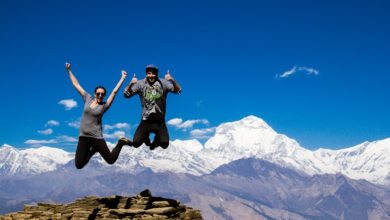
Langtang Region
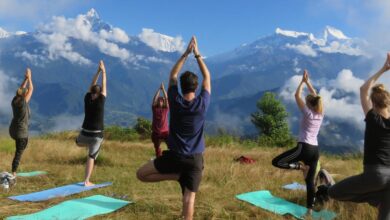
Meditation in Nepal
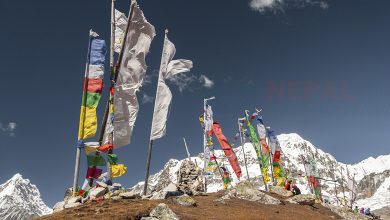
Langtang Valley Trek
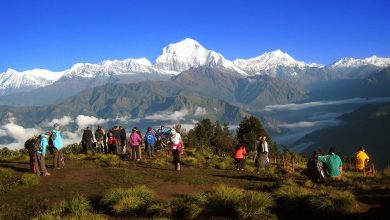
Ghorepani Poon Hill & Ghandruk Trek – 9 Days
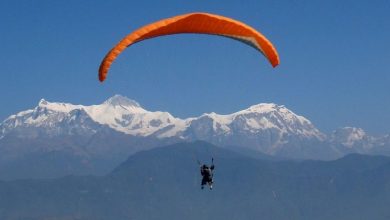
Paragliding
Leave a reply cancel reply.
You must be logged in to post a comment.
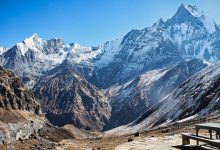
Manaslu Circuit
Himalaya Trail
Facts About Mt. Everest
Trek to Everest Base Camp
Best Time to Visit
Weather & Climate
Kathmandu Airport Guide
Top Destinations in Nepal
One Week in Nepal
Tipping Guide
Getting Around
Top Things to Do in Nepal
Complete Guide to Kathmandu
Top Things to Do in Kathmandu
Top Things to Do in Pokhara
Sacred Sites
Amazing Festivals
Top National Parks
Must-Try Food
Annapurna Circuit
How to Trek Nepal's Annapurna Circuit
Hike the most beautiful route in Nepal
:max_bytes(150000):strip_icc():format(webp)/Becker1-5b734a56c9e77c0025caddbd.jpg)
DANNY HU/Getty Images
Although small in stature geographically speaking, Nepal is a county that is blessed with an overabundance of adventure travel opportunities. Whether you're hiking or climbing in the mountains, spotting wildlife in Chitwan National Park , or whitewater rafting on a raging river, there are numerous activities that are guaranteed to get your heart pumping. Of course, most travelers that visit the Himalayan country come for the amazing trekking, with the hike to Everest Base Camp standing out as a true bucket-list achievement amongst veteran adventurers. But as iconic as that journey is, it may take a backseat to another Nepali trekking route that is even longer, more challenging, and more beautiful.
Stretching for up to 145 miles through the snow-capped Himalaya, the Annapurna Circuit is the standard by which most other trekking routes around the world are measured. It is easily amongst the best hiking routes in the world, but before you commit to exploring it yourself, here's what you need to know.
What Is the Annapurna Circuit?
Located in central Nepal, the Annapurna Circuit is a long-distance trekking route that begins in the town of Besisahar and ends in Birethanti, encircling much of the Annapurna Massif along the way. The trail's namesake mountain is amongst the tallest in the world, standing some 8091 meters (26,545 ft) in height. This beautiful and majestic peak looms large over numerous sections of the trail, providing a spectacular backdrop for a hike that is already well known for its natural beauty.
The trail first opened to hikers back in the late 1970s, but truly gained its legendary status amongst adventure travelers in the '80s. It was around that time that development in the area started to take off, making it easier to travel to and from the Annapurna region. The city of Pokhara also blossomed into a mecca for backpackers, serving as a gathering point for those looking to hike the Himalayan route.
Today, the Annapurna Circuit is amongst Nepal's most popular trekking trails, drawing thousands of hikers on an annual basis. Most come for the spectacular beauty that can be found along the route, which includes small villages spaced out every few hours with accommodating tea houses offering good food, thirst quenching drinks, and a warm, cozy place to spend the night.
Location & Orientation
As with all adventures that take place in Nepal, the journey begins and ends in the country's capital –– Kathmandu. The city is noisy, chaotic, and colorful, with plenty of attractions to keep visitors busy in its own right. The historic temples, famous markets, and eclectic restaurants are certainly worth a look.
Once trekkers are ready to hit the trail however, they'll most likely fly to the city of Pokhara in central Nepal, which is located close to the start of the Annapurna Circuit. From there, they need to book ground transportation to nearby Besisahar to begin the trek. Alternatively, travelers can take a bus directly to Besisahar from Kathmandu, skipping Pokhara altogether. The ride is about seven hours in length, but offers some great views of the Nepali countryside while en route.
Best Time to Go
There are two distinct hiking seasons in Nepal, with one coming in the spring and the other in the fall. The absolute best time to hike in the Himalaya is in October and November, shortly after the annual monsoons have subsided. Typically, the weather is warm, with clear skies, and few rain showers at that time of the year, although evenings can be on the chillier side. Because of this however, it is also the busiest time of the year too. That means the trail can get crowded and tea houses will sell out quickly. If you're visiting during the peaks season, be sure to book your guide and accommodations well in advance.
The second best time to hike the Annapurna Circuit is in April and May. By that time of the year, spring has typically arrived, ushering in warmer temperatures and less snowfall. It is a quieter time on the trail, but the weather conditions can be a bit less predictable with a higher chance of rain or clouds. Still, it is generally a lovely time to be in the Himalaya, with good visibility and excellent hiking on most days.
From June to September, Nepal finds itself in the midst of monsoon season, which brings torrential rain to many parts of the country. But most of the Annapurna Circuit falls in a rain shadow and isn't often hit with heavy downpours. This makes the summer months a surprisingly good time to hike the route, as there are generally very few people traveling in Nepal during that time of year. The downside is that it can be quite warm and muggy on certain segments of the trail, making it an uncomfortable time to be in the mountains.
Some adventurous hikers will trek the route in the winter, as the trail is usually all-but deserted at that time of the year. The trade-off is that snowstorms can strike at any time, temperatures can get quite cold, and there is a higher chance of avalanches closing the trail. Only the most experienced backpackers should hike in the Himalaya at that time of the year, as conditions can actually become life-threatening, particularly if you're unaccustomed to the winter conditions.
How Long Does It Take to Hike the Annapurna Circuit?
Hiking the classic Annapurna route through the Himalaya generally requires about 18 days to complete end-to-end. Some trekkers are able to travel a bit faster, shaving a few days off of that time, while others will move at a slower pace or make side trips, extending the journey a bit longer. The majority of guided treks will stick closely to the 18 day schedule however, which doesn't include travel time to and from Nepal. Add on a few days in Kathmandu at the beginning and/or end, and an Annapurna trek will likely take the better part of three weeks to finish.
What Should I Expect on the Trail?
The Annapurna Circuit is a well marked and maintained trekking route that is easy to follow. It passes through numerous small villages along its length, giving hikers plenty of options to grab a bite to eat, relax with a drink, or find accommodations for the night. Tea houses are plentiful and small restaurants and shops are not uncommon either.
The trail itself features plenty of altitude gain and loss along the way, with a starting point located at 2690 feet in Besisahar and reaching its highest point at Thorung Pass, which tops out at nearly 17,770 feet. It is a slow, but steady climb up to that point, with some — steep, but manageable — ascents at various points throughout the hike. Go slowly and allow yourself to acclimate to the altitude, particularly in the early days of the trek.
There are also quite a few river crossings along the route, most of which are accomplished with the help of a suspension bridges. This adds to the sense of adventure, as some of those bridges are built high above the water, making for some very scenic views and photos. But those who aren't particularly fond of heights will want to keep their eyes focused ahead while moving at a steady pace. While completely safe and well maintained, the bridges can be a bit unnerving on the first crossing or two.
One of the reasons why the Annapurna Circuit is much-loved by trekkers is that it seems to only get better with each passing day. The beautiful and dramatic scenery can be incredibly breathtaking, and just when you think it can't get any better, the next day completely surpasses the one before. If you're looking for a hike that will provide plenty of sights to see, it's difficult to find a route that will tops this one.
As mentioned, the traditional Annapurna Circuit begins in Besisahar and ends in Birethanti. In between, the trail wanders through Khudi, Jagat, Manang, Marpha, Tatopani, and numerous other villages and towns, providing a real sense of what it is like to live in the Himalaya. This is part of its appeal as well, giving trekkers a chance to immerse themselves in the mountain culture that has existed there for centuries.
There have been some travelers who have lamented the fact that a busy road now runs through much of the Annapurna region, with cynics saying that it has ruined the trekking route forever. While it is true that a road now exists there, much of the path still stays well away from it and some portions have been rerouted to avoid the traffic as well. At the end of the day, this is still one of the best hikes in the world and most adventure travelers won't come away disappointed.
Do I Need a Guide?
Whether or not you hire a guide for your Annapurna Circuit excursion comes down to personal preference. If you are an experienced backpacker who enjoys going it alone, and are looking to save a bit of money, then a guide isn't really necessary. The trail is easy to follow, it's hard to get lost, and there are plenty of places to resupply along the way. For those that know what they are doing, it is a fairly straight forward trek.
On the other hand, if you're looking to get the full experience, a guide can come in very handy. Not only will he or she ensure that you stay safe on the trail, they'll also be able to answer questions for you along the way. They can also help translate conversations with locals, offer insights into the best places to stay and eat, and help you to avoid potentially sticky situations. From time to time trekkers can meet less-then scrupulous individuals along the trail and a good guide can help smooth over those encounters.
What to Pack
A long trek through the Himalaya can require plenty of gear to keep you warm, dry, and comfortable throughout the trip. If you've booked the hike with a guide service, be sure to ask them for a packing list before setting out to ensure that you have everything you'll need. During the two most popular trekking periods –– October through November and April through May –– the days are typically warm, while the nights can be quite cool. That means you'll want to dress in layers, bring a warm sleeping bag, and pack versatile gear that can be used in a variety of environments.
If you're trekking independently, you'll find a number of Annapurna Circuit gear lists online. Use these as guide for knowing what to pack for the trip and what to leave at home. Keep in mind however, you'll be carrying your backpack at high altitude, so packing light may be of benefit.
Do I Need a Permit?
The Nepali government requires that all trekkers hiking the Annapurna Circuit carry two permits with them at all times. Those permits are required to even enter the Annapurna Conservation Area and there are multiple checkpoints along the route where authorities will request to see them again.
Both the Annapurna Conservation Area Permit (ACAP) and the Trekkers Information Management System (TIMS) card can be obtained in Kathmandu or Pokhara prior to the start of the hike. The ACAP costs about $18/person, while the Green TIMS card, which is for independent travelers, is priced at $20/person. A Blue TIMS card for group travelers sells for $10/person.
If you hire a guide they will typically handle all of the paperwork and obtain the permits for you.
Do I Need Travel Insurance?
Nepali regulations require all travelers who are climbing or trekking within the country to have travel insurance prior to setting out on their adventure. Hiking and mountaineering at high altitude comes with some inherent risk, and it is not uncommon for travelers to have to be evacuated or receive medical treatment. Having the proper insurance can help alleviate those costs and can help organize an evacuation or medical transfer should the need arise.
Beyond that regulation however, it is just a smart idea to purchase travel insurance when undertaking any adventurous itinerary. You never know when a situation might arise where you might need it, including covering the expenses of lost bags, cancelled flights, unexpected medical expenses, or evacuations. Those are all things you hope to never have to deal with, but the right insurance will limit the impact it has on your trip and wallet should anything unexpected happen.
How Fit Do I Need to Be?
The Annapurna Circuit can be a challenging hike, even for those who are already quite fit. In order to enjoy the trek to its fullest, travelers are encouraged to be as physically prepared as possible prior to starting out. Some days are more strenuous than others and altitude is always a concern of course, but the trek will be a more enjoyable one if you have trained a bit prior to traveling to Nepal.
Who Should I Travel With?
As mentioned, you can hike the Annapurna Circuit completely on your own, or hire a guide when you arrive in Nepal. But if you'd rather have all of the logistics taken care of for you and book a guide service prior to your departure, there a plenty of companies that offer treks along the route. Here are a few that we recommend:
- G Adventure 18-Day Annapurna Circuit Trek
- Trekking the Annapurna Circuit Region with Intrepid Travel
- Annapurna Circuit by Exodus Travel
- Annapurna Circuit From World Expeditions
- Annapurna Sanctuary Trek by REI Adventures
How to Go Teahouse Trekking in Nepal
The Best Countries in the World for Adventurous Travelers
Five Amazing Hiking Routes Among the High Mountains of the Himalayas
The World's Highest Places and Attractions That You Can Visit
How to Trek Nepal's Manaslu Circuit
The 15 Best Hiking Destinations in Asia
The Best 12 Hikes in Nepal
The Best Time to Visit Nepal
The Complete Guide to Climbing Morocco's Mount Toubkal
The Top 20 Things to Do in Nepal
The Top 15 Destinations in Nepal
How to Go Hiking With Your Kids
Nepal's Great Himalaya Trail: The Complete Guide
The 10 Best Hiking Trails Found Inside America's National Parks
15 of the Most Beautiful Sacred Sites in Nepal
The Proper Gear for Trekking the Himalaya

Annapurna Circuit Trek in Nepal: The Ultimate Guide
Jackson Groves
Posted on Last updated: October 20, 2023
Categories NEPAL , HIKING
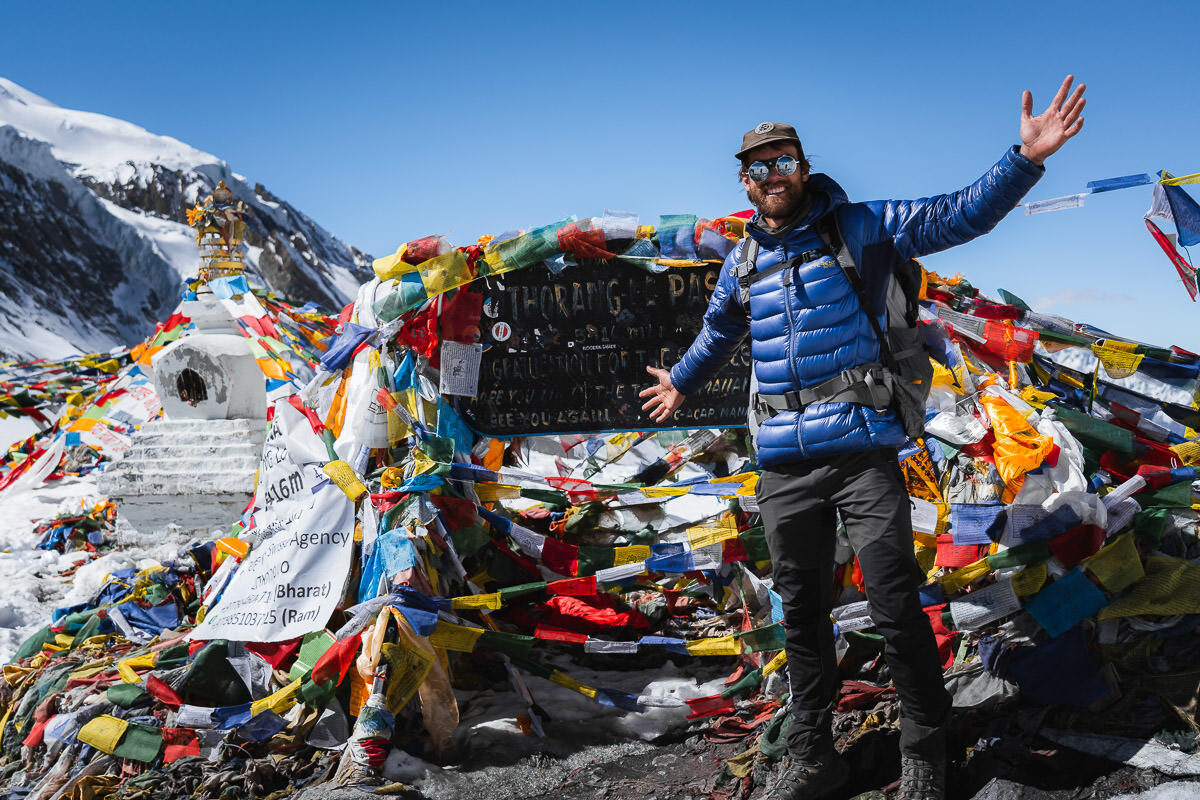
The Annapurna Circuit Trek is one of the most popular expeditions in the Himalayas of Nepal. While Everest Base Camp may be the most well-known trek in Nepal, the Annapurna Circuit Trek is definitely a close second! I’ve done both the EBC and the Annapurna Circuit Trek among many other routes in Nepal.
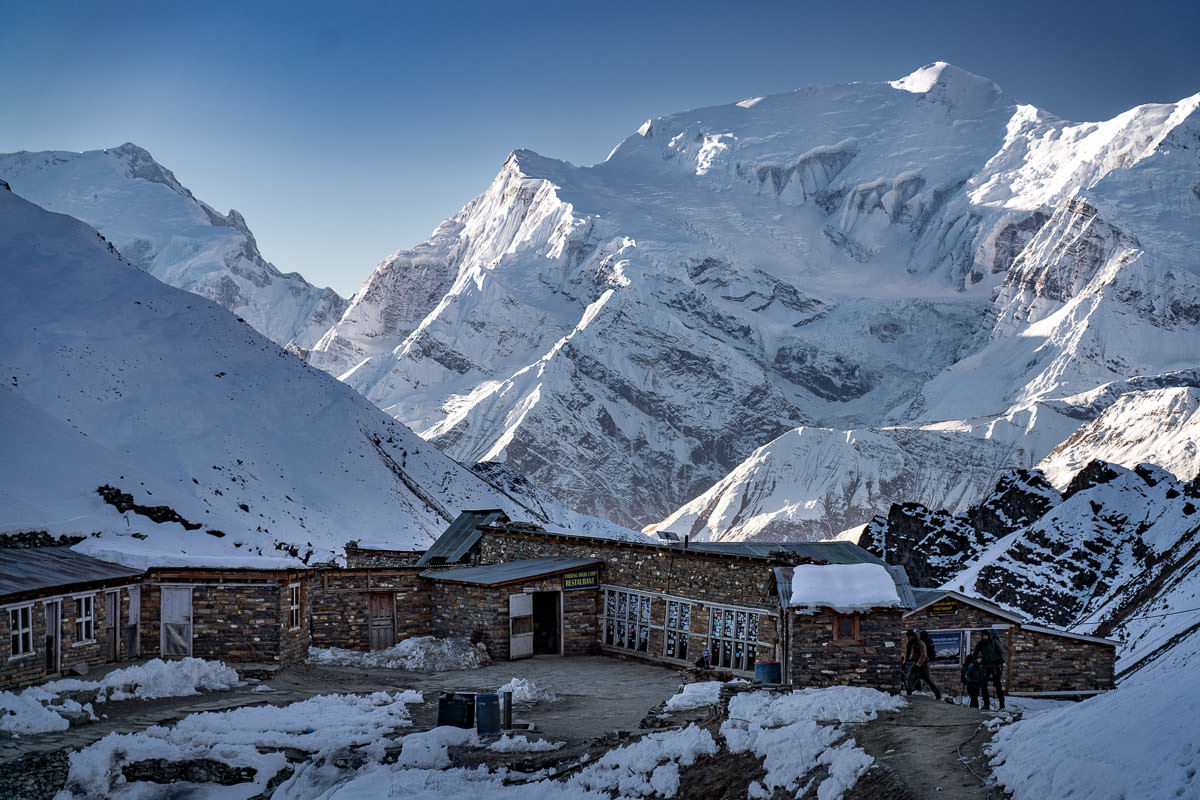
BEST TREKKING COMPANY IN NEPAL
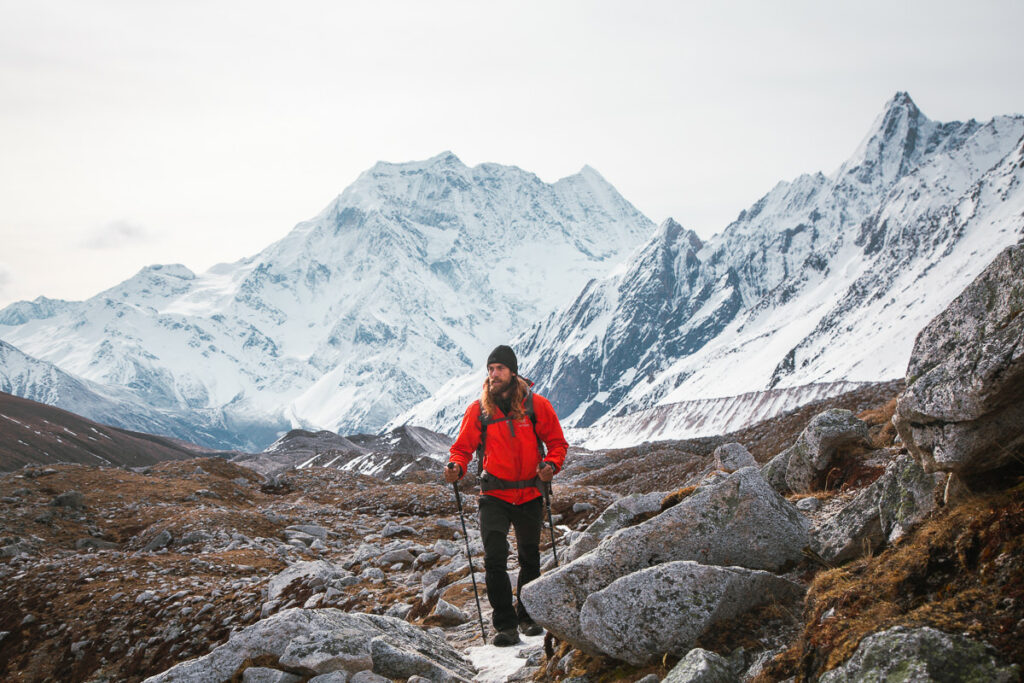
Interested in trekking in Nepal or doing the Everest Base Camp Trek? I recommend booking your trek with Himalayan Masters , which is the company I use for all of my treks in Nepal. Use my code JACKSON5 when you book to receive a 5% DISCOUNT .
In this guide, I will share with you my experience on multiple routes throughout the Himalayas to help prepare you for your trekking experience. Overall I would rate the Annapurna Circuit as the most scenic trek in Nepal from the first day to the last.
We looked at 7000m and 8000m peaks from the first to the last day, had amazing tea house locations, and were blown away by the scenery every single day. However, there are some negatives that modernization and commercialism have brought to the Annapurna Trekking Circuit with roads, infrastructure, and pollution. I’ll cover all aspects of this route to give you an honest insight into what to expect and why you may want to choose this route for your trip.
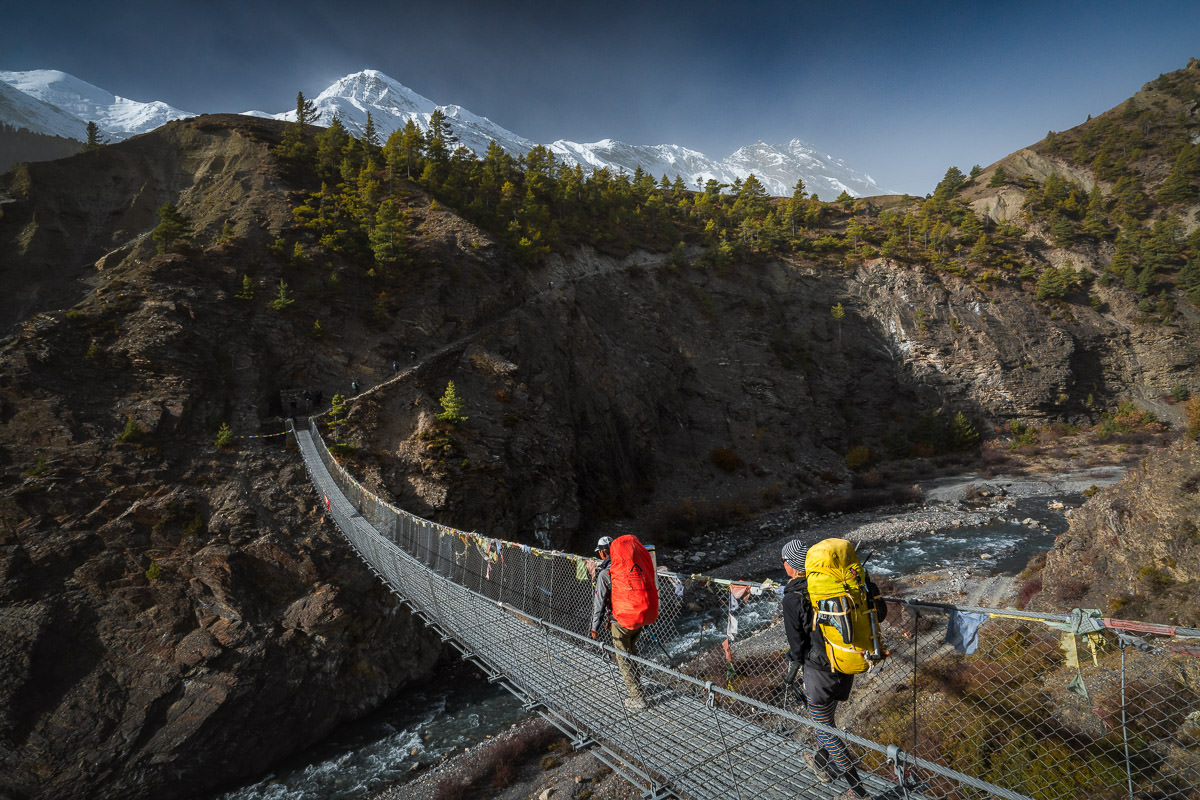
In this blog post, I will cover everything you need to know about the logistics of the Annapurna Circuit Trek. I’ve also created guides for the following treks and climbs in Nepal if you are interested to check those out as well.
- Manaslu Circuit Trek
- Everest Base Camp Trek
- Makalu Base Camp Trek
- Langtang Valley Trek
- Island Peak Climb
- Yala Peak Climb
- Ama Dablam Climb
- Manaslu Climb
- Makalu Climb
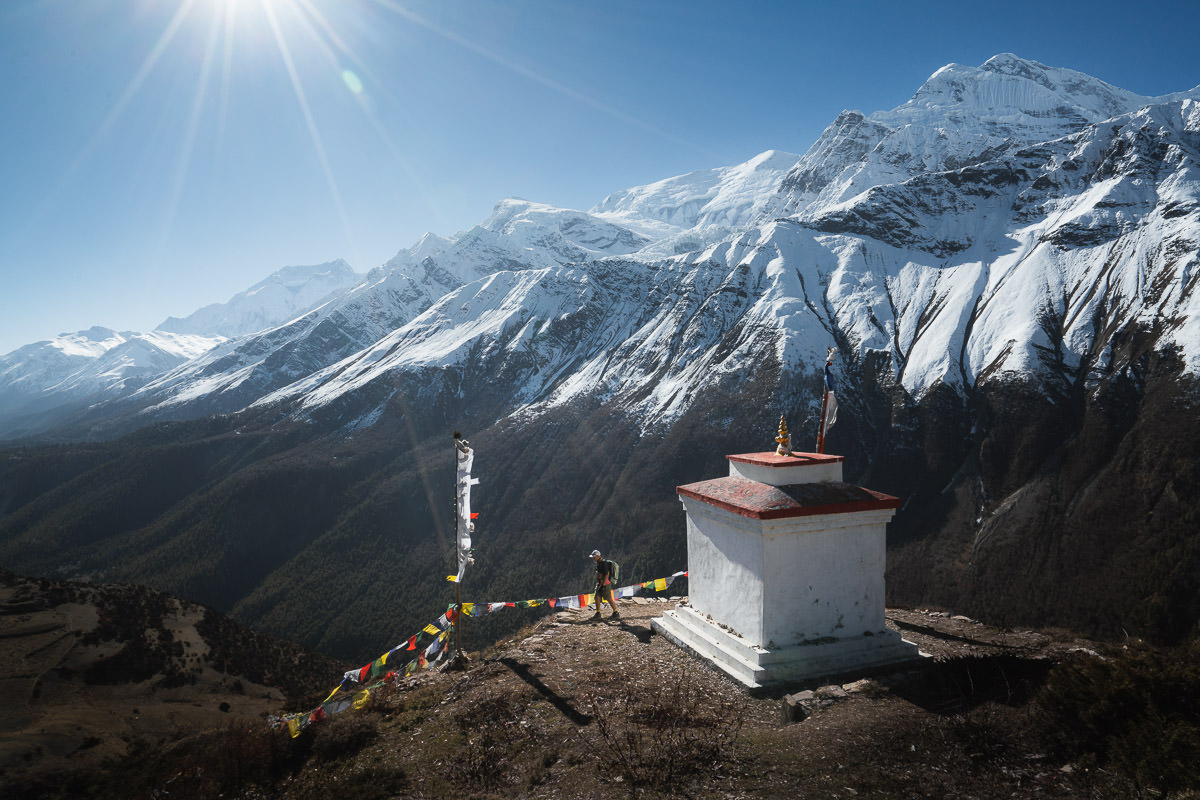
TRY THE 3 BEST TREKS IN NEPAL

Manaslu Circuit : My personal favorite 2-week trek through Tibetan villages and stunning scenery. Less crowded and more authentic.
Annapurna Circuit : The most beautiful & scenic 2-week trek in Nepal although can be crowded at times.
Everest Base Camp Trek : The most iconic 2-week route reaching the famous (EBC) Everest Base Camp at 5,300m.
Table of Contents
A GUIDE TO THE ANNAPURNA CIRCUIT TREK
In this guide, you will find all of the valuable information you need to plan your trek as well as my personal experience on the entire trek including the detour to Tilicho Lake
ANNAPURNA CIRCUIT TREK DETAILS
- Distance : 130km or 80 miles
- Days required : 10-13 days
- Total Incline : 8000 meters
- Total Decline : 7000 meters
- The highest point on the trek : The two highest points on the trek are Tilicho Lake (4,919m) and the Thorong La Pass (5,416m).
- Difficulty : The difficulty of the Annapurna Circuit Trek depends a lot on how many days you have. If you break it up over 12-14 days, it will be similar to the difficulty of EBC. However, we took only one acclimatization/rest day in Manang and the itinerary was quite tough for us given we squeezed into Tilicho Lake. Many days were about 20km of distance with 1000m of incline.
- Permits : You will need a TIMS card and Park Entrance Permit, both can be purchased when entering the park.
- Guide: A guide is not required on this trek. However, the guide manages all of the logistics, distances, directions, and tea houses for your group. I used maps.me to navigate from tea house to tea house and found the paths easy to follow. If it’s your first time trekking in Nepal, I would suggest having a guide.
- Accommodation: Guest Houses, also known as Tea Houses, are available along the way where you will sleep in a comfortable bed and have access to showers (at extra charge) and restaurant facilities. It was very comfortable accommodation and great after a long day of hiking.
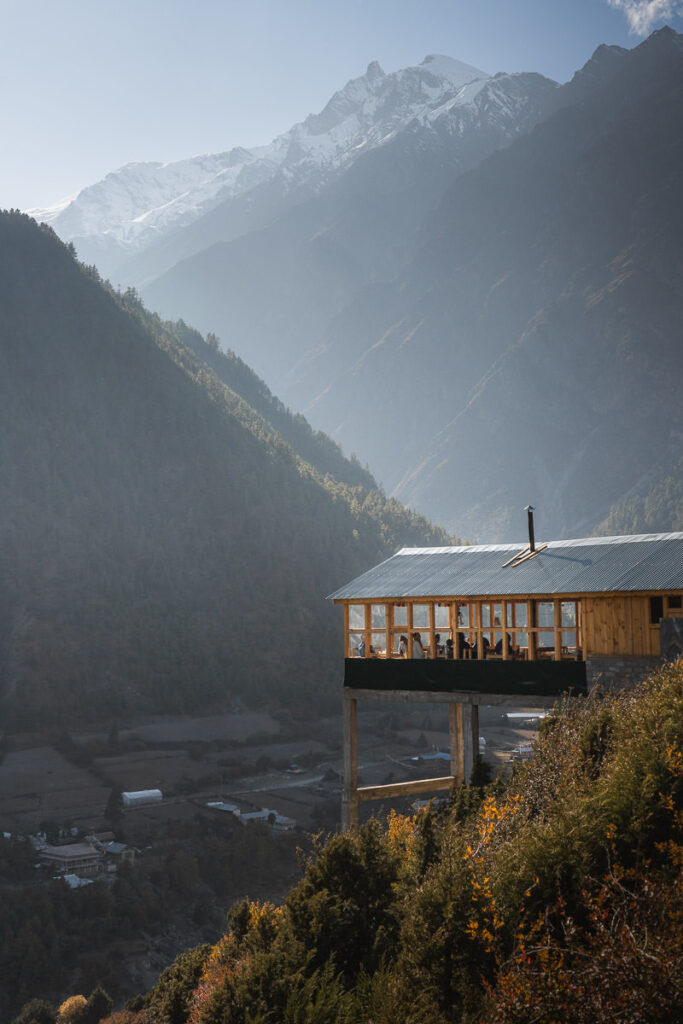
KEY POINTS ABOUT THE ANNAPURNA CIRCUIT TREK
- This circuit is less crowded than Everest Base Camp Trek but still quite busy. Especially around Tilicho Base Camp as many locals just come to trek to the Lake and don’t do the full circuit.
- There are teahouses in each village along the way so each night you get a great sleep in a bed with blankets, have access to showers, eat great meals in a restaurant, and can charge your electronics and cameras.
- The trailhead can be reached by car so there is no need to pay for expensive domestic flights.
- The road reached all the way to Khangsar, which means it isn’t quite as remote, peaceful and natural as you may be expected until the latter stages of the hike. There are side trails most hikers take for better views and to avoid the cars but nonetheless, it can be demoralizing to see a car full of tourists drive past as you eat their dust.
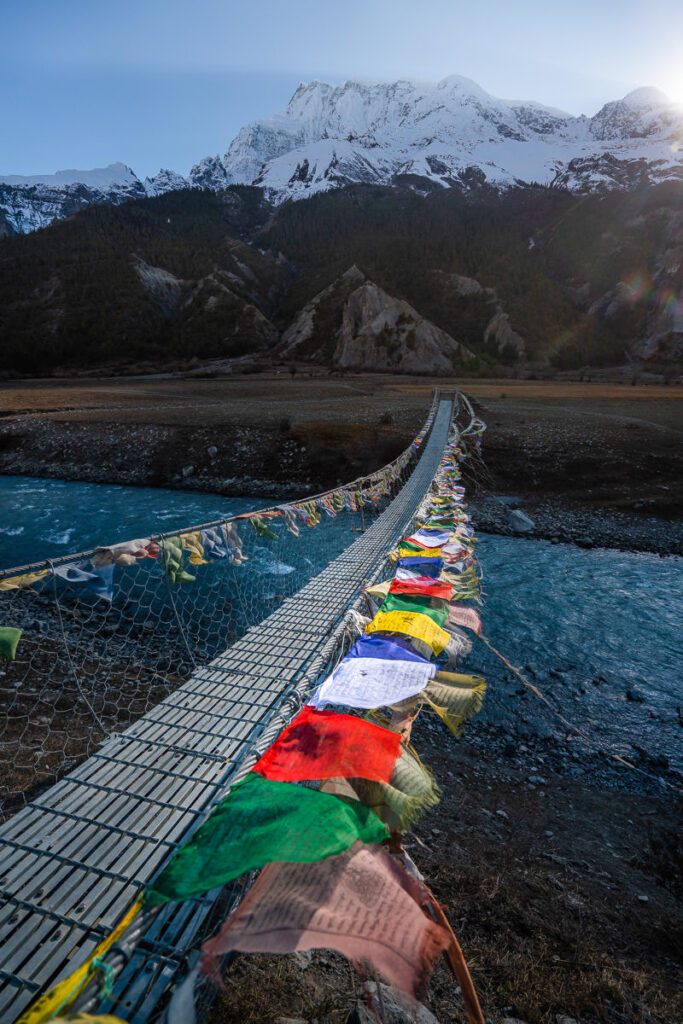
TOP 3 PLACES TO STAY IN KATHMANDU

- Ultimate Luxury: The Dwarika’s Hotel – Luxury, Spa-service, Pool
- Best Value : Aloft Kathmandu Thamel – Swimming Pool, Gym & Great Restuarant
- Budget Choice: Hotel Jampa is easily the top cheap hotel in Kathmandu
BOOKING A GUIDE FOR THE ANNAPURNA CIRCUIT TREK
The Annapurna Circuit Trek doesn’t require a guide but it’s great to have a guide managing the logistics such as directions, tea houses, distances, medical issues, and the overall organization. I’d say 80% of trekkers go with a guide. I did the trek with Himalayan Masters which is one of the top trekking companies when it comes to the Annapurna Circuit Trek.
The trek costs around $1400 USD with Himalayan Masters as of 2022 and includes all transfers, accommodation, meals, drinks, permits, and even the hotel stay before and after the trek at a high-quality hotel. I honestly had a great time on this trek and I can wholeheartedly recommend Himalayan Masters.
You can use my discount code ‘ JACKSON5 ‘ for 5% off the total price of your trek with Himalayan Masters which is a pretty handy saving.
Email: [email protected]
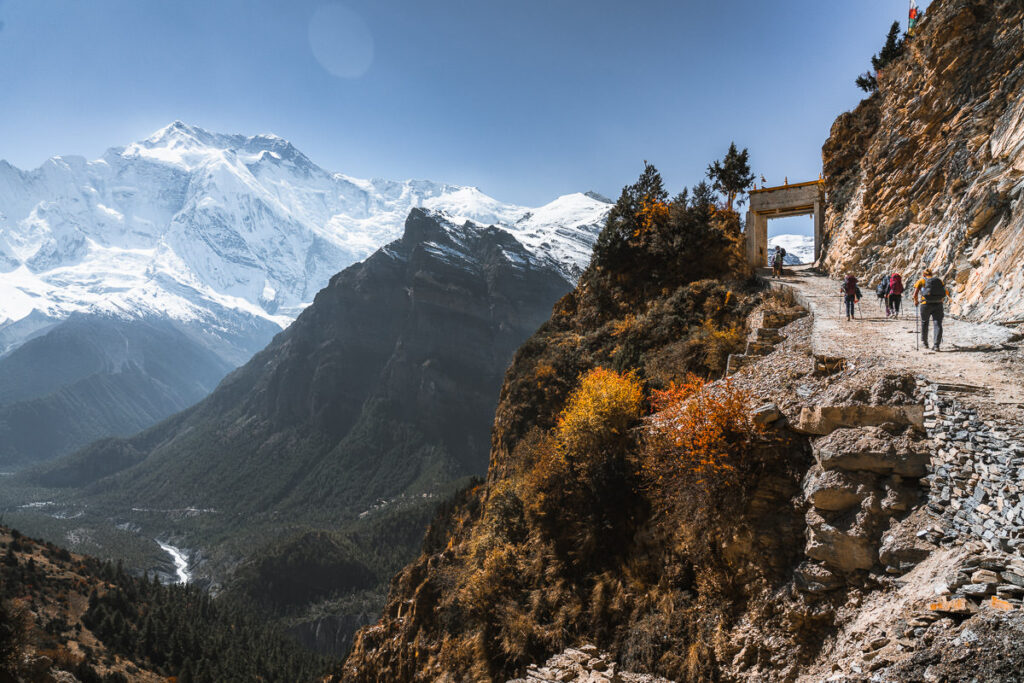
ANNAPURNA CIRCUIT TREK PACKING LIST
I packed pretty light and managed to wash most of my clothes each afternoon/night for the first half of the trip. In the latter stages of the trip, it was pretty cold so we weren’t sweating as much and we wore our warm gear basically nonstop while at the teahouses. There was no real need for multiple outfits.
This is just a guide and it worked quite well for me with no complaints from my set-up. You won’t need a sleeping bag as there are blankets in each guesthouse and when it got cold I just wore my down jacket to bed. This meant I didn’t have to carry a sleeping bag for the entire trek.
- 1 pair of pants that maybe convert to shorts
- 1 pair of shorts
- 1 Warm or thicker pair of hiking pants
- 1 Long sleeve quick-dry shirt
- 1 Long-sleeve thermal shirt
- 2 Short-sleeve t-shirts
- 1 Thermal long underwear
- 4 pairs of quick-dry underwear
- 1 Lightweight down jacket
- 1 Heavy-duty summit down jacket
- 1 Neck Buff
- Hiking boots
- 1 pair of warm summit socks
- 2-3 pairs of regular socks
- Trekking poles
- Water filter
All of this should fit into a backpack no bigger than 50L and should be less than 14kg.
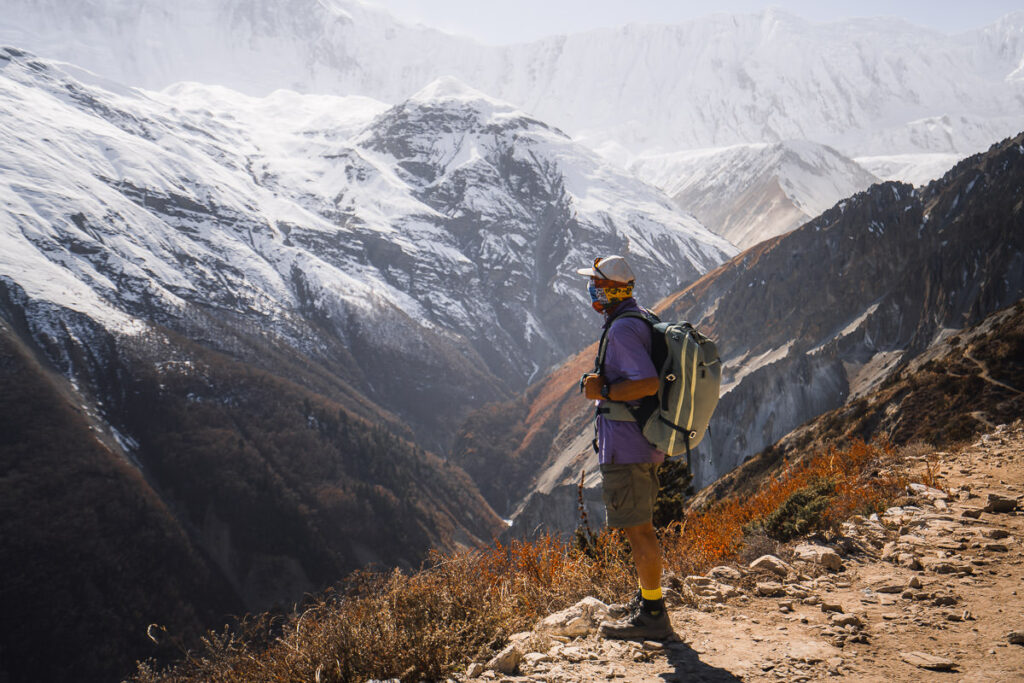
What are my favorite pieces of hiking gear?
There are four pieces of gear that I simply never forget when I go on a hike. These are four items that I using right now and this list gets updated every year! Here are my hiking essentials.
- Arcteryx BETA AR Rain Jacket : This is my go-to rain jacket. It’s super light, folds down into a tiny ball, and protects brilliantly in a storm. This one never leaves my backpack.
- Salomon X Ultra 3 Mid GTX Hiking Boots : For the best ankle support, waterproofing, and durable exterior I’m a fan of tough but light hiking boots like these Salomons for my adventures.
- Black Diamond Head Torch : I can’t tell you how many times, I’ve arrived back from a hike unexpectedly late. I always keep this lightweight but strong headtorch in my bag for the unexpected.
- Darn Tough Socks : These are the most comfortable hiking socks I’ve ever worn and last for years. They also have a lifetime warranty and you just send them in with a hole and they replace it no questions asked.
WIFI/ELECTRICITY AVAILABILITY ON THE ANNAPURNA CIRCUIT TREK
- Wifi: Costs anywhere from $0 to $4 to use wifi at the guesthouses. Buy an NTC Sim before you go. It worked in some spots but after Pisang, the service dropped and it was mostly WiFi until we got across the pass to Muktinath.
- Electricity: You will have to pay anywhere from $0 at low elevations to $5 to charge your power banks, cameras, and phones. I found that most rooms had free electricity powerpoints in the room. The key is to get a big power bank. Pay to charge it then charge everything from your power bank. My power bank lets me charge my phone and four camera batteries before it dies. Most of the places we stayed let us charge our gear for free but when it is busy they usually charge a fee as many teahouses run off gas or solar.
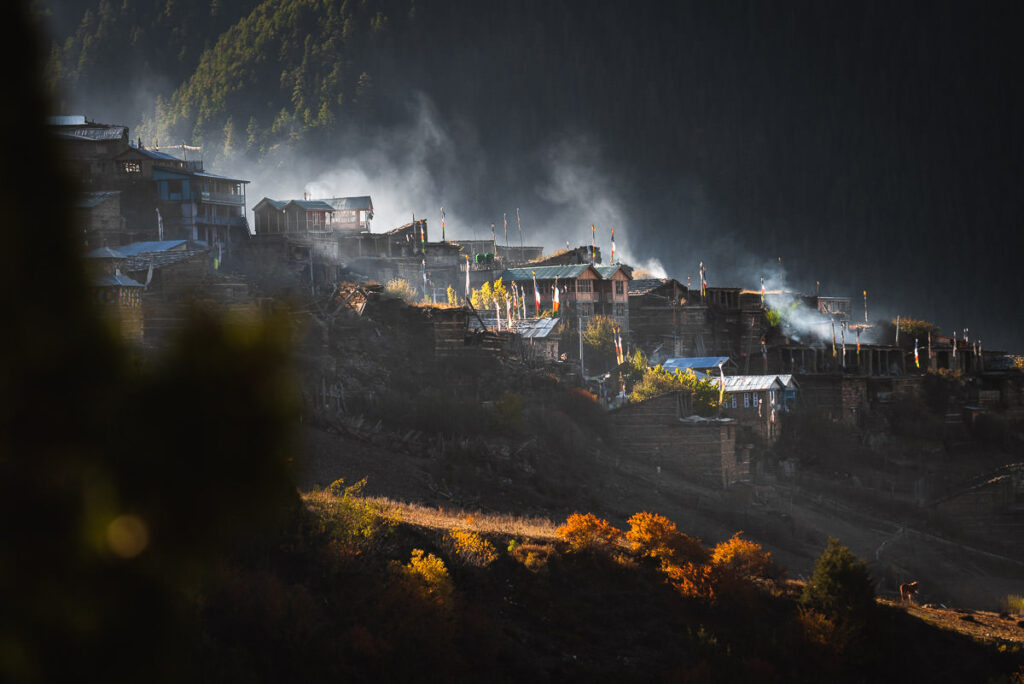
ANNAPURNA CIRCUIT TREK ITINERARY
The below itinerary was the exact journey I did but I would suggest adding in an extra day or two to account for rest days or being able to break up the day when you get up to Tilicho Base Camp. This was quite a strenuous activity. I also recommend not hiking to Dharapani from Besishar as the road is full of trucks and vehicles. Similarly, once you reach Muktinath, I suggest driving to Jomsom as it is quite built up from there with main, paved roads.
- Day 1: Drive Kathmandu to Dharapani (1,960m)
- Day 2: Trek to Chame (2,710m) Duration: 5-6 hours trek
- Day 4: Trek to Pisang (3,300m) Duration: 5-6 hours trek
- Day 5: Trek to Manang (3,500m) Duration: 6-7 hours
- Day 6: Acclimatization Day at Manang
- Day 7: Trek to Tilicho Base Camp (4000m) Duration 6-8 hours
- Day 8: Trek to Tilicho Lake & Trek to Shreekharka (4080m) Duration 10 hours
- Day 9: Trek to Thorong Phedi (4600m) Duration 6-7 hours
- Day 10: Trek to Thorong La & Trek down to Muktinath
- Day 11: Drive to Jomsom
- Day 12: Fly to Pokhara
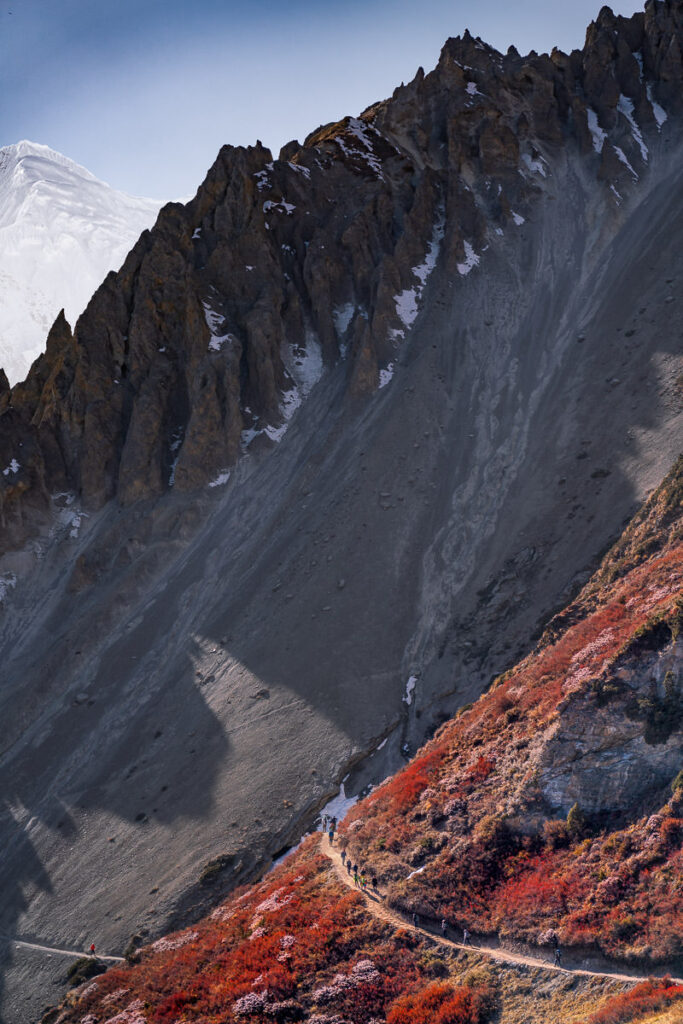
INSURANCE FOR THE ANNAPURNA CIRCUIT TREK
Nepal can be a dangerous place for trekking or hiking because the high altitude can lead to many illnesses, weakness in trekkers, and misjudgments. There is also a risk on trails for falls, avalanches, or other mishaps. Your regular travel insurance probably won’t cover you at high altitudes and won’t cover a helicopter evacuation. There is a solution though .
Need extra protection?
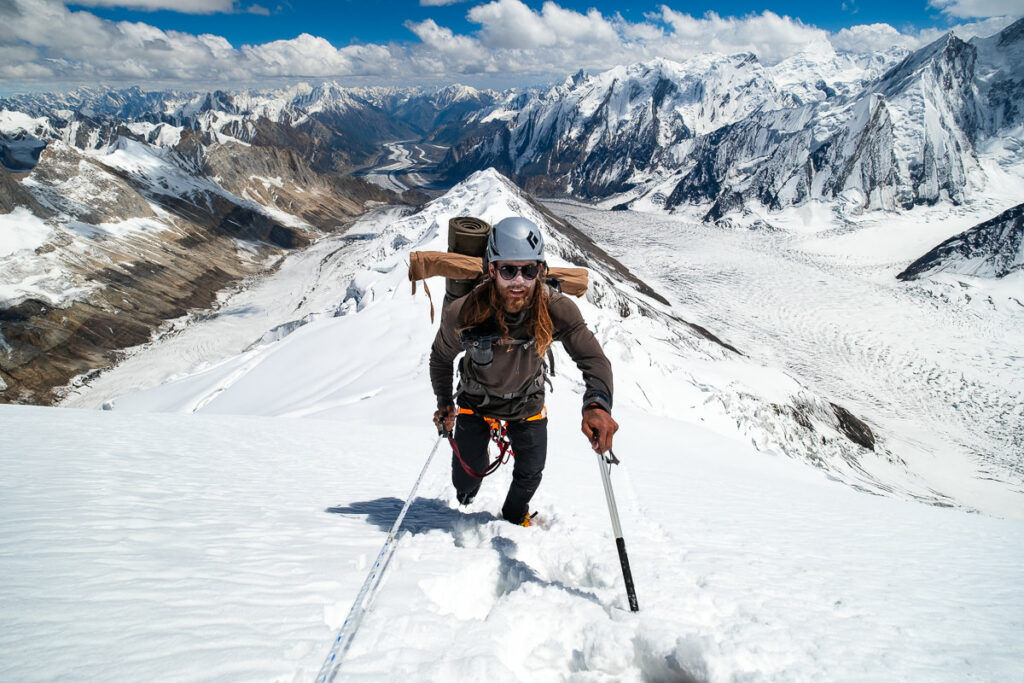
Regular travel insurance is great but won’t cover you for high altitude hikes or for helicopter evacuation. Each year, I purchase a Global Rescue Subscription .
For less than $500 per year or $100 per expedition, you can purchase a Global Rescue subscription and be covered no matter how extreme the hike or how high the climb is.
DRINKING WATER ON THE ANNAPURNA VALLEY TREK
I use the Grayl Ultralight Water Purifier and it is a game-changer for hiking in Nepal, making this super easy and cheap. The Grayl Ultralight Water Purifier removes 99.9999% of viruses of disease-causing bacteria. The best thing about it is it only takes 15 seconds and one press to purify water from any fresh water source. You don’t need to buy bottled water at every tea house contributes to large amounts of plastic waste and costing you $4+ per day.
Along the Annapurna Circuit Trek, we filled up tea houses, rivers, and local village taps. Unlike aqua purification tablets which require you to wait 30 minutes before drinking, you can have rehydrated yourself immediately with the Grayl Ultralight Water Purifier .
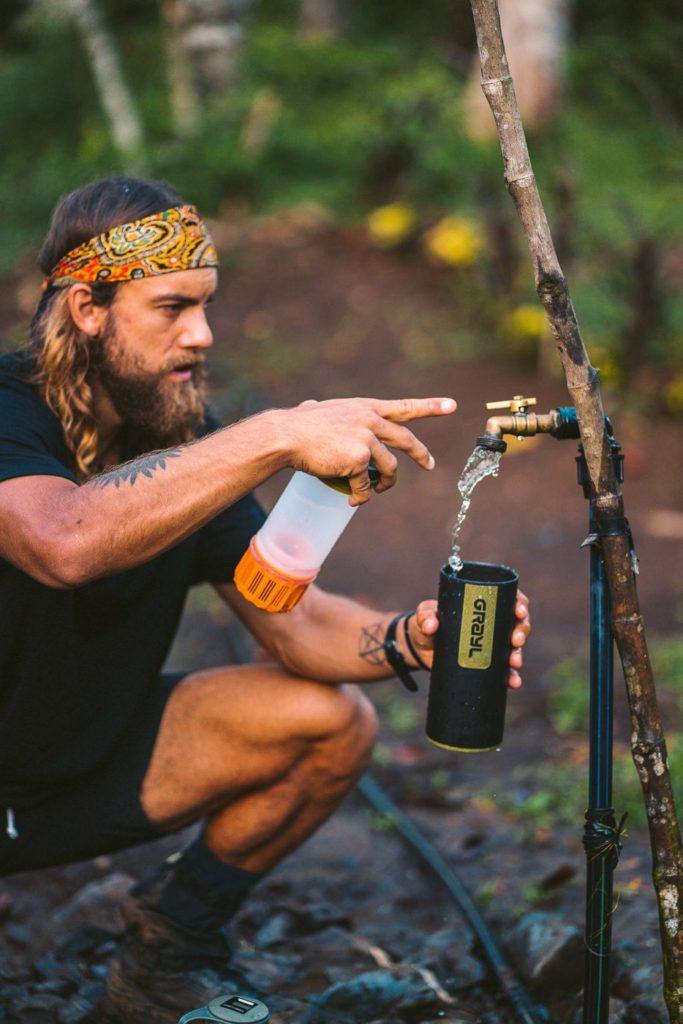
GrayL Water Purifier
- Never pay for water on the trek
- Save 3-4 plastic water bottles a day
- Turns any water into drinking water
BEST TIME AND SEASON FOR THE ANNAPURNA CIRCUIT TREK
The peak season for the Annapurna Circuit Trek is March to April and October to November. The time to avoid this trek is during the rainy season from June to August . Having said that, I often found that off-season or shoulder seasons have been my best (uncrowded) trekking experiences in Nepal
During the winter from December to February, this region gets very cold and there will be snow cover in the higher parts of the trek. Many of the guesthouses actually close up for the winter and re-open in late February to March.
I hiked the Annapurna Circuit Trek in late October/early November and we had 12 days of constant sun. Not a single day with clouds and no chance of rain. Lucky us.
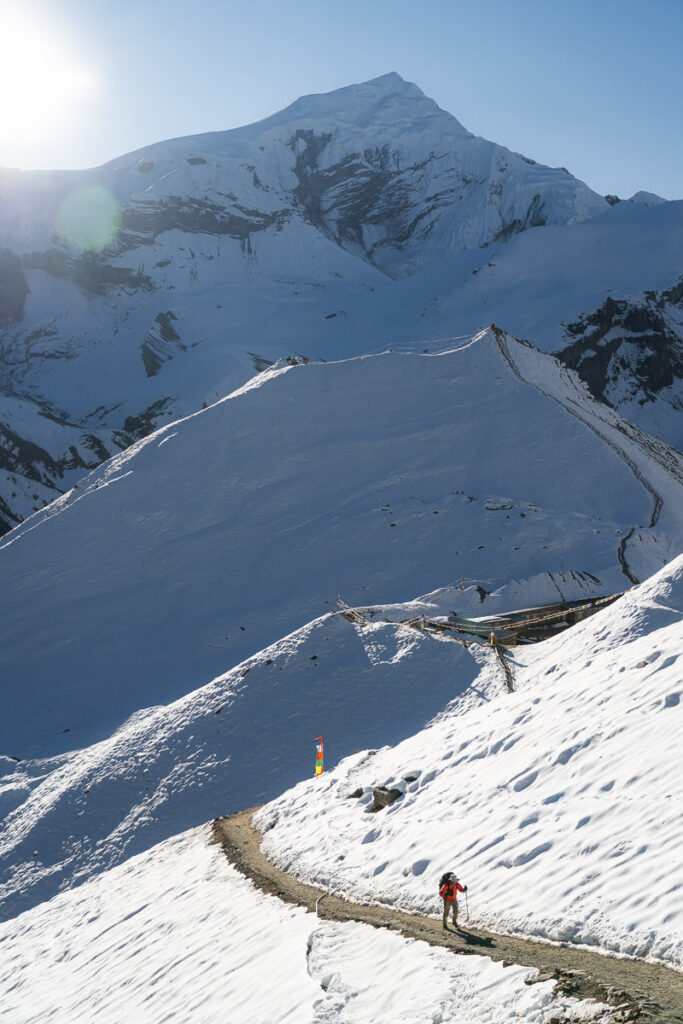
HOW TO GET TO THE ANNAPURNA CIRCUIT TREK
There are two main ways to reach Dharapani, which is the small town at the starting point of the trek. Despite the distance from Kathmandu to Besishar only being 125km, the journey takes a long time due to the traffic and quality of the road.
Jeep: We went by private Jeep organized by our tour company Himalayan Masters. It costs about $180 to hire the vehicle out for the drive so can be split between your group. It’s not cheap but much less brutal than the lengthy bus journey.
Public Bus: The bus costs about $12 USD and can take anywhere from 7-12 hours depending on the traffic and if there are any roadworks or landslides recently. The bus station in Kathmandu is called ‘ New Bus Station ‘.
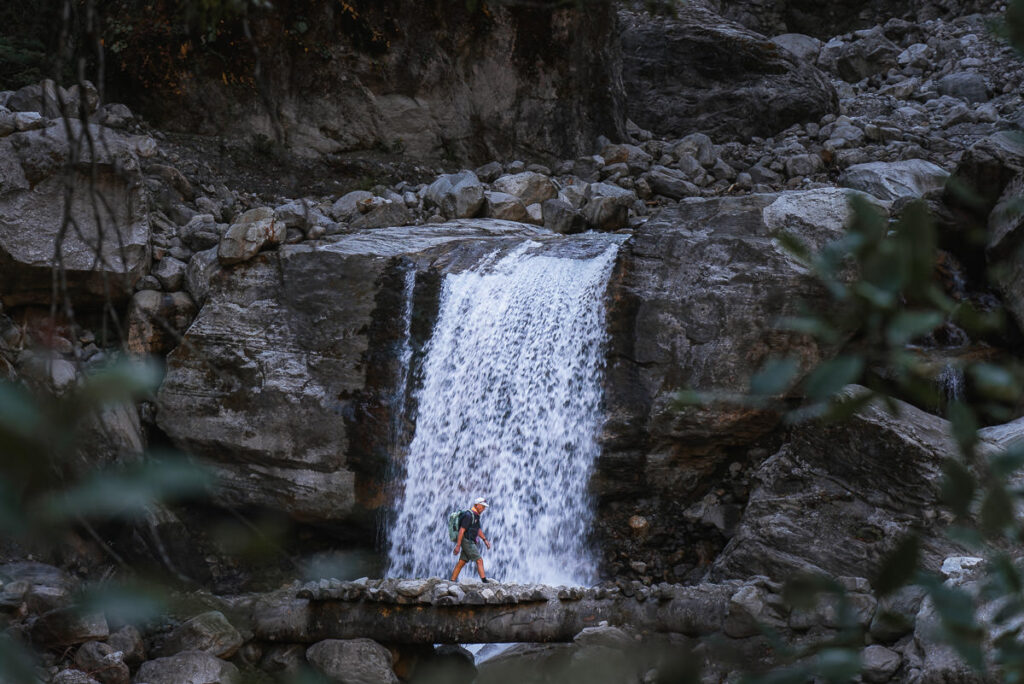
MY EXPERIENCE ON THE ANNAPURNA CIRCUIT TREK
Throughout this section of this guide, I will share my experience with each part of this trek and give my thoughts on the increased level of infrastructure and road access throughout the Annapurna Circuit Trek.
TREKKING FROM DHARAPANI TO MANANG
After surviving the bumpy ride along the cliff-side roads to Dharapani, we spent the night in a small teahouse before beginning our trek the next morning. Dharapani is actually where the Manaslu Circuit Trek finishes, so I had been in this small river-side town on several occasions previously. The trail for the Annpurna Circuit doesn’t overlap with that route at all and actually follows a road for the opening parts of the journey.
The first few days of the Annapurna Circuit Trek, are not the most peaceful or remote. Trekkers will find themselves being overtaken by Jeeps full of tourists driving deeper into the circuit or being dropped closer for a quick summit attempt at Tilicho Lake. I always hate when cars can drive past me while I’m working hard trekking but it’s unfortunately just part of this route now.
Despite trekking on a road for a fair portion of the first day, there are many side trails that quickly immerse you into the natural surroundings. We found ourselves on steep stairs in the forest and walking through small villages as we wound our way on and off of the road throughout the days. The highlights when it came to views early on in the trek was that from the very first morning, we had views of Manaslu (8,163m). This qas quite nostalgic for me and actually pretty incredible to have Manaslu as a constant backdrop given that I’d stood atop the mighty mountain a year earlier.
Chame was our first stop for the night and was probably my least favorite town of the lot. This is often to be expected when you are just getting started on the trail. The second night in Upper Pisang, we had a direct view from the tea house looking towards Annpurna II. They call it the unlucky mountain as it just misses out on being one of the 14 revered 8000ers. At 7,937m, it is an imposing peak, providing an unbelievable view right from the doorstep of the tea house.
Manang was the first town that felt quite remote and had a bit of atmosphere. In Manang there were several bakeries, religious sites, sacred lakes and monasteries. We spent two nights in Manang, as do many trekkers, and used the ‘rest’ day to head up to Chonggen Viewpoint for more incredible views over Manang and the surrounding mountains.
The scenery alongside the trail had become incredible by day three. While cars can still access to Manang, there was much less traffic and that rural, remote feeling had replace the chaotic, touristic vibe from the early moments of the trek.
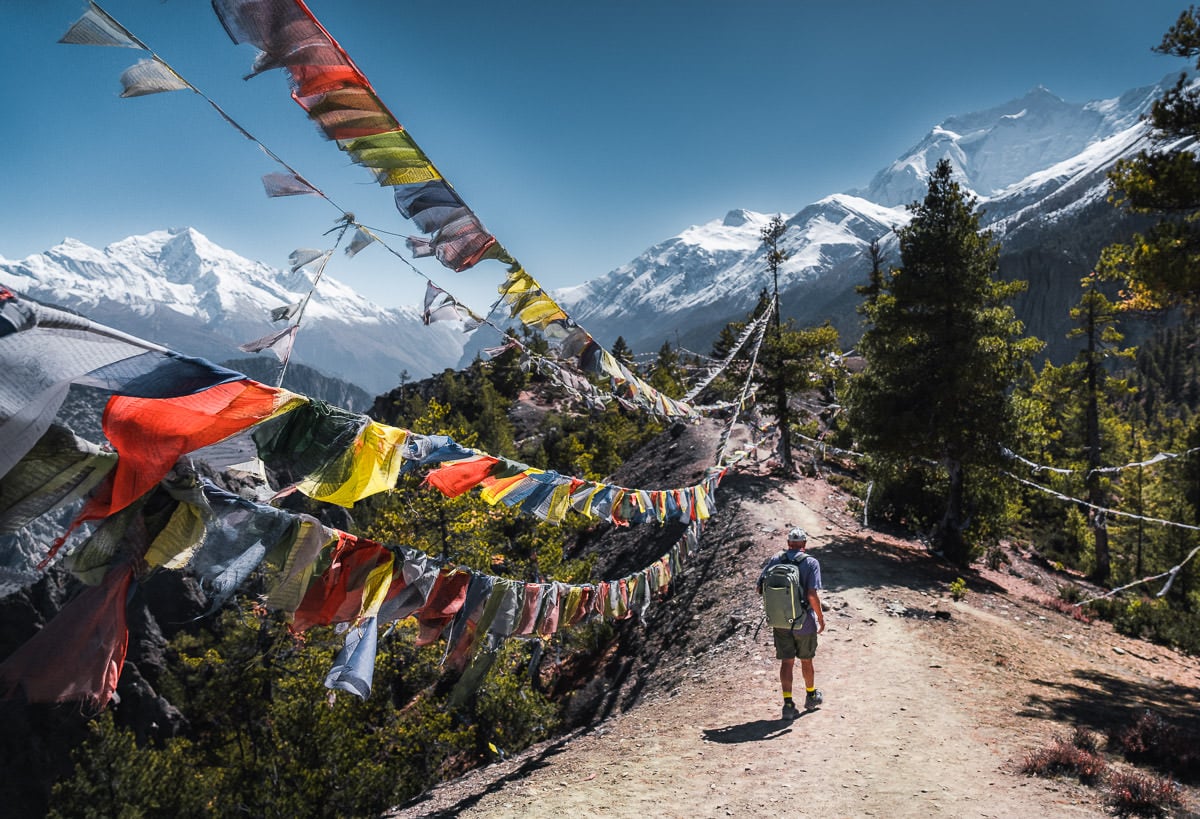
TREKKING TO TILICHO LAKE
After a rest day in Manang, it was time to put in a few ‘big effort’ days as we head some serious distance and elevation gain ahead of us. Many groups head from Manang to Yakharka and continue on to the pass. However, it is possible to make a two-day or preferably three-day detour with a mission of hiking up to Tilicho Lake.
The lake is marketed as the highest lake in the world although given some research, you will find that there are about twenty different lakes that are higher than it such as Lake Titicaca. Others claim it is the highest glacial lake in the world but just across the border at 6,216 meters above sea level is the Changtse Pool in Tibet.
Despite being a bit over-hyped and falsely advertised to pull in more tourism, the lake is an incredible natural site. You might curse me for the extra few days of effort to get there but I think it’s well worth making the detour for a few reasons.
The trek into Tilicho Base Camp was one of the best sections of the entire trail. The vegetation faded away and the terrain began to evolve into an outer-space, moon-like scene. Huge slops of gravel were segregated by rock archways and sharp ridgelines. It was like no other part of the trail.
Once you reach Tilicho Base Camp, you’ll find that it isn’t a town and is an opportunistic collection of tea houses set up to meet the demand of those on a mission to reach the high-altitude lake. Hundreds of trekkers wake early to attempt to climb 900m of vertical gain to almost 5000m for a viewpoint at the rim of the lake. It’s pretty steep and a consistent set of switchbacks make the path a tough route, especially after just a few days at high altitude.
After a few hours, trekkers reach the lakeside to find a small teahouse serving coffee and tea. Taking a seat on the stone wall, it’s truly incredible to look out across the vivid blue water completely surrounded by snowy peaks and ridges.
The tough part about trekking to Tilicho Lake is that it is a 12-kilometer round trip journey with 900 meters of incline to get to the lake and back to base camp. Most itineraries dictate that you will quickly eat lunch and then walk another few hours to Shreekharka. It could be a suggestion to stay another night at Tilicho Base Camp to ease the difficult of the trek itinerary.
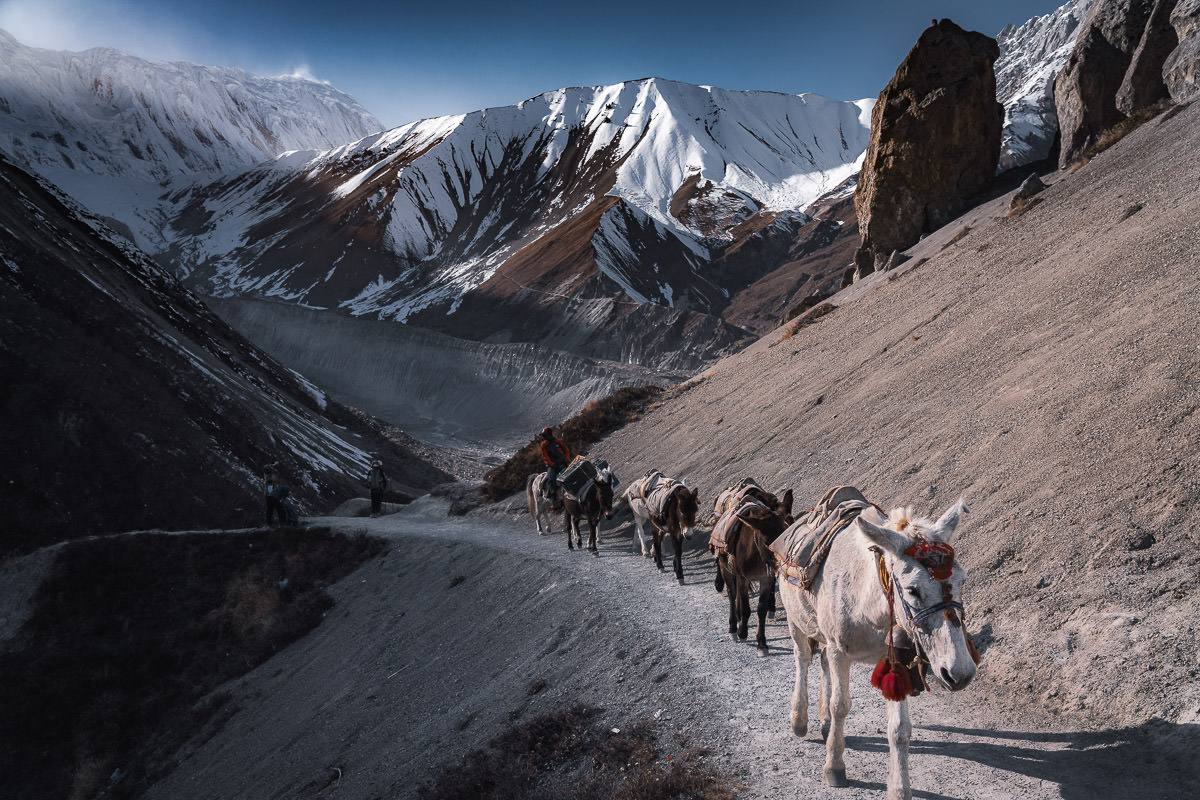
TREKKING ACROSS THORONG LA PASS
The long day up and down from Tilicho Lake and then from Tilicho Base Camp really took it out of us. However, the show must go on and we made a big effort to push all the way through from Shreekharka to Thorong Phedi. This is the base camp for the Thorong La Pass, which is the penultimate point and highest elevation of the trip.
The views continued to be immense on the journey to Thorong Phedi, but a third straight day with a vertical kilometer of incline and 20km of distance took its toll. We arrived late to Thorong Phedi, just before the sunset as you can see in the first image below.
The tea house at Thorong Phedi was buzzing, packed to the rafters. Many groups set off as early as 2:30 am on their quest to cross the path. We decided to bring up the rear and set off an hour before sunrise at around 5 am after a quick breakfast in the tea house.
The journey across the path begins with about 500m of elevation gain while ascending up relentless switchbacks. You can see the switchbacks from the tea house in the image below. After about 1.5 hours, trekkers reach the ‘high camp’, which is actually where many people stay on their approach to Thorong La Pass. It will make the pass day shorter but the prior day longer. It’s all about preference.
After the high camp, the scenery turns from rock to snow. We are now in a white, winter wonderland as we cross the 5000m mark on our journey across the pass. Up a seemingly never-ending slope, we wind our way around each corner.
Secretly, we are hoping to see the prayer flags of Thorong La but they never come. What we do find is a tea house serving overpriced but highly necessary instant coffee and tea. Here we recharge for half an hour before making our final push to the pass.
About an hour further and we make it up to the pass after about six hours of trekking. My dad and his mates are gassed but glad to be at the highest point of the trip. We hang out, take a few photos and even witness a huge avalanche from the seracs on the right side. Luckily it dispersed down to the side of the mountain and not toward us.
The journey down from Thorong La Pass should be straightforward and is only about eight kilometers. However, with icy conditions and slippery rocks, it was slow-going. It is highly recommended to bring micro spikes for this descent and for the descent from Tilicho Lake. Even though you will only use them twice, they are worth bringing along.
Late in the afternoon, we roll into Muktinath after crossing over into the Mustang region from the Annapurna Sanctuary side. It’s beautiful scenery but we are all just glad to make it to the hotel. It was a pretty tough ‘summit’ day all things being said.
Many trekkers will walk one more day to Jomsom before flying to Pokhara. However, we decided to take a Jeep for about $15 per head. It’s only an hour’s jeep ride to Jomsom.
I’d advise taking the Jeep as the trek looked like it went alongside the road in hot, exposed, dry terrain for twenty kilometers. It’s a brutal and unnecessary section of trail to walk but some purists may like to complete the old ‘original’ circuit. If that is you, make sure you walk all the way to Pokhara, and don’t cheat with any planes from Jomsom!
We spent the night in Jomsom and celebrated with a couple of beers. The next morning, we watched as the light planes flew into the airport. It’s a unique landing strip with an amazing backdrop of mountains on all sides. The planes take off and do a full U-turn immediately before flying up and out of the valley with views of Dhaulagiri (8,167m) on the right.
After a few nights in Pokhara, we flew back to Kathmandu to wrap up an incredible journey on the Annapurna Circuit with Himalayan Masters .
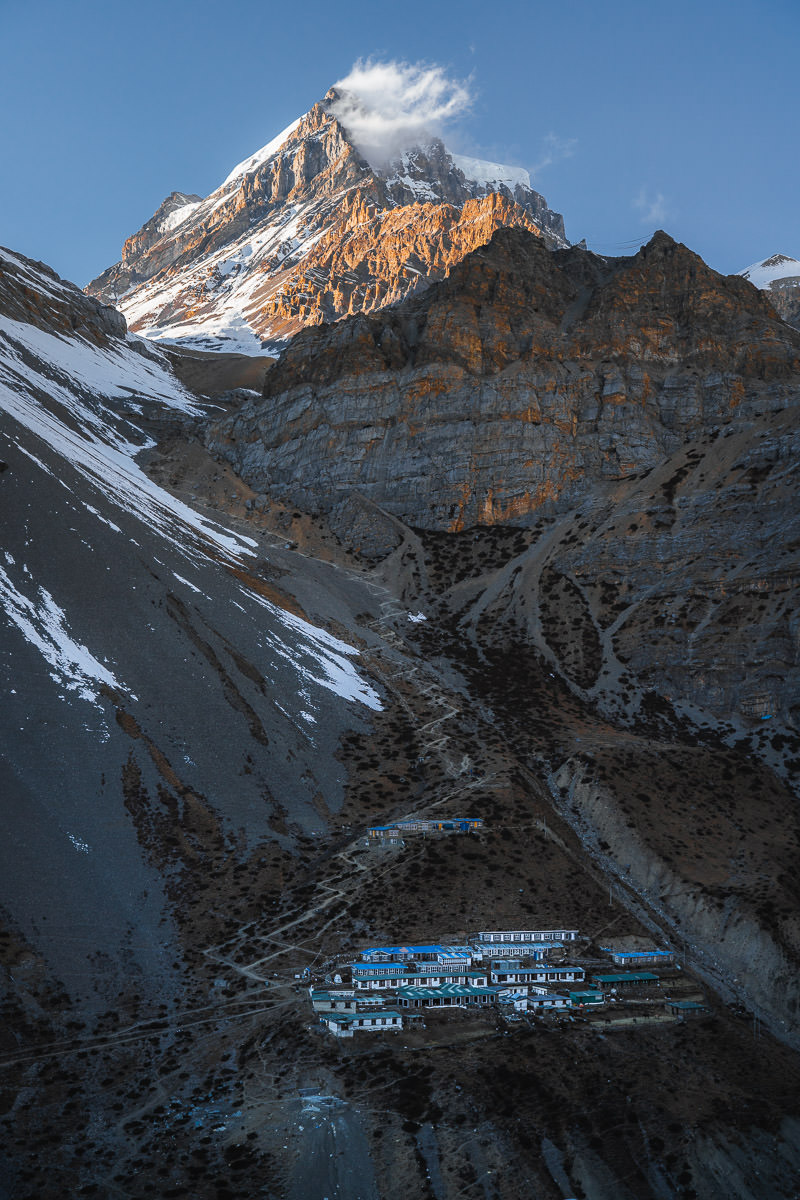
I hope you enjoyed this guide to the Annapurna Circuit Trek in Nepal and have a great experience yourself! To finish up, here is a photo from the epic Jomson airport. Not a bad way to end the trip.
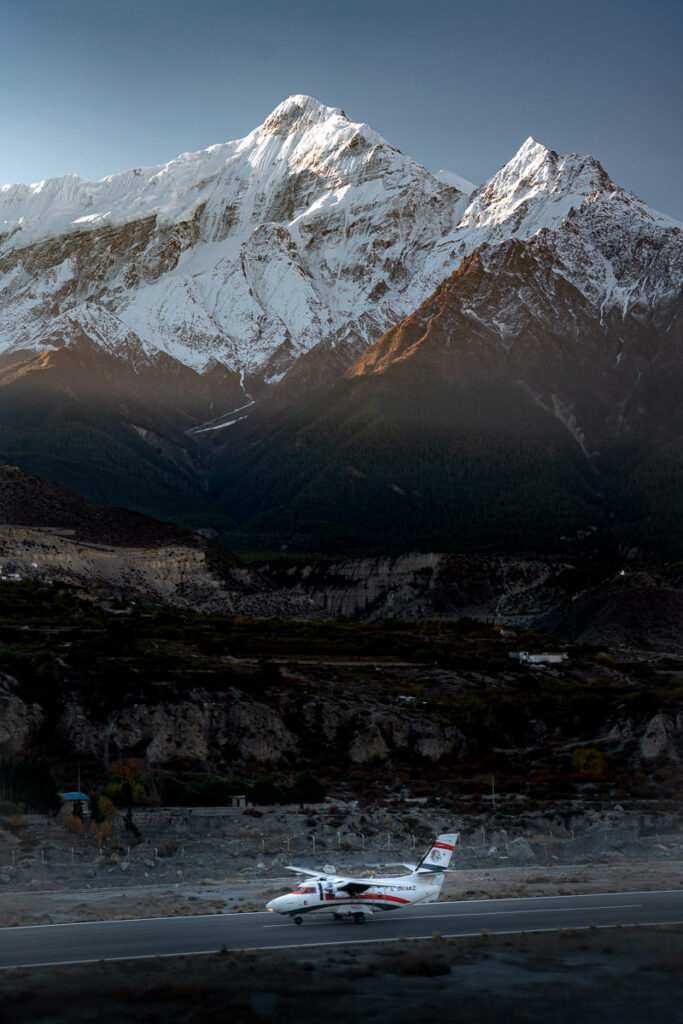
HAVE YOU READ MY OTHER NEPAL BLOGS?
I’ve been lucky enough to have many awesome adventures in Nepal, which you can check out below where I’ve listed some of my favorite blog poss from Nepal.
- The Most Iconic route: Everest Base Camp Trek
- The Most Scenic Route: Annapurna Circuit Trek
- My Favorite Trek in Nepal: Manaslu Circuit Trek
- An Easy Nepal Trek: Langtang Valley Trek
- A great beginner peak: Island Peak Climb (6,165m)
- My Favorite Climb in Nepal: Climbing Ama Dablam (6,812m)
- My first 8000er: Climbing Manaslu (8,163m)
- My toughest climb in Nepal: Climbing Makalu (8,463m)
- Where to stay: 16 Best Places to Stay in Kathmandu

Sunday 11th of June 2023
Hi, I noticed a news that Nepal treks should only be allowed only with a guide, starting from April 2023. Your article seems to be from June 2023. Does it mean that Annapurna Circuit has an exemption? Thanks a lot!
Sunday 2nd of July 2023
Thanks, honestly, this is a reason for me not to even think about Nepal and consider e.g. Patagonia
Sunday 18th of June 2023
Anything above 3000m I believe you need a guide now
Thursday 9th of March 2023
Please tell me more about your photography set up. Camera, lens, gear etc Thank You! :)

The Annapurna Circuit Trek Itinerary: the ultimate guide
This post offers you the ultimate Annapurna Circuit trek itinerary. The Annapurna Circuit trek was once the most popular tea house trek in Nepal . In about a month it was possible to walk around the Annapurna mountain peaks. This trek was famous for its ethnic villages, natural beauty and easy access from Kathmandu or Pokhara.
But the Annapurna Circuit trek has changed tremendously in recent years. There was a time that the further up you went, the more isolated the villages were. It took people days on foot to reach the nearest city, the nearest school or the nearest health care post. For tourists, this remoteness was part of the charm.
Ongoing road construction now connects most villages on the Annapurna Circuit with the outside world. Jeeps drive up and down on dusty roads, changing the landscape for better and worse. Tourists planning a trek in Nepal are wondering whether the Annapurna Circuit trek is still worth it.

Why choose the Annapurna Circuit trek
Despite the new roads going up the Marsyangdi and Kali Gandaki valleys, the Annapurna Circuit trek is still very much worth it. Although many things have changed with the new roads, a lot of things also remained the same. People are just as friendly, the villages just as authentic and the mountain views just as spectacular.
In short, it is still a very beautiful trek with a huge variety in landscapes, villages and people. The road itself is nothing more than a dirt track and actually carries relatively little traffic. In addition, there are plenty of alternative side trails to bypass them all together. The NATT trails set up by Prem Rai and Andrees de Ruiter are well marked and follow the traditional circuit, but avoid the road as much as possible.
The Annapurna Circuit trek requires a certain amount of time, but most of the hike is easygoing. Gradual climbs and well marked trails with frequent restaurants and lodges to take a break. What makes it challenging is the tough day you climb the Thorung La Pass and the altitude after Manang.
To prevent altitude sickness it is important to give yourself enough time to acclimatize. Don’t go up too fast and take some days to rest. The better your body has adjusted to the height, the easier the climb up to Thorung La will be.
This was my first trek in Nepal and even though many others followed such as the Langtang Trek , Poon Hill trek and The Gokyo lakes trek , I still consider myself an amateur hiker. Thorung La was difficult, but I made it. If I can do it, you can too, as long as you prepare well.

Annapurna Circuit trek itinerary
The classic Annapurna Circuit trek itinerary started in Besisahar where you climbed up the Marsyangdi valley towards Manang, crossed the Thorung La Pass, visited Muktinath and Jomsom and then walked down the Kali Gandaki valley towards Beni. This took about 20 – 30 days
The roads give you more flexibility in where to start or end the trail as well as how much time you take. Jeeps go as far up as Manang on the Marsyangdi valley side and Muktinath on the Kali Gandaki valley side.
Clockwise or anti Clockwise ?
The Annapurna Circuit Trek is a loop with different starting and end points. The first thing to decide is whether you hike clockwise starting at the Kali Gandaki valley or anti clockwise starting at the Marsyangdi valley.
The general advice and also my recommendation is to hike anti clockwise from east to west. This is the easier and safer direction to go. The Marsyangdi valley offers a more gradual climb and Manang is a great village to acclimatize well, before attempting Thorung La.
The Thorung La Pass is at 5416 meters high and altitude sickness is a serious risk. From Manang to Thorong La, there are several more villages like Yak Kharka (4020 m) and Letdar (4230 m) to stop and acclimatize or get help if you do suffer from altitude sickness. Thorung Phedi (4450 m) and High Camp (4850 m) are the last lodges before the pass.
From west to east the last village is Muktinath (3750 m) and a few basic lodges at Charabu (4210 m). After the last lodge it is a very long and steep ascent to Thorung La with nothing in between. Taking this approach is not only more difficult and requires you to be very fit, it is also potentially dangerous. You go high quickly and without proper acclimatization small things like bad weather or an injury can become very problematic.

How much time?
The roads have made it possible to do the Annapurna Circuit trek in much less time than the original 30 days. Still, the Annapurna Circuit trek is an area where slow travel is very rewarding. The villages on the way are very interesting and a destination in their own right. Furthermore, there are lots of side trips to escape the crowds.
Another reason to take it slow on the Annapurna Circuit Trek is again the altitude. Yes it is possible to take a jeep all the way to Manang (3520), but you will not only miss out on lots of beautiful scenery, you will also increase your risk of getting altitude sickness.
Looking at the distances and trekking times, it looks possible to trek from Manang to Thorong La in less than two days, but again, this would be very foolish. Experts advise to not ascend more than 300 – 400 meters per day once you are above 3000 meters high.
On the Annapurna Circuit trek this advice translates in at least one acclimatization day in Manang and another acclimatization day in Letdar before spending the night at Thorung Phedi. I followed exactly this advice and still struggled with the altitude when crossing the Thorung La pass.
Even if you are short on time, you need to acclimatize. You could do the Annapurna Circuit trek in 2 weeks if you decide to fly from Jomsom back to Pokhara. If you have more time, walking down the Kali Gandaki valley is definitely worth it. Although road construction has had a big impact here, I still enjoyed the villages of Marpha and Tukuche as well as the scenery from Tukuche to Letdar and Ghasa.

Where to start the Annapurna Circuit trek
With jeeps now going all the way to Manang, where to start the Annapurna Circuit trek has become a big question. I already mentioned that going straight to Manang isn’t the best idea for several reasons. In fact, my favorite trekking days were from Chame to Pisang and Pisang to Manang.
Some trekkers still decide to follow the original Annapurna circuit trek itinerary and start at Besisahar. Because I had recently done the Poon Hill trek through the lower foothills of the Annapurna’s I decided to take a jeep up to Syange.
Others start at Bhulbhule or Chame. To help you decide, it is maybe good to know that the road is most busy between Besisahar and Bhulbhule although there is an alternative NATT trail as well.
From Kathmandu there are direct buses all the way up to Bhulbhule. The direct bus is a great option if you like to start in Bhulbhule. If you prefer to start later on, it is better to take a bus to Besisahar and then change to local jeeps that go all the way to Syange, Chame or even Manang.
My personal advice is to start no further than Chame. The scenery after Chame is very beautiful.
Where to end the Annapurna Circuit
A lot of hikers end their Annapurna Circuit trek in Jomsom from where you can fly back to Pokhara. A comfortable option if you are short on time, but you will miss out on the beauty of the Kali Gandaki valley.
Marpha and Tukuche are very scenic traditional villages worth a visit. Furthermore, the hike from Tukuche to Lete and Ghasa is very beautiful. I hiked in the Kali Gandaki valley twice. The first time I ended my hike in Tatopani. A small village with warm water pools. The second time I ended my hike in Ghasa.
From both towns it is possible to take a jeep down to Beni. There you can change on a bus to Pokhara.

My Annapurna circuit trek itinerary
In this Annapurna Circuit trek itinerary I mention every day the amount of time it took me from start to finish. I am a slow hiker though. I like to take frequent breaks to enjoy the beautiful views. If you are a fit hiker, you can probably do it in much less time
Day 1: Bus from Kathmandu to Besisahar/Syange
I started my Annapurna Circuit trek itinerary from Kathmandu where I took a bus to Besisahar. The original start of the trail. After a long and bumpy bus ride of 8 hours in a crowded bus I was happy to arrive for a late lunch.
I was curious about the new road all the way up to Manang. As I had recently done the Poon Hill trek I already saw the lower foothills of the Annapurnas in all its beauty and decided to skip the first two days of trekking by taking a jeep to Syange.
At the jeep station I quickly found a jeep that was slowly filling up. Jeeps leave mostly in the early mornings. It was already late in the afternoon and now it took at least two hours before the jeep had enough passengers and cargo.
It is only 30 kilometers from Besisahar to Syange, but the jeep journey took over 3 hours. I soon regretted my decision not to walk. The first part to Bhulbule was quite ok, but after that the road got really bad and scary.
I am glad I had a careful driver that knew what he was doing and took it slow. Not all drivers are like that in Nepal. There was even an extra person that frequently got out to check the road or to remove stones. Just as it got dark I saw the lodges of Syange.
Logistics : Direct buses to Besisahar (7 – 8 hours) and Bhulbule (8 – 9 hours) leave everyday from the Gongabu bus station (new bus park or Machapokhari) in Kathmandu. Get there early as it is a chaotic bus station and buses leave between 6 – 8 AM in the morning. It is best to reserve your tickets a day in advance at the bus station or at a travel agency in Thamel.
For destinations further up the trail (Syange, Ghermu, Chame, Pisang, Manang) take a bus to Besisahar. Jeeps leave from the jeep bus station in Besisahar. There is a dual price system with foreigners paying slightly more.
Personally, I would start walking in Bhulbule and certainly not go much further than Syange by jeep. After Bhulbhule the road is not in a very good condition and the journey will be adventurous to say the least.
Day 2: Syange – Tal
16 kilometers, 8 hours
I always feel excited on my first day of hiking. Being in the mountains with the fresh air feels invigorating. After an early breakfast I left Syange and immediately entered a narrow gorge where I shared the road with porters carrying chickens and goats.
Walking on the jeep road wasn’t as bad as I had imagined and there was little traffic. The scenery was nice with waterfalls on the other side of the road and the Marsyangdi river below.
The Marsyangdi river kept me company for the rest of the day. I had lunch in Chamye after which it was a steep climb over boulders up to Tal.
Insider tip: there is an alternative NATT trail from Ghermu to Jagat that bypasses the road. It is much longer and I heard the path is very narrow and close to the edge. With my fear of heights I decided to stay on the road.

Day 3: Tal – Danaque
11 kilometers, 5 hours
From Tal you can choose to make it a long day to Chame (20+ kilometers) or split it up in two days and spend the night somewhere in between.
I left Tal to see how far I would come that day. Till Dharapani the trail was very quiet and scenic with several waterfalls. At Dharapani the trail joined the road again. Both Dharapani and Bagarchap are nice villages with lots of restaurants.
At Bagarchap I had my first Annapurna views and I stopped for lunch. I already knew Chame would be too far for me, but I could still hike a bit more and decided to continue to Danaque. A nice village with a Mani wall and prayer wheel.
Insider tip : It is possible to take an alternative NATT trail from Dharapani to Bagarchap up to the village of Odar. It adds 2 hours to your trekking time and is a steep 200 meter climb up and down again.

Day 4: Danaque – Chame
12 kilometers, 6 hours
Today started with a steep and long climb through the forests from Danaque to Timang. A difficult beginning, but the rewards were beautiful mountain views once I reached the top. After Timang the ascent became more gradual and passed the occasional village.
I noticed more and more Buddhist influences like mani walls, prayer wheels and chortens. The mountain views too became more beautiful as I approached Chame. A lively village right next to the Marsyangdi river.

Day 5: Chame – Pisang
14 kilometers, 7 hours
The part from Chame to Pisang was simply spectacular. Panoramas on the snow capped peaks of the Annapurna’s all day as I hiked along the Marsyangdi river. The increase in altitude is also visible as pine forests give way to open fields with sweeping views.
This was one of my favorite days on the Annapurna Circuit trek. Parts of the road were carved out of the side of the mountain and high above the river. With my fear of heights this was a bit of a challenge, but I made it.
When I arrived in Pisang it was tempting to stay in lower Pisang. I heard the views are much better from Upper Pisang though and so they were.

Day 6: Pisang – Manang
18 kilometers, 8 hours
Pisang to Manang was another beautiful day on the Annapurna Circuit trek. The trail is a gentle climb with beautiful views all around you. I enjoyed every minute of my hike, but also started to feel the effects of the altitude.
From Pisang to Manang you can choose to hike the easier lower trail or a more spectacular higher trail. Because I woke up with a slight headache I didn’t want to add 3 more hours to my hiking trail and choose the lower option on the road.
I am sure the higher trail offers even better views, but for me it was a good decision to take it easy. By the time I was in Manang (3540 m) I was having mild symptoms of Altitude sickness.

Day 7: Manang acclimatization
In Manang I had a much needed acclimatization day. My first night in Manang was a night of insomnia, vivid dreams and a mild throbbing headache that got only less in the early hours of the next day. Mild symptoms of altitude sickness.
Manang is a small village, but there are lots of side trip possibilities. The strenuous hike to the ice lake is very popular, but I did not feel fit enough. Another popular hike is to Chongkor viewpoint where you can see a glacial lake. There are also several gompa’s in the area you can visit.
I went to the Chongkor viewpoint to see the lake and then visited the excellent information session about altitude sickness from the Himalayan Rescue Association. They give this for free every day at 3 pm.

Day 8: Manang (3540) – Yak kharka (4020)
10 kilometers, 5 hours
My second night in Manang I slept well. I therefore decided to continue to Yak Kharka. An elevation increase of 500 meters.
The climb was hard. Although the obvious symptoms of altitude sickness were gone, I was more easily out of breath and every step seemed to take a lot of energy. The next village, Gunsang, was only 3 kilometers away but I took a long tea break.
With a cup of tea and the sun warming me up in the chilly morning air I still felt so lucky to be here. The views on the Annapurnas and the flocks of birds flying by were all so beautiful.
After Gunsang the landscape changed again to high altitude fields with shrubs and grazing goats. The trail climbs slowly to over 4000 meters high. Technically, the path is very easy, but my body was struggling more than ever.
I was glad to see the cluster of lodges at Yak Kharka. Yak Kharka translates as yak pastures and therefore it was no surprise to see a few yaks wandering around.

Day 9: Yak kharka (4020) – Letdar (4230)
2 kilometers, 2 hours
I slept well at Yak Kharka and woke up full of energy. However, after only 20 minutes of hiking I felt tired and out of breath. Luckily I had already made the wise decision to stay in Letdar.
Letdar is less than 2 kilometers from Yak Kharka and it is a very easy hike, but I can feel my body needs an extra night to adjust to the altitude.

Day 10: Letdar (4230) – Thorung Phedi (4540)
6 kilometers, 4 hours
With an extra night at Letdar I felt more prepared to continue to Thorung Phedi (4540). It was an easy hike except for a scary part where there is a risk of landslides. Thorung Phedi is right after that.
It is possible to continue to High Camp (4850). The last lodge before Thorung La, but the general advice is not to sleep here, because of the altitude. It does make for a great afternoon hike to help acclimatization

Day 11: Thorung phedi – Muktinath
15 kilometers, 10 hours
The day you cross Thorung La will be the most beautiful, but also most difficult day on the Annapurna Circuit Trek.
Most people start early as the weather is less windy in the morning. I started around 4 AM. The ascent to high camp was difficult and I definitely felt the altitude. At High Camp I was in doubt whether I should stay one more night here before attempting the pass.
After a quick cup of tea I pushed myself on to continue. It was difficult. Every few steps I was out of breath and had to stop. My head started hurting again and I felt very tired. There were many false summits and I started to wonder whether I should turn back.
After 4 hours I finally saw the bundle of prayer flags that is Thorung La at 5416 meter. I felt pure joy that I made it, but at the same time absolutely miserable because of the altitude. After a quick selfie I did not even want to stop for a cup of tea. All I wanted was to go to a lower altitude.
The first hour I happily hiked down and started to feel better by the minute. Then I realized that the 1600 meter descent to Muktinath is actually more difficult than the ascent. My knees started hurting, my muscles trembling.
It was a very long day. Looking down I could see Muktinath in the distance. Ít just didn’t seem to come closer. After 4 hours I arrived at a cluster of lodges called Charabu. If they weren’t full I would probably have stayed here.
After a quick dahl bath I had to continue to Muktinath. The last bit was the most difficult. I stumbled into the first lodge I saw, had dinner and went to bed.

Day 12: Muktinath – Kagbeni
12 kilometers, 4 hours
In Muktinath I woke up feeling all my muscles from the steep and long descent yesterday. Slowly I got out of bed. This is my third time in Muktinath. A small village home to an important Vishnu temple popular among Indian and Nepali pilgrims.
As jeeps now go all the way from Pokhara to Muktinath, it is a busy town and a culture shock after the desolate stretch of barren rocks that I walked through yesterday. I brought a short visit to the temple and then walked straight to Jharkot.
Jharkot is a traditional village with mud and stone houses. The signs of animist religions that predate Hinduism and Buddhism give a clue to its old age. Rather than just passing by I would recommend to take a look and wander through the narrow streets for a bit.
After Jharkot, it is a beautiful hike down to Kagbeni. Another traditional village that is at the border of Lower and Upper Mustang. Mustang was once an independent kingdom that played a big part in the salt trade between Tibet and Nepal.
Beyond Kagbeni lies Upper Mustang. A remote region that remains isolated and protected from mass tourism by expensive permits. Kagbeni is as far as you can get and gives a good sense of the unique culture of Upper Mustang that is still very close to that of Tibet.
Kagbeni is an interesting mix of new hotels and restaurants catering to tourists as well as medieval monasteries and ancient fortress ruins. The 15th century red monastery stands out between the whitewashed mud homes.
The Red House Lodge was one of the most interesting places where I stayed. It has its own 350 year old buddhist chapel and the best dried yak meat (yak sukuti).

Day 13: Kagbeni – Marpha
17 kilometers, 6 hours
The hike from Kagbeni to Jomsom follows the riverbed of the Kali Gandaki river. The Kali Gandaki valley lies in the rain shadow of the Annapurna mountains and therefore the landscapes are quite unique.
Barren desertlike mountains that differ in color. Different shades of brown, gray and yellow contrast sharply with the deep blue sky, white snow capped peaks and green farm fields.
South of Kagbeni starts Lower Mustang. An area home to the Thakali people that also played an important role in the salt trade. Between Kagbeni and Jomsom there is not much but spectacular landscapes.
Jomsom is the first Thakali village. Because of its airport it is very well developed and touristic. This is where most people end their Annapurna Circuit trek and take a plane back to Pokhara.
If you do decide to continue on foot it is much better to stay in Marpha. A more authentic Thakali village with an old monastery and the so-called apple capital of Nepal. I was not a big fan of the local dried apples, but the apple pies here were delicious.

Day 14: Marpha – Tukuche
7 kilometers, 3 hours
I thought Marpha was one of the most interesting villages on the Annapurna Circuit trek. Marpha alone is a reason why you should not stop at Jomsom.
Marpha is a true Thakali village and you can see that people have done much effort to preserve their traditional architecture and culture. Iconic are the flat mud roofs that are used to store stacks of firewood. The roofs are also used to dry the apples and other food items.
Rather than leaving in the morning to start hiking, I spent some time exploring the village. There is a monastery in the center of the village as well as above the hill with beautiful views. You can also visit the apple gardens and taste apple products at the apple distillery.
The Thakali people are famous for their cuisine. Tibetan dishes like Thukpa (noodle soup) and Tsampa (barley porridge) are popular. But most famous are the Thakali sets. A more luxurious version of dahl bath with all kinds of extras like fermented spinach (gundruk) and pickles (aachar). I couldn’t resist having one for lunch before hitting the trail again.
Tukuche is only 7 kilometers away, but another picturesque Thakali village that is very well worth the detour from the main road. When I arrived they were filming a Nepali movie song and it seemed all the children of the village were out and about to see what was happening. I also enjoyed the show and decided to stay in Tukuche for the night.

Day 15: Tukuche – Ghasa
20 kilometers, 9 hours
After Tukuche the landscape started to become more green again with trees and bushes. Tukuche was the last lively Thakali village on the trail. The other villages were small with just a few lodges. They seemed rather empty and not that inviting.
I decided to hike all the way to Ghasa. It was a long day, but because it was downhill it was not that difficult. Right before Ghasa is a hanging bridge high above the river. I knew it was coming and with my fear of heights a scary experience.

Day 16: Ghasa – Tatopani
15 kilometers, 6 hours
This was going to be my last day of hiking on the Annapurna Circuit trek. Back to the lower altitudes of the Annapurna’s, the landscapes reminded me a lot of the Poon hill trek . Lush and green and also more warm and humid.
Yesterday’s day was maybe a bit too long for my liking, but the last kilometers of today I felt sad it would be over soon. Tatopani has several warm water pools annd they felt like a great reward after 17 days on the road.

Day 17: Tatopani – Beni/Pokhara
From Tatopani I took the jeep to Beni. The road became more busy and there were not a lot of ways to avoid it. It is also possible to hike to Ghorepani and connect with the Poon Hill trek .

The Annapurna Circuit Trek Travel tips
Annapurna circuit trek permits.
For the Annapurna Circuit trek you need two permits.
TIMS card : The Trekkers information management card is necessary for almost all treks in Nepal. You can get your TIMS card at the Tourism Board office at Bhrikuti Mandap in Kathmandu. Bring your passport and two passport size photos. The TIMS card costs 2000 nepalese rupees.
Annapurna Conservation Area permit : For the Poonhill trek you also need a national park entrance permit. I recommend you to get it as well at the Tourism Board Office at Bhrikuti Mandap in Kathmandu. This costs 3000 nepalese rupees.
Do I need a guide on the Annapurna Circuit?
The Annapurna Circuit trek is moderately difficult, but easy to do without a guide. The trails as well as the NATT trails are well marked. Unless you go off season there will be enough other hikers on the trail to keep you company.
I hiked the Annapurna Circuit alone and did not experience any problems. When hiking alone I always make sure not to hike after sunset and listen carefully to my body. At Manang I did feel mild symptoms of altitude sickness and took two acclimatization days as well as an extra night in Yak Kharka and Letdar.
If you are alone and not that experienced, you might want to consider joining a guided trek or hiring a guide, porter or porter guide.
In Nepal there is a clear distinction between a porter and a guide. A guide shows you the way and can tell you more about the history and the culture of the places you visit. A porter will only carry your luggage. Despite their heavy burden they often walk far in front of you and might have reached the lodge when you are only midway. A porterguide is less common, but does both.
In Pokhara I can recommend the 3 sisters adventure trekking that works to empower women and trains women to become trekking guides in Nepal.
Update April 2023 : The Nepal Tourism Board issued a press release that trekking without a guide is no longer permitted from 1 April 2023 onwards. Trekkers planning to hike in Nepal’s National Parks where you normally need a TIM’s card should have a government licensed guide that is registered with the official Trekking Agency Association of Nepal (TAAN) . It is unclear yet how this rule will play out in practice. Everest issued a press release stating that they will not enforce it. Other areas do. However, there are no guidelines on how they are going to implement the ban on solo trekking .

Accomodation on the Annapurna Circuit
Along the Annapurna Circuit trek there is plenty of accomodation and teahouses to choose from. They are basic and can’t be booked online beforehand. There is a first come first serve basis and some lodges are fully booked by big tour groups.
There are enough lodges that there will always be a bed for you somewhere. I trekked the Annapurna Circuit twice in spring and in November and never had any problems finding a place to stay.
The prices of accomodation is incredibly cheap, sometimes even free, but they do expect you to order dinner and breakfast at their establishment. Things like hot showers and WIFI are getting more common, but are sometimes at an extra cost.

Food on the Annapurna Circuit
The good thing about tea house treks in Nepal is that however basic lodges might be, the food is often quite good if you stick to Nepali cuisine . Yes, many lodges try all kinds of international dishes to attract tourists, but in my opinion often not the best choice.
When trekking in Nepal I eat Dahl bath at least once a day. This national dish of rice with lentils knows a huge variety in how it is prepared. Different vegetable curries from fermented spinach to roasted cauliflower and different pickles to spice it up. Not one dahl bath is the same. Other Nepali foods to try are Tibetan bread, Thukpa and Momo’s.
The Annapurna’s are a multicultural area with local foods as well. In Kagbeni it is possible to find yak meat on the menu. Marpha is the apple capital and has the best apple pies as well as dried apples. In the south are the Gurungs with specialities like dried meats (sukuti) and fermented leaf curries (gundruk).
When to hike the Annapurna Circuit
The best time to go trekking in Nepal is Spring and autumn.
January and February are too cold with lots of snow on the trail. The Thorung La Pass will be closed due to heavy snowstorms and a risk of avalanches. By March/April the pass reopens again, but you can still expect snow at the higher altitudes.
April and May are the warmer months before the monsoon and a very good time for the Annapurna Circuit Trek. The blooming flowers and rhododendrons are a highlight in this period. At the lower altitudes it can already become hot, dusty and humid while the higher altitudes are comfortable.
June, July and August are the monsoon months. The Marsyangdi valley up to Manang sees lots of rainfall. The trails will be muddy with lots of leeches, but the landscapes will be lush and green. The Kali Gandaki valley is in the rain shadow and sees much less rain.
September, October and November are the most popular months for trekking. Autumn brings clear blue skies and mild temperatures before the cold sets in in December. Autumn is also a festive season with the celebration of Tihar and Dashain. Nepal’s biggest festivals .
Regardless of the seasons, the weather conditions at Thorung La can change rapidly and there is always a chance of unstable weather, cold and snow storms. It is important to check the weather forecast before crossing Thorung La. A freak storm in October 2014 killed several trekkers as they got stuck in bad weather and snow.

Altitude Sickness on the Annapurna Circuit
The Annapurna Circuit trek involves a serious risk of altitude sickness. Crossing the Thorung La Pass at 5416 meters high requires proper acclimatization. To allow yourself enough time to do so, it is best to trek anti clockwise from east to west.
Experts advise to not ascend more than 300 – 400 meters per day once you are above 3000 meters high. Pisang (3310) is the first village above 3000 meters and that is why it is not wise to take a jeep straight to Manang at 3540 meters high. Those first days of walking at the lower altitudes are not only beautiful, but helps your body adjust to the increasing altitude.
For the Annapurna Circuit trek, the general advice is to spend at least one acclimatization day in Manang and another day in Letdar before spending the night at Thorung Phedi. I followed exactly this advice and still struggled with the altitude when crossing the Thorung La pass.
The key to prevent altitude sickness is to take it slow, give your body enough time to adjust to the height and to drink enough water. Diamox is a medicine that might help your body to acclimatize, but will not cure altitude sickness once you have severe symptoms. In that case, the only remedy is to go down to a lower altitude as soon as possible.
Mild symptoms may include being tired and more easily out of breath. More severe symptoms of high altitude sickness are headache, dizziness, trouble sleeping, breathing problems, loss of appetite, nausea and vomiting.
Severe symptoms indicate you are developing high altitude cerebral edema (HACE) or high altitude pulmonary edema (HAPE). Both conditions are fatal if you do not get to a lower altitude on time.
Take these symptoms seriously and watch out for symptoms in others, even in your nepali guides or porters. It is a misconception that they cannot get altitude sickness. The health clinic in Manang gives daily information sessions about altitude sickness that I can highly recommend.
The Annapurna Circuit Trek Books and Guides
Cicerone and trailblazer both have excellent and comprehensive guides about treks in Nepal with detailed guides about the Annapurna. Another option is the Lonely Planet’s trekking in the Nepal Himalayas guide.
The Himalayan Map house published the guidebook from Prem Rai and Andrees de Ruiter who developed the NATT trails on the Annapurna Circuit trek.
The Annapurna Circuit Trek packing list
If you need to carry your own gear on a multi day trek the advice is to bring as little as possible. The Annapurna Circuit trek is not a difficult trail. There is no need to bring a tent or food. Below a few things to consider
Sun protection : no matter what time of the year you will need to bring protection against the sun. Sunscreen and a hat are a must. There are stretches with little shadow
Rain protection : there is always a risk of rain. I brought a poncho along that protected both me and my backpack from the rain.
Sturdy shoes : There is no need for proffesional hiking boots. However, there are some rocky trails so do bring sturdy shoes that fit you well. It’s important you don’t bring brand new shoes. Make sure your shoes are tested and comfortable to prevent blisters.
Hiking socks : Besides good shoes, good hiking socks are key to prevent blisters. Merino wool socks are lightweight and dry quickly. Wrightsocks are specially designed with double layers to prevent blisters. Decathlon has good merino wool socks too.
Layers : there can be a big difference in temperatures during the day and night. The best way to deal with this is to wear layers. As a base layer I bought merino wool tshirts at Decathlon. They are lightweight and dry quickly. I had a fleece vest as a midlayer and as the upper layer I had a windproof jacket.
Backpack : Your shoes and backpack are two things that will have a big influence on the comfort of your multi day trek. I recommend to go to an outdoor store to get some good advice to buy a backpack that fits your torso length and that is comfortable when you wear it. I own the Osprey Fairview trek 50 that I am very happy with.
Reusable water bottle : to prevent plastic waste I always bring a reusable water bottle with me and a water filter or steri pen.
Sustainable Travel on the Annapurna Circuit Trek
The Annapurna Circuit trek is very popular. The trails become more crowded and pollution is a growing problem. Traveling sustainably to the Himalayas is essential to minimize your environmental impact and preserve the area’s natural beauty for future generations.
Support the local community : You can support the community by purchasing goods and services from local vendors. It is better to try Nepali Cuisine that uses local ingredients rather than imported foreign foods. Nepali food is vegetarian friendly and it is very easy to follow a vegetarian or vegan diet.
Stay in small scale sustainable hotels : It is also better to stay in locally-owned guesthouses or homestays to support the local economy directly. These accommodations often have a more positive impact on the environment compared to large hotels.
You can try to look for guesthouses or homestays that prioritizes sustainable practices. That said, environmental awareness is still low. It’s up to you to use water sparsely, turn off lights, air conditioning, and heating when leaving your accommodation.
Leave no trace principle : When hiking the Annapurna Circuit Trek, stick to designated trails to protect the fragile alpine ecosystem. Straying off the marked paths can cause soil erosion and damage to plant life. If you are lucky enough to spot wildlife, observe quietly from a distance to prevent disruption to their habitats and help maintain their natural behaviors.
I encourage you to take all your trash back with you and dispose of it responsibly. In other words, leave no trace of your visit. Even better is when you bring something to pick up any of the trash that other people left behind.
To avoid single-use plastics, invest in reusable items. For example, you can bring your own water bottle with a filter. At last, use biodegradable and eco-friendly personal care products to minimize pollution of water sources.
Respect the culture : Besides environmental concerns it is also important to be sensitive of the community’s way of life. Nepal is a multicultural country and on the trail you will encounter different ethnic groups.
People will appreciate it, if you dress modestly. Learning a few basic phrases in Nepali, can go a long way in building meaningful connections and to learn more about the local culture. Not everybody is happy to have their picture taken. When in doubt, ask permission.
Disclaimer : This post with a travel guide about the Annapurna Circuit trek in Nepal contains affiliate links. If you buy any service through any of my links, I will get a small commission at no extra cost to you. These earnings help me to keep Backpack Adventures alive! Thanks for your support!

2 thoughts on “The Annapurna Circuit Trek Itinerary: the ultimate guide”
I found your post incredibly useful. I appreciate the time and effort you took in gathering and posting all of this information. Thank you!
I have enjoyed looking at your photographs and reading your description of villages and landscape, food, and people. My husband and I lived in Marpha from 1981 to 1983! My husband was with the Food and Agriculture Organization and was helped develop a vegetable seed program with the farmers. Back then there was no electricity, no cell phones, and no road. We’re sorry to learn of the modernization which detracts from the experience of being geographically isolated and more dependent on using inner resources to survive. However, a lot of the new changes are beneficial to the villagers who require easier access to medical care. Back in he day, a porter with a wooden chair strapped to his back was the ambulance service. The sick person was strapped in and the porter ran all the way to Pokhara. Thanks for your interesting update on life along the Kali Ghandaki River.
Leave a Reply Cancel reply
Your email address will not be published. Required fields are marked *
- Kale by LyraThemes.com.
Himalayan Odyssey Nepal Trek
Best Himalayan Trekking Agency | 2024
Registration No: [74407/067/068]
Write a review on [Tripadvisor]
+977-(986)096-4103
[Available On: WhatsApp & Viber] Please feel free to contact us 24/7 !
Welcome Traveler's

Annapurna Circuit Trek
Annapurna circuit trek | 2024.
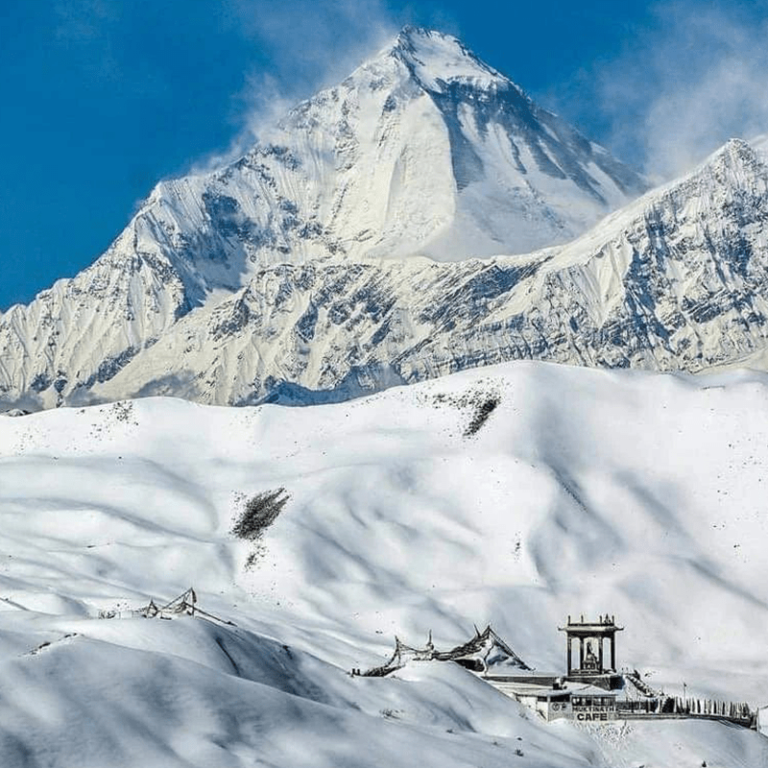
- Trip Duration: 12 Days
- Altitude: 5,416 m / 17,769 ft
- Best time: Feb-May, Sep-Dec
- Grade: Challenging
- Trek Type: Tea House
- Meals: Included
- Accommodation: Hotel & Tea House
Overview of the Annapurna Circuit Trek
The Annapurna Circuit Trek is undoubtedly one of the most extraordinary and unparalleled experiences a trekker can avail themselves of. With an extensive length of 160–230 km that covers four distinct districts, comprising Lamjung, Myagdi, Manang, and Mustang, this trekking route stands out as the most preferred circuit through the diverse natural vegetation, cultural beliefs, landscape, altitude, trail, pristine little settlements, culturally affluent tribal groups, and religious sects.
The trek begins in Jagat. As we gain altitude, the landscape and vegetation change, and rugged alpine terrain appears. The challenge of the trek is to cross the highest pass, Thorong La (5,416 m). The splendid snow-capped Himalayan views from the peak of the Thorong La Pass are just amazing and beyond expectation. Then we follow the trail to Muktinath temple, the temple of God Vishnu, the god of preservation. And the windy Jomsom, and just ahead we pass through the deepest gorge along the Kaligandaki River between Mt. Annapurna and Dhaulagiri. We then trek to the famous Gurung village, Ghorepani, and the famous Poon Hill viewpoint.
Highlights of the Annapurna Circuit Trek
- One of the most classic and oldest treks in Nepal,
- Thorang La Pass is the highest navigable pass (5,416 m) in the world,
- Descend into one of the deepest gorges in the world, the Kali Gandaki,
- Poon Hill is a hill station,
- Traditional Gurung, Tibetan, and other ethnic villages,
- Muktinath is a holy temple of God Vishnu,
- The natural hot spring of Tatopani.
Outline Itinerary of the Annapurna Circuit Trek
KTM ) Arrival in Kathmandu city, transfer to the hotel
Day 01 ) Drive to Jagat (1,300 m) (8/9 hours)
Day 02 ) Trek to Dharapani (1,860 m) (5/6 hours)
Day 03 ) Trek to Chame (2,620 m) (6/7 hours)
Day 04 ) Trek to Pisang (3,200 m) (6/7 hours)
Day 05 ) Trek to Manang (3,540 m) (5/6 hours)
Day 06 ) Acclimatization Day
Day 07 ) Trek to Yak Kharka (4,018 m) (6/7 hours)
Day 08 ) Trek to Thorong Phedi (4,560 m) (5/6 hours)
Day 09 ) Trek to Muktinath (3,767 m) via Thorang-La Pass (5,416 m) (7/8 hours)
Day 10 ) Drive to Jomsom and Tatopani (1,190 m) (6/7 hours)
Day 11 ) Trek to Ghorepani (2,874 m) (6/7 hours)
Day 12 ) Early morning hike to Poon Hill, trek to Ulleri (2 hours) and drive to Pokhara (3 hours)
PKR ) Drive or fly back to Kathmandu
KTM ) Departure to your home
Not satisfied with this itinerary?
Annapurna Circuit Trek: Detailed Itinerary
Ktm) arrival in kathmandu city, transfer to your hotel.
- Meals: Breakfast
- Accommodation: Hotel
- Altitude: 1,400 m, Kathmandu
At Kathmandu Tribhuvan International Airport, you will be received by a Himalayan Odyssey Nepal Trek guide/staff and transferred to your hotel. Stay overnight at the hotel.
Day 01) Drive to Jagat from Kathmandu via Besisahar (1,300 m) (8/9 hours)
- Meals: Breakfast, Lunch, Dinner
- Accommodation: Lodge
- Altitude: 1,300 m, Jagat
We take a drive from Kathmandu to Besisahar by tourist bus. We have breakfast and lunch on the way. The route takes us out of the Kathmandu valley along the picturesque Trishuli River to Besisahar. As we reach Besisahar, we drive towards Jagat by Jeep, following the Marshyangdi River. We will pass several beautiful villages, green paddy fields, and forests until we reach Jagat. Stay overnight at the lodge.
Day 02) Trek to Dharapani (1,860 m) (5/6 hours)
- Altitude: 1,860 m, Dharapani
We are walking on a rocky path next to the Marsyangdi River. We see beautiful waterfalls, green plants, and animals. The path goes up to a village called Tal. We keep going up the valley, using stone stairs, until we get to Dharapani. Stay overnight at the lodge.
Day 03) Trek to Chame (2,620 m) (6/7 hours)
- Altitude: 2,620 m, Chame
The path goes up along a river called Marsyangdi, going through trees like pine and fir. We’ll get to see great views of the mountains Annapurna II (7,937 m), Mt. Manaslu (8,156 m), and other peaks before reaching Chame. Stay overnight at the lodge.
Day 04) Trek to Pisang (3,200 m) (6/7 hours)
- Altitude: 3,200 m, Pisang
After breakfast, we will follow the Marsyangdi Trail to Bharatang. We will see Annapurna II (7,937m) up close from there. Next, we will climb a steep hill where we will see many oak, fir, pine, hemlock, and maple trees. We will have a great view of the Pangida Danda. Then, we will cross a suspension bridge, go up for a while, and then down to the valley floor. We’ll see dry, grazing land and reach Dhukure Pokhari. After walking for about half an hour, we will reach Pisang. Stay overnight at the lodge.
Day 05) Trek to Manang (3,540 m) (5/6 hours)
- Altitude: 3,540 m, Manang
We will start our day by walking on a dry trail where there is little rainfall and many beautiful landscapes. Two paths will take us to Mungi. We can take either of those two. The path that goes through Ghyaru, or Hongde, Ghyaru village on the harder path is especially attractive because of its lovely stone houses surrounded by fields of wheat, barley, buckwheat, potatoes, and beans. We will continue our journey to Ngawal, a village that has an old building called a gompa and ancient juniper trees. Next, we will follow a trail that will take us down to Mungji, where we will meet the other path. From there, we will go to the famous village called Manang. Enjoy looking at the beautiful Annapurna mountain range. Stay overnight at the lodge.
Day 06) Acclimatization Day
Today is the acclimatization day for our body to cope with gaining altitude and avoid any kind of high-altitude sickness. We will take a higher-elevation hike either to the ridge near the Gangapurna glacier or walk up to the cave above Manag village. We will visit the village and native people and gain insight into their lifestyle and culture during our acclimatization day. Stay overnight at the lodge.
Day 07) Trek to Yak Kharka (4,018 m) (6/7 hours)
- Altitude: 4,018m, Yak Kharka
The day starts with an ascent to Tengki, which is the last permanent settlement below the pass. We will walk upward until we reach Gunsang. The trail then turns northwest towards Jharsang Khola Valley. We walk on scrub juniper and alpine grass, which brings us to Yak Kharka. Stay overnight at the lodge.
Day 08) Trek to Thorong Phedi (4,560 m) (5/6 hours)
- Altitude: 4,560 m, Thorong Phedi
After having breakfast, we move towards the Thorong Phedi. We walk for about an hour and reach Churi Leder. We then descend to the river and cross it over the wooden bridge. The trail then becomes challenging as you climb upstream of Jharsang Khola on the ridge of the cliff and finally reach Thorong Phedi. Stay overnight at the lodge.
Day 09) Trek to Muktinath (3,767 m) via Thorang-La Pass (5,416 m) (7/8 hours)
- Altitude: 3,767 m, Muktinath
Today, we will walk through the highest point of the entire Annapurna Circuit. We will head towards the Thorong-La Pass (5,416 m) early in the morning and begin the ascent. The trail is steep and narrow, but if we walk uphill for about 4/5 hours, we’ll get to the top, which is 5,416 m. From there, we can see beautiful mountain ranges like the Annapurna range and the Dhaulagiri range. There are also some chortens and colorful flags that celebrate our hiking success. After taking some photos and enjoying the scenery, we will walk downhill over a rocky area and then through some green fields until we reach a place called Muktinath. Stay overnight at the lodge.
Day 10) Drive to Jomsom and Tatopani (1,190 m) (6/7 hours)
- Altitude: 1,190 m, Tatopani
In the morning, we’ll go to Muktinath Temple and then take a local bus to Tatopani. The ride might be bumpy because the road goes through deep gorges. We’ll go from dry land to green forests. Tatopani is well-known for its hot springs. The hot spring water is believed to be helpful for skin problems. Stay overnight at the lodge.
Day 11) Trek to Ghorepani (2,874 m) (6/7 hours)
- Altitude: 2,874 m, Ghorepani
Today is a long day of walking to Ghorepani. After continuously descending for some days, you will climb today. The trail first crosses the bridge over the Kaligandaki River, which leads us to the junction where we can follow the trail either to Beni or Ghorepani. We will follow the trail, as our destination is Ghorepani. Ghorepani, being a popular destination for both national and international tourists, offers spectacular views of Dhaulagiri and Manaslu Himalayas and the opportunity to hike the most famous viewpoint of the entire Annapurna Region, Poon Hill. Stay overnight at the lodge.
Day 12) Early morning hike to Poon Hill, trek to Ulleri (2 hours) and drive to Pokhara (3 hours)
- Altitude: 822 m, Pokhara
Today is the last day of the trek. We will hike to Poon Hill early in the morning to have magnificent 360-degree panoramic views of the Annapurna and Dhaulagiri ranges with a splendid sunrise view. After spending some time on the hilltop, enjoying the fabulous moments, and keeping a lifetime memory, we will retrace our steps back to the lodge at Ghorepani. After having breakfast, we will head towards Nayapul, which brings the end of the Annapurna Circuit Trek. We will take a vehicle service from here to reach Pokhara, where you can hang around the lakeside area to enjoy your evening. Stay overnight at the hotel.
- Airport pickup and drop-off for arrival and departure
- A total of two nights’ accommodation in Kathmandu (Bed and breakfast) after the arrival and after the trek
- Annapurna Conservation Area Permit (ACAP) fee
- Trekkers Information Management System (TIMS) card fee
- All government, local taxes, and official expenses
- A government-licensed, experienced trek leader (guide), an assistant trekking guide for 8 or more trekkers, and porters to help trekkers with luggage ( *1 porter for two trekkers; the maximum luggage limit per trekker is 14 kg. )
- Guides and porters costs, which include meals, insurance, salary, lodging, transportation, and other necessary equipment
- One-night accommodation in Pokhara (Bed and breakfast) after the trek
- Kathmandu to Besisahar by tourist bus or microbus
- Private transportation: (From Besisahar – starting point of the trek) (From the ending point of the trek – Pokhara)
- All accommodations during the trek
- Three meals a day (Breakfast, Lunch, and Dinner) during the trek
- Arranging rescue operations in cases of complicated health conditions (funded by travel insurance)
- International flight airfare
- Domestic flight airfare (Pokhara-Kathmandu)
- On Arrival Visa Fee at Entry Points: [15 days: USD 30, 30 days: USD 50, 90 days: 125 USD]
- Extra nights’ accommodation and meals in Kathmandu and Pokhara due to early arrival, late departure, or an early return from the trek
- Lunch and dinner in Pokhara
- Personal expenses (shopping, snacks, bottled water or boiled water, hot (tea, coffee) and cold drinks, hot shower, alcohol, Wi-Fi, telephone call, battery recharge fee, extra porters, etc.)
- Personal clothing and gear
- Tips for guides and porters
- Additional costs due to delays caused by circumstances outside company control like landslides, weather conditions, itinerary modifications due to safety concerns, illness, changes in government policies, strikes, etc.
Client Inquiry Form
[natural habitats of the annapurna region].
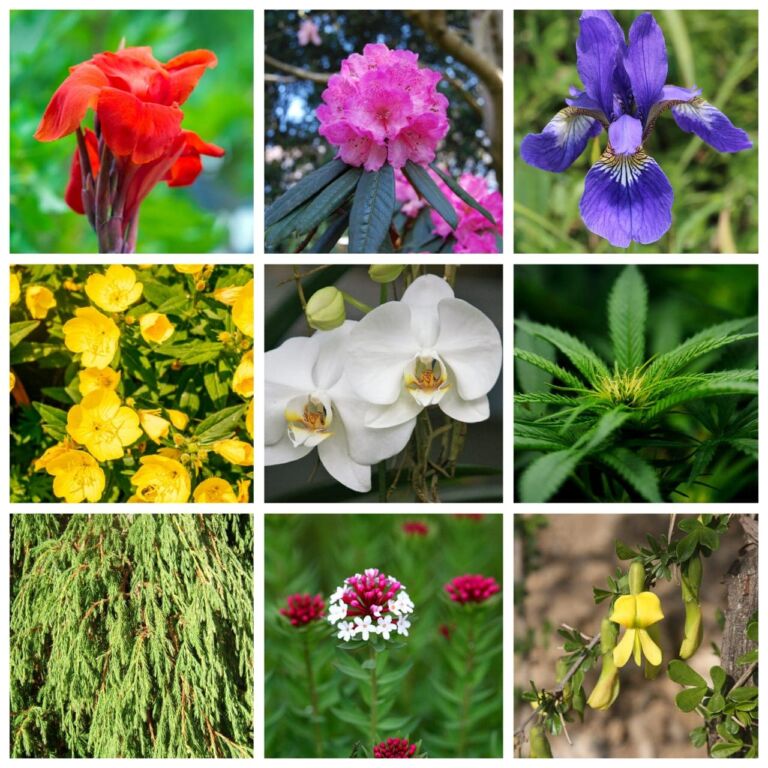
Flora found in the Annapurna region
Row 01: Canna lily, Rhododendron, Iris Row 02: Yellow primrose, White orchid, Marijuana Row 03: Juniper bush, Stellara, Caragana brevispina

Fauna found in the Annapurna region
Row 01: Bharal (Blue sheep), Snow leopard, Himalayan wolf Row 02: Gray langur, Leopard, Jungle cat Row 03: Red fox, Himalayan marmot, Red giant flying squirrel
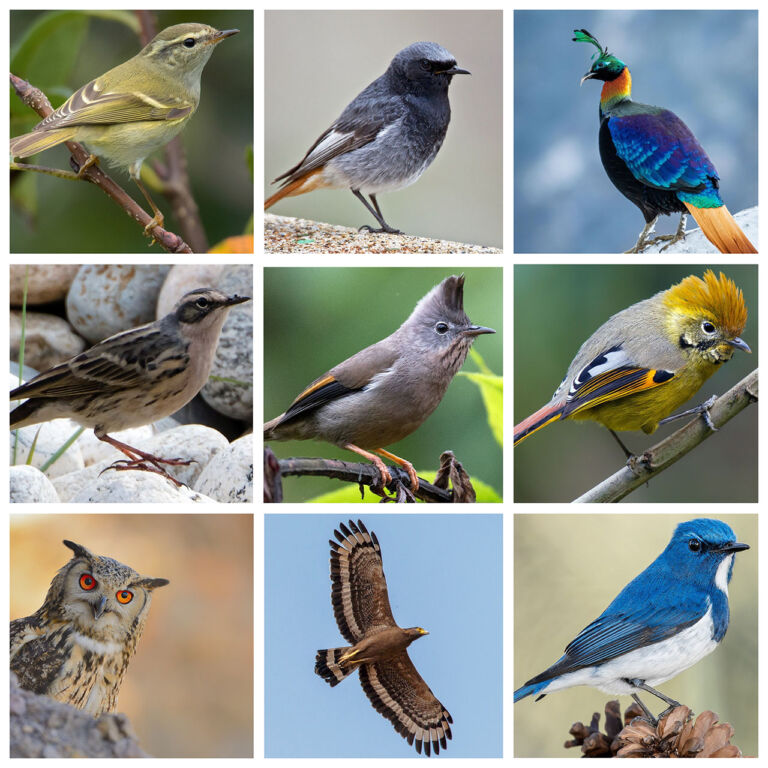
Birds found in the Annapurna region
Row 01: Hume's leaf warbler, Black redstart, Impeyan pheasant Row 02: Rosy pipit, Stripe-throated yuhina, Chestnut-tailed minla Row 03: Rock eagle owl, Crested serpent eagle, Ultramarine flycatcher
Travel Information
All trekkers must provide a copy of their comprehensive travel insurance policy certificate to the Himalayan Odyssey Nepal Trek before starting the trek.
[Note:] The policy must cover medical and emergency repatriation, including helicopter rescue and evacuation expenses at high altitudes.
Trekking permit requirements Two permits are required for the Annapurna Circuit Trek : 1) a TIMS (Trekkers Information Management System) card 2) an entry permit for the Annapurna Conservation Area Project permit
The difficulty of the Annapurna Circuit Trek is challenging (grade IV). While you’ll start the Thorong La Pass Trek at around 1,000 m above sea level, you’ll reach as high as 5,416 m at Thorong La Pass. That’s pretty high. There is a chance of getting altitude sickness.
Safe drinking water is easily available during the trek. You should carry a water bottle so you can refill the water that is available in every lodge. It will be better to bring purifying tablets for safe drinking during the trek.
Coughs and headaches are normal in the mountains. However, if you suffer from a high-syndrome illness, you have to make your way backward. Visit our Altitude Sickness page for more information.
Yes, cellular networks can be found on the trekking trails of the Annapurna Circuit Trek. However, in some places, there might not be reception available.
The standard length of the Annapurna Circuit Trek is about 160–260 kilometers. It could take 10 to 21 days to complete the circuit, but the distance can differ depending on your itinerary or where you start and end the trek.
Ask a question ...
Trekking map of annapurna circuit trek: 12-days itinerary.

Nar Phu Valley Trek
Duration: 9 Days

Tilicho Lake Trek
Duration: 11 Days
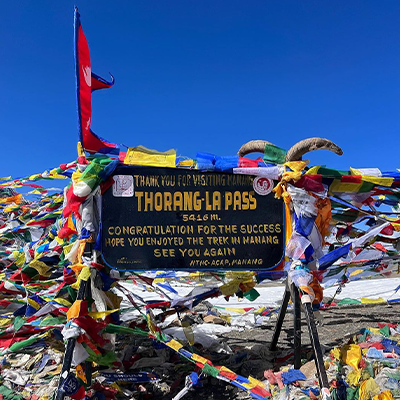
Thorong-La Pass Trek
Duration: 12 Days
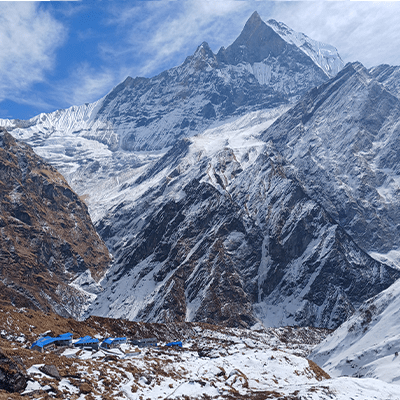
Annapurna Base Camp Trek
Duration: 7 Days
Check Our Risk-Free Booking Policy View Details
No recent searches!
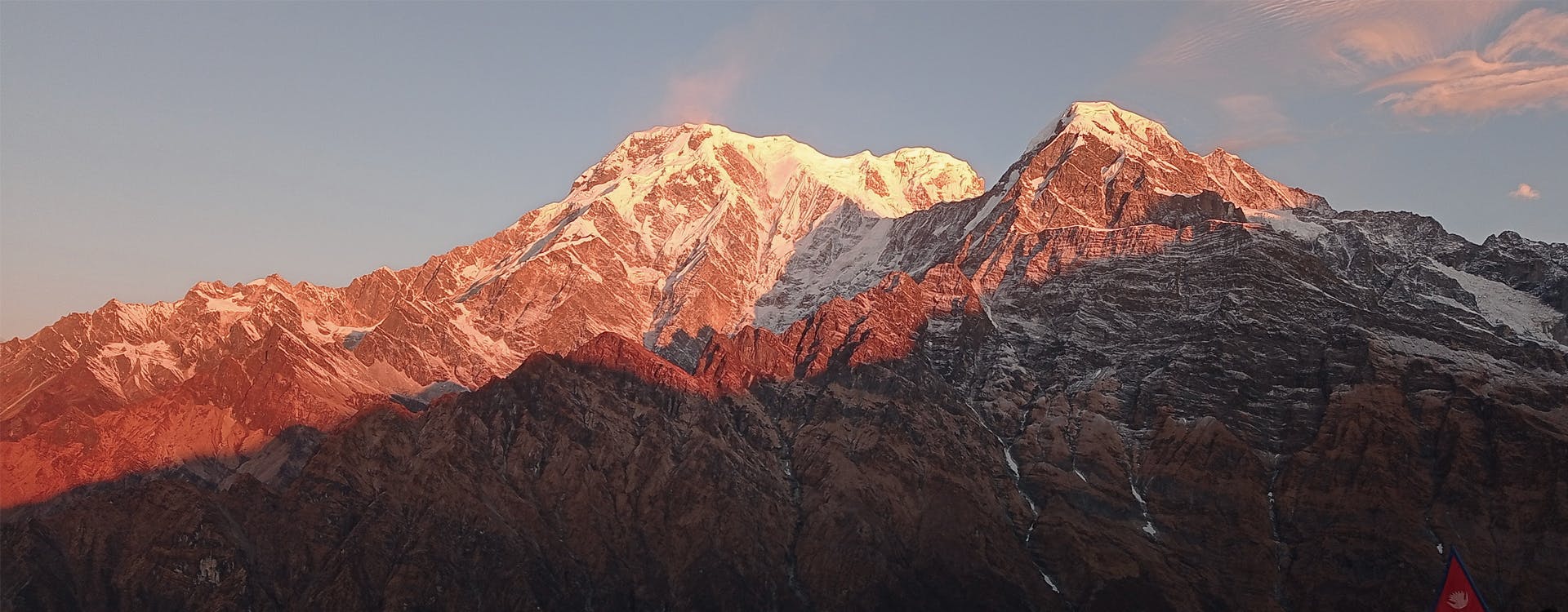
All-Time Best Treks in Annapurna Region
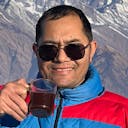
It is no exaggeration to say that trekking is Nepal’s most popular thing, given its cauldron of mountains. Trekking in the Nepal Himalayas is a lifetime experience. Because it accumulates high-rushing adrenaline and gives an opportunity to approach nature’s treasures. Nepal has several heavenly trekking routes and among many - the Annapurna region is one of the best regions to trek.
Annapurna Treks are phenomenal for their wide range of vegetation, cultural experience, religious delights, etc. In addition, the region is blessed with a beautiful environment that keeps on surprising trekkers at every other point.
The diverse landscape of the Annapurna region makes for a perfect trekking experience. It is an extensive range of peaks that has something distinctive and awe-inspiring. Therefore, it is one of the best trekking regions in Nepal, and trekkers globally make sure to do at least one Annapurna trek.
Annapurna region offers varieties of hikes. Be it short and easy treks or long and arduous journeys, all types of outings are available in the Annapurna region. It is a sought-after destination for tourists who flock to the mountains to observe the snowy mountains and rivers flowing down slopes. Similarly, it is also one of the favorite trekking destinations for beginners and expert trekkers.
Trekking in the Annapurna region is a different yet beguiling experience. One must surely do at least once:
This is a compilation of 7 all-time best treks in the Annapurna Region.
Annapurna Base Camp Trek
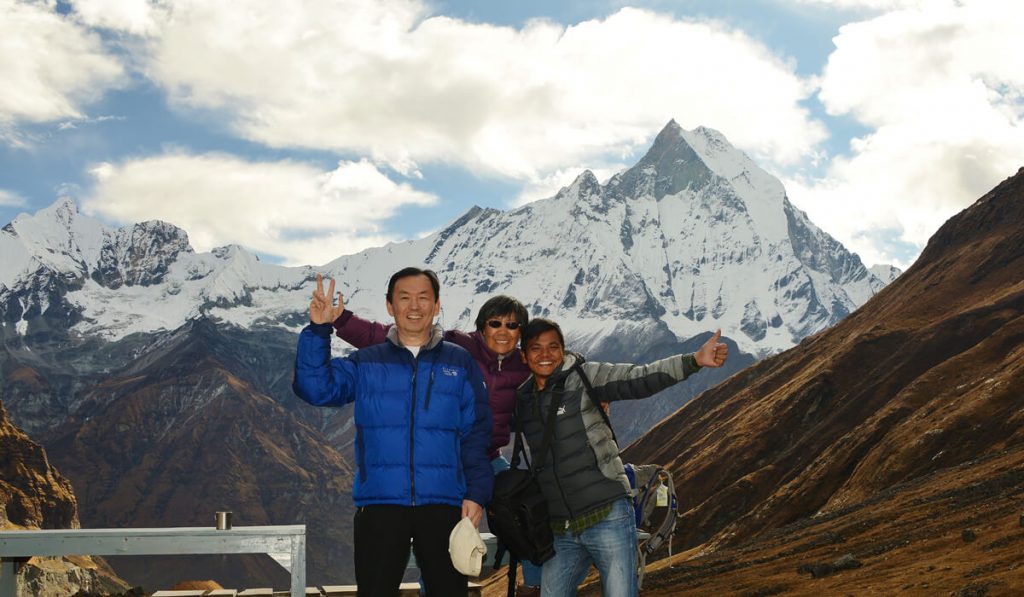
Beginning from the beautiful lakeside city of Pokhara, Annapurna Base Camp is an all-time best trek in the Annapurna region. All the more, it is one journey that everybody probably should trek at least once. On this trail, each terrain and altitude represents an epitome of beauty and serenity. Not only that, but many major ethnic villages such as Ghorepani, Chomrong, Tadapani, Dovan, and many more enhance the beauty of this trekking trail. This is one of the irresistible Annapurna treks.
Additionally, the cultural vibrancy experience in the Annapurna Base Camp trek is extraordinary. Although it is a commercial trekking trail, the village has not lost touch with ancestral culture. Hence, here, trekkers can experience the authentic cultures of Nepal while doing the ABC trek. Likewise, the view of the subtropical forest is entwined with beguiling views of the Annapurna Himalayas. While traversing the ABC trail, trekkers will walk with the following peaks: Dhaulagiri, Machhapuchhre, Himchuli, Annapurna I, II, III, and IV and their surrounding mountains.
Annapurna Base Camp is moderately tiring given its high elevation the place. However, surreal natural interaction and the mountain views throughout the journey will leave you amazed each day.
Mardi Himal Trek
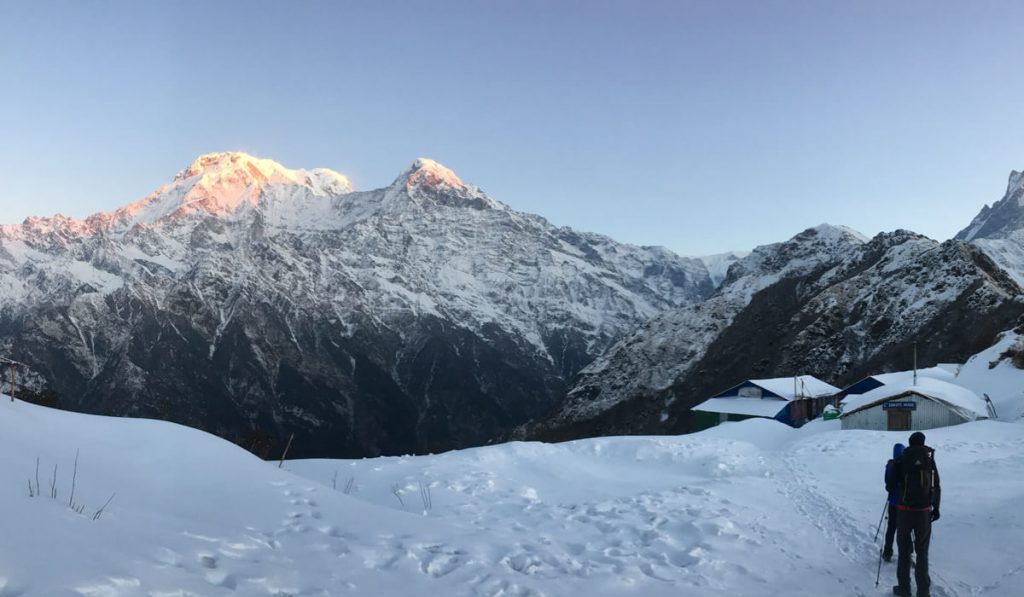
Mardi Himal Trek is another fantastic and all-time best trek of the Annapurna region. It is a small mountain beneath the majestic Machhapuchre peak for those unfamiliar with Mardi Himal. A journey to Mardi Himal promises spectacular scenery of Annapurna massif and a unique hiking experience. On that accord, Mardi Himal Trek is also suitable for trekkers looking for an off-beaten paths trekking experience in Nepal. From the peak of Mardi Himal, up-close view peaks over 8,000m (26,000 ft) are visible to witness with naked eyes. The sheer sensation of being so close to these peaks makes a magnificent journey.
Moreover, Mardi Himal Trek is a tea house trekking journey. It is also a short walk in a peaceful part of the Annapurna region. The trek entails passing through no road area, so entirely you will walk amidst dense jungles. Because of this, on this path, there are fewer hikers. The advantage of this tour is the remarkable scenery. Because the view of the mountains is impressive, we go through villages with terraced farming and woodlands and cross or walk by rivers, enjoying the most spectacular views of the mountains of Annapurna, Machapuchare, Hiunchuli, and Mardi Himal.
Overall, trekking Mardi Himal Trek is not just a stunning location; you will find an extraordinary feeling that shall last forever. Besides, as the journey features the world’s finest mountain views, it simply is a fantastic off-beat Annapurna trek.
Khopra Ridge Trek
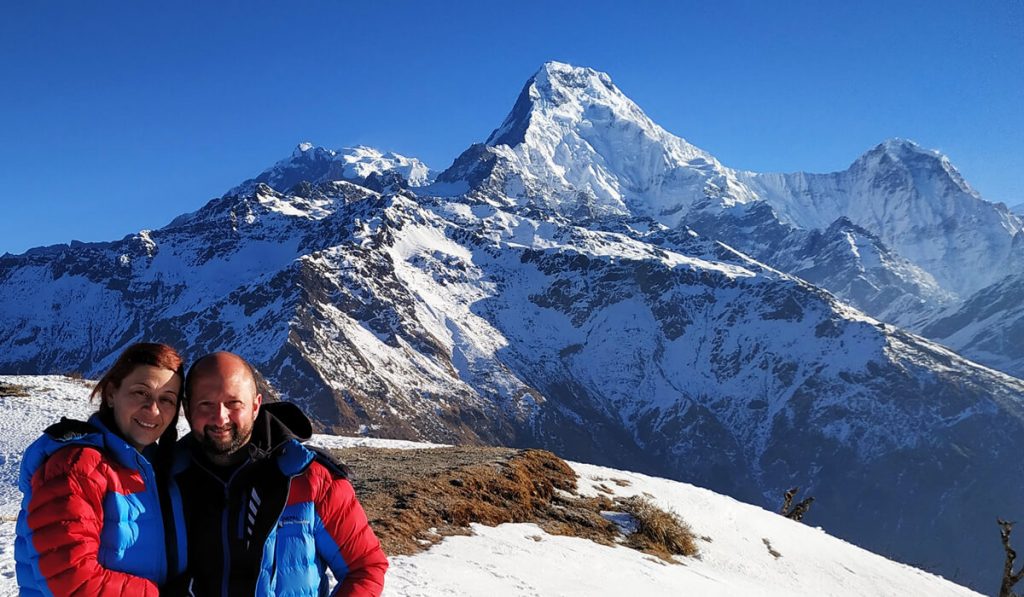
An off-beat and unique trek in the land of the highest mountains in the world is the Khopra Ridge trek. Not many are familiar with this particular trekking trail in the Annapurna region. But that does not mean it is not as beautiful as any other Annapurna trek. This is, in fact, one of the accessible treks, although it is remote and less touristic of the Annapurna region. Additionally, it is different from other treks in many factors. For instance, the trails keep changing scenery, which is not frequent in short trekking journeys. Similarly, the most absorbing aspect of walking on a ridge is the spectacular ‘on top of the world feeling.
Khopra Ridge Trek is, without any doubt, one of the loveliest multi-day walking journeys. The journey consists of walking on a ridge for two whole days hence you will walk with big mountains on either side. The trek leads through lush woods, alpine wildlife, beautiful rhododendron forests, and pristine villages in the Annapurna Mountain range. Unlike the popular and crowd-favorite ABC trek, this trek also presents you with a chance to see Khayar Lake.
Due to the reasonable number of ascents, the Khopra Ridge trek is a moderate-grade trekking journey. For everyone looking for an ideal hiking route in Nepal with spectacular views of mountains and attractive countryside, the Khopra Ridge Trek is perfect.
Ghorepani Poon Hill Trek
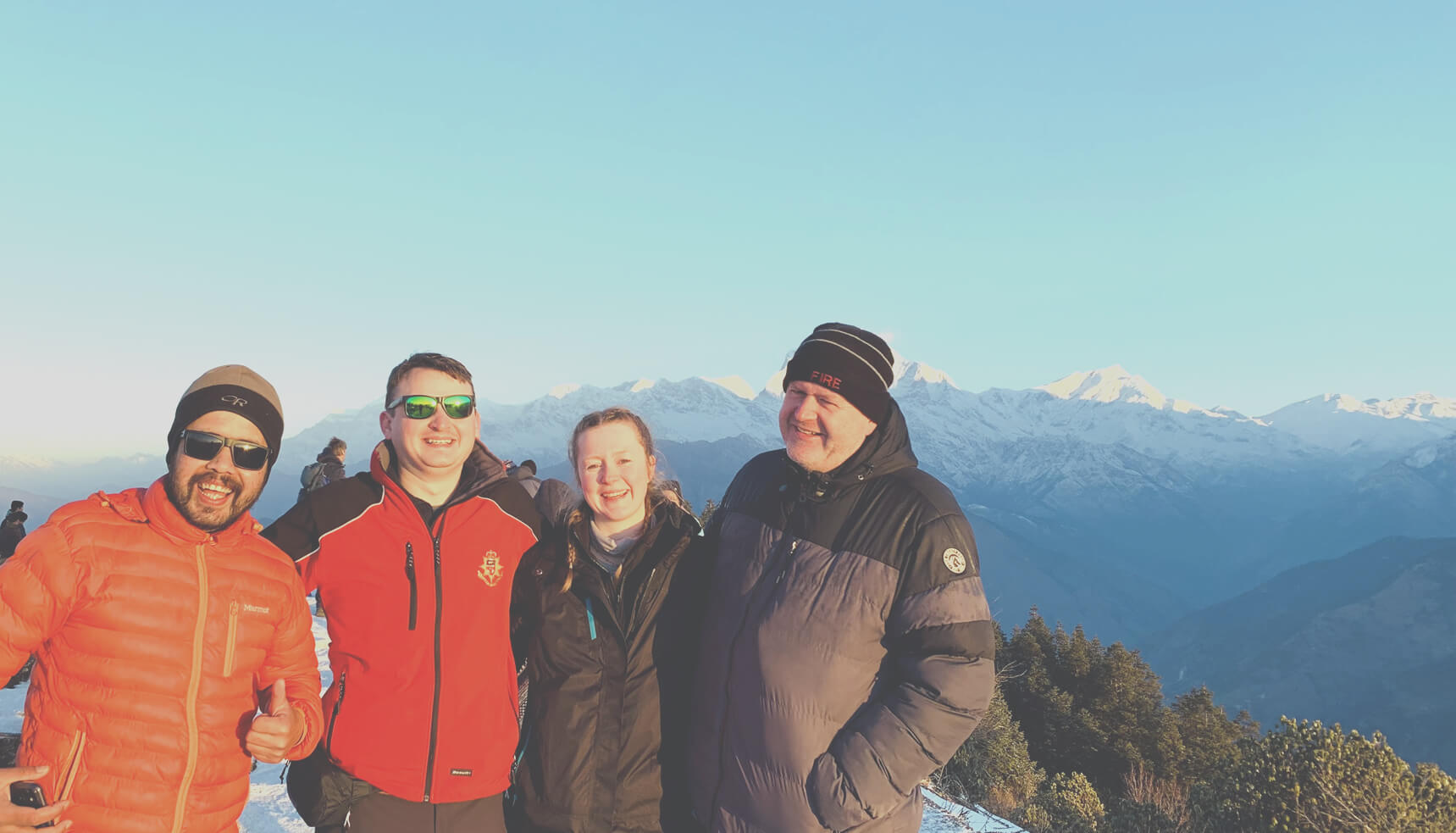
Stunning, short, and rewarding are a few words that describe Ghorepani Poon Hill Trek . It is one of the finest hiking trails in the Annapurna region. This journey takes you to the small colorful village tucked away in the Himalayas of Nepal. It offers picturesque alpine landscapes with big mountains and small villages scattered on its foothills. Ghorepani Poon Hill is a perfect journey for those simply in love with the mountains. And serene nature surrounding them.
It is not an adventurous trek like other Annapurna treks. It does not involve covering great heights or walking rugged hiking trails. However, it is an intriguing hike that passes through numerous ethnic villages. These villages are vibrant, with colorful roofs perfectly syncing with the green and snow-white backdrop. The primary inhabitants of these villages are Gurung, Magar, Chettris, and many more. Therefore, anyone interested in culture will probably have a wonderful time exploring this trail.
Similarly, when talking about Ghorepani and Poon Hill, we cannot speak of sunrise and sunset views. Poon Hill is the best place in Nepal to watch the golden sunrise and sunset. The golden rays falling on the snowy white tops of the Annapurna range are great to watch and capture in camera, heart, and mind. People are deeply fascinated with its charming yet straightforward demeanor. Hence, it is unarguably the all-time best trek in the Annapurna region.
Annapurna Circuit Trek
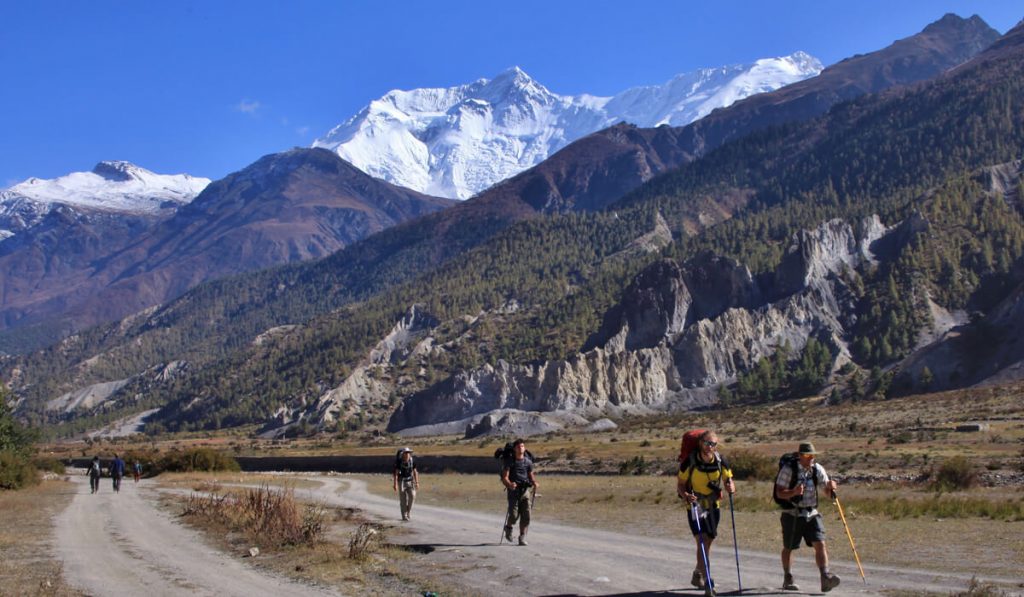
Annapurna Circuit Trek is famous for its beautiful landscape and different terrains that never disappoint. And due to this very reason, it is also the classic trek of Nepal and one of the ideal places for trekking adventures. The trails endow the postcard-type landscape and unique culture quite different from other trekking regions. The thrill of walking on a narrow sloppy path that directly looks down to swiftly flowing rivers is one of the underrated moments of this trek. Thus, it is not an easy hike. Moreover, it entails crossing the dramatic Thorang la pass (5416m), which many have confessed as the most complex part of the trek.
Besides the adventure flair that it promises, it is an equally intriguing trekking journey. Because of the change in terrain exposes cultural variation as well. And this is quite rare to experience in many trekking journeys in Nepal. On this trail, in the lower part, trekkers get to contemplate typical Nepali culture. But as the journey progresses, they come across distinct Tibetan cultural influences. And it is not in many treks that people get to taste such transitions.
The journey rounds the iconic Annapurna massif through the subtropical plains at the foothills of the Himalayas. Then, it continues passing trans-Himalayas, and the dry, barren Mustang shadow. Finally, Thorong La is the maximum altitude trekkers reach before the path continues along the Kali Gandaki River, crossing two gigantic summits via the largest valley on Earth. It is undoubtedly one of the iconic Annapurna treks and an all-time best trek in the Annapurna region.
Tilicho Lake Trek
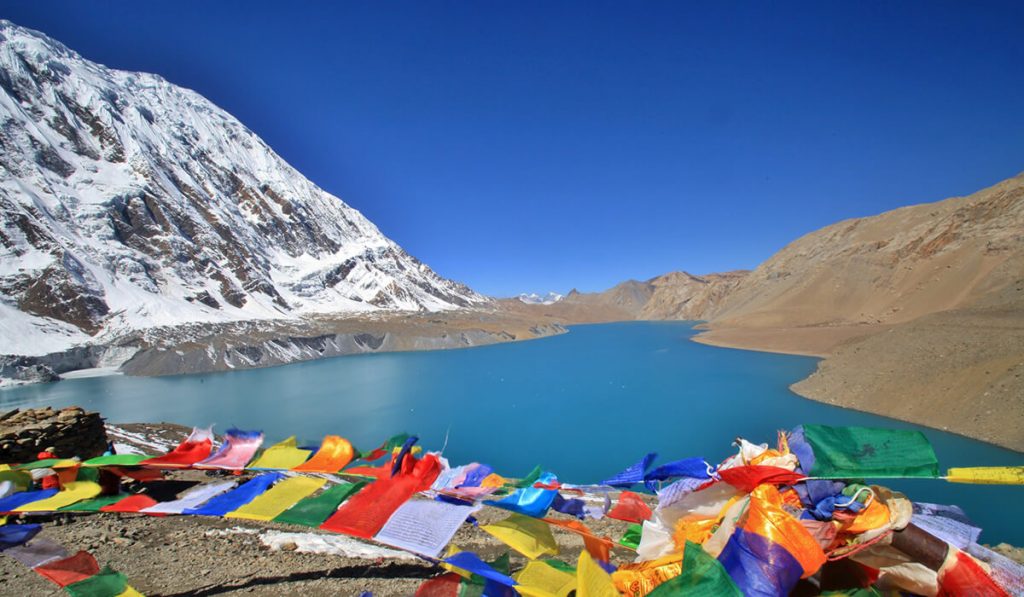
Unveil the beauty of the Annapurna range with the elegant Tilicho Lake Trek . It is a pleasant journey that endows the trekkers with stunning views of the Annapurna peaks and Nilgiri, Tilicho, etc. The Lake alone steals the heart of travelers because of its quaint setting. Tilicho Lake Trek has become a famous destination for nature enthusiasts among the hiking trails in the vicinity of Annapurna. Tilicho Lake Trek offers spectacular and exciting views of the globe, the enormous range of culture and diversity, the most beautiful depth of the gorge, and high peaks adjacent to the Annapurna Himal.
Furthermore, Tilicho Lake Trek is not only about the turquoise and tranquil Lake. As the Lake sits in the middle of a giant cauldron, trekkers enjoy the gorgeous up-close mountain scenery. Overall, it is also a modest hike, with a wonderfully spectacular experience, in exchange for all your efforts. Around the turn, you’ll be viscerally impressed by the green emerald sea and the rough rocks and glaciers. You have never seen such a spectacularly lovely item. Late in the day, behind Mount Victoria, the golden sun falls, serene and silent. As you go along the route beside the Lake, it looks like you have to absorb the complete view. You will never forget this feeling.
Nar Phu Valley Trek
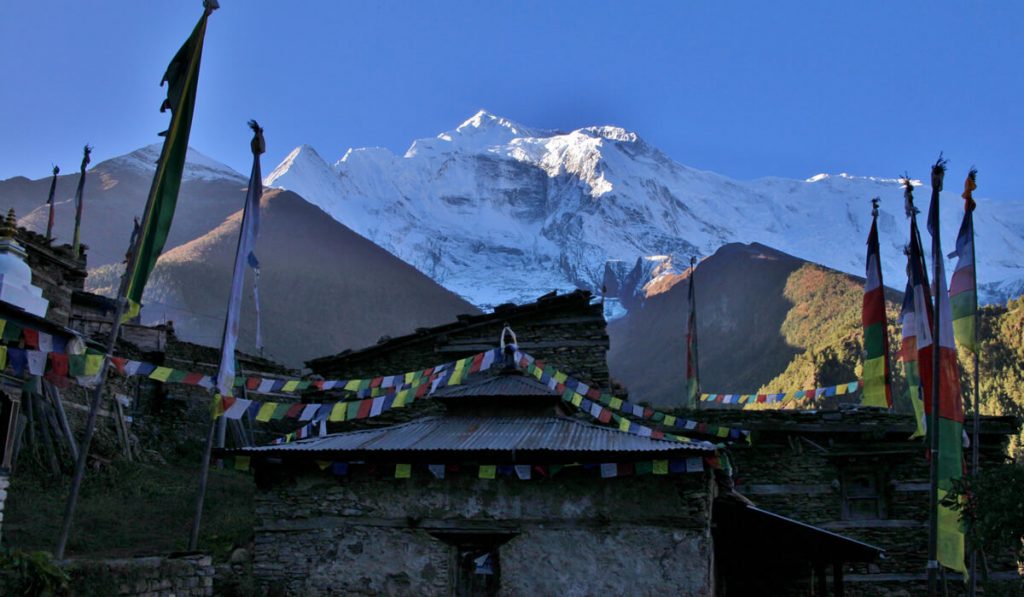
Lesser known and least traveled in the Annapurna region is Nar Phu valley. The valley lies within the folds of the Annapurna mountains. Thus, it is a secretly hidden and painstakingly beautiful trekking region. Nar Phu valley trek features a dry and barren landscape than typical green forests. Therefore, with the rugged terrain, the region’s cultural benevolence is quite different. Categorized as challenging, the Nar Phu Valley trail is exciting and holds surprises up its sleeves on nearly every turn you take.
Witness the tree line disappearing into a grassland of wildflowers and disheveled shrubs. The uncanny Nar Phu valley chisels its curvy path and the equally contrasting deserted mountains. Nar Phu Valley Trek is a picture-perfect trek that is a must-do trek in the Annapurna region. With endless adventures in every direction, Nar Phu valley is a great way to explore remote towns hidden in the Tans Himalayas of Nepal. Those looking to wake up with a breathtaking view will love the sheer remoteness of Nar Phu Valley.
Given that, these are some of the best treks in the Annapurna region. Of course, one must be intrigued when the best time for the Annapurna trek shall be. But don’t worry! Below here, you can read about the best season to hike in the Annapurna region. Or what particular time appeals most to you.
Summer/ Monsoon Season
Summers kick in around June and last till August. It is also monsoon season, so expect to get hot and wet in a small fraction of time. Annapurna region experiences warm weather and rain in some places. Despite that, most treks mentioned above are attainable. Especially Annapurna Circuit Trek and Nar Phu valley trek. These two trekking routes lie in the leeward part. Thus, it does not experience monsoon showers making it one of the ideal times for trekking. Besides the complication of monsoon rain and muddy trails, the mountain views, once the clouds are cleared up, are phenomenal experiences. However, if rain and leeches bother you, consider trekking during dry seasons.
Autumn Season
September to November, which is autumn, is one of the best times for the Annapurna treks. It is a dry season in Nepal after the monsoon season. However, the skies remain clear, offering epic mountain scenes. And to talk about the weather, it is simply the most favorable time for trekking. It is mildly warm during the day and slightly cold at night. It is the perfect season for trekking in the Annapurna Himalayas. Since it is the peak season, the trail would be crowded. Nevertheless, meeting adventure souls makes it even more enjoyable. This season is ideal for any treks on the list.
Winter Season
Next, the winter season is from December to February. This is the time to travel for snow! Extremely chill weather conditions make trekking quite challenging. However, it is one of the best times to capture glistening crystal mountain views under the clear blue skies if you bypass that factor. Similarly, if you ever visit the Annapurna region during winter, ensure you have the appropriate gear. This season is suitable for all treks on the list. However, special attention is needed for ABC Trek, ACT Trek, and Nar Phu Valley Trek.
Spring Season
Lastly, the spring season is from March to May. Temperatures will rise a little, and the weather will be pleasant for trekking. This is why it is the second-best season for Annapurna treks. With excellent weather, it is also time for flowering. The trails turn into different shades of pink and red because of the rhododendron flowers. Spring is, without any doubt, a stunning time for a good trekking experience, lovely mountain views, and colorful natural splendor.
Overall, the best time differs from person to person. While one might find a relaxing and beautiful time, others may not think the same. Hence, whichever weather appeals most to you, trek in that season and make the best memories. All treks are attainable during all seasons. Yet, some may need specific attention during certain seasons. Hence, make sure you are prepared well and are ready to make the best memories.
Have you trekked in the Annapurna Region already? or are you Planning? Comment below.
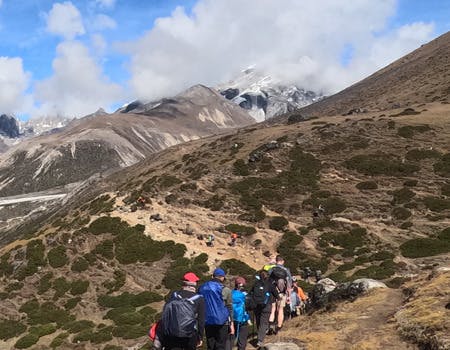
Post a Comment
Subscribe our e-newsletter.
Sign up for Deals and Discount. Get News, Notifications and Updates about the recent Events and Offers.
- Travel Guides Plan your adventure
- Destinations Our favourite places
- Tours Book a trip
- Travel Companies Independent specialists
- Travel Guides
- Destinations
- Travel Companies
The best Annapurna treks
An expert guide to trekking the annapurna region.
Stuart Butler
Bradley Mayhew
- In this guide
- Remote treks
- Challenging treks
- Everest treks
- Annapurna treks
Upper Mustang treks
- Langtang Valley treks
- Manaslu treks
- Dolpo treks
- Far Western Nepal treks
- Makalu treks
- Kanchenjunga treks
- What to eat in Nepal
- Best Annapurna treks
- Need to know
Annapurna trekking: overrated routes & hidden gems
For lots of visitors, trekking in Nepal = trekking in Annapurna, in particular either the Annapurna Sanctuary or the Annapurna Circuit trek. They’re both spectacular and more than deserve their hype but, in my opinion, they’ve been let down by the tourism industry’s tendency to over-market the already popular highlights at the expense of any hidden gems.
What's more, the Annapurna Circuit trek – for many years described as the single best trek on earth – has suffered so much encroachment from road construction that I’m not sure I could even recommend doing the original route (the new alternative route is excellent however.)
Fortunately there is much more to trekking in Annapurna than these two blockbuster routes. From simple walks in the flowery foothills, to hidden valleys that feel like Tibet and require special permits to visit, there's a huge variety of Annapurna treks that don't make it into the mainstream tourism marketing.
But whatever trek you choose, one thing is for sure: the mountain scenery will blow you away. Standing in the heart of the cirque at the end of the Annapurna Sanctuary trek could move you to tears, and the wilderness around Tilicho Lake will probably be the best mountain scenery you’ll ever lay eyes on
There’s the added advantage that most treks are simple to organise, trailheads easy to reach on public transport, and accommodation and facilities abundant and of a very high quality. So forget the glory of Everest , Annapurna is where it’s at!
Ready to go? Here's my expert guide to the best Annapurna treks.
Get the digested read
Where to begin? When to go? How to plan? So many questions, so little time. That's why we've asked leading Nepal trekking expert Stuart Butler to answer your most frequently asked questions in this handy four-part email series.
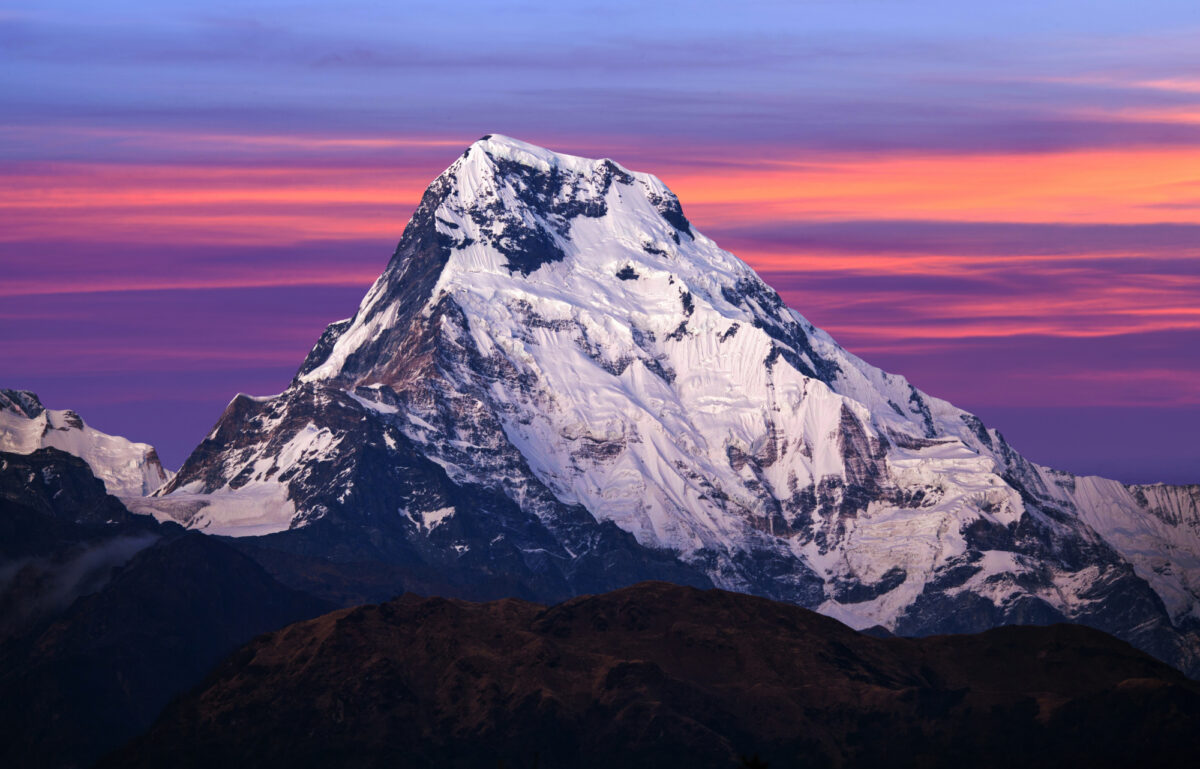
The classic view of Annapurna I
The most famous routes and some hidden gems
Annapurna region.
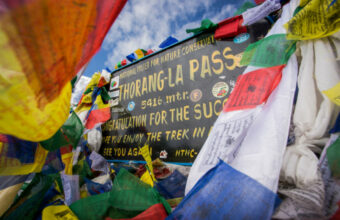
Road-free Annapurna Circuit
- Best trek for: Classic scenery, good facilities
- Difficulty: Moderate to hard
- Trek duration: Nine to 18 days
- Max. elevation: 5,416m
- Accommodation: Trekking lodges
- Start/end point: Dharapani/Jomsom or Naya Pul
This, one of the world’s classic treks, takes you through virtually the whole range of Nepalese landscapes: From sub-tropical valleys where banana plants and gushing, murky jungle rivers are the defining features, through gorgeous woodlands, and across Alpine meadows and conifer forests, to the rock and ice wastes higher up.
Sadly, in the past few years road construction has affected up to 75% of the original Annapurna Circuit route. Life’s too short to trek on roads, so my advice is to avoid the original route and follow the new road-free route instead . If you’re set on walking the Annapurna Circuit, be sure to follow the New Annapurna Trekking Trails (NATT) route that take you away from the road traffic and onto quieter and more scenic side trails – in many cases these new trails offer even more impressive scenery than the original routes. NATT routes are waymarked with signs painted in blue and white, instead of the red and white of the main Annapurna Circuit route.
The high point is the often snow-covered Thorung La Pass (5,416m) with its utterly sensational mountain views. From here you drop rapidly down towards the fascinating Hindu and Buddhist pilgrimage site of Muktinath and then into a drier, region of eroded river gorges, lush oases and castle-like monasteries around Kagbeni and Jomsom (look out for ammonite fossils in the Kali Gandaki river bed — evidence that the top of the world was once at the bottom of a prehistoric ocean).
Many people finish the trek at Jomsom (there are jeeps and buses to Pokhara or scheduled daily flights), but for the devoted, the new alternative trail winds slowly downhill through the dramatic Kali Gandaki valley into warmer, greener and lusher countryside. The sense of satisfaction of walking the entire circuit is second to none.
Facilities along the Annapurna Circuit are excellent with comfortable trekking lodges and good, varied food. Many lodges have hot showers and wi-fi. It’s busy during high season and the demand for beds can exceed supply. You can avoid the problem by joining an organised trip, and miss the crowds by overnighting at midway points between the major stops. See here for our recommended itinerary.
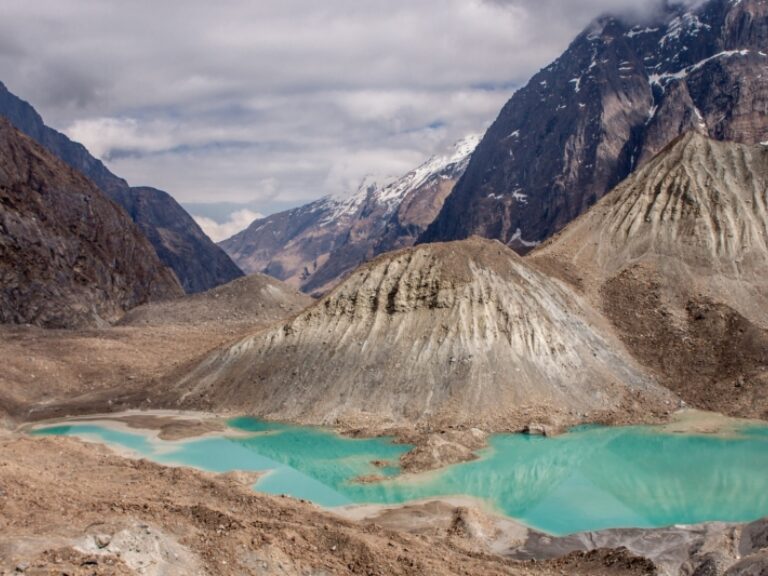
Annapurna North Base Camp
Best trek for: Expedition style camping
- Difficulty: Moderate
- Duration: Five to six days
Max elevation: 4,050m
Accommodation: camping
Start/end point: Tatopani/Sandhi Kharka
New trek routes always get my pulse racing, especially when they follow in the footsteps of a famous old expedition route. This particular trek follows the expedition route of Maurice Herzog’s epic 1950 ascent of Annapurna I (8,091m), the first ever ascent of an 8,000m peak, and it takes you up to an amazing mountain amphitheatre ringed with 7,000m peaks.
Unlike the busy base camps of the popular Annapurna Sanctuary trek, this ‘alternative’ Annapurna Base Camp trek is a true hidden gem that sees only a trickle of well-informed trekkers, largely because you need to camp and be self-sufficient. There are no lodges here and definitely no apple pie.
The trek starts at Tatopani, veering off the Annapurna Circuit to make a dramatic, sphincter-tightening jeep ride up the wild, sheer-sided gorge of the Mristi Khola. The walking starts at the hydroelectric plant at Hum Khola Dovan (2,880m), with overnights at Sandhi Kharka and Bhusket Mela (3,550m), until you finally set up camp in the astounding glacial basin of Narchang Lake (4,050m). This secret spot, surrounded by Annapurna I, Fang, Tilicho and Nilgiri peaks and walled off by the Great Barrier of the Annapurnas, is a classic mountain cul-de-sac, surrounded by glaciers, waterfalls and vertical rock walls.
The opportunities for day hikes here are fabulous, with faint trails leading to Annapurna North Base Camp, Advanced Base Camp and Nilgiri Base Camp via some epic glacier viewpoints. Bring a copy of Maurice Herzog’s classic 1951 Annapurna, and spend the evenings reading his account of the groundbreaking ascent and even more harrowing descent. It’s a day’s walk back to Sandhi Kharka and then half a day to meet your jeep and make the wild ride back.
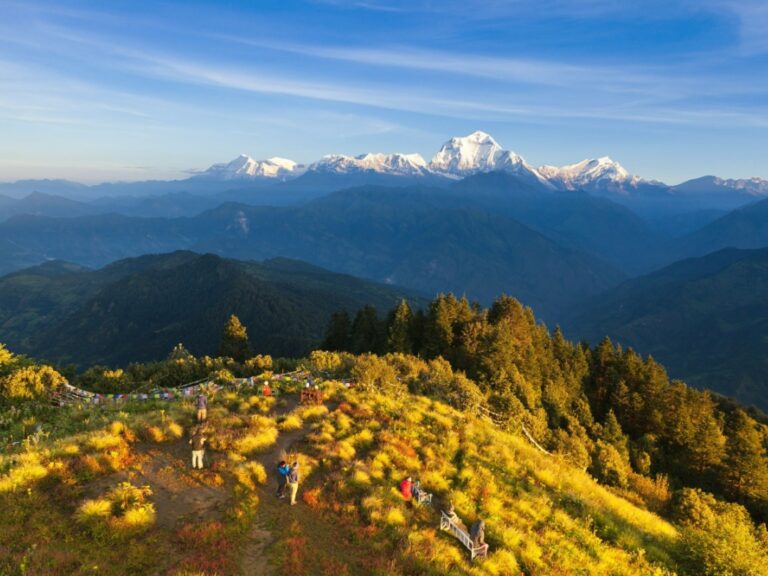
Annapurna Sanctuary trek
- Best trek for: The most popular Annapurna trek
- Difficulty: Easy to moderate
- Trek duration: 10 days
- Max. elevation: 4,130m
- Start/end point: Naya Pul or Dhampus
Rivalling Everest Base Camp for the title of most popular trek in Nepal, the Annapurna Sanctuary Trek is a 10-day extravaganza of non-stop mountain vistas culminating in a great cirque of massive mountain peaks seven to eight kilometres high.
If you’re looking for a short, relatively easy and simple-to-organise trek that doesn’t venture too high (max elevation is 4,130m), and with unusually comfortable accommodation, then the Annapurna Sanctuary ticks all the boxes.
The straight there and back route starts in the lush subtropical hills to the north of Pokhara, taking you through oak, birch, rhododendron and bamboo forests before hitting the Alpine zone on day five around Machapuchare base camp (which is actually a collection of trekking lodges — for religious reasons it’s forbidden to climb Machapuchare).
From here to the Annapurna Sanctuary the views get more stupendous with every corner passed. Once you reach the Annapurna Sanctuary there are a few viewpoints above the lodges which reward with views over glaciers, moraine fields and an amphitheatre of peaks including Machapuchare (6,993m), Annapurna South (7,219m), Annapurna III (7,555m), Gangapurna (7,454m) and, just poking up behind the others, Annapurna I (8,091m), the first 8,000m mountain ever climbed (in 1950 by legendary French climbers Maurice Herzog and Louis Lachenal).
The facilities for trekkers are as good as anywhere in the Nepalese mountains. Most lodges have varied menus, some form of heating, separate rooms, electricity, hot showers and even wi-fi. However, this combination of unsurpassed mountain scenery, great facilities and easy access means that tens of thousands of trekkers can walk this trail each year, causing local culture to be overwhelmed by international trekking culture. Lodges can be booked out in the high season. Try to get to the night stop early, or join an organised trekking tour and avoid the worry of finding a bed. If you’re looking for something quieter, the new Annapurna North Base Camp trek might be for you.
To avoid this being a straight there and back trek, do the Poon Hill trek first and then on day four link on to this walk. That would give a total of about 12 comfortable days of walking. Or alternatively add on the Mardi Himal trek for a similar duration.
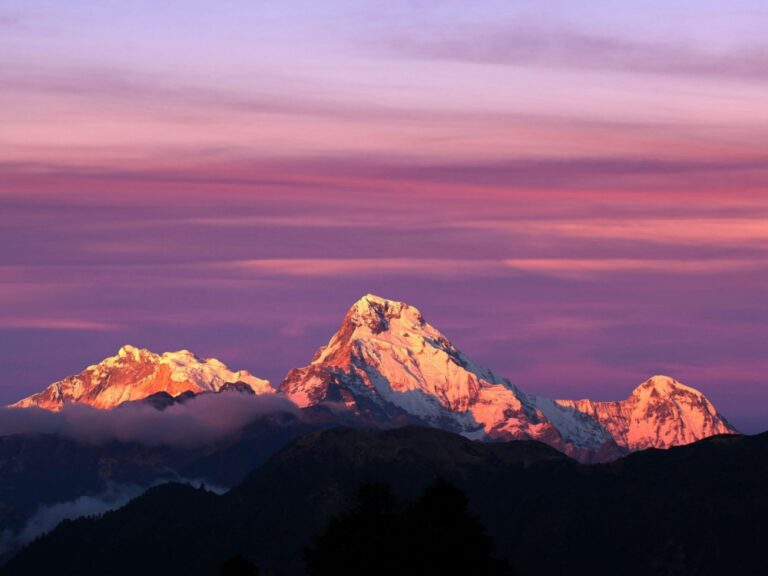
Poon Hill trek
- Best trek for: Easier-going route with classic sunrise views
- Trek duration: Five to six days
- Max. elevation: 3,210m
- Start/end point: Naya Puk/Phedi
Mixing heart-stirring mountain views with enchanting villages and beautiful forests with a thousand blooming rhododendrons, this is a good introduction to trekking in Nepal.
The highlight is Poon Hill itself, an hour’s walk above the village of Ghorepani. Watching the sunrise from here is an almost obligatory Nepalese experience. As the first beams of light shine across a panorama that includes Dhaulagiri I (8,167m), South Annapurna (8,091m) and Nilgri (6,940m), it’s hard not to be moved, despite the often noisy crowds
The trailheads are only about an hour’s drive out of Pokhara and there are excellent trekking lodges along the route plus some luxury hotels. The trek can be done clockwise or anti-clockwise and it makes a good add-on to the more challenging Annapurna Sanctuary trek. It’s also an ideal first time trek for families and those who don’t want to go too high. But do keep in mind that there’s a lot of steep up and downs.
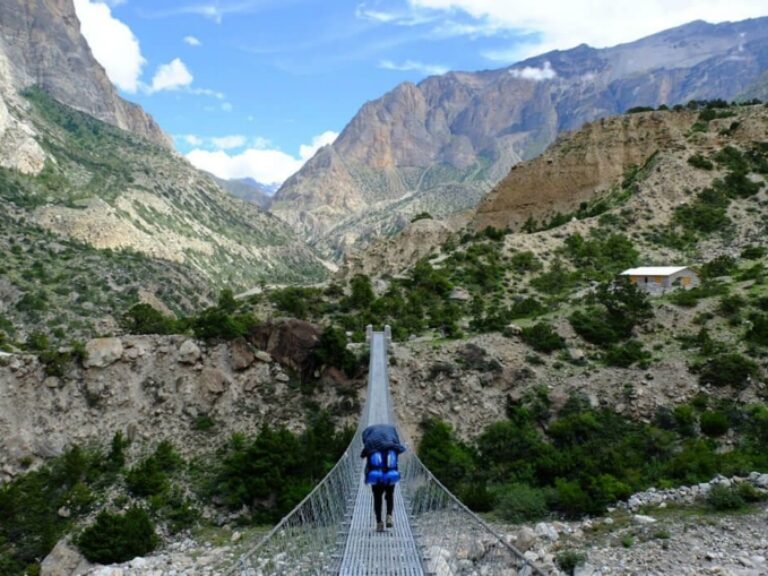
Nar-Phu trek
- Best trek for: Getting well off the beaten path
- Difficulty: Moderate to difficult
- Trek duration: Seven to nine days
- Max. elevation: 5,320m
- Accommodation: Camping and basic trekking lodges
- Start/end point: Koto/Ngawal
Most Annapurna Circuit trekkers heading through the village of Koto won’t know that a trail off to the east leads to a magical, hidden world. The Nar and Phu valleys were closed to tourism until 2002 and when they finally opened up the first trekkers discovered a landscape of narrow gorges, 7km high mountains, timeless stone villages festooned with prayer flags, and a distinct local culture based on yak herding and trade with neighbouring Tibet.
Still rarely trekked (a restricted area permit and camping gear is required), the route follows a dark, deep and shady gorge up to the mediaeval village of Phu, which consists of around 40 or 50 mud and stone houses and red painted monasteries huddled together on the top of a hill. Entry to the village is via a spectacular old gateway.
It’s worth allowing a couple of nights in Phu to explore the upper valley. To leave, you have to retrace your steps halfway back down the valley before veering west up the Nar valley, over yak pastures to the large traditional village of Nar where there are four gompas (Buddhist monasteries) worth visiting. Independent trekkers relying on lodges will probably have to turn back here and retrace their steps to Koto, but camping groups and acclimatised trekkers can make the exciting crossing of the Kang La (5,320m) down to Ngawal back on the Annapurna Circuit.
This trek works well either as an add-on to the Annapurna Circuit or as a short, stand-alone trek in its own right. For adventurous trekkers with all the correct permits on fully-organised camping treks, it’s possible to take a wild, difficult and very rarely walked route from the village of Nar into Upper Mustang via the taxing Teri La Pass (5,595m).
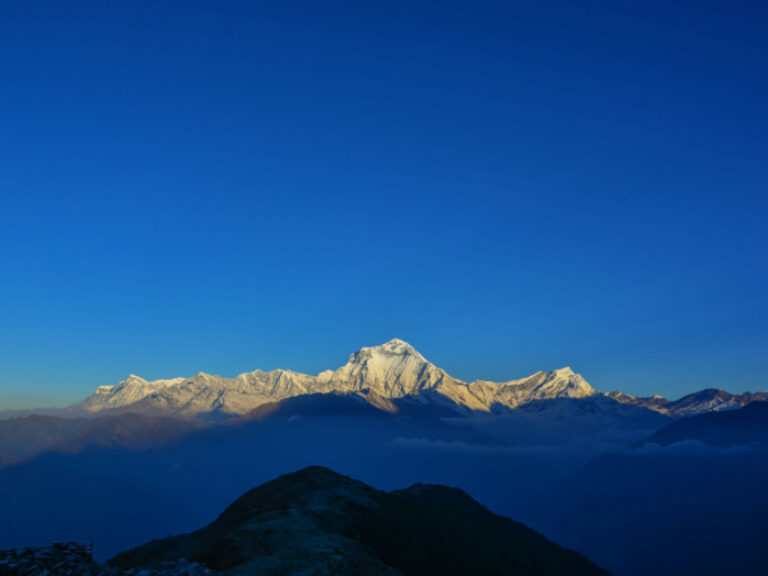
Khopra Ridge trek
- Best trek for: Quieter, less-crowded route
- Max. elevation: 3,660m
- Accommodation: Camping and limited trekking lodges
- Start/end point: Ghorepani/Tadapani
Also known as the Khopra Danda trek, this is well off the standard Annapurna trekking routes and offers a low-key, peaceful trek to lofty viewpoints on the flanks of Annapurna South. There are a number of different route variations but my favourite branches off the Poon Hill trek at Tadopani and climbs to lodges at Bayeli (with its amazing Mulde viewpoint), Chistibang and then Khopra Danda, before descending to Swanta and Ghorepani
The trails pass through charming villages with simple private and community lodges and lots of pretty forests. Khopra Ridge itself is an impressive dome with an exposed trail running along it that feels much higher than it really is (especially when covered in snow). The views across to Dhaulagiri I (8,167m) are unforgettable. From the ridge it’s possible to make a very long and challenging 10-hour day trip to the high altitude Khayer Lake (4,600m). Given the 1,000-metre height gain in a day, plus the beauty of the lake, it’s much more advisable to go on an organised camping trek and sleep on the lake shore.
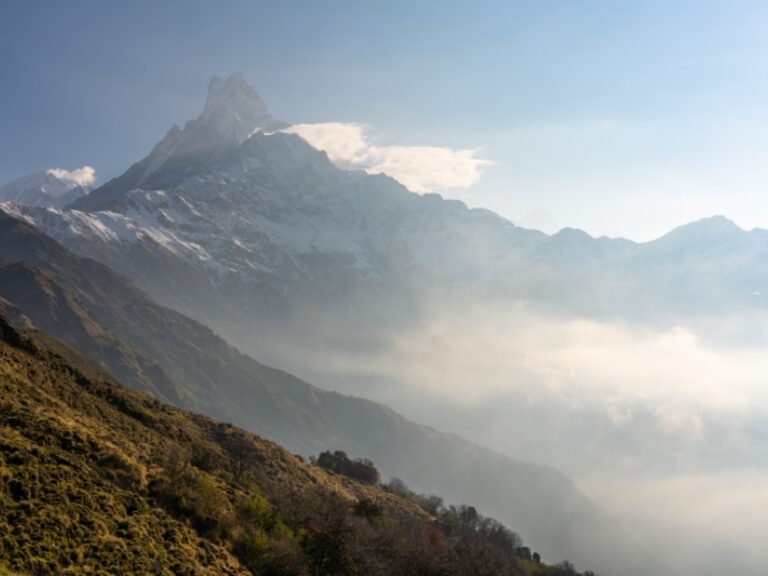
Mardi Himal trek
- Best Trek For: Short trek with great views
- Max elevation: 4,250m-4,500m
- Accommodation: simple lodges
- Start/end point: Khare (Kande)/Sidhing or Landruk
Do you want a taste of the Annapurna region – forests, hillsides of rhododendrons, airy ridge walks and close-up views of big peaks – but can’t afford more than a week? If yes, then I think the Mardi Himal trek might just be for you.
It’s very accessible (less than an hour by bus or taxi from Pokhara), well signed, and the trail will take you past everything from Gurung villages to high Alpine ridges. Not so many foreign trekkers make it here but the lodges are decent (though not as comfortable as other parts of the region). It’s popular with Nepali trekkers, though, so avoid weekends if you can.
The first day or two take you past Australia Camp and the village of Pothana up through the forests of Pitam Deorali to teahouses at Forest Camp, but before long you’ll find yourself above the treeline at Low Camp (2,985m) and then High Camp (3,550m), where the views of fish-tailed Machapuchare, Himchuli and the Annapurnas really open up. Pray for good weather for the amazing final hike from High Camp up to Mardi Himal ‘Base Camp’ West for views of peaks that seem within reach, before returning to Low Camp. From here return to jeep access roads at Sidhing, Galel or Lwang, or hike from Forest Camp to the road at Landruk.
If you are fit (and, crucially, acclimatised) the trek can be done in four days, though five to six is more likely. For an excellent 10-11 day trek link Mardi Himal with the Annapurna Sanctuary route via Landruk.
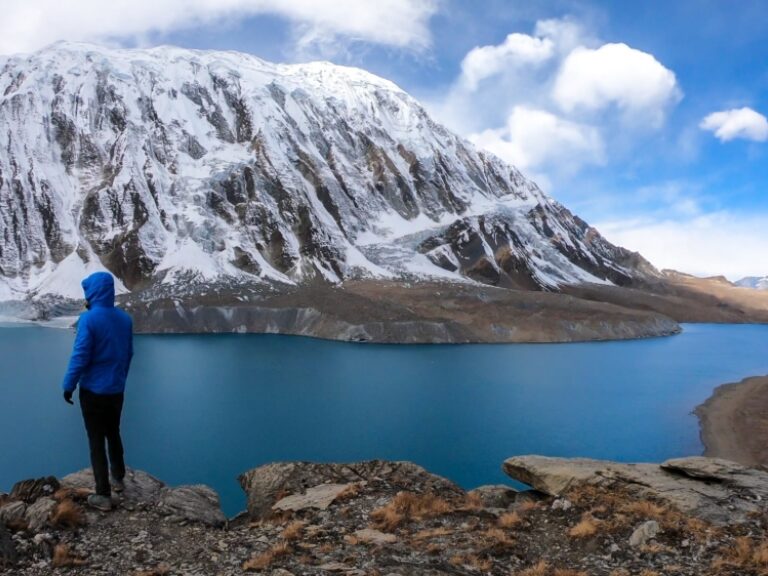
Tilicho Lake trek
- Best trek for: Short but challenging route
- Trek duration: Four to five days
- Max. elevation: 5,005m
- Start/end point: Manang/Manang or Yak Kharka
The short, but challenging hike to Tilicho Lake, one of the highest large lakes in the world, is one of the most impressive Annapurna treks.
It’s a four or five-day round trip detour off the main Annapurna Circuit trail starting from Manang and heading rapidly upwards, firstly through pine forest and then across scree slopes before a final climb to a pass (5,005m) overlooking the lake. Pushed right up against the great wall of the Annapurna range, and with glaciers crashing down into it, the lake is frozen over for months on end and can be a bleak and scary place.
When it is ice-free (normally June to early November), the astonishing turquoise colours of the water clash with the dark rock and white glaciers behind it. For sheer high mountain drama, I find it hard to beat. However, the route up to the lake is not for the faint-hearted.
The path rises very steeply from Manang and altitude-related problems are very common. Also, a large part of the trail is high up on an almost sheer shale slope where rock falls and avalanches are almost daily occurrences. Needless to say it can be very dangerous, especially after rain. People suffering from vertigo will probably not enjoy this trek. Although there are a number of decent trekking lodges along the trail to the lake there’s nowhere reliable to stay on the lake shore. By coming on an organised camping trek you can spend a magical night camping along the lake’s northern edge with only snow leopards for company.
After reaching the lake it’s best to turn back the way you came rather than going all the way back to Manang though you can take a small shortcut that will get you directly to the lodges at Yak Kharka.
Note that many maps and some trekking agencies talk about a route directly from Tilicho Lake to Jomsom via the Mesokanto pass. No matter what any map, sign or trekking agency tells you, this is not a route to be taken lightly. It involves ice-climbing down two huge, vertical glacier walls followed by a hair-raising and utterly exhausting climb up a loose scree slope which makes those you crossed on the way up to Tilicho seem like child’s play. Do not attempt this route without mountaineering experience, ropes, ice-axes and crampons as well as a guide who knows the route — very few do.
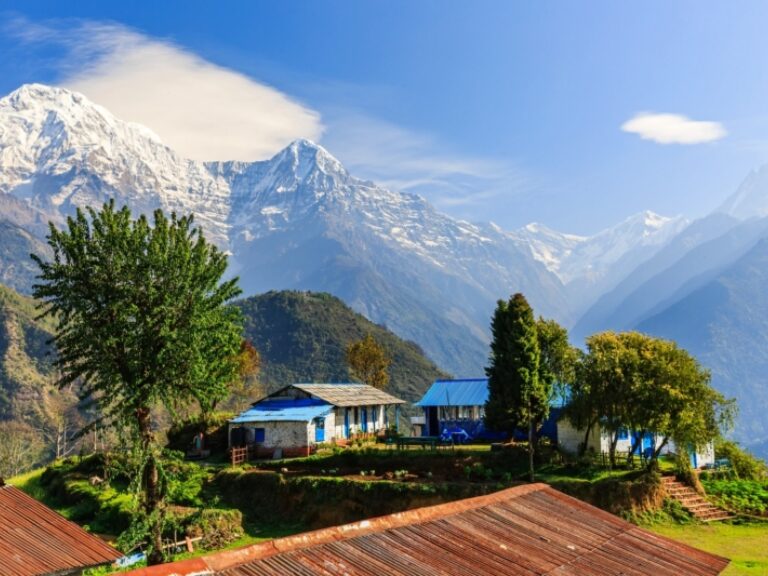
Annapurna luxury lodge trek
- Best trek for: Soft trekking in style
- Difficulty: Easy
- Duration: Six days
- Max elevation: 2,015m
- Accommodation: luxury lodges
- Start/end point: Lumle/Phedi
If you shudder at the idea of overnighting in a wooden room no larger than a prison cell, with the single shared toilet located down a hallway echoing with the thunderous snores of a two-dozen unwashed trekkers (or even worse; a tent!), then you might want to consider a luxury trekking itinerary in the Annapurna foothills. You’ll avoid the discomfort of high altitude and can focus on lovely days spent wandering village trails, safe in the knowledge that a hot shower and happy hour awaits you at the end of the day.
Ker & Downey operates a string of lodges in the foothills north of Pokhara, allowing you to link the Gurung villages of Dhampus, Ghandruk, Majgaun, Landruk and Birethanti in a five or six day loop, with fine views of iconic fish-tailed Machapuchare never far away. This is trekking in style.
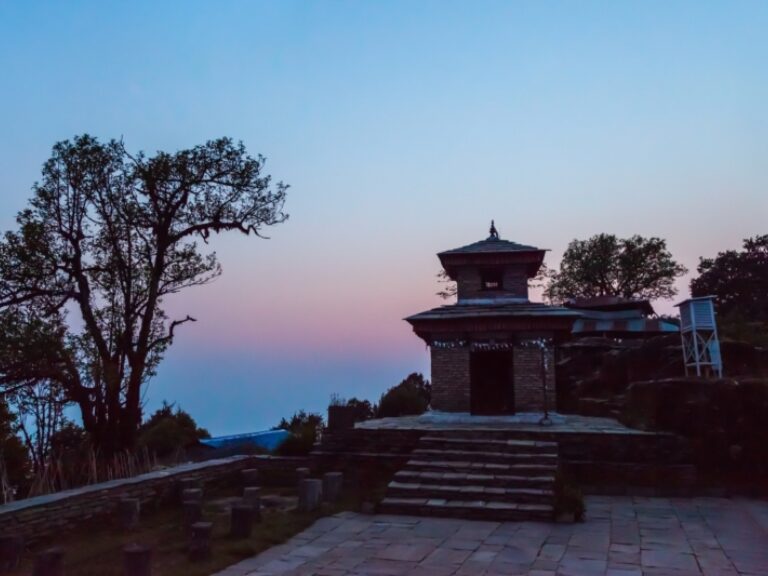
Panchase Trek
- Duration: Three to four days
- Max. elevation: 2,500m
- Accommodation: Teahouse lodges
- Start/end point: Pokhara
This is one of my favourite alternative treks in the Annapurna region. Don't worry if you've not heard of it – most visitors haven’t, which means you’ll enjoy largely crowd-free trails while ascending to magnificent viewpoints at a maximum altitude of just 2,500 metres.
A highlight of this route is the way it begins: you’ll depart directly from the lakeside in Pokhara, boarding one of the city’s colourful boats to reach the opposite shore of Phewa Lake. Your destination on this four-day route is the hill station of Panchase, and you’ll pass through a number of charming Himalayan villages to get there. All told, this is a great Annapurna trek where you won’t have to worry about a long haul on dusty roads. I often recommend it for an acclimatisation trek before embarking on one of the longer and higher altitude main routes.
Road-free Annapurna Circuit itinerary
A new alternative to the classic route, annapurna trekking: need to know, everything you wish you'd known before you booked.
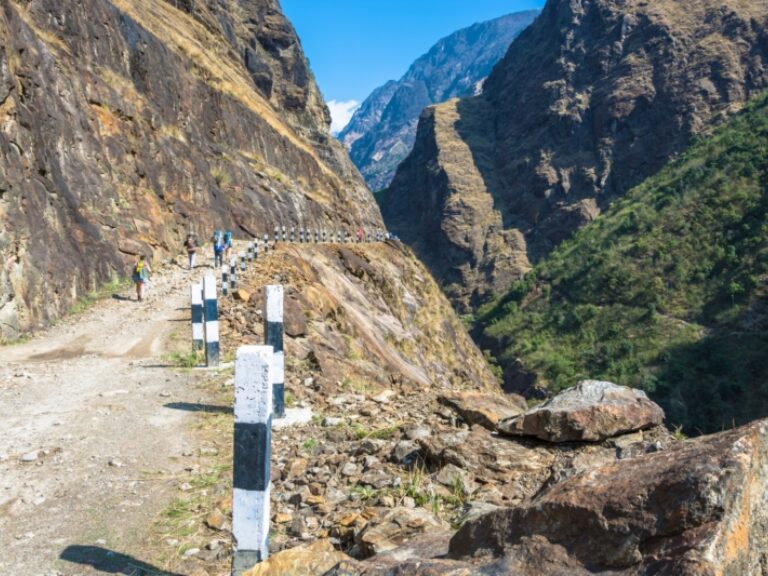
Think twice about the Annapurna Circuit
The Annapurna Circuit consistently tops lists of the world’s best treks – and rightly so. Or rather, it used to be rightly so.
The problem is that these lists are often written by desk-bound editors who’ve never been out there and are rehashing info that's over a decade old. The sad reality today is that road construction has eaten up three quarters of the old Annapurna Circuit trail. The sublime cliff-side paths and mule tracks that I and many others hiked two decades ago are now cloaked in jeep fumes and dust.
My enduring memory of a recent trip to the circuit was seeing a long line of grim-faced trekkers trudging along a dirt road through clouds of jeep dust. It didn’t look like fun, let alone the world’s best trek.
So is the Annapurna Circuit dead? Well, no, not exactly. By choosing smart ending and starting points and following a series of side trails called the New Annapurna Trekking Trails (NATT; with markers painted in blue and white, instead of the red and white of the main trail) you can avoid most of the roads, while soaking up the same astonishing Himalayan views, high-altitude lakes and traditional trading villages that have drawn trekkers here for half a century now.
There’s no denying that the nature of the walk has changed. I still rank the lodges and food along this route as some of the best in Nepal, but many of these are now on the road, and so cater to a different clientele. And while the NATT trails are infinitely better than hiking on the road, they aren’t perfect; you still have to walk some sections on the new road and other dirt roads are eating away even at these detours.
Do your research, stick to side trails and you’ll be a much happier trekker.
Featured Annapurna Treks
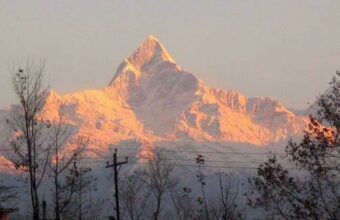
Annapurna Region Treks
Nepal trekking routes.
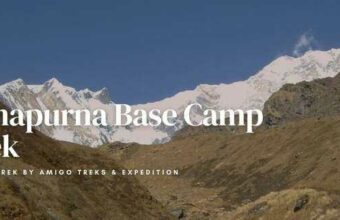
Short Annapurna Base Camp Trek
Mesmerizing views of the annapurna massif,.
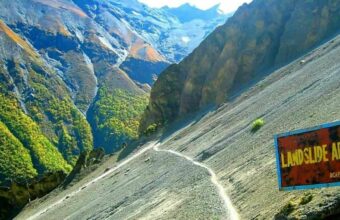
Annapurna Trekking
Nepal footprint holiday.
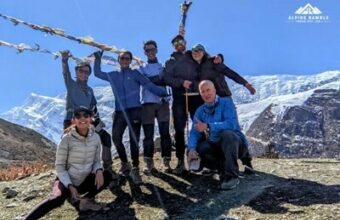
Alpine Ramble Treks
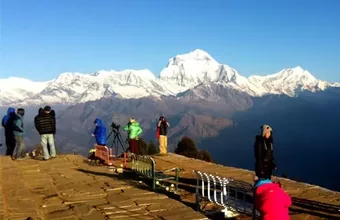
Annapurna Treks
Green society adventures.
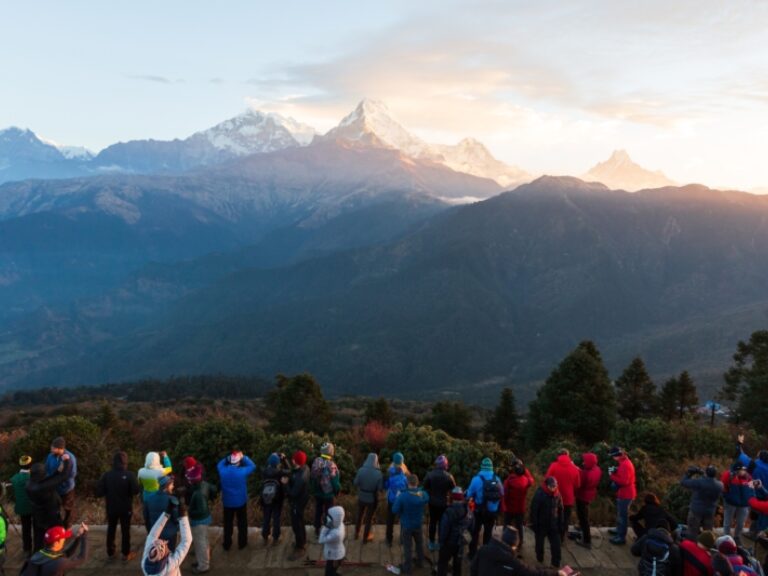
Forget about Poon Hill
I’d argue that Poon Hill is the most overrated viewpoint in the Himalaya.
Pokhara trekking agencies and guides love it because it’s relatively quick, easy and cheap to get to, but it’s just way too busy a spot to provide the ‘sunrise over the Himalaya’ spiritual epiphany you were hoping for. Get better and quieter views of the Annapurna range at Mohare Danda on the Khopra Ridge trek or from Mardi Himal Base Camp, or opt for equally dramatic views of 8,167m Dhaulagiri from the east bank of the Kali Gandaki valley.
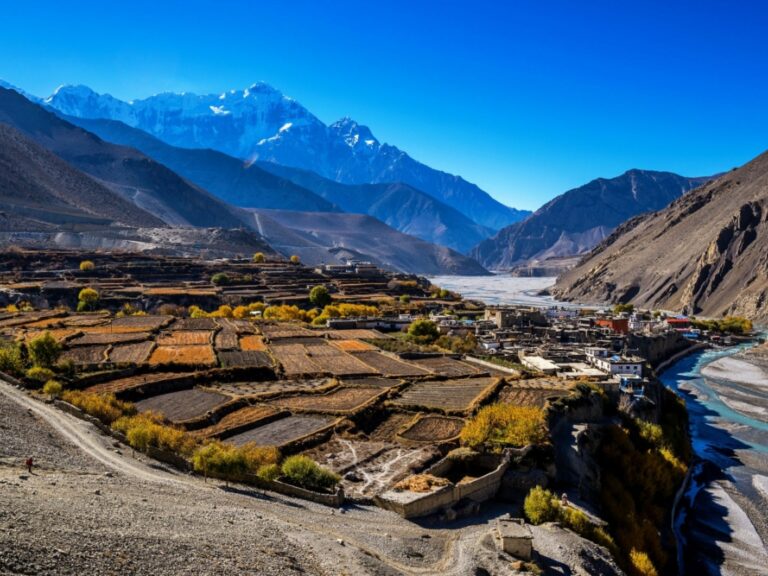
Don't neglect the side trips
The Annapurna Circuit and Sanctuary treks are undeniably busy, so I highly advise building in some spare days to your itinerary. Put the trekking poles down for a day and follow the Hindu pilgrims to the holy town of Muktinath. They’ve come from across the Indian sub-continent to bathe in the freezing spring waters and pray at the eternal flame which lies at the heart of the temple complex. A day’s walk further downhill is Kagbeni, a quiet desert oasis village that you can visit without an expensive permit.
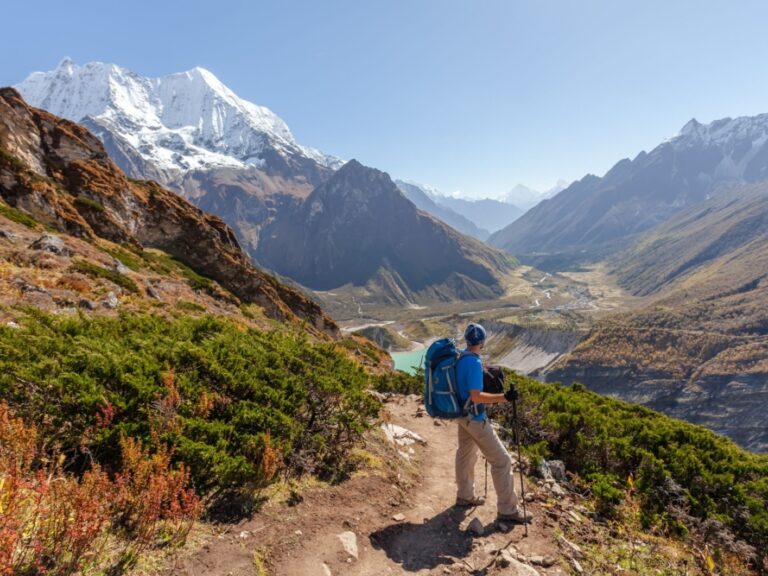
Combine the Manaslu and Annapurna Circuits for a beyond epic trek
It’s hard to imagine a more spectacular trek than combining the best week of the Annapurna Circuit onto the end of the already fabulous Manaslu Circuit . You’ll cross two passes over 5,000m, visit three of Nepal’s most picturesque villages (Sama, Bragha and Kagbeni) and get a taste of traditional Tibetan-influenced culture in the valleys of Nupri, Manang and lower Mustang. This is 18 days of the best teahouse trekking you’ll find anywhere in the world.
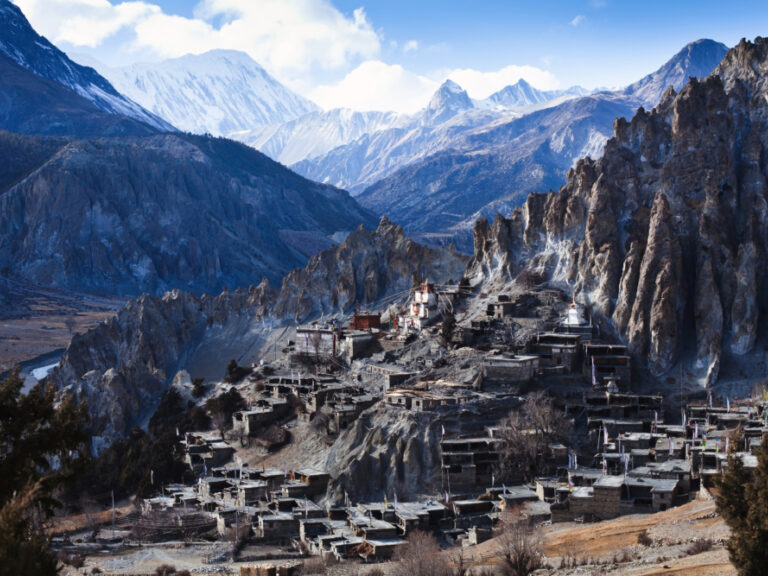
Don’t skip acclimatisation days
Given the pressures of time and budget, I understand it can be tempting to skip those dull acclimatisation days, especially when you arrive at your destination at lunchtime and the itch to push on seems almost irresistible. Skip an acclimatisation day, however, and you’ll almost certainly create problems for yourself later on; you might even have to abandon your entire trek due to altitude sickness. I try to take advantage of acclimatisation days by exploring side trails or hiking higher than the overnight stop, before returning for the night, thus supercharging my acclimatisation by ‘climbing high and sleeping low’.
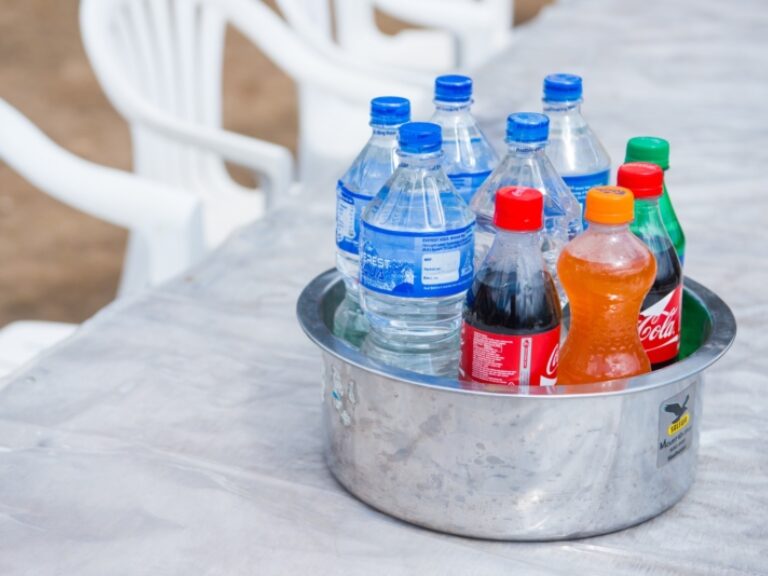
Don’t buy bottled water
Don't contribute to Nepal's huge trash problem by buying bottled water while trekking. Not only are these bottles ridiculously expensive but the non-recyclable plastic ends up strewn across teahouses, villages and trekking trails, giving mountain tourism a bad name. Invest in a water filter like a Lifestraw, UV-light sterilisation like a Steripen, or just pack some good old fashioned chlorine tablets and purify your own water. You’ll save a small mountain of plastic and you’ll have some extra money in your pocket for that extra slice of apple pie.

The stunning Annapurna range from Poon Hill
Annapurna trekking FAQs
Your questions, our expert answers, is there still an option for independent trekking in the annapurna area or do you have to have a licensed guide.
Aside from the Everest region then yes, officially, you do now need an officially recognised guide to hike inside any national park/protected area in Nepal. This would include most of the main Annapurna trails.
However, enforcement of the rule in the Annapurna region has been spotty so far. There are plans (in theory at least) to start enforcing the new rule in 2024.
I would say though that a guide is just a good idea anyway because a good guide (and getting a good one is key) will enhance your trek by giving background information, offering up interesting side routes, translating when required, opening cultural doors and, of course, providing a bit more safety. Not to mention that it gives much needed jobs to local people and in the big picture it costs very little.
What permits are required to trek in the Annapurna region?
All these treks require a TIMS permit (Trekkers’ Information Management System) and an Annapurna Conservation Area Permit. At the time of writing, individual permits cost R 2,000 per trekking route per entry, while group trekkers pay R 1,000 per person. Check the latest prices on the official Nepal tourism board website .
The Nar-Phu trek also needs a restricted area permit (seven days Sept-Nov/Dec-Aug US $90/75, additional days, US $10). You must be in a party of at least two trekkers and be accompanied by a guide.
When is the best time to trek in the Annapurna region?
The best time to trek in the Annapurna region (except for Nar-Phu) is between October and November, and from late February to April. Between late November and early February, it’s very cold at high altitude and the Thorung La Pass will probably be impassable due to snow. The routes to Tilicho Lake will also be snowed in at this time and lodges at higher elevations closed. There’s a real avalanche risk on the Annapurna Sanctuary and Tilicho Lake routes in spring. Avoid trekking most of this area during the monsoon (June-early-Sept)
Nar-Phu is unusual because it lies in the Himalayan rain shadow, and it’s possible to trek here during the monsoon — although you should still expect some rain and obscured mountain views. From November to early March, most valley inhabitants leave for lower and warmer climes and trekking lodges will be closed. The Kang La Pass will also be buried under snow and impossible to cross in mid-winter. This pass can also be complicated in spring with late and/or melting snow and ice. April-May and September-October are great times for Nar-Phu.
What are the Annapurna trekking accommodations like?
The Annapurna Sanctuary and Circuit, the two main Annapurna treks, have numerous trekking lodges of a very high standard., some bordering on luxurious. Hot showers, wi-fi, and international menus are common.
Nar-Phu and Khopra Ridge are earthier with limited and very basic homestay style lodges which fill up quickly. These areas are best trekked on a fully organised camping expedition.
How easy are the trailheads to access?
Access to trailheads for most Annapurna treks is fairly simple and all but Nar-Phu and Tilicho Lake start and end a short bus or taxi ride from Pokhara. An ever-expanding road network is changing routes in this region and many people skip the first couple of days of the Annapurna Circuit by driving up the valley.
An equally large number finish the trek at Jomsom from where there are regular buses and jeeps back to Pokhara as well as early morning flights. However, be warned that landslides can block the road for days on end and flights are frequently cancelled due to unfavourable (ie terrifyingly strong) winds. Allow an extra day or so in your schedule.
Can you recommend quieter alternatives to Everest or Annapurna?
Everest , Annapurna and to some extent Langtang are the favourites for first-timers. These three regions are convenient with easy access, plenty of lodges and good facilities. However, during the 'peak seasons' of mid-March to mid-May & October to November, these regions get very busy indeed.
My personal advice for someone looking for a quieter experience is to look at either the Manaslu or Kanchenjunga regions. The Manaslu Circuit trek has been hailed the "new Annapurna Circuit" and Kanchenjunga North offers some of the best views you'll get without straying into actual mountaineering. Until a decade ago trekking here used to be a full scale, high-cost camping expedition. These days there are some lodges on the routes but still far fewer trekkers, which makes them attractive if you're looking for true wilderness, unspoiled culture and quiet views.
Nothing takes away from the beauty of Everest or Annapurna, but for a different experience, Manaslu or Kanchenjunga get my vote.

Abhi Shrestha
What should i pack for a nepal trek.
My most important advice is – keep things light and minimal. When you’re slogging your way up to a mountain pass you will regret every extra kilo you’re carrying. The following is a list of recommended items, some of which are more essential than others.
Hiking boots
You’ll need boots. Not shoes or trail running shoes. Make sure they’re waterproof, very sturdy and above all, comfortable. Don’t buy a cheap pair. Make sure you break them in before leaving for Nepal. Whatever you do, don’t hire boots in Nepal as they probably won’t be up to scratch and will give you blisters. Nothing will ruin your trek more than blisters.
Winter jacket
A thick, warm, waterproof and breathable but lightweight jacket is another must. It needs to keep you warm as toast in sub-zero temperatures. These can be rented in Nepal but most are inferior knock-offs of respected brands. They’re okay for a one-off trip but if you’re likely to go mountain trekking again, it’s worth buying your own jacket.
Sleeping bag
It gets bitterly cold at night, even at comparatively low altitudes in winter, and the thin, gap-riddled walls of trekking lodge bedrooms provide little protection. Get the warmest yet lightest one you can afford. When a manufacturer says a sleeping bag can be used down to minus-10 degrees the reality is you won’t be comfortable in it below about plus-five. Aim for one that says it will keep you warm down to minus-20 or lower. A really good sleeping bag is expensive. Bags can be rented in Nepal but as with jackets, they’re very rarely of good quality.
Trekking Poles
If you’ve never trekked before then you might consider trekking poles as something that just old people use. Well trust us, if you don’t use them after a few days clambering up and down steep Himalayan slopes you’ll forever walk like an old person… Poles help save energy going up and take the strain off your legs on the way down. They also stop you falling and twisting ankles as much.
Water bottle
Take two of at least a litre each and refill whenever possible. Don’t rely on bottled mineral water. It’s often not available and it’s environmentally unfriendly, particularly up in the mountains where there’s little chance of recycling.
Water purification pills
Get enough to treat at least three litres of water a day. On more popular trekking routes some lodges provide pre-treated water but don’t rely on this always being available.
Two or three thermal tops of different thickness and even a pair of thermal under-trousers are worth their weight in gold.
Two fleeces, one thin and one thick, are vital.
Walking trousers
Don’t try to skip around the Annapurna Circuit in a pair of jeans (yes, we’ve seen people try. And fail). Get some comfortable walking trousers. Two pairs should be sufficient for the longest treks.
T-shirts/shirts
Many people recommend specialist quick-dry shirts designed for trekking. However, we’ve used a combination of these and normal shirts and T-shirts and never noticed much difference. Don’t over pack. You probably won’t change your shirt more than once in a two-week trek!
Specialist hiking socks are supposed to reduce blisters and are worth buying. However, changing your socks frequently seems to reduce blisters as much as any clever equipment. Take at least three pairs for a two-week trek. Also pack a thick, warm pair of ski socks to keep warm when you arrive at camp.
Most people appreciate being able to remove their boots at the end of the day and don some sandals (with or without thick ski socks, depending on how cold it is).
A sun hat is vital for hotter, lower elevations, and a winter hat or balaclava for up high.
Take a thick warm pair of skiing gloves and a thin, cotton pair of under gloves. You won’t be able to use your camera or eat properly with thick gloves but you can with the thin ones, and they’ll keep your hands warm for a few minutes.
Sun glasses
An essential bit of kit at all elevations. The sun reflecting off the snow can quickly frazzle your eyes.
Suncream and sunblock
Slap on lots of sun cream no matter what the weather or elevation. Use total sunblock on lips, nose and ears.
Keep this minimal as you won’t get much chance to wash. A small lightweight travel towel isn’t a bad idea.
A head torch is a must.
The evenings can be long. Bring a good book, not a tablet or Kindle as power sources can be erratic and batteries drain very fast at altitude. Don’t forget a guidebook. We recommend the Rough Guide to Nepal , which covers the country and gives details of the main treks. For specific trekking information try Lonely Planet’s Trekking in the Nepal Himalaya .
Even non-photographers will want photos of this stunning scenery.
Spare batteries
Bring spare torch, camera and phone batteries. Below a certain temperature and above a certain altitude (which vary from product to product), batteries drain very fast or don’t work at all. Above about 3,000m put the batteries in your sleeping bag at night to keep them warm and reduce drainage.
A few biscuits and chocolate bars might give you the energy boost you need to get over that pass.
To carry all this you’ll need a decent, comfortable trekking backpack. Don’t consider any other kind of bag. If you’re using a porter you’ll need a small backpack for your day gear and you’ll have to provide a bag for the porter to carry - a holdall is best.
Travel Insurance
You’d be utterly insane to go trekking in the Himalayas without a decent travel insurance policy. Make sure it covers trekking above a certain altitude and helicopter rescue.
Leave the gadgets at home
Don’t bother taking computers, tablets, etc. They get easily broken on the trail and the batteries probably won’t work at altitude. More importantly, most people don’t want to see fellow trekkers glued to their tablets in a lodge at night.
Now it's no longer possible to do the Annapurna Sanctuary trek solo can you recommend any licensed operators in Kathmandu who can help?
Although I always recommend using a guide, ending solo trekking is such a big change to the Annapurna trekking scene! I can understand why people are disappointed. I can't recommend any individual operator, but there is a list of licensed Annapurna trekking companies here .
We have around 8-10 days trekking in the Annapurna region, but want to avoid crowds. Can you recommend any quieter alternatives to the Annapurna Circuit?
There are lots of alternatives to the Annapurna Circuit in the Annapurna region . With eight to ten days you could combine Nar-Phu and Tilcho Lake. Getting to the Nar-Phu valleys would take about five to six days depending on where you started and how long you stayed in either Nar or Phu village. You could then scoot across to Tilcho Lake (you'd probably need to hop in a car for the short drive toward Manang village where the trail starts) for another four days trekking. This would give a great mix of traditional Tibetan villages in Nar-Phu and spectacular mountain scenery around Tilcho.
Another option is the new Annapurna North. I've not yet had the chance to walk this one myself (it's really only come onto the scene recently) but I have heard good things about it and it's certainly going to be very quiet. I'm not totally sure of the length but I think it fits with your timeframe. I know there are basic teahouses and they have set up an interesting community tourism project to ensure money gets distributed fairly between all villagers.
About the authors
Stuart is an award-winning travel journalist and guidebook author who has been visiting and trekking in Nepal for over thirty years. One of the world's leading authorities on Nepal trekking, he is the author of Lonely Planet’s Trekking in Nepal , the Rough Guide to Nepal , the Tibet chapter of the Rough Guide to China and the Bradt guide to Kashmir & Ladakh . He is also regularly published in The Independent , BBC , Time Out , The Telegraph , among many other UK and international publications.
Bradley is a travel journalist and guidebook author specialising in trekking in Central Asia, Nepal, Bhutan and elsewhere in Asia. He writes for Lonely Planet, Odyssey Guides, Insight Guides, among others.
Why Horizon Guides?

Impartial travel guides
Our guides are written by the leading experts in their destinations. We never take payment for positive coverage so you can count on us for impartial travel advice.

Expert itineraries
Suggested itineraries and routes to help you scratch beneath the surface, avoid the tourist traps, and plan an authentic, responsible and enjoyable journey.

Specialist advice
Get friendly, expert travel advice and custom itineraries from some of the world's best tour operators, with no spam, pressure or commitment to book.
Our guides are 100% impartial and are written by independent, professional travel journalists. We make money by charging carefully-screened travel companies to list their business on our website. Our advertisers have no influence on our editorial content and we never accept payment for positive coverage.
Read more about how we work and what we believe in here .
- Travel guides
- Work with us
Sitemap , Privacy Copyright © 2024 Horizon Guides
Annapurna Circuit Trek
15 days | challenge yourself to trek the mighty annapurna circuit in nepal..

Trek through the incredible Annapurna region and be awed by the Nepalese Himalayas. These snow-capped peaks, mist-shrouded valleys, isolated communities and remote monasteries will inspire those with a bold spirit and a yearning for a definitive nature experience. Reach altitudes of more than 5000 metres, discover the ancestral traditions of the local people and immerse yourself completely in the spectacular mountain wilderness of the Annapurna Circuit. This is a challenging trip, but the sense of accomplishment will leave even the most seasoned trekker with some unforgettable memories.
Trip overview
- Ascend to the clouds and reach an altitude of 5416 metres as you cross the Thorung La Pass along the Annapurna Circuit. Testing your mind and body, this is one hell of an accomplishment.
- Uncover a different side of the Himalayas, trekking past terraced rice fields, oak and rhododendron forests, there’s a diverse array of nature that awaits in the Annapurna region.
- Learn about life in Nepalese mountain communities, get to know locals and meet other trekkers while you stay in teahouses in the small communities along the way.
- Discover Nepal’s compact capital in Kathmandu. With a limited amount of time spent here to discover its bazaars and temples, why not extend your stay beforehand to get a real feel of Nepalese culture.
- Spend time in the peaceful haven of Pokhara after your trek has finished. Relax with your small group on the banks of Phewa Lake and take in the mountainous surrounds that you have conquered!
- By travelling on this trip, you’ll directly support our Intrepid Foundation partner, Sagarmatha Next. Donations help them remove waste responsibly and turn rubbish into art in the Everest region.
- This trip involves an 11-day trek at high altitude (up to and above 5000 metres) – precautions and acclimatisation are undertaken, but be aware of the effects altitude can have. An excellent level of fitness is required on this trip, with treks of up to 9 hours a day at high altitude. See our guide to trekking in the region here to help decide if this trip is what you are looking for in a holiday: https://www.intrepidtravel.com/adventures/annapurna-circuit-hiking-guide
- Due to the nature of outdoor travel, please be aware that this trip will operate on an amended itinerary in high risk weather conditions. Please note that Thorong La Pass is occasionally closed in winter months due to heavy snowfall. Alternative arrangements will be made by your group leader if this occurs.
- Accommodation on this route is in simple teahouses, which also allows you to experience the friendly spirit of the local Nepalese people.
- Please read our packing list for required equipment carefully, and remember that you don’t necessarily have to bring it all with you – you can hire or buy some of it in Kathmandu.
- Trying to decide between trekking in the Annapurna or Everest regions? This might help you decide: https://www.intrepidtravel.com/adventures/annapurna-vs-everest
Namaste! Welcome to Nepal. Your adventure begins with a welcome meeting at 2 pm in Kathmandu, the colourful capital of Nepal. This place is a fascinating blend of traditional architecture and symbols of the 20th century. Its rich artistic and cultural heritage is evident where ornately carved balconies mingle with beautiful shrines and temples. If you arrive early, why not check out Durbar Square with its temples, markets and busy atmosphere. It is also worth the climb to visit the Swayambhunath – the 'monkey temple'. Explore the network of street markets and alley bazaars and Pashupatinath. For those with a few extra days in Kathmandu, the neighbouring towns of Patan and Bhaktapur are also well worth a visit.
- Hotel (1 night)
There are no meals included on this day.
- Kathmandu - Everest Scenic Flight - USD240
- Kathmandu - Panorama Hike Urban Adventure - USD57
- Kathmandu - Spiritual Nepal Experience Urban Adventure - USD68
- Kathmandu - Exploring Patan & Bhaktapur Urban Adventure - USD97
It’s very important that you attend the welcome meeting. Ask reception for more information on where the meeting will take place.
With climate change the weather on the Annapurna Circuit is becoming less predictable, and heavy rains on occasions causes significant damage to the trail even outside of rainy season. Should this occur, and conditions make trekking the circuit unsafe, we will switch to the Annapurna Base Camp itinerary instead. A flight from Pokhara back to Kathmandu on Day 15 will also be included. See for further details: https://www.intrepidtravel.com/au/nepal/annapurna-base-camp-trek-144945
This morning, drive to Besisahar to immediately immerse yourself in the spectacular mountain wilderness that encompasses the Annapurna Range. After lunch you’ll begin your trek straight away, heading to Ngadi. Hit the trail that takes you through Besisahar bazaar leading downstream, followed by a climb up the rocky steps. There are several ups and downs as the trail makes its way through sub-tropical forests and rice paddies of Sera. Further along, traverse a suspension bridge across Khudi Khola and arrive at Bhulbule. Resume on the trail that passes the Marshyangdi River on a long suspension bridge as Bhulbule is left behind. Once the Ngadi River is crossed, the trail gently leads upwards through scrub forests and across landslides for a short distance, which then leads to few teashops and cold-drink stalls located opposite the rice paddies of Lampata, eventually leading to Bahundanda (hill of the Brahmins) – a charming village in the saddle of a long ridge.
At 8091 m, Annapurna I is one of the highest mountains in the world. Its surrounding sister mountains are equally imposing, creating magnificent panoramas from any viewpoint. Throughout this trip’s trekking you’ll come across isolated mountain communities, each with different ancestral customs and traditions, meaning a visually and culturally memorable expedition. You’ll meet warm and welcoming locals herding yaks and goats on the grassy pastures and visit their monasteries and temples, pass waterfalls of melted snow, cross icy rivers, walk along broad plains and hike up high mountain passes.
- Teahouse (1 night)
Trek Distance: 12 km Approximate Duration: 4 hours Ascent: 510 m Descent: 410 m
Keep an eye out for dazzling cascades along your trail today as it makes its way through a deep wooded canyon with a few stretches of steep climbing. Wander through rice paddies, follow winding trails through sub-tropical forest, cross suspension bridges swaying over raging rivers, pass waterfalls of melted snow and climb steep mountain passes. Over the next ten days you’ll come across isolated mountain communities, each with different ancestral customs and traditions. Be prepared to be inspired, mesmerised, challenged and delighted.
Trek Distance: 18 km Approximate Duration: 7 hours Ascent: 1200 m Descent: 800 m
Today’s trek continues through the deep wooded canyon embellished by stunning waterfalls. You’ll be venturing into the Manang district of the mountain range, with much of the trail ascending throughout the day.
Trek Distance: 12 km Approximate Duration: 6.5 hours Ascent: 880 m Descent: 150 m
Marking the end of the great Marsyangdi Gorge, make a steep climb to Timang, then the trail settles into gentler slopes as the vegetation transforms from dense pine forests to drier slopes. The district headquarters of Manang, Chame, is the largest settlement after Besisahar.
Trek Distance: 17 km Approximate Duration: 6 hours Ascent: 730 m Descent: 300 m
A slew of breathtaking scenery is on the cards today as the trail goes through a deep gorge, then past the great sweeping slope of Paungi Danda. On they way to Chame stop at a beautiful apple orchid for a tea/coffee break and perhaps try one of the fresh bakery treats on offer. Today is mostly an easy walk with few ascending stretches of trail dotted throughout the day.
Trek Distance: 15 km Approximate Duration: 6-7 hours Ascent: 720 m Descent: 300 m
Trek the northern trail via upper Pisang and Ghyaru – an area renowned for its spectacular views. It is now drier and you are sure to come across local farmers herding yaks. Here’s a hot tip – Tibetan yaks take a special interest in people wearing red, so choose your gear carefully today!
Trek Distance: 19 km Approximate Duration: 8 hours Ascent: 960 m Descent: 630 m
Spend a day here to acclimatise by doing some high climbing, then return to the lower altitude of Manang for the night. Manang, a village of about 500 flat-roofed houses, offers excellent views of Annapurna II, Annapurna III, Gangapurna and Chulu East.
Trek Distance: 4 km Approximate Duration: 3 hours Ascent: 350 m Descent: 350 m
Today will be a steadily uphill climb into the alpine region of the mountain range. You’ll arrive at Yak Kharka, ready for an easier day of trekking tomorrow to acclimatise to the high altitude.
Trek Distance: 10 km Approximate Duration: 5 hours Ascent: 640 m Descent: 100 m
Due to the altitude, feel free to take the next section of the climb at a leisurely pace, meaning you’ll have time to admire the magnificent views from this part of the route. Once at Phedi, there will be plenty of time to rest and acclimatise to the higher elevations ready for the next part of the climb where you will encounter the Thorung La Pass – the highest point on this Annapurna Explorer.
Trek Distance: 7 km Approximate Duration: 5 hours Ascent: 630 m Descent: 150 m
Setting off very early to cross the Thorung La Pass (5416 m), the trail is steep but easy to follow. After between 4 to 6 hours climbing, reach the Pass's peak, adorned with prayer flags, a traditional stupa (chorten) and stone cairns built by travellers. Stop to admire the stunning views and marvel at how far you've climbed. Further along, the trail descends steeply proceeding towards Chabarbu. From here on, the trail crosses meadows, drops into a deep ravine, climbs out and follows a wide trail into Muktinath – a pilgrimage site held in great reverence by both Hindu and Buddhist populations.
Trek Distance: 14.5 km Approximate Duration: 8-9 hours Ascent: 915 m Descent: 1780 m
Veer off the main trekking trail to make a side trip to an ancient village of Purang. Further up from the village, continue to take the less frequented route going past another village with a medieval feel to it – Jhong. From Jhong, descend to the Jhing Khola (river), following the course which you emerge on to Kagbeni. From Kagbeni we will hop on a public bus back to Jomsom.
- Guesthouse (1 night)
Trek Distance: 11 km Approximate Duration: 4-5 hours Ascent: 110 m Descent: 950 m
Depart early on a 4WD from Jomsom, stopping in Tatopani for an included lunch, opt for a well-earned visit to the Tatopani Hot Springs (especially rewarding after multiple days trekking). After, continue your journey to Pokhara. Pokhara is a peaceful lakeside location which rests beneath the snow-capped peaks of the Annapurna Range. A once vibrant trade route extending between India and Tibet, this is the land of Magars and Gurungs, hardworking farmers and valorous warriors who have earned worldwide fame as Gurkha soldiers. The Thakalis, another important ethnic group here, are known for their entrepreneurship. When you arrive, maybe sip on a cold brew and gaze up at the dramatic pass that you have just conquered. There are plenty of lakeside cafes where you can enjoy international cuisine, while the main street is full of shops and stalls selling a wide range of Nepali and Tibetan souvenirs.
- Tatopani Hot Springs - USD1
Your travel time today will be approximately 8 hours.
Enjoy a free day in Pokhara to unwind, relax and give those muscles a rest after all that trekking. Your leader can advise you of sightseeing opportunities. It is worth taking a boat for a row out on the lake, especially if the weather's fine. The lakeside area has great shopping and cafes. Pokhara has an interesting old area as well as an elaborate Hindu temple and a Buddhist monastery. Perhaps visit the Peace Pagoda, where spectacular views of the mountains await. You can see the Annapurnas from here, and the famous fishtail peak, Machhapuchhare, and back across to Pokhara. You can also visit the fascinating International Mountain Museum to learn some amazing tales of past climbing expeditions.
With no activities planned for today, you are free to leave at any time. Pokhara is a stunning and peaceful lakeside haven, so if you would like to spend more time here, we’ll be happy to organise additional accommodation (subject to availability).
Private vehicle
Guesthouse (1 night), Hotel (3 nights), Teahouse (10 nights)
Dates and availability
Important notes.
1. A single supplement is available if you’d prefer not to share a room on this trip. The single supplement will only be included on Days 1,13,14 (Hotel) and is subject to availability. Please speak to your booking agent for further information. 2. You may be asked to provide 2 passport size photographs for your trekking permit. 3. Due to the demands of travelling at high altitudes a Passenger Self Assessment Form is required for this trip. Please also see here for information: https://www.intrepidtravel.com/au/altitude-sickness 4. With climate change the weather on the Annapurna Circuit is becoming less predictable, and heavy rains have on occasions causes significant damage to the trail even outside of rainy season. Should this occur, and local conditions make trekking the circuit unsafe, we will switch to the Annapurna Base Camp itinerary instead. See https://www.intrepidtravel.com/au/nepal/annapurna-base-camp-trek-126570 for further details. 5. There is a dirt road that stretches from Muktinath to Jomsom and Tatpaoni. When weather conditions allow, we use an alternate track for this portion of the trek to avoid the road as much as possible. Travellers are obliged to walk on the off road in most of the trekking sections until Manang. 6. This trip ends in Pokhara. Intrepid offers a pre-arranged transfer and flight service option back to Kathmandu airport. Enquire with your agent at least 30 days prior to your trip departure. 7. You must bring an emergency fund of USD 500 in cash with you on this trip, which you may need to use in case of delayed or cancelled flights. This is especially important should you choose to opt to take a helicopter as this will be at the travellers expense. 8. As this trip ends in Pokhara, if you wish to transfer your stored luggage from Kathmandu to Pokhara, we can arrange this by a private vehicle. Additional cost is 100 USD. This cost is divided among the interested participants. 9. Please be aware that in the event of an emergency evacuation, Intrepid does not have control over which helicopter service may be used. Some helicopters are not in regular use with Intrepid and have not passed our internal safety auditing.
Want an in-depth insight into this trip? Essential Trip Information provides a detailed itinerary, visa info, how to get to your hotel, what's included - pretty much everything you need to know about this adventure and more.
Filter by rating

Annapurna Circuit

ACTIVITY LEVEL
Kathmandu, nepal.

Learn more about our Annapurna Circuit trip:
Embark on the annapurna circuit in nepal, j oin the explorer’s passage for one of the most extraordinary treks on the planet: the annapurna circuit. stay at local tea houses as you follow this ancient himalayan trade route, climbing through jungle-like terrain and rice fields, past canyons and waterfalls, and trekking among snowy peaks at thorung la pass (17,768 feet / 5,415 meters in elevation). from the bustling streets of kathmandu to the serene mountain villages of the gurung people, this adventure offers diversity in culture and landscape, and the opportunity to meet other adventurers from across the globe. the annapurna circuit is truly a must for any serious trekker., read below to review trip details and highlights, a sample itinerary, trip customization options, accommodations, photos, and more, trek the annapurna circuit with t.e.p., we take care of everything.
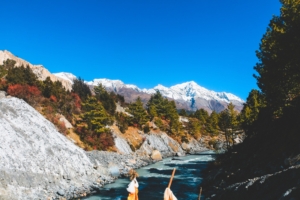
W e go above and beyond our competitors in handling every detail of your Annapurna Circuit trek, so that you can focus exclusively on experiencing all that Nepal and the Himalayas have to offer. Our trips are all-inclusive, crafted with the intent of providing you with an unforgettable adventure travel experience. All you have to do is show up at the airport in Kathmandu!
Expert guides.
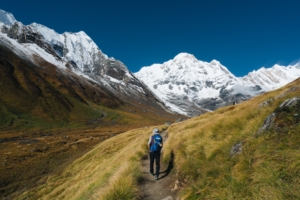
E xperience the Annapurna Circuit with the finest trekking guides in Nepal. Our knowledgeable guides have been leading adventures in the Himalayas for over thirty years, and are some of the pioneers of trekking in the Annapurna region. Many of our guides are also local to the Khumbu region of Nepal, which is home to the Sherpa community.
Responsible travel and sustainability.
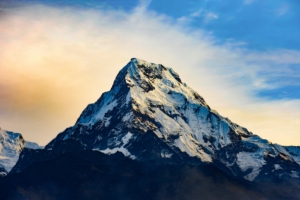
T he Explorer’s Passage is a member of Sustainable Travel International, a partner/supporter of the Leave No Trace Center for Outdoor Ethics, as well as a supporter of the Center for Responsible Travel (CREST). We very proudly incorporate the principles of these organizations throughout your trip to Nepal.
Trip highlights.
- Explore the busy streets of Kathmandu, including a guided tour of UNESCO World Heritage Sites, the Pashupatinath and Boudhanath stupas.
- Follow an ancient trade route on one of the oldest treks in the Himalayas.
- Trek over the challenging Thorong La pass (17,768 feet / 5,415 meters), the highest point on the Circuit, and be rewarded with views of stunning, snow-capped peaks.
- Rest your feet at mountain tea houses in villages along the trail, where you can share hearty, memorable meals with fellow adventurers and local Sherpas.
- Travel over diverse terrain, including lush lowland forests of rhododendron trees, open meadows and pastures, rice fields, waterfalls, rivers, glacial lakes, rocky and rugged paths, and humbling mountain landscapes.
- Visit the sacred temples of Muktinath, a holy place for Hindus and Buddhists.
- Meet other explorers from around the world on this incredible journey of a lifetime.
From $4,295 USD per person
*More info. on pricing
Pricing starts at $4,295 USD per person
Single Supplement for Hotel: from $795 USD
More questions? Read more about pricing here
START DATES
Custom Dates Available
*To inquire on a custom date, please contact us !
2023 Group Trip Dates below:
- September 15, 2023
- October 2, 2023
- October 7, 2023
- November 3, 2023
2024 Group Trip Dates below:
- March 15, 2024
- April 12, 2024
- May 3, 2024
To inquire on a custom date, please contact us!
18 Day Itinerary
Trekking duration is 9 days. For more information about itinerary options, please review the section about trip customization on this webpage.
ACCOMMODATIONS
Various Options*
In Kathmandu, Besisahar, and Pokhara, choose between 3-Star or 5-Star hotels. While hiking the Annapurna Circuit, everyone stays in tea houses, which are comparable to many other mountain lodges/huts in other parts of the world.
*Read about accommodations in Nepal
MAX. GROUP SIZE
( Private groups: 20 people)
Advanced* Activities: multi-day hiking on the Annapurna Circuit.
Elevation: Start: 2,493 feet / 760 meters; End: 17,768 feet / 5,415 meters
Daily trekking distance: ~4 to 12.4 miles / ~ 6.4 to 20 kilometers per day
Total trekking distance: ~79 miles / 127 kilometers
*Please refer to our Trip Activity Level Guide for more information
Please Note – the Trip Activity Level Guide is for guidance only and provides a general sense of what you should expect on our trips. Actual times, distances, and elevation can be outside the ranges outlined below.
Trips designated “easy” are perfect for first-timers, or travelers looking for a mild physical challenge. hikes, treks, and horseback rides are short and terrain is typically flat, at an elevation not exceeding 5,000 feet. on paddling trips, river currents move swiftly, thus minimal paddling is required..

“Moderate” trips are more active and require a bit more endurance. Hikes, treks, and horseback rides includes occasional steep ascents. Elevation can occassionaly reach up to 15,000 feet. River currents are moderate and some stretches include Class 1-2 rapids.

Trips marked “Advanced” require strong physical stamina, as we’re often active for 8+ hours per day. Hikes, treks, and horseback rides include traversing more rugged and mountainous terrain, at elevations that can reach up to 15,000 feet. Rivers currents are moderate to swift and often include paddling white water through Class 1-3 rapids.

TEP’s most physically demanding trips fall into the “Explorer” category. Expect 8+ hours of activity per day. These trips are demanding, yet attainable for those seeking the challenge. Hike, trek, and horseback ride on rugged and mountainous terrain with frequent steep ascents. Elevation may exceed 15,000 feet. Rivers currents are moderate to swift and often include navigating white water through Class 1-3 rapids.

More Questions? Speak to one of our Adventure Consultants at 855-208-6800 to determine if this is the right trip for you OR Read more about the Trip Activity Level Guide

SAMPLE TRIP ITINERARY
18 day / 17 night trip daily overview, day 1: arrival in kathmandu, nepal.
Namaste , and welcome to Nepal! Upon arrival in Kathmandu, transfer to your hotel. In the evening, enjoy a welcome dinner where you will meet your guide and perhaps a few fellow travelers.
Day 2: Drive to Besisahar
Start your first full day in Nepal with a long, winding drive. As you leave Kathmandu, the route curves through the hills, following rivers and climbing higher and higher through rural Nepal until you reach Besisahar, the gateway to the Annapurna Circuit.
Day 3: Drive to Manang
Buckle up – today you will board a 4-wheel drive vehicle and travel the bumpy road to Manang on a nine hour tour through mountain villages, taking in stunning views of waterfalls and jagged, snowy peaks. Stop at the large village of Chame to explore the shops and teahouses before continuing up to the plateau, where you will stay at your first guest house.
Day 4: Day in Manang; Optional Hike to Gangapurna Glacier Lake
Spend today in Manag getting accustomed to the high elevation. Wander the streets of historic Manang or opt for a practice hike to view Gangapurna Glacier Lake or the surrounding monasteries.
Day 5: Acclimatization Hike to Ice Lake
After breakfast, begin your acclimatization hike to the Ice Lake (Kicho Tal). Due to its high elevation in the Manang valley, it is often frozen, hence its name.
Day-hike distance: approximately 9 miles/14.4 kilometers (7-10 hours).
Day 6: Start the Annapurna Circuit; Trek to Tilicho Base Camp
Today you officially embark on the Annapurna Circuit. Begin by walking through Manang’s western gates, then down to the river, through coniferous forests, past villages and a monastery, until Tilicho Peak comes into view.
Daily trekking distance: approximately 12.4 miles/20 kilometers (7-8 hours).
Day 7: Trek to Tilicho Lake
Tackle the initially steep climb to Tilicho Lake in the early morning, accompanied by yaks and deer that graze along the path. Your destination is Tilicho Lake, where it is said the events of the Hindu sacred text the Ramayana were originally told. After spending time at the lake you will return to Tilicho Base Camp.
Daily trekking distance: approximately 6 miles/9.7 kilometers ( 5-6 hours).
Day 8: Trek to Leder
Today your trek will take you past the villages of Sri Kharka Village and Tenki, through pastures and juniper forests, and to Gunsan, a village of flat, mud roofed houses, until you at last reach the open meadow of Leder.
Day-hike distance: approximately 11.5 miles/18.5 kilometers (5-6 hours).
Day 9: Trek to Thorong Phedi
Your goal today is Thorong Phedi, the village at the foot of Thorong La pass. The terrain on this part of the trek is rugged and otherworldly – much different from the lush forests at the start of the trek. Here you’ll find the best views of Mt Gundang, Mt Syagang, Thorong Peak, and Mt Khatungkan.
Daily trekking distance: approximately 4 miles/6.4 kilometers ( 3-4 hours).
Day 10: Trek through Thorong La Pass to Muktinath
Today you’ll face the most challenging day of the trek as you hike Thorong La Pass, one of the highest passes in the world. Your reward? Breathtaking views of the Himalayas in the morning light. Afterward, descend to Muktinath to visit the temples there.
Daily trekking distance: approximately 10 miles/16.4 kilometers ( 5-6 hours).
Day 11: Muktinath Temple and Tatopani
Start the day at Muktinath temple, a holy temple for Buddhists and Hindus, followed by a four hour drive to Tatopani, where you can rest your feet in the lodge and soak in the waters of the natural hot springs.
Day 12: Trek to Ghorepani
After yesterday’s rest, it’s time to lace up your boots again and continue the circuit. As you ascend to Ghar Khola valley you’ll pass through terraced farmland, the ethnic Thakali villages of Sikha and Chitre Ghorepani, and lush forests of birch and magnolia trees. If you’re lucky, the magnificent rhododendrons will be in bloom. Spend the night in the village of Ghorepani, located at the top of the ridge.
Daily trekking distance: approximately 10 miles/16 kilometers ( 5-6 hours).
Day 13: Trek to Poon Hill and Tadapani
Before dawn, climb the steep trail to Poon Hill to catch the sunrise over the Himalayas and see for yourself why this viewpoint is the most popular destination of the Annapurna region. Return to Ghorepani for breakfast, then head east, climbing a ridge then descending through rhododendron forests and passing waterfalls. Spend the night at Tadapani.
Daily trekking distance: approximately 6.9 miles/11.2 kilometers ( 5-6 hours).
Day 14: Trek to Ghandruk
This is your last day trekking the Annapurna Circuit. Today the trail descends through a dark and dense rhododendron forest; by afternoon, you’ll be greeted by cherry blossoms on the opposite slopes of the ravine. In the stone-house village of Ghandruk you’ll enjoy close-up views of the impressive Fishtail, Annapurna South, and Hiunchuli mountains.
Daily trekking distance: approximately 6 miles/9.7 kilometers (6-7 hours).
Day 15: Drive to Pokhara
It’s a four hour drive today from Ghandruk to the lakeside village of Pokhara, where you can enjoy a hard-earned rest and reflect on your remarkable journey.
Day 16: Return to Kathmandu
Day 16: return to kathmandu, nepal.
Say goodbye to the beautiful lake city of Pokhara and start the eight hour drive to Kathmandu. Upon arrival in Kathmandu the rest of your day is free.
For dinner you could seek out an authentic thali . With variations common to much of South Asia, it is a warm curry dish of rice, lentils, meat, and vegetables. You’ve certainly earned a hearty meal after so many days of trekking!
Day 17: Explore Kathmandu, then Farewell Dinner
Day 17: explore kathmandu.
Today is our final full day together. In the morning you’ll take a guided tour of Pashupatinath and Boudhanath stupa. Afterward you might consider seeing some live music in Lazimpat, or visiting the Newa Chen house in northern Lalitpur to experience a 350 year-old Newari home, restored to its original beauty. We can also provide additional recommendations for destinations and activities.
Day 18: Final Day in Nepal
Congratulations on an awe-inspiring journey! It’s time to say farewell to Nepal and its amazing people, mountains, and nature. On your way home you will have plenty of time to plan your next adventure in this wonderful country. Until next time!
Please contact us for a complete detailed itinerary.
Are you interested in another activity or destination in Nepal that isn’t listed above? Planning to spend extra time in the region, or interested in specific travel dates? No problem. As experts in tailored trip planning, we can weave your interests and your timeframe into our customizable itineraries so that every detail of your extraordinary trip unfolds just the way you want it to.
Contact us today to get started customizing your dream trip to Nepal!
Ready to book call us, learn more below, traveler testimonials, read what people are saying about their once-in-a-lifetime travel experiences with the explorer’s passage:, allison (england):, “i had such a great time in nepal with tep. it was the best thing i have ever done”, adam (u.s.a.):, “everything went beyond smooth. it felt like there was a guardian angel over our shoulder the whole time. trip of a lifetime”.

↑ Click the logo to visit our TripAdvisor reviews page, and see why travelers trust our team with organizing their global adventures!
Accommodations in nepal, before and after your annapurna circuit trek you can enjoy a comfortable stay at hotel marshyangdi. alternatively, a 5 star hotel option can be reserved instead – contact us for more details. during the trekking portion of the trip you will stay overnight at tea houses along the route. learn more about these trip accommodations below:, hotel marshyangdi in kathmandu, hotel marshyangdi | kathmandu, nepal.
Located in the attractive Thamel District and close to many city attractions, Hotel Marshyangdi is owned and operated by a family from Manang. Manang is a mountainous region of Nepal, and Marshyangdi means ‘raging river’ in the local Manangi dialect.
All rooms are air conditioned with en-suite bathrooms and internet available. The property also features a relaxing courtyard restaurant, a bar, and a café. Finally, breakfasts at the hotel are included during your stay.
Hotel website
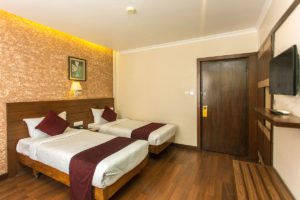
Gateway Himalaya Resort
Gateway himalaya resort | besisahar, nepal.
Gateway Himalaya Resort in Ghanpokhara features 4-star accommodation with a terrace, garden, and a bar. Each room offers air conditioning, free WiFi, and a private bathroom.
Hotel Barahi
Hotel barahi | pokhara, nepal.
Named for the island temple of Barahi the hotel offers fine Nepali hospitality and luxury. Four room types (Deluxe, Super Deluxe, Executive Deluxe, and Suites), each include a buffet breakfast, air conditioning, wifi, and some offer a private balcony with mountain or city views. Visit the onsite dining room, courtyard cafe, or bar for local and international cuisine. After your long trek, relax in the outdoor pool or spa.
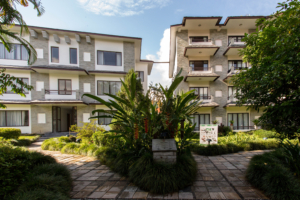
Accommodations on the Annapurna Circuit
Accommodations on the annapurna circuit: tea houses.
During the trekking portion of the adventure, the accommodations will be in tea houses that offer dormitory-style rooms with single and double bunk beds, comparable to many other mountain lodges/huts in other parts of the world.
The tea houses are typically equipped with running cold water and shared bathrooms in a separate section. At most of them, there are propane-fueled hot showers available to use for a small fee (typically $5-10 USD equivalent). It is usually possible to charge personal electronic devices in the common/dining areas, however they also charge a small fee for this (typically $5-10 USD equivalent).
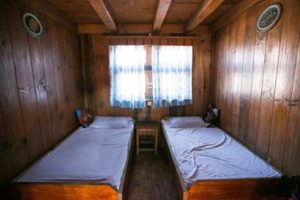
What Sets Us Apart
Personal attention before your annapurna circuit trek.
There is no other operator in the travel industry that will provide the same level of personal attention before your adventure in Nepal. We get very involved with our travelers before each trip, by offering a series of pre-planning calls in the months and weeks before departure. This provides you with an opportunity to hear directly from us on preparation, trip experience, as well as training. It also gives you the platform to ask questions about any aspect of the trip.
Staff Support
Our knowledgeable support staff take care of the details of your in-country transportation, lodging, meals, cultural tours, and activities. We’ve even scheduled in a bit of free time for you to explore, relax, shop, or eat on your own. When you travel with The Explorer’s Passage, we ensure that every detail is handled.
Sustainability and Responsible Travel
The Explorer’s Passage is a proud member of Sustainable Travel International, a partner/supporter of the Leave No Trace Center for Outdoor Ethics, as well as a supporter of the Center for Responsible Travel (CREST). In addition to ‘Leave No Trace’ principles, the concepts of sustainability and responsible trekking are at the forefront of our Himalayan journeys. As part of this commitment, we: minimize single-use plastic; intentionally stay at smaller tea houses/lodges along the trekking route (they are generally more sustainability-oriented and less wasteful); minimize disruptions to wildlife and local Nepalese communities (this includes noise moderation near homesteads and villages); do not allow collecting of plants, rocks, or other items from the trail; and we only use authorized paths to prevent erosion and damage/disrespect to local sites.
Ready to Book? Contact Us
Annapurna circuit trek photos.
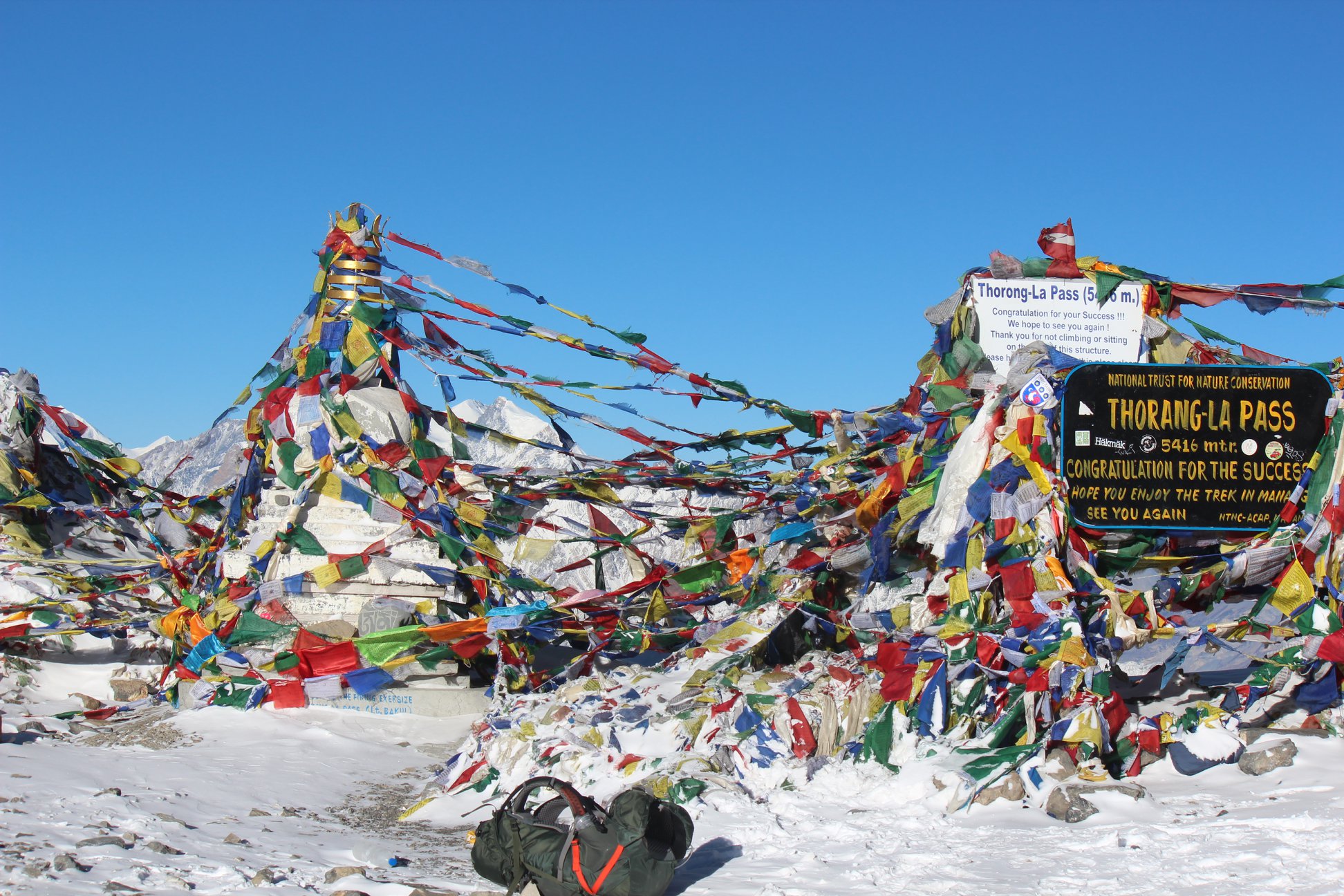
More Trip Inspiration
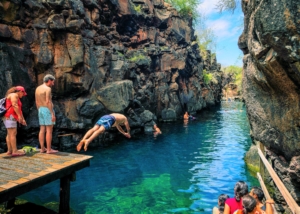
Galapagos Safari Camp
Galápagos Safari Encounter flora and fauna seen nowhere else on Earth on islands famed for their biodiversity EXPLORE Ecuador | Days: 6 | From: $5,995
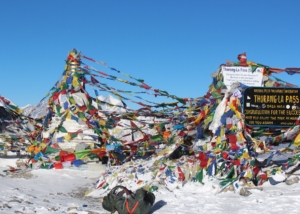
Annapurna Circuit Trek
Annapurna Follow an ancient trade route through the Himalayas on this challenging trek EXPLORE Nepal | Days: 18 | From: $4,295
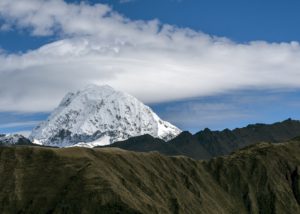
Salkantay Trek
This route is your chance to stray off the beaten path and witness one of the most dramatic corners of the Cusco Andes.
Annapurna Base Camp Trek: A Complete Guide
Annapurna Base Camp (ABC) Trek is one of the most popular treks in Nepal. It is quite easy and shorter trek than other high altitude treks in Nepal. This trek incorporates diverse terrain, culture, and wildlife. Along with the most spectacular and close up view of Annapurna range, Machhapuchhre, Hiunchuli, and Dhaulagiri.
In Spring, it showcases many beautiful flowers including the national flower of Nepal – Rhododendron. Orchids, Machhapuchhre massif and the deepest gorge Kali Gandaki accompanies you during the trek.
You will spot at times high cascading waterfalls. And, you will get to learn about people of different ethnicity, especially Gurung people when visiting the Ghandruk museum.
Depending on which route you take, you may not pass through Ghandruk though. The trail is the same from Chomrung onwards but you can choose to include or not include Ghorepani Poon Hill and Ghandruk. Poon hill is a vantage point for the view of Annapurna plus other peaks and for sunrise and sunset.
Other highlights of this trek are the hot springs! Very relaxing and healing for your aching muscles.
Also, ABC passes through MBC (Machhapuchhre Base Camp). What a blissful moment. Visit two base camps in one trip!
Together with Annapurna Circuit, these trails welcome about seventy percent of the total trekkers visiting Nepal.
Table of Content
Trip Highlights
- Spectacular and close view of Annapurna, Machhapuchhre and Dhaulagiri
- Hot springs
- Gurung Museum in Ghandruk
- Exotic flora and fauna
- Kali Gandaki is the deepest Gorge
Planning trip to Nepal and need help?
Tell us about your trip to Nepal and what you expect from it. We will answer your questions in 24 hours and help you design a trip with a comfortable itinerary to best meet your needs.
- Solo Traveler
- Number of Adults *
- Number of Children *
- Age of children at time of trip *
- I have my exact travel dates
- I have approximate dates
- I don't have my dates yet
- Travel Start Date * MM slash DD slash YYYY
- Travel End Date * MM slash DD slash YYYY
- Month of departure * Choose Month December 2020 January 2021 February 2021 March 2021 April 2021 May 2021 June 2021 July 2021 August 2021 September 2021 October 2021 November 2021 December 2021
- Approximate Duration * Less than a week 1 week 2 weeks 3 weeks More than 3 weeks
- Full Name *
- Give your trip a short title * A short descriptive headline that describes what you're looking for.
- Describe your trip *
Earthquake Update for Annapurna Base Camp
The devastating earthquake of 25 April and 12 May was kinder to the Annapurna region. It suffered the least damage. According to Miyamoto International’s report on damage assessment, less than 1 percent of the route and 3 percent of guesthouses dismantled during an earthquake. Most of the damage occurred on the Annapurna Circuit trail rather than ABC trail. So, the region welcomed trekkers during the peak season of autumn (September-November).
Fixing minor damages the route regained its beauty by September the same year. Now, it is back to normal, as safe as it ever was.
When is the best time to do Annapurna Base Camp trekking?
You can go to Annapurna Base Camp trek any time of the year. Yet, the monsoon is not a good time. There is heavy rainfall during the evening or night but the dark clouds are ever present. This means bad to no view of the beautiful peaks. It also means leeches, mosquitoes, possible landslides and slippery roads. But, this is the time when animals are most active. If you are a keen biologist, then monsoon is best for you.
First, here are the seasons. In Nepal, there are six seasons but it translates as:
- Spring (March to May)
- Summer/Monsoon (June to August)
- Autumn (September to November)
- Winter (December to February)
Autumn is the best time to do this trek. Autumn is a dry season that offers clear blue sky and moderate temperature. This is the best time do any trek in Nepal and is, therefore, very crowded.
You could go during December if you would like it to be quieter. ABC is possible in winter as well. Dry air and clear sky with the best visibility but, during winter, it will be very cold and will snow. If you plan to trek in December, you need to prepare well with appropriate packaging.
Starting from January, you need to be careful about the avalanche when traveling from Deurali to Machhapuchhre Base Camp. This stretch is prone to avalanche. Trekkers should be careful no matter what time in a year they are trekking when trekking from Deurali to MBC.
Spring is another best time to do Annapurna Base Camp trek. Watch out for the avalanche though. Listen to the locals for the news about the avalanche ahead. In spring, the trail will bloom with red and white rhododendrons and many other exotic flowers found in this region, a good time to go for botanists.
Annapurna Base Camp trek route/itinerary
There are 2/3 routes that you can take to ABC. From this, you can plan out many itineraries. All routes coincide at Chomrong and follow the same path to the base camp.
The trail can go straight to the Annapurna Base Camp or take a detour to Ghorepani Poon Hill or take a smaller detour to Ghandruk or both. You can make the climbing stop and returning stop at different villages. Of course, taking different routes causes plus or minus 3-4 days.
Here is a sample itinerary. This trail goes through Ghorepani Poon Hill. In general, the trek starts from Pokhara to Nayapul and ends like Phedi to Pokhara.
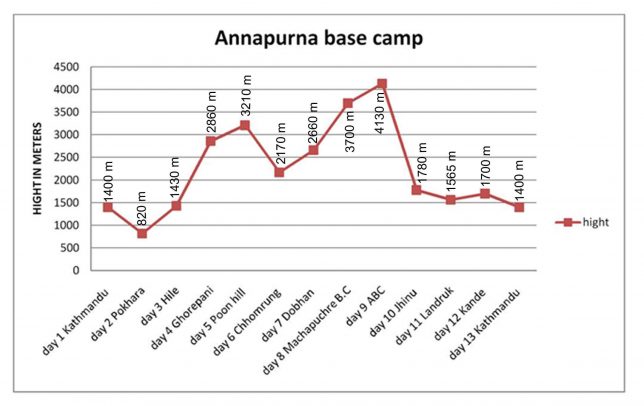
Personally, I think Ghanduk is a prettier village but Pothana is no less beautiful. Also, it is better to go through Ghorepani than to do a straight march up to ABC and back.
Trekking Permits and Costs for Annapurna Base Camp
To trek to Annapurna Base Camp, you need two permits.
- One is Annapurna Conservation Area Project (ACAP) card. This costs:
For SAARC nationals: Nrs.200 (about US $2)
For Others: Nrs.2000 (about US $20)
- Second is Trekkers’ Information Management System (TIMS) card that costs NRS. 2000 (about US $20)
Trekking Gears or Trekking Equipment Required
What to pack for the trek is one of the important questions. Not having proper gears can prove troublesome. It may cause health issues or ruin your mood.
Here is a general idea of what you should bring to Annapurna Base Camp trekking.
- A lightweight trekking boots . It is not impossible to do this trek in sneakers or trainers. Many people try it. Just that you will be walking in snow for some part of the trek and boots offer more safety. But, make sure that your shoes are well fitting, light and comfortable
- A pair of crocs
- Four pairs of liner socks . Two pairs for a warm climate and two pair for cold climate. Trekking/liner socks are better but it is okay if you only have the normal ones.
- Few pairs of underwear. There is trekking underwear that you could buy at home. They are good for other outdoor activities as well. You can find normal underwear in Nepal.
- A high-quality best ultralight packable down jacket and a down pant. You can buy or rent a good down jacket and a down pant in Nepal for cheap for a $1 or less per day.
- T-shirts and trousers keeping in mind both cold and warm temperature you will be traversing.
- A set of thermals. Or, you could layer up.
- A light sleeping bag. You can either buy or rent in Nepal or bring from your country.
- A trekking pole. Though easy, there are many ups and downs in this trek and a trekking pole can assist you. Else, you can find a sturdy stick en route and use it to support yourself.
- Two pairs of Gloves. One for warm weather and one for the cold.
- A woolen hat
- A torchlight or a head torchlight
- A First aid kit including Diamox and Oral Rehydration Salts (ORS)
- Toiletries– Toilet paper, hand sanitizer, water purifiers, sunscreen, moisturizer, toothpaste, and toothbrush.
- A waterproof map of Annapurna Base Camp
- Snacks you like and entertainment such as books, cards, an iPad etc.
Are you unsure of what equipment to buy in Nepal and what to bring from home?
For detail info, check this: buy trekking equipment at home or in Nepal .
Some Frequently Asked Questions
Here are some of the frequently asked questions answered to provide a clearer picture of Annapurna Base Camp Trekking.
1) How fit do I need to be to do this trek?
Annapurna Base Camp is a Grade B or a moderately difficult trekking route. So, any fit person can do this trek, even if you do not have any previous experience. You should be aware of what to expect and mentally prepare for it. Then, as long as you dare to, you can.
2) How long do we walk every day when doing Annapurna Base Camp trekking?
On average, you walk about 4 to 6 hours per day. Sometimes your working hour is only 3/4 hours. While during pleasant and easy trails you walk for 6/7 hours.
3) What is the highest altitude reached in this trek?
The highest altitude reached is 4190m. This is the elevation of Annapurna Base Camp. ABC is the highest we will climb in this trek.
4) What about battery charging and hot shower facilities?
You can charge batteries en route. For this, you need to bring your charger. There are hot shower facilities as well. You may have to pay a certain amount for both ($1-$2). Negotiate. Also, hot water facility could be free at a lower elevation.
5) Are there ATMs on the way to Annapurna Base Camp?
No. There are no ATMs on this trek route. You have to draw enough cash from Pokhara or Kathmandu. There are many ATMs in these cities. Everything you do is in Nepali rupees. So, you need to carry enough Nepali currency before you set off for the trek.
6) What about internet access?
Yes. You will have enough Internet access in most places. Sometimes, there might be some technical problems. Internet in Nepal is not as fast as you in your home country and at losing connection is very common at times.
7) Is it necessary to hire Guides/trekking agency for Annapurna Base Camp trekking?
Not really!.
It depends on you. If you want, you can go solo on this trek. You can hire a guide and a porter by yourself instead of going through an agency or not hire a guide at all. Although, not having a guide can be a little problematic during offseason.
It depends on you. Is it your first time in Nepal? How confident are you of being able to find your way around? How pressed on time are you? If you go through an agency, it will be costlier but they will plan everything for you. You come, trek and return. Simple!
8) How much do guides and porters cost?
For the Annapurna region, pay for guides range from $20 to $30 per day and porters take $15 to $25 per day.
9) How much should I tip guides and porters?
People have become used to receiving tips. However, there is no set amount as tipping is a westerner created culture. They will be happy to receive what you see fit to give. If you feel confused, trekkers have taken 15% of the total pay as the standard.
I.e. Say $20 per day times 10 days= $200 dollar. Therefore, 15% means $30 tip. This is quite enough. $30 = Nrs.3000 (roughly). So, you could tip anything from Nrs.2500 to Nrs.4000 depending on your satisfaction.
This is for guides and porters only. You do not need to tip taxi drivers or restaurant staffs. If you are adamant about tipping waiters, 10% of the bill is the standard pay. These are already included as a service charge though.
If there are other questions you like to inquire upon, please comment below. We would love to answer your queries.
Food, Accommodation and their Cost during Annapurna Base Camp trekking
Lodges cost around $2 per day. You can rent a private room with twin beds or a dorm room with 4-6 beds. They are small but cozy and tidy.
There are fancier hotels that cost much more but around $2 is the price for normal teahouses. Lodging in these fancy hotels refers to luxury trekking. They are costlier. ‘Comfort against weather’ wise, luxury trekking is not necessary at all for ABC trek.
Locals expect you to eat where you stay. Teahouses make money on food rather than lodging. You would agree that $2 is much lesser. There are different food options you can choose from. You can have eggs prepared in different ways, chapatti, cereals with milk, and sandwiches. Or, potatoes prepared in different ways, packet noodles, chowmein, momo, macaroni, pudding, Dal Bhat Tarkari and more. Dal Bhat is the cheapest and most filling option. For drinks, you can have tea, coffee, flavored hot drinks etc. They sell alcohols as well.
On average, $25 per day will cover three meals, no matter what you choose to eat, and many cups of hot beverage. This budget will not accommodate alcohols. If you drink, it is better to drink on your return trip. Alcohol and caffeine will make you vulnerable to AMS. Know below about AMS:
What is AMS?
Anyone traveling over 2400m should know about AMS. AMS can be fatal.
Also known as altitude sickness, Acute Mountain Sickness (AMS) is the effect of high elevation on our body. Our body responds to the lower air pressure and lower concentration of oxygen at the heights.
You feel a headache, nausea, vomiting, lack of appetite, shortness of breath etc. Do not ignore the symptoms. It won’t get better in an instance. Rather, it will only get worse and turn into fatal conditions HAPE or HACE. if you do not take proper concern. You need to take proper rest and ascend downhill.
The best thing to do in case of AMS is to stop ascending. Turn back and descend or stay in the same elevation for the day. Most people acclimatize in a day, some people can take 2-3 days. Diamox helps in acclimatizing. If it does not get better, descend.
Annapurna Base Camp trek takes you over 4000m. So, it is very important to adopt preventive measures like staying hydrated, eating well, ascending slow etc.
Click here to know more about AMS prevention measures.
Some Tips for Annapurna Base Camp trekking
Here are some suggestions that may be of help while trekking.
- If you order Nepali meal set or Dal Bhat Tarkari, you can take seconds and thirds for free, except for meat. Eat as much as you like.
- Carry enough cash with you during the There are no ATMs in ABC trail.
- Set aside about $150 to pay for transportation and entry fees for monasteries and museums.
- Add some contingency days as you might need one more day for acclimatizing. Or, you may like to explore one more place.
- Do not believe all the locals. Bad people can be anywhere. Let’s say, if you ask how far is place A, they may say you have reached place A to get you to stay in their tea house. Not all people are like that. Most are friendly and helpful.
- You can rent the expensive gears instead of buying them if they will not be of use in the future.
- Public display of affection is not welcomed and wearing revealing dresses will earn you unwanted criticism.
- It is rude to click people without their knowledge. Ask them first, if it is okay to take their pictures.
- Foods might take a little longer to cook. Order earlier.
- Take proper precautions against AMS/altitude sickness.
Hope this helps in deciding on and planning out your trek to Annapurna Base Camp.
Happy journey.

- Best Hikes In The World
- Appalachian Trail
- European Hikes
- Nepal Hikes
- Patagonia Hikes
- See All Hikes
- Mount Kenya
- Mount Kilimanjaro
- Mount Toubkal
- See All Mountains
- South Africa
- New Zealand
- Switzerland
- United Kingdom
- Packing Lists
Annapurna Sanctuary Trek – Get Up Close To The Annapurna Himal
Asia , Nepal
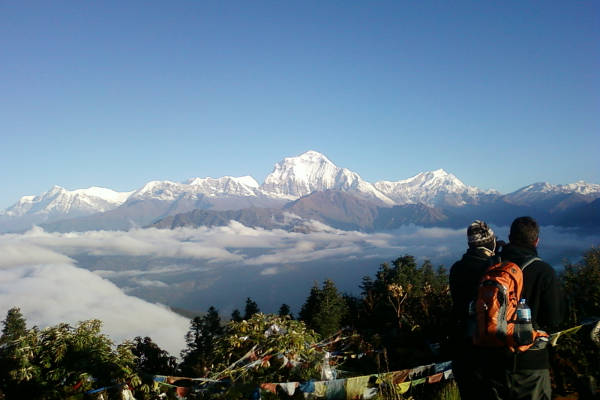
The Annapurna Sanctuary Trek is one of the most popular treks in Nepal after Everest Base Camp . Its climate varies from sub-tropical to Alpine, so there is a wondrous selection of flora and fauna, and you will come across many ethnic groups.
This trek is somewhat strenuous but requires no prior trekking experience. Most people take between 10 and 16 days to carry out this trek.
On this page, you will find a comprehensive and impartial guide to the Annapurna Sanctuary Trek.
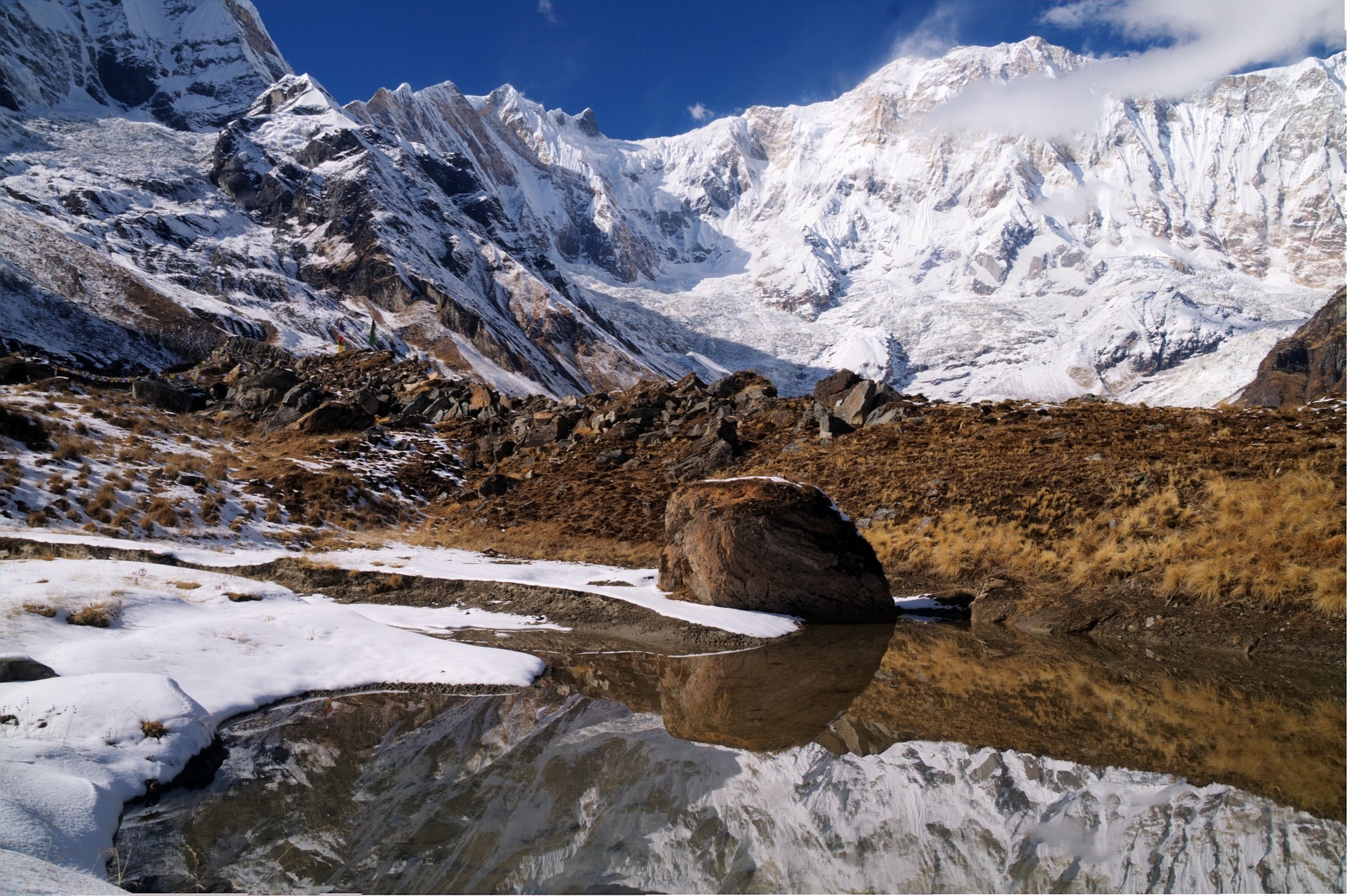
Annapurna Sanctuary Trek
The Annapurna Sanctuary Trek is the best option if you would like to get spectacularly close to the Himalayas but have no time for the acclimatisation required of other treks such as the Annapurna Circuit or the Dhaulagiri Circuit Trek . The highest altitude attained is 13,550 feet which, although still high, is lower than most treks in the region.
The Annapurna Himal is a huge massif with several peaks above 23,000 feet. A section of this range forms an amphitheatre by the name of the Annapurna Sanctuary, containing Annapurna I, Fang, Gangapurna, Glacier Dome, Hiunchuli and Machapuchhare. With so many surrounding mountains, sunlight is restricted to only 7 hours a day in summer.
At 26,545 feet, Annapurna I is the tenth highest mountain in the world. It was the first of more than 26,000 feet to ever be summitted – in June 1950 by a French party led by Maurice Herzog. Herzog’s classic account of his summit went by the title of Annapurna: The First Conquest of an 8000-Metre Peak – which we highly recommend.
The only entrance to the Sanctuary is a narrow pass between Hiunchuli and Machapuchhare. The sanctuary is regarded as the dwelling place of Shiva, the harvest goddess. It was not entered by outsiders until 1956, and only recently was the bringing of eggs or meat or the admission of women and Dalits – untouchables – permitted. The Annapurna Sanctuary Trek winds its way through the valley below the mountains. The route has been used by traders for centuries and you will share the trail with locals hefting bags of rice and crates of chickens.
Accommodation on the trek is usually in tea houses . The teahouses are almost always family-owned and are usually of good quality. Toilets are usually housed in an outside structure and will sometimes be squatters. “Flushing” is effected by means of a bucket of water. Hot showers are usually available at additional cost.
The Kali Gandaki river is one quarter of a mile wide and ensconced by the world’s deepest gorge. In winter, it is virtually dry but during the monsoon in summer it is gorged with rainwater. Fossils can be found on the banks of the river.
Please Note: The trails on the trek are generally good, however, they can often be fairly steep and the path through the forest when you approach the sanctuary can be slippery. It is possible to trek without a guide.
You will meet many other trekkers along the way. A map and guidebook ought to be sufficient (see below for recommendations).
Please remember to plan your day to avoid trekking after nightfall.
Annapurna Regional Map
The Sanctuary is located 29 miles due north of Pokhara, Nepal’s second city, 13,120 feet above sea level. See the map schematic below.
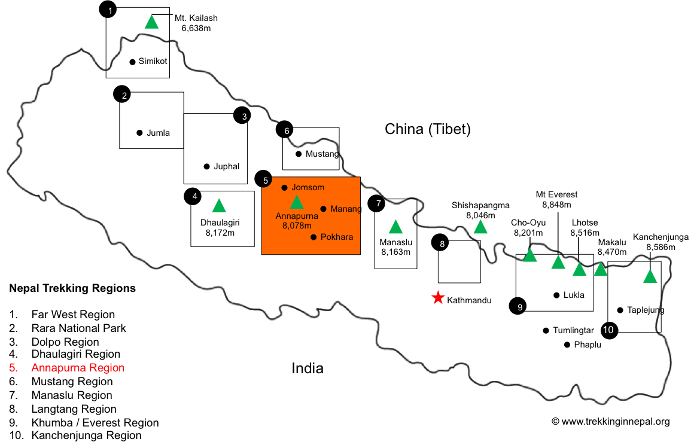
Recommended Annapurna Map
There are two maps for this region. We recommend Around Annapurna 1 : 125 000: Annapurna Conservation Area – Annapurna Sanctuary . It includes detailed trails, walking distances and altitudes.
We have also provided links and recommendations to new guides and maps below.
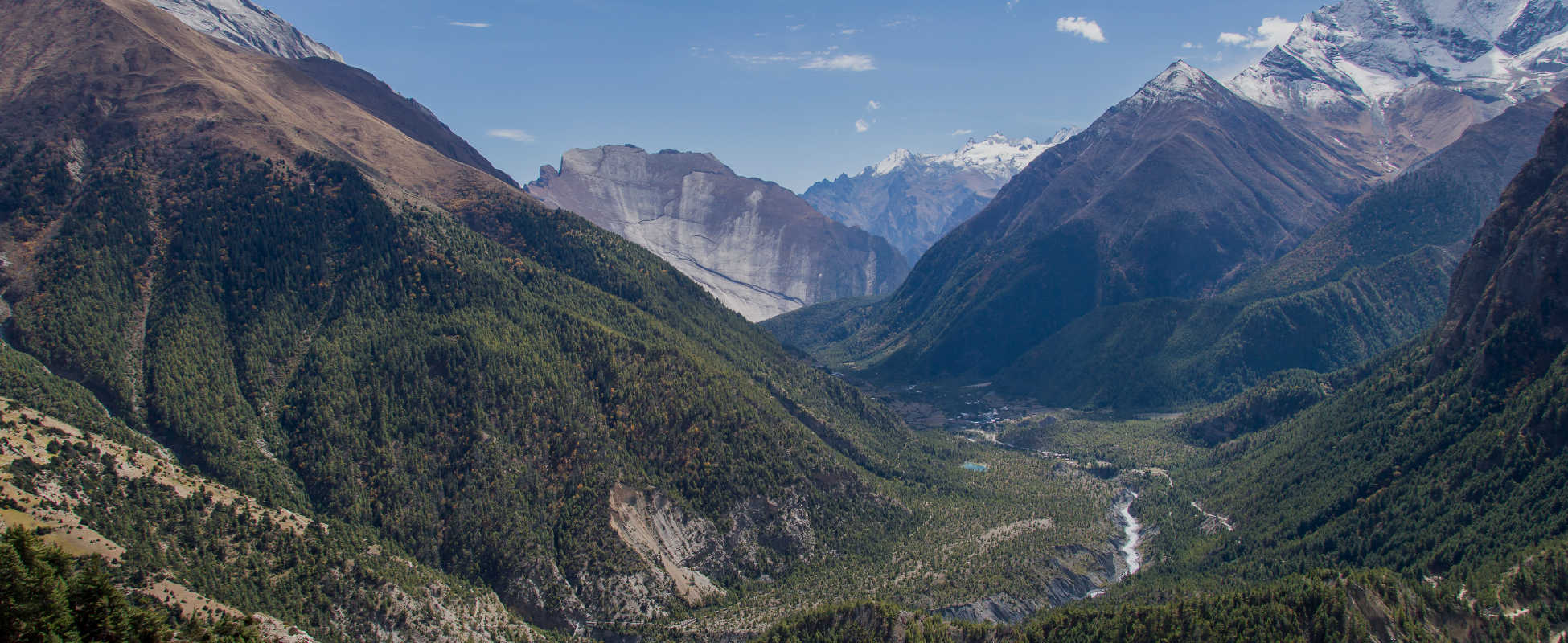
Typical Itinerary
Please be aware that there are several Annapurna Sanctuary trek itineraries that can be done. Below we have laid out the most popular version – 13 days, leaving from Kathmandu. If you want to make your own way to Pokhara then you could probably organise this with your operator or guide.
You will arrive at Tribhuwan International Airport in Kathmandu, where you stay overnight at a hotel. This is the 'City of a Thousand Temples', where every second day is a festival and there are several UNESCO World Heritage Sites.
See more in our guide on good things about Kathmandu .
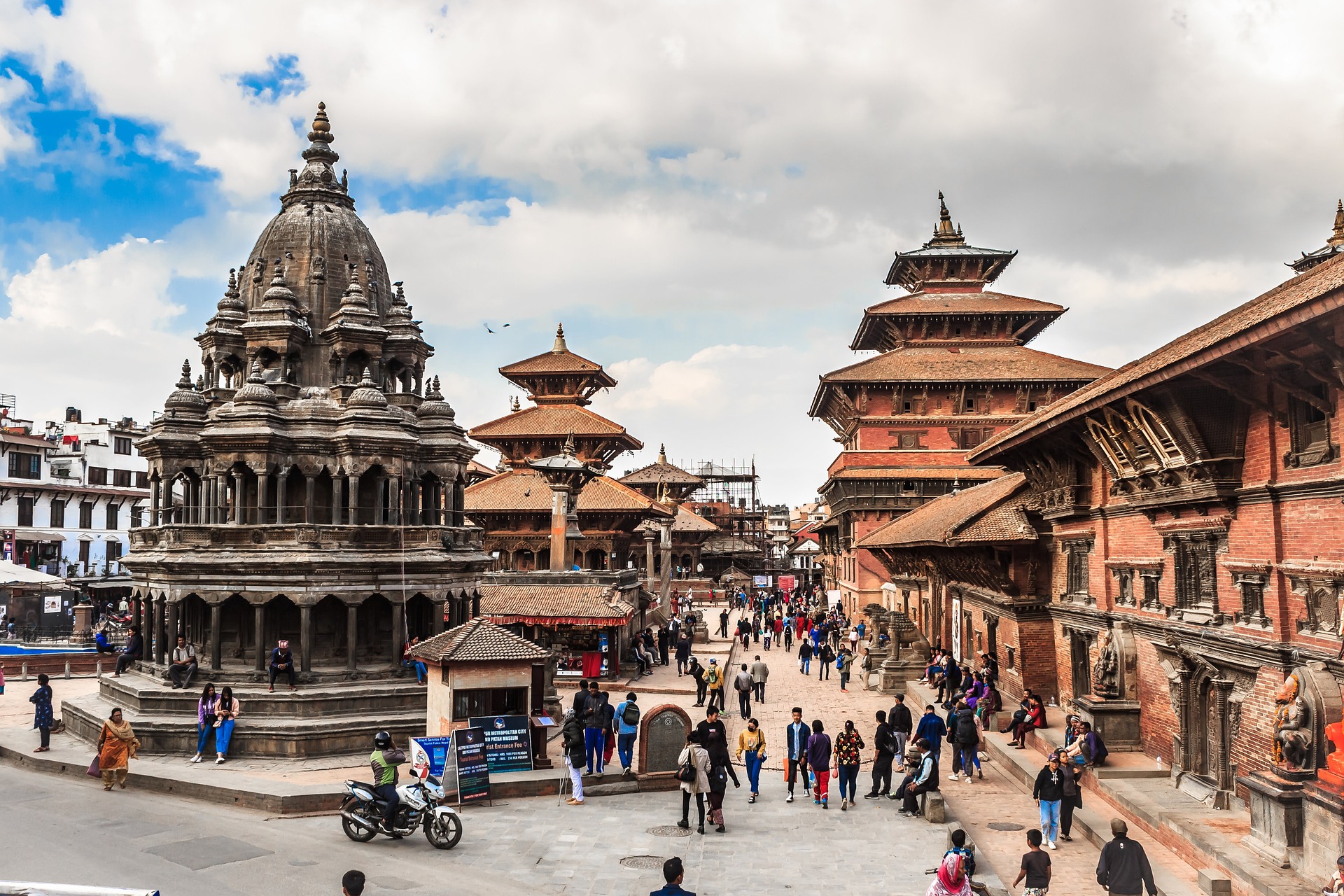
There is a 30-minute flight to the lakeside city of Pokhara , then a drive of less than an hour to Nayapul. You will start your trek here. In 15 minutes or so, you will reach Birethanti, a large village featuring many shops and tea houses. The trail goes along the north bank of the Bhurungdi Khola, climbing steadily until Hille is reached. At the end of a short climb is Tikhedhunga where you will stay for the night.
After Tikhedunga, there is a steep climb to the large village of Ulleri. The ascent then continues, but more gently. You will pass through forests of oak and rhododendron before reaching Banthani. You will then continue to Nangethanti. An hour after that, you will come to Ghorepani where you will stay for the night.
You will rise early this morning and hike to Poon Hill. Here you will be presented with the best possible view of the fabulous Annapurna and Dhaulagiri ranges. You will then return to the tea house for breakfast and walk to Tadapani.
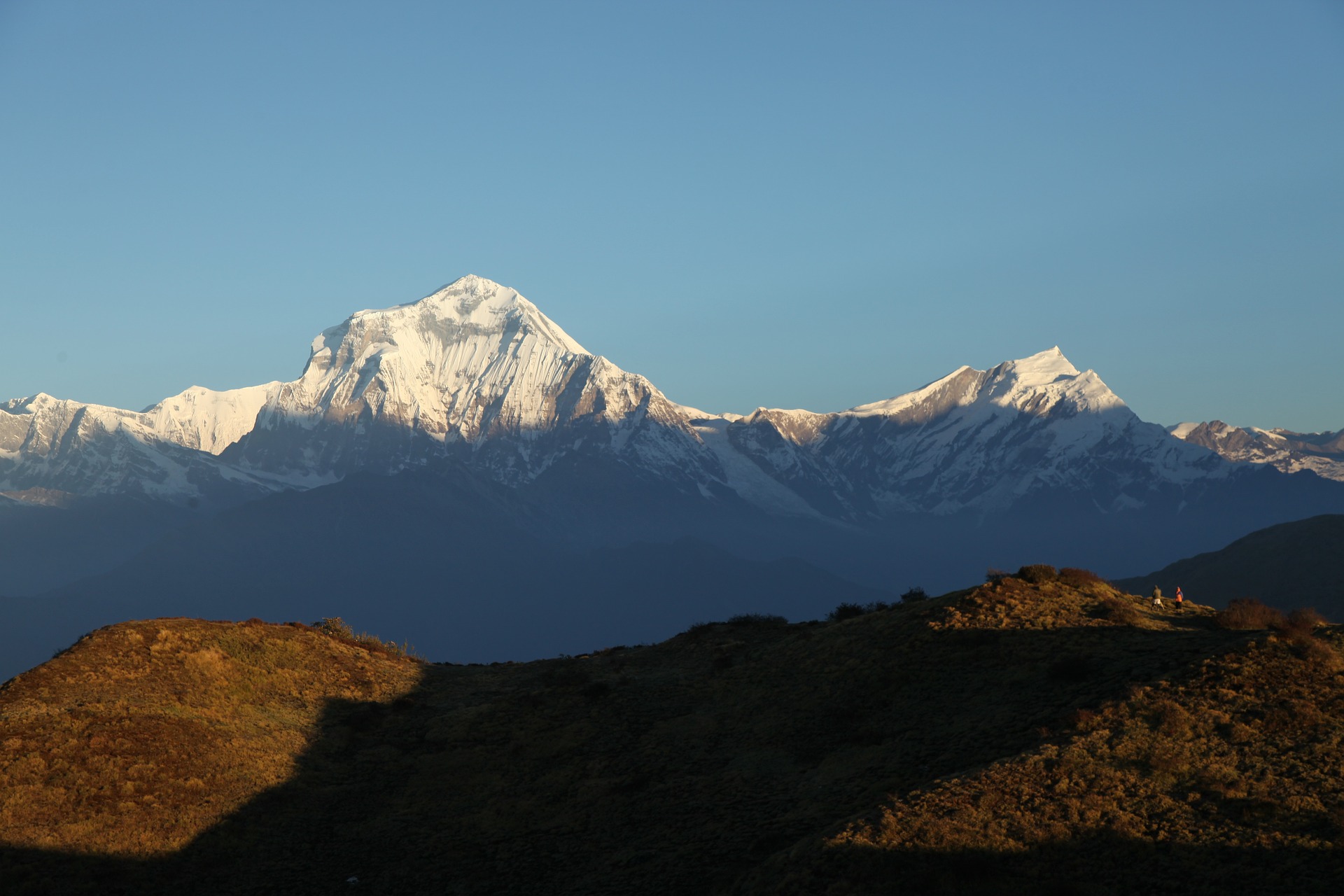
At first, the trail leads sharply downhill through forests but later it eases as you approach the village of Gurjung. The walk to Chhomorung is fairly easy. You will stay at Chhomorung for the night. There are many chalet-style, wooden lodges in Chomrong (2210m) which have great views out toward the prominent Machhapuchhre (Fish-Tail Peak). A brilliant place to end the day!
Day 7
The trail descends to Chhomorung Khola and then ascends to Khudighar where there is a checkpoint. In less than 2 hours of trekking, you will reach the village of Sinuwa where you will take a welcome break. From here, the trail continues to climb through terraced fields and then through forest of rhododendron and bamboo to the ridge crest at ‘Sinuwa Hill Top’ which you should reach after a further hour. You will stay the night at Bamboo.
You will begin the day by traversing the bamboo and rhododendron forests before arriving at Dovan where you will stop for lunch. You will stay the night at Hinko, or in particular, Deurali, which is on the ridge above.
This day, the trail rises on the way to Annapurna Base Camp. Here, the mountain scenery is at its most spectacular with towering mountains surrounding you.
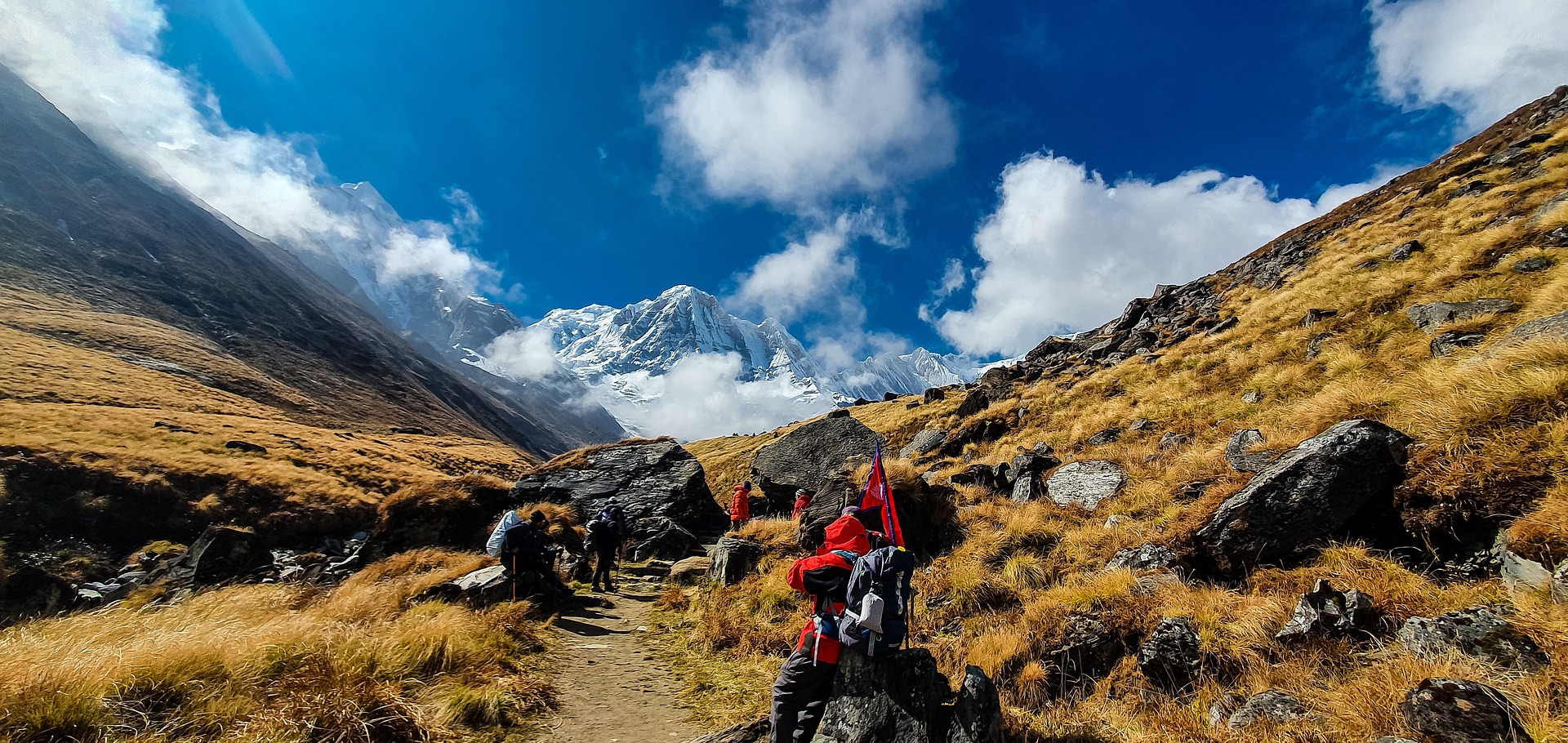
Now, it is time to explore the Hidden Valley before returning to Dovan. You will have the option to walk from your camp to Annapurna South Basecamp (4130m) which is a distance of only 4 kilometres. Along the walk, you will witness increasingly impressive mountain views and jaw-dropping scenery. At South Basecamp, you will be rewarded with views of the entire south face of Annapurna.
You will trek to Jhinu Danda, where there is a hot spring in which you will doubtless spend time in the evening.
Trekking now takes you in the direction of Pothana via Landruk. Look out for the waterfalls along the way. Today is a relatively easy trek with a fairly level 2-hour trail.
Two hours are spent walking downhill to Phedi, which is fairly easy. At Phedi, the road links to Pokhara, a half hour drive away.
You will return to Kathmandu.
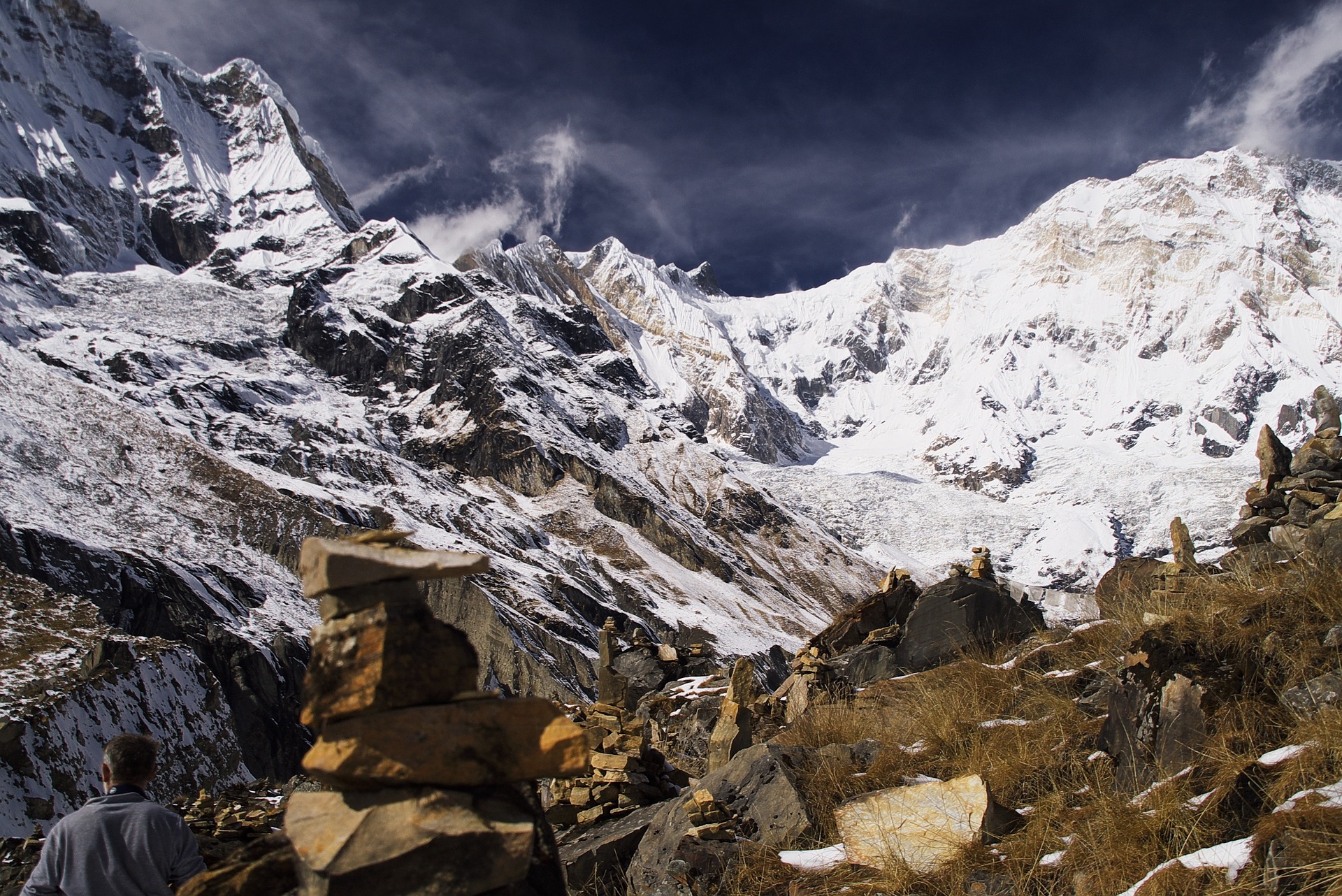
Annapurna Sanctuary Hike FAQ
How much does the annapurna sanctuary hiking cost.
The Annapurna Sancturary Trek costs anywhere between $2,000 and $3,500. Ideally, you should complete the trek using a top trekking agency in Nepal. However, you also have the cheaper option of completing the trek unsupported. which could be done for as little as $1,000.
Are permits required for hiking in the Annapurna Sanctuary?
Yes, both an Annapurna Conservation Area Project permit and Trekker Information Management System (TIMS for short) registration are required for the Annapurna Sanctuary trek.
If you are part of an organised tour group, these will be arranged for you, but if you are trekking unsupported, you will have to bring four passport-sized photographs and go to the offices of the Nepal Tourism Board in Kathmandu to apply for permits.
We recommend bringing copies of your passport and insurance policy. The offices follow government working hours and days and are not open on Sundays.
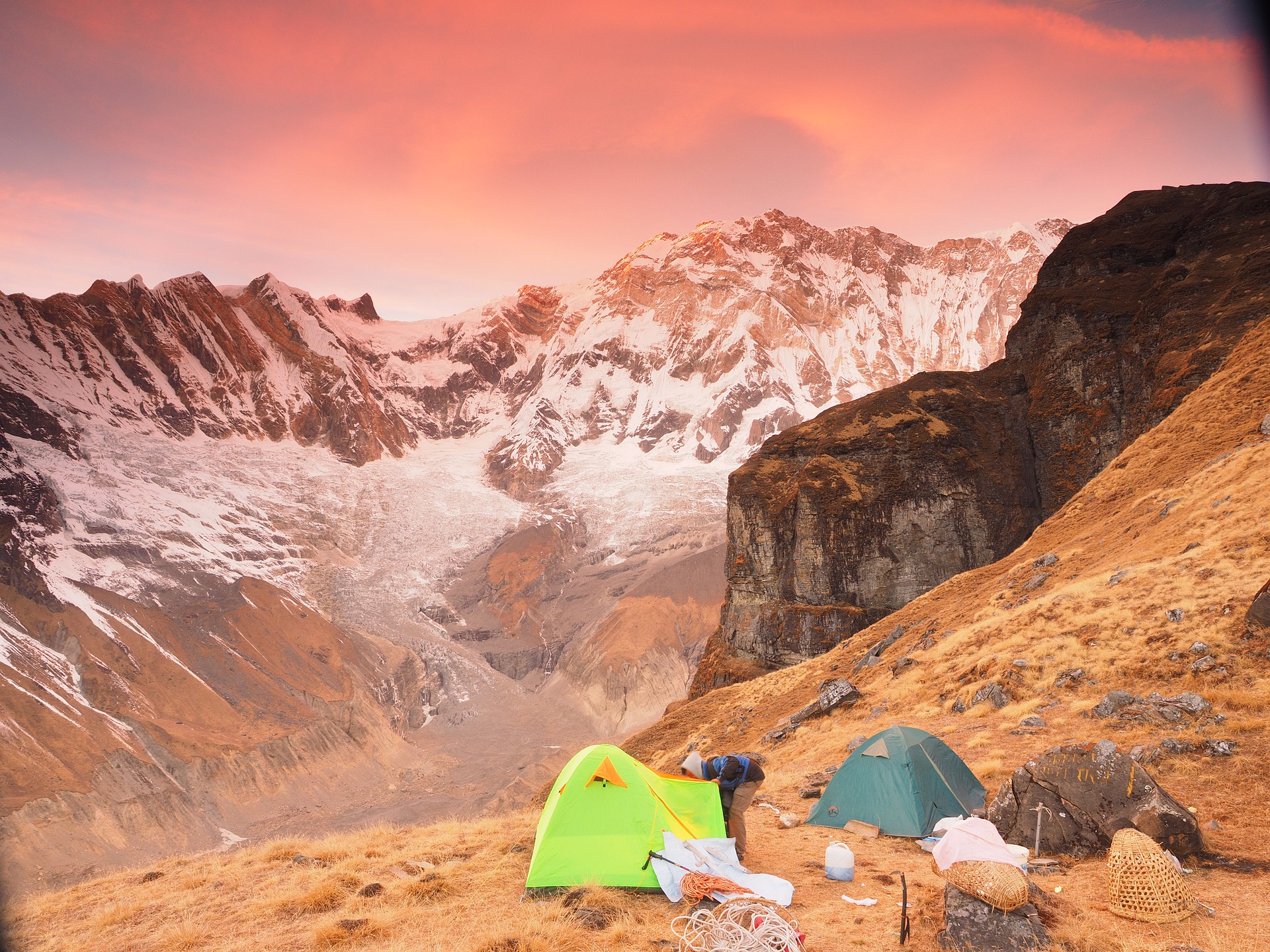
When is the best time to trek in the Annapurna Sanctuary?
The best time to trek Annapurna Sanctuary is from September to May. June, July and August are the monsoon months.
In spring, forests erupt with white, red and pink rhododendron flowers.
September-November is generally the best time of year for trekking in Nepal . This is when there are few clouds and clear views.
There is less than half an inch of precipitation in November, but temperatures can get very cold in the Winter (Nov-Feb).
Is altitude sickness a risk on the Annapurna Sanctuary hike?
Yes, altitude sickness is a risk on the Annapurna Sanctuary Trek because it ascends to some high-altitude points. At its highest point, the Annapurna Base Camp, you will reach an altitude of 4,130 meters (13,550 feet). Fortunately, because of the trek's length, the opportunities for appropriate acclimatisation are good, and hence the prevalence of moderate or severe altitude sickness is low.
Even so, it is important to have a clear understanding of the risks associated with high altitude trekking and how the body acclimatises to high altitude. We recommend you read our detailed article on Altitude Sickness and Acclimatisation .
How difficult is the Annapurna Sanctuary hike?
The Annapurna Sanctuary hike is of moderate difficulty. You will be trekking for 4-7 hours a day for over a week, so you will need to be relatively fit. The best way to prepare is to get as many miles under foot as possible on trails in your home country.
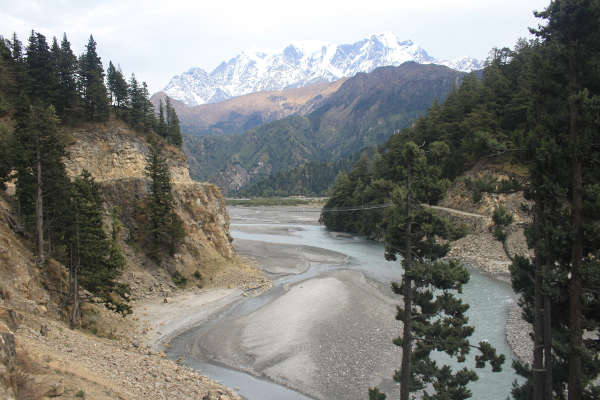
What gear do I need for the Annapurna Sanctuary trek?
You need a number of essential pieces of gear for the Annapurna Sanctuary trek. The Annapurna Sanctuary Trek is long and moderately difficult, exposing you to a range of altitudes where temperatures fluctuate dramatically between night and day.
Much of your gear can be rented or bought in Kathmandu or Pokhara, but we strongly suggest bringing the most important pieces of equipment with you. To help you plan and prepare for your trek, we recommend reading our general hiking gear list or our Annapurna Circuit packing guide .
What trekking insurance do I need for Annapurna Sanctuary?
Trekking insurance is very important in Nepal. This is particularly true on the Annapurna Sanctuary Trek which is very remote.
If an accident or incident should occur that requires immediate medical assistance and evacuation, you will most definitely want adequate trekking insurance that can cover the costs of air ambulance and treatment.
Make sure you have insurance that covers you for any travel related risks, like lost, stolen, damaged or delayed baggage; interruptions and flight delays and tour operators default.
Please read our article on Travel insurance for hiking in Nepal for more information.
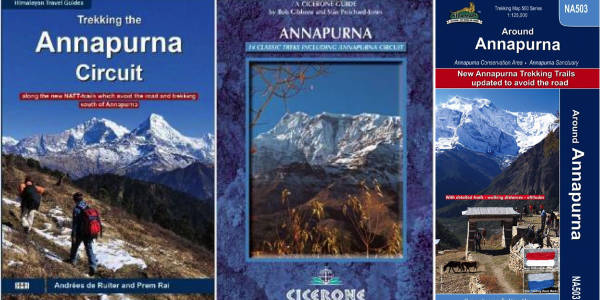
Are there any recommended guidebooks and maps for the Annapurna Sanctuary trek?
Yes, there are a few guidebooks that we recommend for the Annapurna Sanctuary trek.
Books dedicated to the Annapurna Sanctuary Trek are Trekking the Annapurna Circuit and Annapurna Sanctuary in the Nepal Himalaya by Ian P Johnson and Annapurna Sanctuary and Circuit by Alonzo Lucius Lyons.
In terms of a single detailed map, we recommend the Himalayan MapHouse’s New Annapurna Trekking Trails Map , which can be bought in Kathmandu, Pokhara or on Amazon UK (unfortunately it is not on Amazon US yet).
You are also welcome to have a look at our recommended list of Nepal books and guidebooks library for more options.
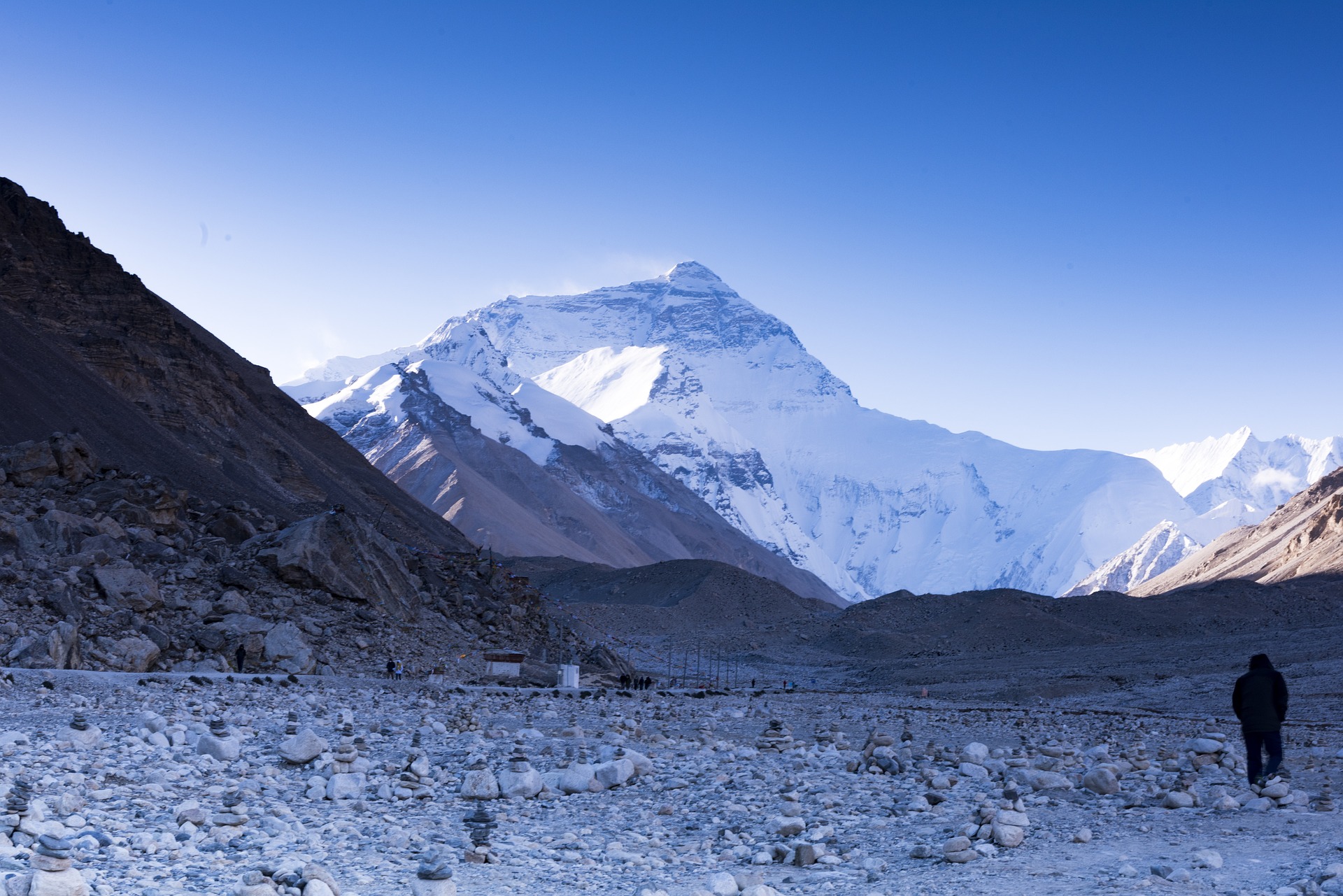
Continue browsing
See more information on Nepal . Or check out these other Annapurna hiking articles:
- Annapurna Base Camp Trek
- Cost of Annapurna Circuit
- Annapurna Weather Guide
- Ghorepani Poon Hill Trek
- Panchase Hiking Guide
- Jomson Muktinath Trails
- Highest Mountains in the World
- Best Thru Hikes
- Best Treks in the World
About the author
Mark Whitman
Mark has trekked extensively in Asia, Europe, South America and Africa. He founded Mountain IQ in 2014 with the sole aim to be the best online information portal to some of the most popular mountain destinations around the world. When not writing for Mountain IQ, Mark is out exploring the outdoors with his wife!
Leave a Reply
Your email address will not be published. Required fields are marked
We work with local guides to offer great value adventures at unbeatable prices
I'm hiking Nepal for 3 weeks, do I trek Everest Base Camp or Annapurna Circuit?

Feb 22, 2024 • 3 min read
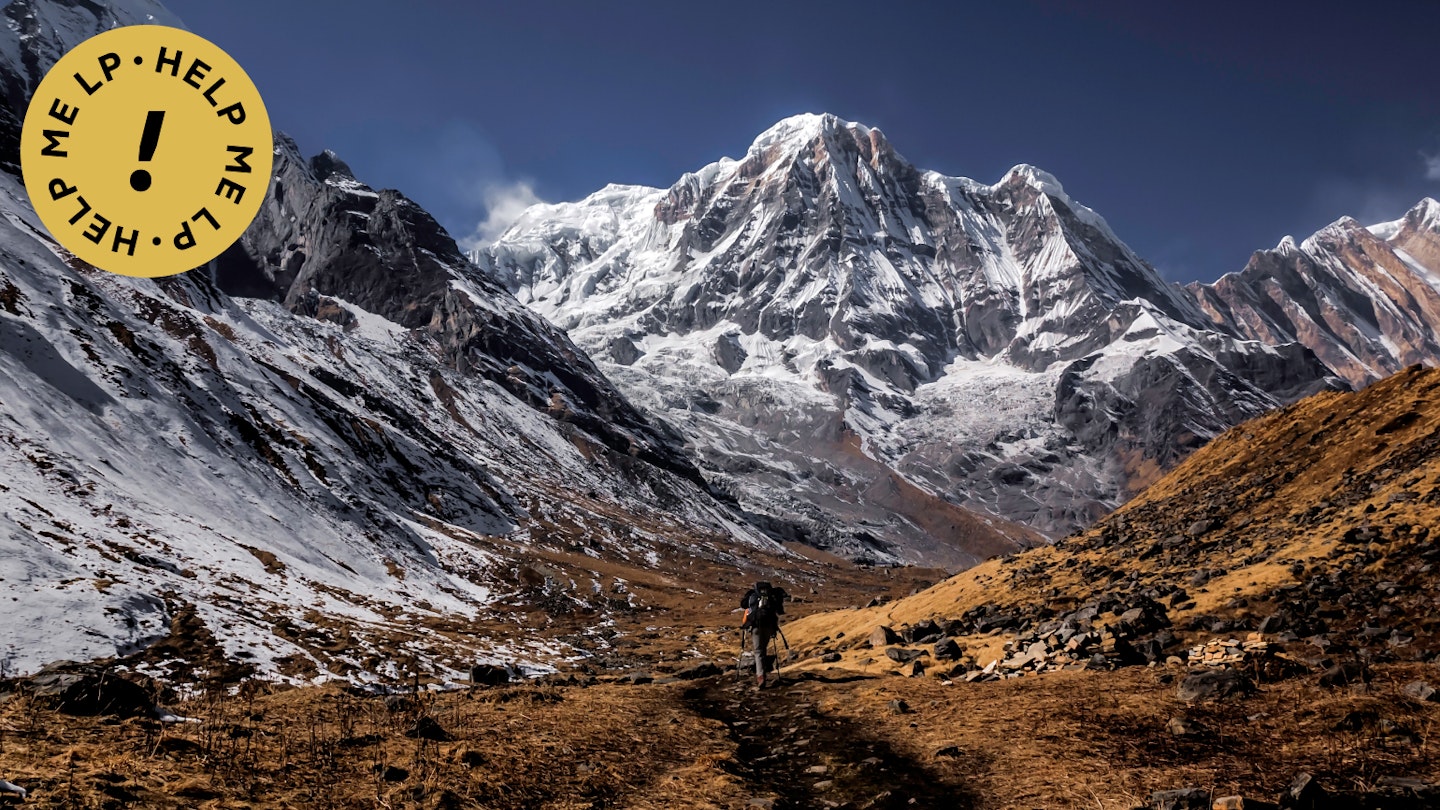
We can help you choose between the Everest Base Camp and Annapurna Circuit treks in Nepal © Russ Nordstrand / 500px
Himalayas specialist Bradley Mayhew, who writes our guidebooks to Nepal, Bhutan and Tibet, answers a question about trekking routes in Nepal.
Question: I have three weeks planned for trekking in Nepal and I can’t decide between the Everest Base Camp and Annapurna Circuit treks. Can you help?
Answer: Ah, so many trails in Nepal, so little time…
Firstly, the Annapurna Circuit and Everest Base Camp treks have some things in common. Both offer excellent lodging in hundreds of trailside teahouses and an infrastructure of shops, bakeries, wi-fi and guides that makes for easy logistics. Both have world-class mountain scenery in valleys flanked by some of the world’s highest peaks, both require acclimatization to altitudes of over 5400m (17,717ft) and both are packed with trekkers in the high season months of October, November and April.
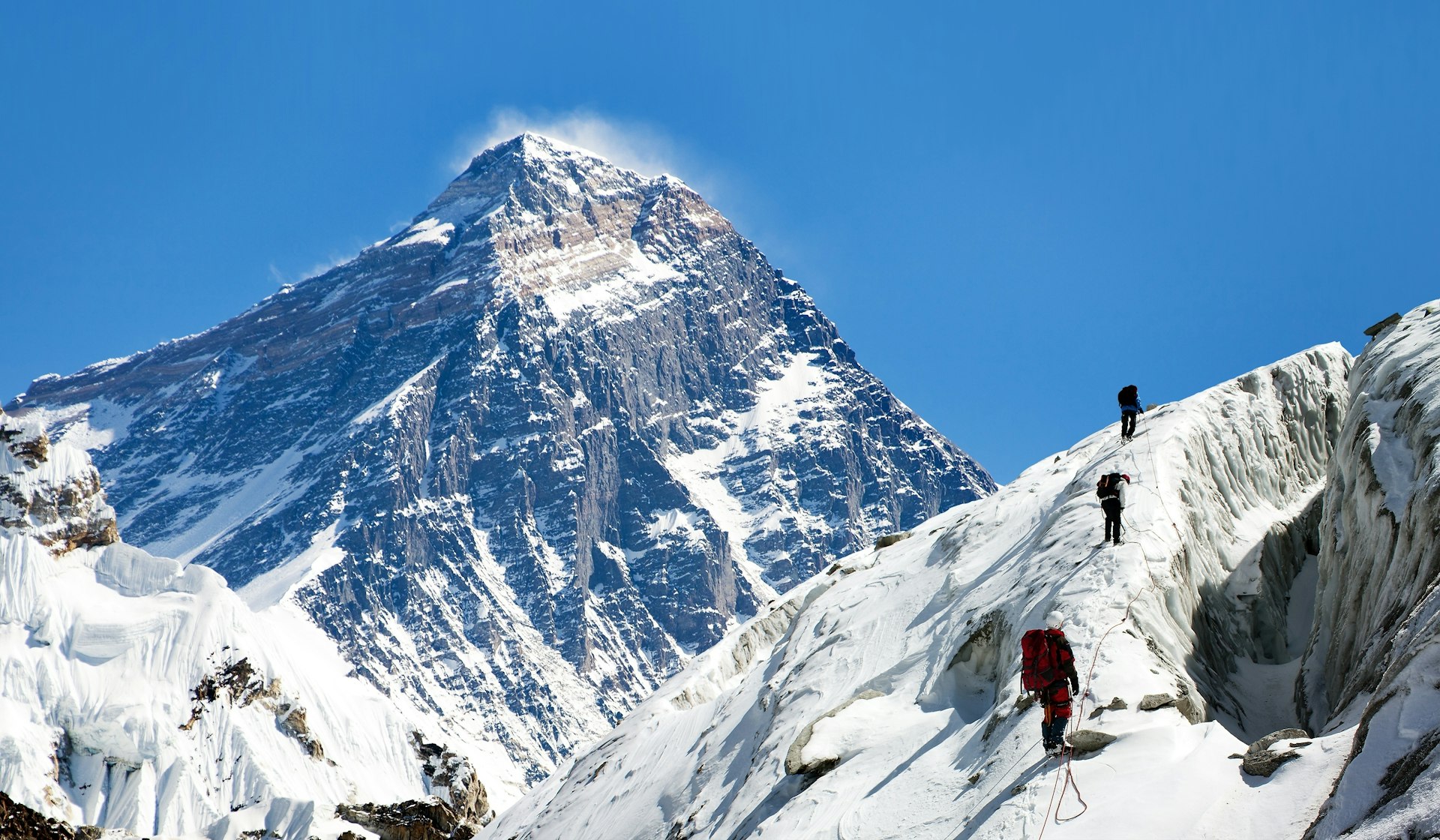
Everest is iconic, but more costly and complicated to reach
There are also differences between the two treks. Everest is a bit more complicated and expensive to reach. Most people fly to the trailhead Lukla and start the trek straight off the runway, which is convenient but expensive (US$430 return) and can present challenges when bad weather grounds flights for days at a time. (Be aware also that during high season flights to Lukla often depart from Ramechhap, not Kathmandu , which adds on a five-hour drive.) The only alternative to flying is a long, punishing ride in shared jeeps, or a weeklong walk (my preferred option, if you have the time).
You need a minimum of two weeks to trek to Base Camp and back, and I would strongly recommend adding up to a week to investigate the quieter but equally stunning side valley of Gokyo. In contrast, the core Annapurna Circuit section to Jomsom can be done in as little as nine days.
Everest has the irresistible lure of the world’s highest peak but you actually don’t see much of it; far more interesting is the climbing literature and the fact that you are walking in the footsteps of the world’s great climbers. The Everest trek gets you closer to the heart of the high mountains than the Circuit, which offers more in the way of traditional village life. Finally, Everest Base Camp is an out-and-back trek, so you’ll repeat some sections, whereas Annapurna is by its nature an A to B loop.

Annapurna's trails are often roadside, but offer greater flexibility
The Annapurna region is a lot more accessible; in fact you can be walking the trails in less than an hour by bus from Pokhara town. The big downside with the Annapurna Circuit (and it’s a big downside) is road construction. A jeep road now reaches as far as Manang on the eastern side, and Muktinath on the western side, which leaves only three days of roadless walking between them. The roads have taken a lot of the charm away from the circuit, so if you do decide to walk it I’d really urge you to read up on the alternative NATT trails that lead you away from most of the dusty road. During the second half of the trek in the Kali Gandaki Valley these side trails and excursions make for some stunning day walks, returning to roadside teahouses. It’s a different kind of walking, but it gives you great flexibility, meaning you can adjust your Annapurna Circuit trek to anywhere between a week and 21 days.
So, which is better?
Both trails offer a fabulous taste of Nepal trekking, but both are busy in high season and reward a bit of research into the excellent alternative trails and side trips which, for me, make these treks stand out. If avoiding the crowds is important to you, consider something different completely: the wonderful Manaslu Circuit teahouse trek, or an adventurous rough-and-ready trek out to the base of Kangchenjunga in the far east. Whatever you choose, your first trek in Nepal will almost certainly not be your last.
Explore related stories
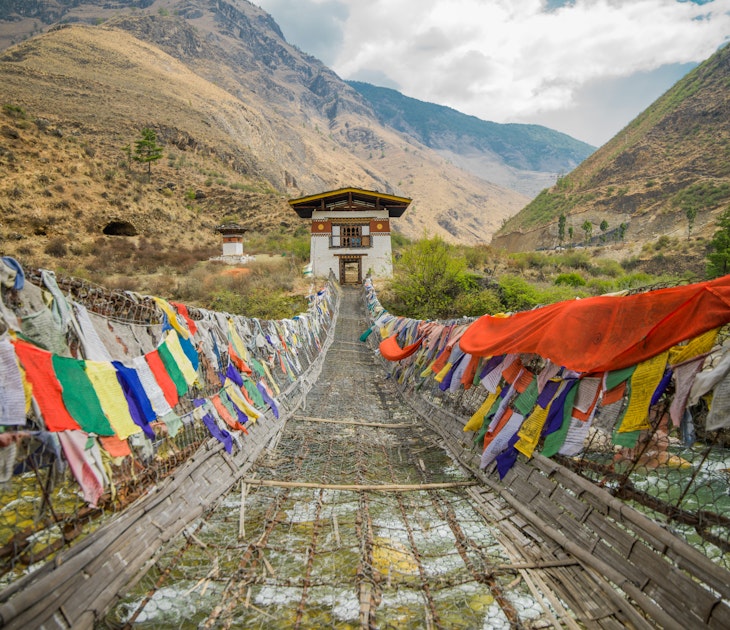
Aug 31, 2023 • 11 min read
When Bhutan reopened after the pandemic, the government raised tourist fees dramatically. Now they are coming back down. Here’s what you need to know.
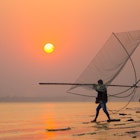
Oct 10, 2019 • 9 min read
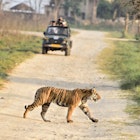
Apr 16, 2024 • 13 min read

Jan 11, 2024 • 4 min read
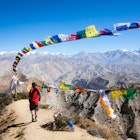
Dec 23, 2023 • 7 min read
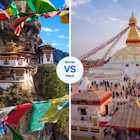
Dec 20, 2023 • 7 min read

Dec 16, 2023 • 12 min read

Oct 15, 2023 • 3 min read
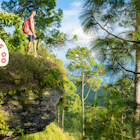
Sep 18, 2023 • 7 min read
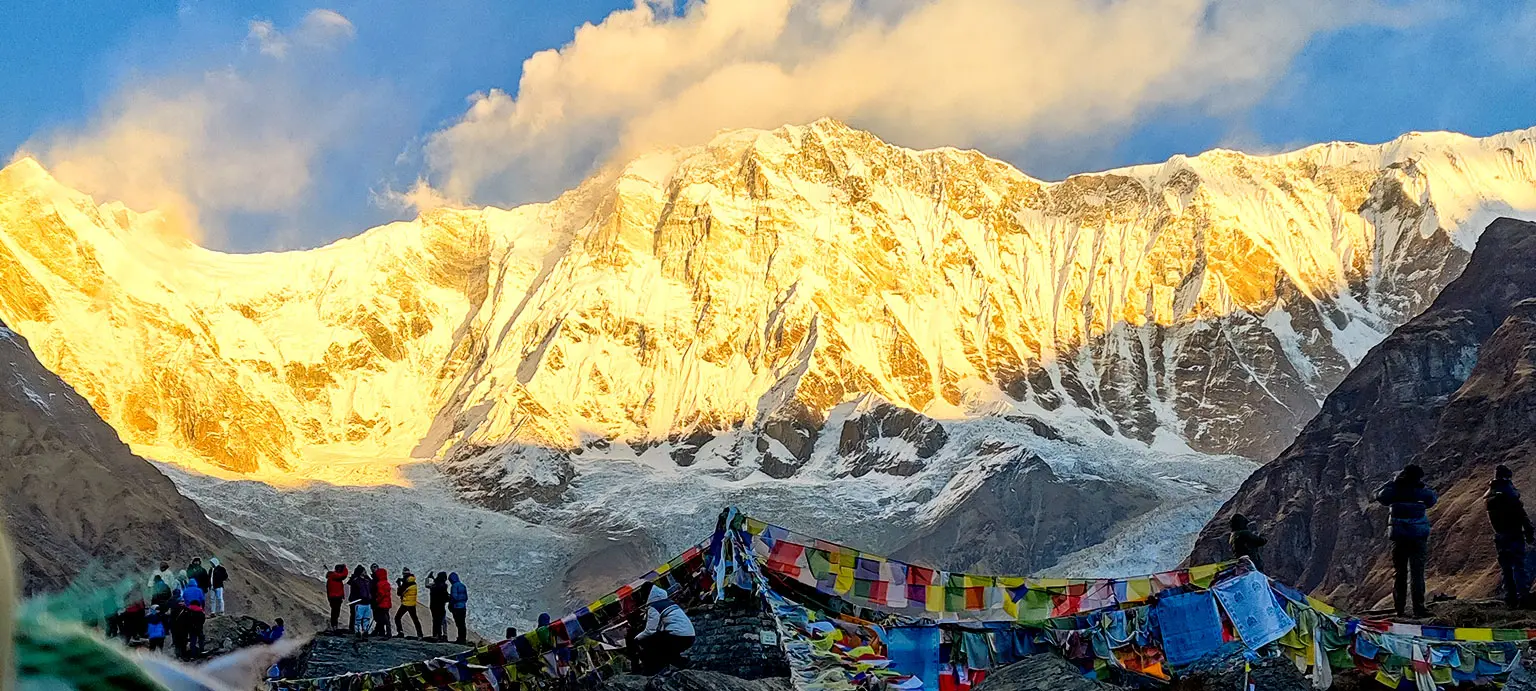
Annapurna Base Camp Trek
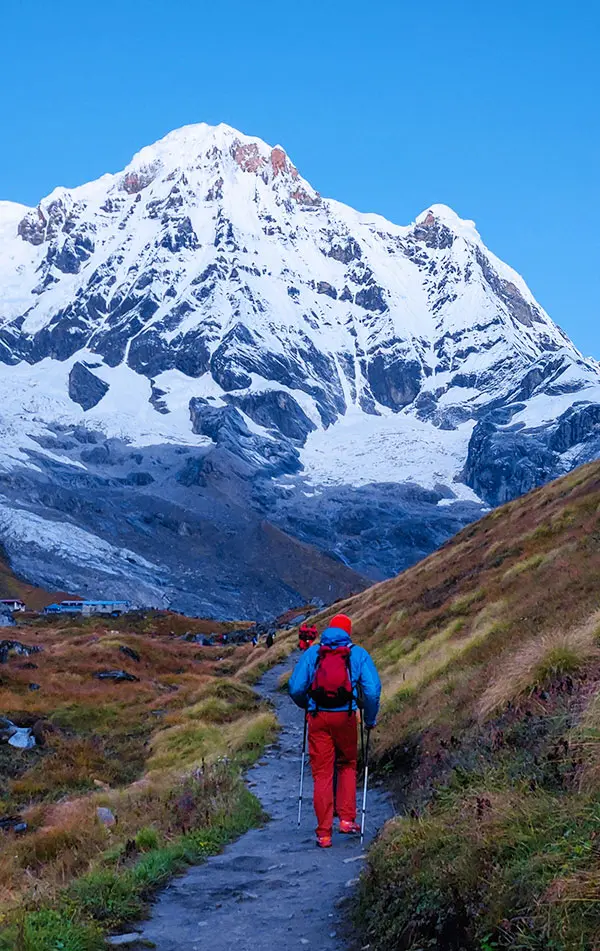
Pokhara | Nepal
Max Altitude
Trekking Km
Moderate to Difficult
Help & Support
30000 /person $ /person.
- September-2024
- October-2024
- November-2024
- +5% GST (goods and services tax)
- USD 480 for Non-Indian, +5% GST
- Services Pokhara to Pokhara
- Stay in Pokhara, Transportation and Food is included
Insurance 2000
Insurance is Mandatory.
Non-Indian rates are slightly higher. Trek coordinator will provide balance payment link post-booking.
- Get insurance through us or elsewhere. If not through us, email for a refund after booking.
The cancellation policy will be implemented in accordance with the trek cancellation policy.
For more information. Please complete this form.
Help & Support
Trek Name: Annapurna Base Camp Trek
Adventure Type: Trekking
Base Camp: Pokhara
Season: Spring | Summer | Autumn |
Month: March | April | May | September | October | November |
Country: Nepal
Altitude: 13550 Ft.
Grade: Moderate to Difficult
Rail Head: -
Stay: Hotel & Teahouse
Food: Meals while on trek & at Hotel/Guesthouse (Veg & Eggs)
Location: Pokhara
Distance: 70 Km.
Trail Type: Point to point trail | Camping at the same location upon returning.
AirPort: Pokhara International Airport
Why Annapurna Base Camp Trek is a must do trek
Panoramic Vistas:
- The trek unfolds a mesmerizing panorama of the Annapurna Massif, including Annapurna I (8,091m), Machapuchare (6,993m), and Hiunchuli (6,441m).
- Spectacular sunrise and sunset views over the snow-capped peaks create a magical atmosphere.
Diverse Landscapes:
- Traverse through diverse landscapes, from lush rhododendron forests and terraced fields to alpine meadows, providing a kaleidoscope of natural beauty.
- The trek offers a unique blend of subtropical climate in the lower regions and an alpine environment at higher elevations.
Cultural Encounters:
- Engage with the rich cultural tapestry of the region by interacting with the friendly Gurung and Magar communities.
- Visit traditional villages along the way, immersing yourself in the local customs, rituals, and hospitality.
Natural Hot Springs:
- Soothe your tired muscles in the natural hot springs at Jhinu Danda, a refreshing break on the trek.
- Enjoy the therapeutic benefits of the geothermal waters while surrounded by the beauty of the Annapurna region.
Charming Teahouses:
- Experience the unique hospitality of Nepalese teahouses, offering a cozy and warm atmosphere after a day of trekking.
- Interact with fellow trekkers from around the world, fostering a sense of camaraderie.
Flora and Fauna:
- Encounter a diverse range of flora and fauna, from colorful rhododendron blooms in spring to elusive Himalayan wildlife such as the Himalayan tahr and pika.
- The trek provides a unique opportunity for nature lovers and wildlife enthusiasts to witness the biodiversity of the Annapurna Conservation Area.
Challenging Yet Accessible:
- Ideal for both novice and experienced trekkers, the ABC Trek offers a moderate level of difficulty, making it accessible to a wide range of adventure enthusiasts.
- The sense of accomplishment upon reaching the base camp is a reward that transcends the physical challenges.
When we talk about the Annapurna Base Camp , there is a sense of admiration that starts building up which leaves every trekker spellbound. There are very few treks that have this aura of making you fall in love with the landscapes and bring you closer to the base of 7,000 and 8,000-meter peaks in such a short period. The Annapurna Base Camp Trek is one of the most popular treks in the Annapurna region. The trail is a majestic one that takes you through rice paddies, lush rhododendron forests, and high-altitude landscapes with the Annapurna Range looming in front of you most of the time.
The Annapurna range has such stunning mountain views which are a buffet for every mountain lover. You will also be greeted with views of Machapuchare, Annapurna South, and Hiunchuli even before you set foot on the trek, which is one thing that is surely a bonus for all the trekkers. Views of different peaks of the Annapurna massif and Machapuchare will always be in sight of Sinuwa.
Accommodation on the Annapurna trail is organized in classic teahouses where delicious Nepali dishes are served. These tea houses are run by locals of the area who migrate from other parts of Nepal. The Annapurna Base Camp Trek is also known as the Annapurna Sanctuary Trek because you trek along the protected areas trail. A lot of floral and faunal species are also found in this area which will surely amaze you with the beauty it has to offer. From a height of 4,000 meters, you'll be able to see the entire sanctuary which is oval-shaped and surrounded by a ring of the Annapurna Mountains.
The starting point of the Annapurna Base Camp Trek is the beautiful city of Pokhara, which lies just 5 to 6 hours away from the capital. You can reach Pokhara city from Kathmandu via road or plane as well. The easy accessibility of the trek makes it an ideal choice for many trekkers as the chances of any flight cancellations or delays are greatly reduced. The trekking journey is also massively feasible with good communication services and safety. Annapurna Base Camp is a real trekking experience for all trekking enthusiasts.
- Who can Participate
- Important Links
- How to Reach
- Trek Essential
Who Can Participate
Age; 12 years +.
First timers can apply; previous trekking experience is more appreciated.
The climber must be fit and have sufficient stamina to cover 5 km of distance in 30 minutes without stress.
The climber should be able to carry a 10-15 kg backpack.
Pulse rate at rest must be in between (60 to 90 beats per minute)
Blood Pressure Reading must be in between (DIASTOLIC 70 – 90, SYSTOLIC 100 - 140 mm Hg)
Respiratory rate at rest must be in between (12 to 20 breaths per minute)
Should not have Liver and kidney issues
Should not have Diabetes Mellitus, Bronchial Asthma, Heart problems, Hypertension etc
No pacemaker implant
People with the Sinus issues, Epilepsy please contact to trek coordinator before booking the trek
If your BMI is not normal, Please contact our Trek coordinator before Trek booking.
Medical & Disclaimer Form (Mandatory Documents) Click here to download Medical & Disclaimer Form
- Government Employees can avail the benefit of Special Casual Leave (SCL) when you join us for a trekking expedition. As per the rules of the Pay Commission, Special Casual Leave can be availed for up to 30 days in a calendar year for trekking/mountaineering expeditions through a registered organization. Trek The Himalayas is a registered adventure tour operator by Indian Mountaineering Foundation (IMF) and Ministry Of Tourism (MOT)
- Trekkers have to apply for leave at least 20 days before trek departure date,
- This service is exclusive to Indian government employees and is applicable only for treks within India.
- Do mail at info@trekthehimalayas to apply and mention your booked trek date and trek name.
Junior trekkers (below 15 years) should have a company of parents/guardians.
Trekkers between 15 to 18 years can come solo with the disclaimer form signed by parent/guardian.
- Medical & Disclaimer Form (Mandatory Documents) Click here to download Medical & Disclaimer Form
Exercise For Moderate to Difficult
Fitness Regime For:
Calculate Your Bmi
Your BMI value is
Congratulations, your body is in good conditions!
Arrival in Pokhara
- Altitude: 2,600 ft.
- Stay: in the hotel (check-in at 12 noon).
- Briefing about the trek in the evening.
- Sightseeing: Phewa Lake, Tal Barahi Temple, Himalayan Views, International Mountain Museum (not included in the cost).
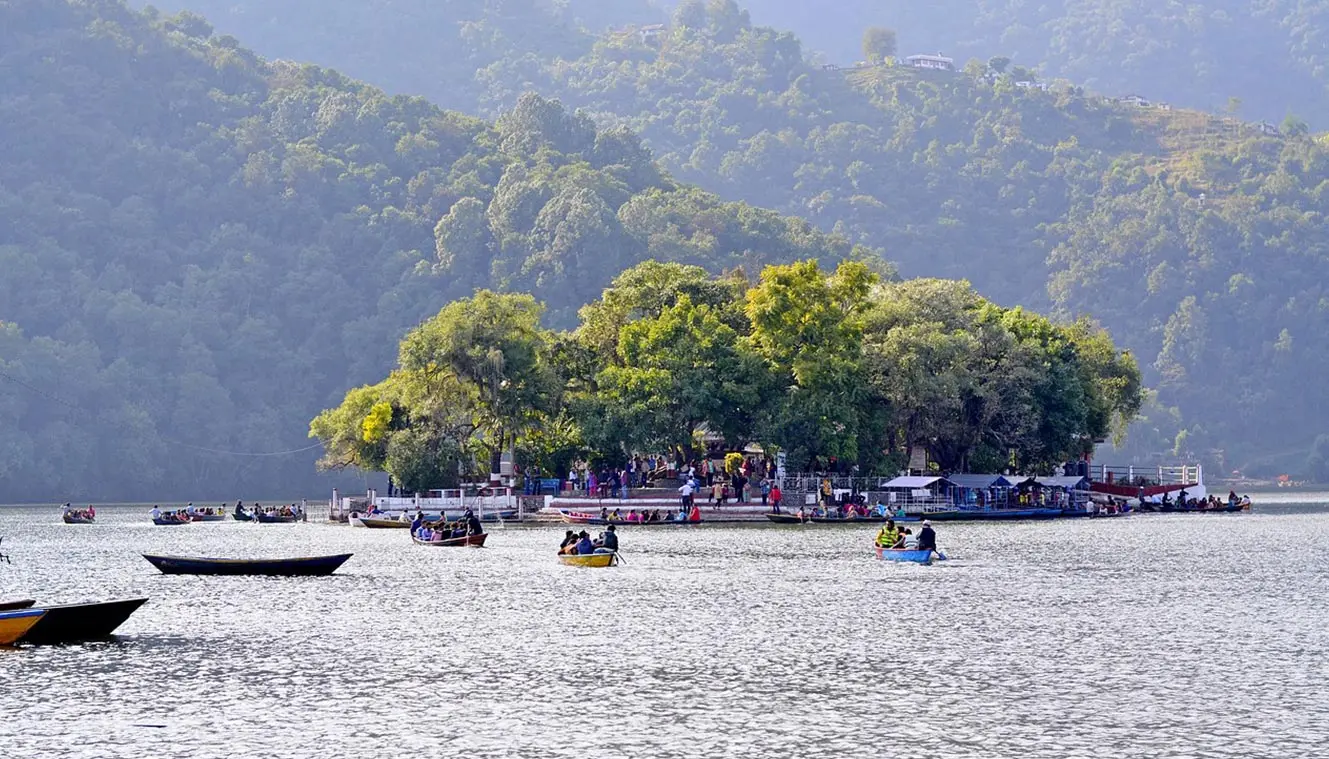
After a pleasant flight journey, arrive in Pokhara. It is the hub of mountaineers that lies on Phewa lake. All the big expeditions and trekking start from here. Snow-capped peaks surround the locality and you can see stunning views of the Annapurna Ranges. Enjoy the Himalayan views, rice fields, and Nepalese culture around. If you didn’t know, Pokhara used to be a trade route between India and Tibet some 300 years ago. You may also spot paragliders soaring above the city. The tranquil setting of Pokhara gives you a wonderful opportunity to reconnect with nature.
In the evening you can go sightseeing around the local attractions in Pokhara like the Phewa Lake, Tal Barahi Temple, and International Mountain Museum. You will also receive a briefing from our team regarding the schedule of upcoming and everything entailed in the trek. Your trekking day starts tomorrow and it's a long journey ahead so rest well so that you are fresh and energized for tomorrow.
Pokhara to Sauli Bazar (Drive) and trek to Ghandruk
- Altitude Ghandruk: 2,000m/6,500ft.
- Altitude Sauli Bazar: 1,150m/3,800ft.
- Pick-up time: 7:00 am.
- Drive to Sauli Bazar: 40km | Drive Duration: around 2 hrs.
- Trek 5km | Duration 4-5 hrs.
- Gradual ascend throughout.
- Water source: Villages and teahouses on the route.
- Views: Machapuchhare and Annapurna (South), Hinchuli, Gangapurna, and Annapurna - 3.
- Visit Old Gurung Museum in the evening.
- Lunch on the way.
- Stay: at teahouses.
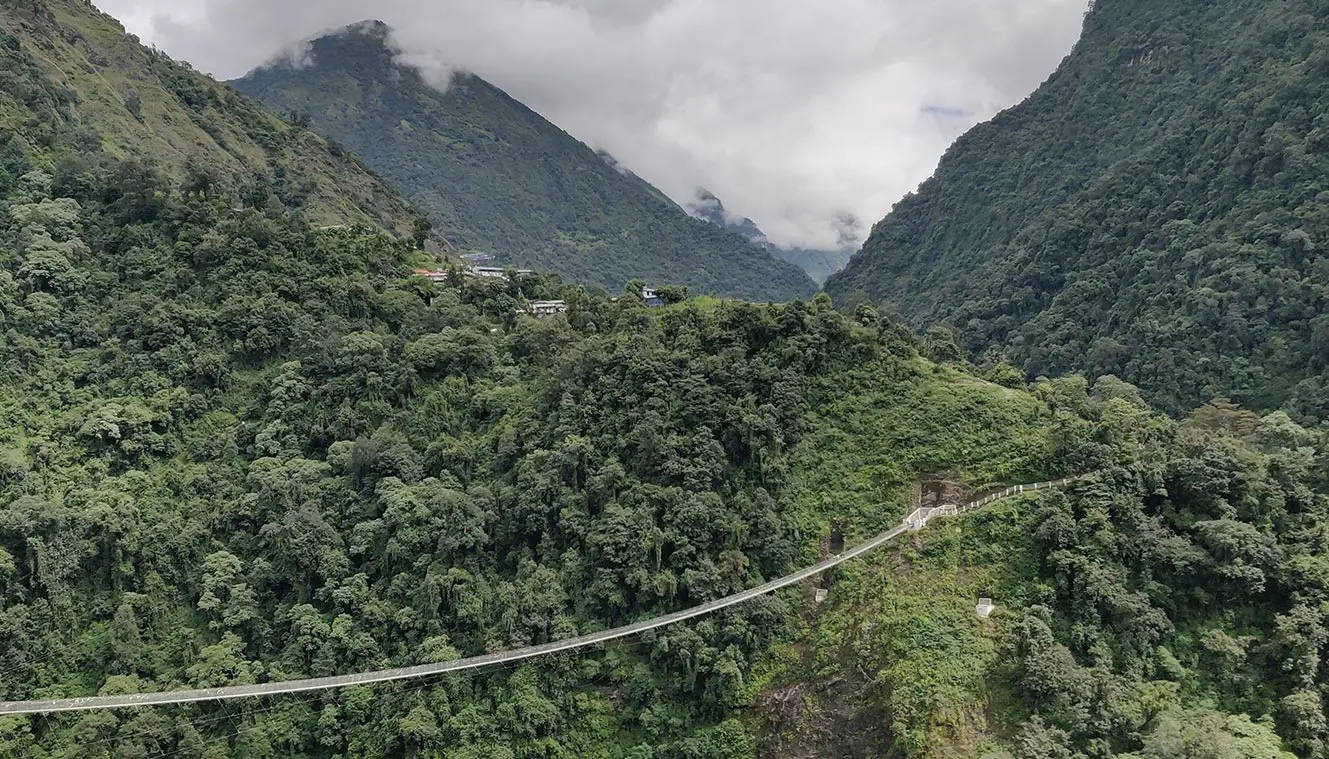
After breakfast, you will have a ride of approximately 2 hrs to Sauli Bazar. The actual trekking begins henceforth to Ghandruk crossing Lower Ghandruk. The path is well paved having stairs intermittently. The trek has a gradual ascent taking 5-6 hours to reach our camping site. Once you cross the bridge over the Bhurgundi River on your way to Ghandruk, you will arrive at Birethanti where you are required to sign documents as part of formalities with the local authorities for the Annapurna Base Camp Trekking. Post this the trek begins to ascend towards Ghandruk.
From here, you will have to climb some stone steps to Kimche. After the stairs, the gradient of the road eases out a bit. From here it will take about 2 hours to reach Ghandruk. Ghandruk is considered the biggest village on the trek route. It is inhabited by stone-built small houses. The village is loaded with tea houses that serve typical Nepalese cuisine. The village also has a local museum that showcases the Gurung culture. In the south, you can notice Machapuchhare and Annapurna views on a clear day. Relax in your bed for a wonderful night in the mountains.
Ghandruk To Chhomrong
- Altitude: 2,200m/7,200ft.
- Trek 10km | Duration 6-7 hrs.
- First 1-hour ascent then descent till lunch point followed by an uphill climb to Chhomorong.
- Water source: Teahouses on the way.
- Views: Annapurna (South), Gangapurna, Fishtail, Hinchuli, and Annapurna 3, amazing sunset view on sunset on Annapurna Mountain Range.
- Chhomorong market is the last market on this trek after this no market is available.
- Stay at tea houses.
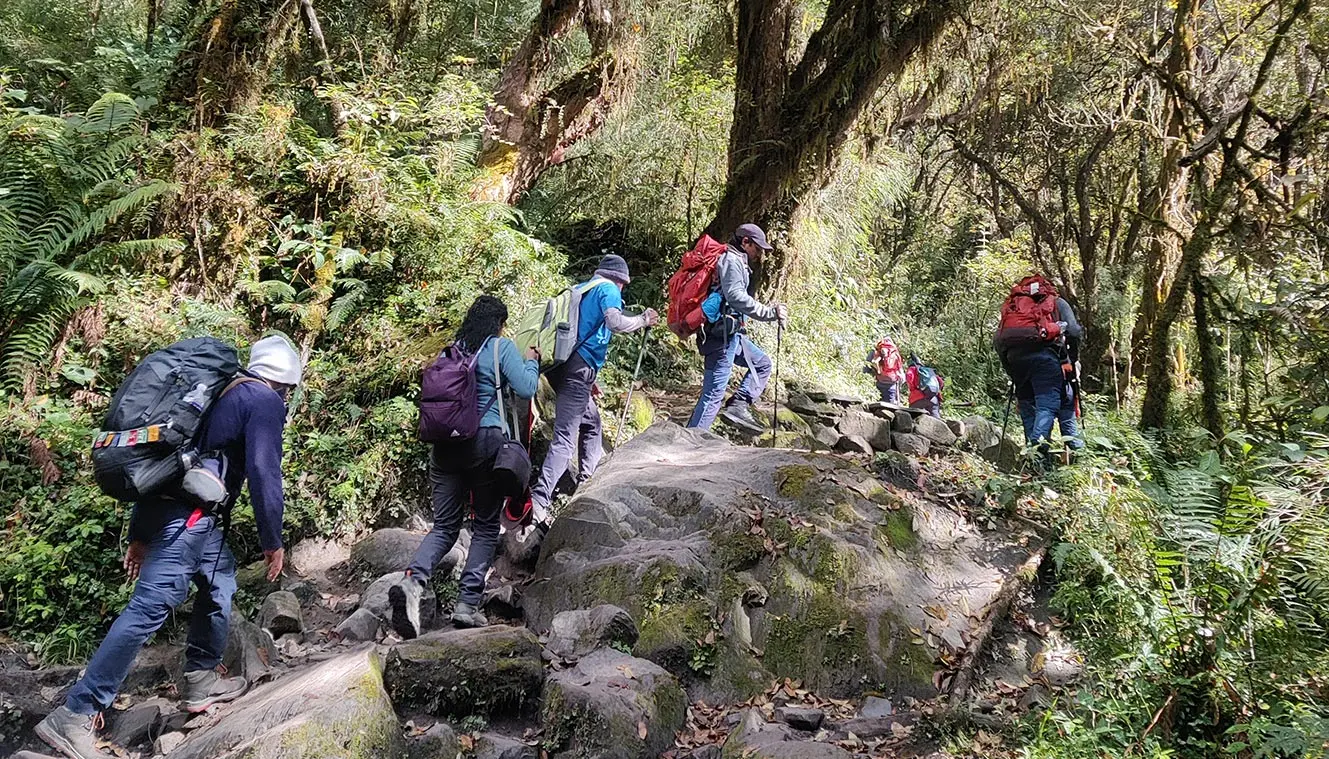
The hike today is through a delightful muddy trail laid up with scenic villages on both sides. After a descent of 1 hour, you will reach Kimrong Khola. Kimrong is a small village located on the top of a ridge offering panoramic views of the Himalayan mountains all around. A beautiful array of snow-covered peaks, Annapurna South, Gangapurna, Fishtail, and Hinchuli, begin to appear. From Kimrong, you have to descend about 400 m sharply to Kimrong Khola, through dense covers of Oak and Rhododendron trees. The route henceforth goes uphill until Chhomrong (a 4-5 hours hike). Chhomrong is situated at the base of the Hiunchuli mountains and you will see picture-perfect hilly settlements surrounded by green banana fields, rhododendrons, ferns, etc. are seen throughout. Chhomrong lies on a hilltop having stone paved stairs. It is the gateway to Annapurna Sanctuary and permits are granted here. You can also see Sinuwa Village on the opposite side of the mountain. The sights of Annapurna South become prominent. Again there are numerous tea houses and shops selling batteries, memory cards, and other accessories. Watch the peaceful sunset on the Annapurna range and rest for the day.
Chhomrong To Bamboo
- Altitude: 2,300m/7,600ft.
- Trek 10 km | Duration 5-6 hrs.
- Descend on stone steps to Chomrung Khola, then steeply ascend to Sinwa to Bamboo village.
- No mountain view in Bamboo.
- Lunch on the way in teahouses.
- Bamboo is full of Bamboo trees.
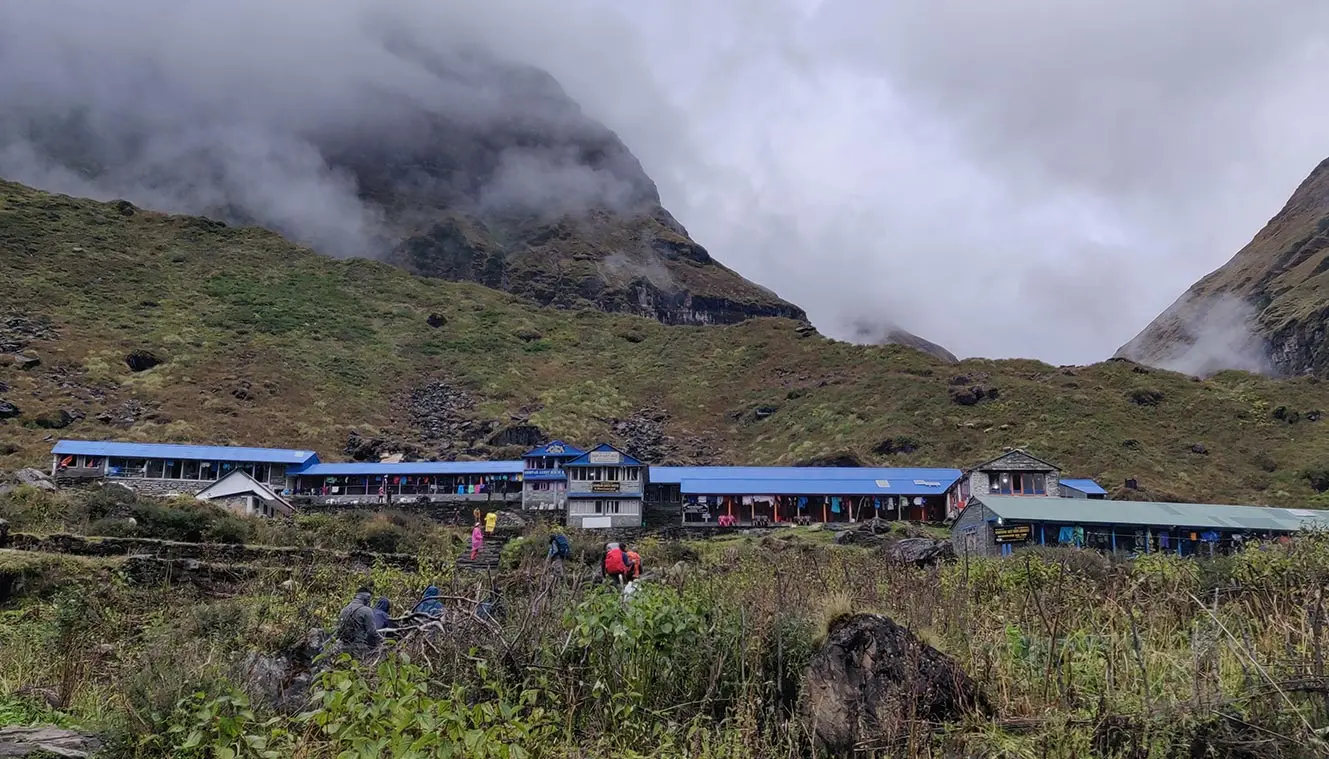
Welcome another amazing morning in the lush green hilly setup. Start with a descent on 2500 stone-built stairs leading to a bridge. The hanging bridge then takes you to Chomrung Khola, which seems like entering into dense forests. The Sanctuary is flourished with rhododendrons, oak, and alpine trees. Therefore the trail looks lush and adorned with reddish-pink flowers.
Climb up the stairs to the other side of the mountain to Sinuwa Village. Below, you can see the Chomorng River gushing away with a torrential force. The trail is steep to Sinuwa village. Sinuwa is marked with a few teahouses and lodges. It is enclosed between thin forest cover. Past these points, the donkeys are not permitted on the trail and the goods are then carried by the porters from this point on. Annapurna III comes into clear visibility here. Another climb opens to Kulidhar then a downhill hike ends at Bamboo camp.
The bamboo campsite does not offer as many mountain views as other teahouse stops as it is at a lower altitude than the surrounding mountains. However, you may see a lot of Bamboo plants around the campsite. Rest well in Bamboo and tomorrow we will make our way to the stunning Machapuchhare Base Camp.
Bamboo To Deurali
- Altitude: 3,200m/10,550ft.
- Trek: 9 km | Duration: 5-6 hrs.
- Moderate level of ascent crossing Modi Khola River.
- Views: Machhapuchhre, Gangapurna, and Annapurna III.
- Lunch is on the way.
- Stay in teahouses.
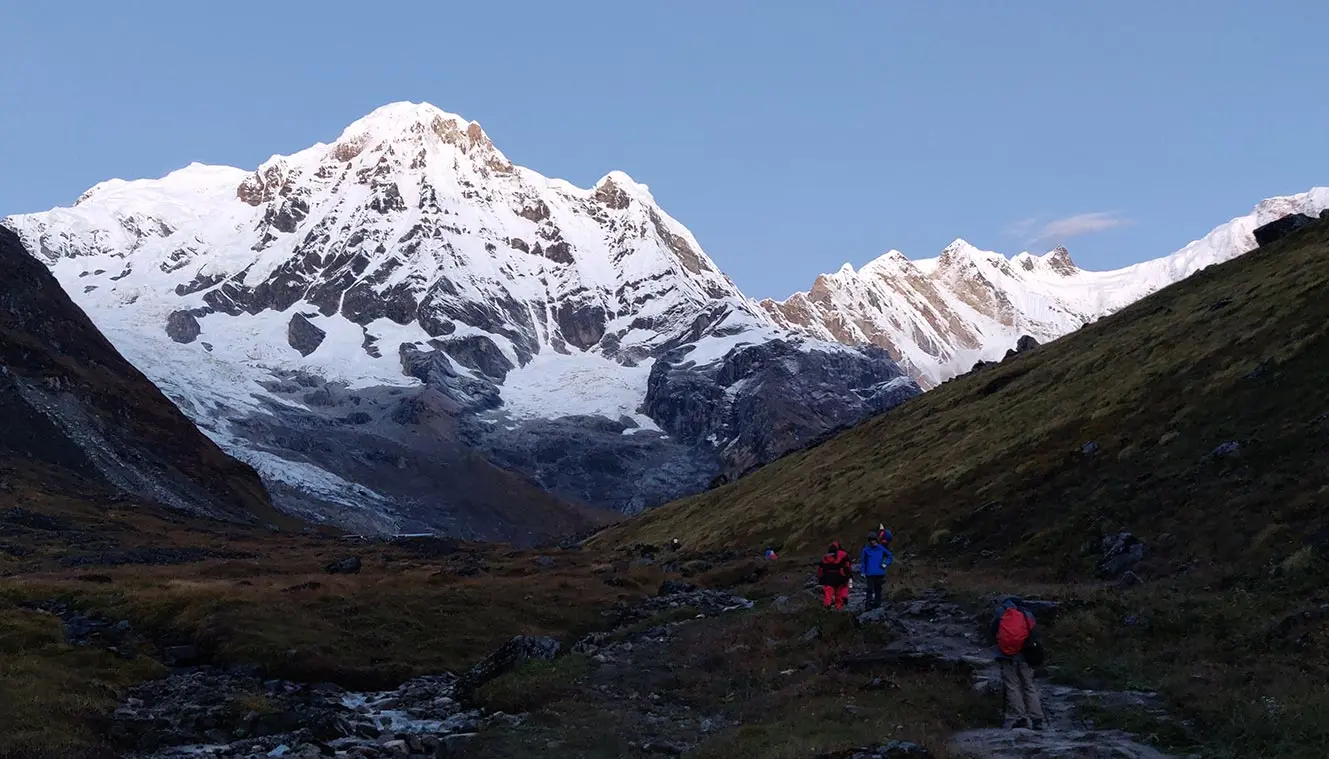
Get all braced with enough energy as this is the strenuous day of the trek. Yet, the trail will show changing vegetation from sub-tropical to alpine and the sights will keep you revitalized. The height gain is close to 4000 feet, therefore take it slow and stay hydrated. In one hour the first village Dovan comes en route, identified by 5 lodges only. The tip of Machapuchhare mountain will be visible. Mix path of gradual ascends and descends with muddy trail lead to Himalaya. A wooden bridge and shrine will be the highlight of the trail. Himalaya has quaint tea houses. After the Himalayas, the terrain sees a change from dense alpine forests to a bouldered region. You might see some vegetation like Bamboo, grass, and ferns.
A few landslide and avalanche-prone areas will be seen on the path ahead. An overhanging cave called Hinku arrives after an hour of hiking up. The entrance to the cave is blocked. The trail begins to descend for about 10 to 15 minutes from here. From here the trail descends for another 15 minutes until you arrive at two big snow patches. Cross the snow patches and a stream crossing followed by a climb of about 20 minutes to reach Deurali. This is the camping spot for the night. Deurali is surrounded by lush greenery and offers panoramic mountain sceneries. You can see the Machapuchhre, Gangapurna, and Annapurna III from here.
Deurali To Annapurna Base Camp Via Machhapuchhre Base Camp
- Altitude Annapurna Base Camp: 4,130m/13,500ft.
- Altitude Machhapuchhre: 3,700m/12,200ft.
- Trek: 8km | 6hr.
- Moderate ascent till Annapurna Base Camp.
- Views: Entire Annapurna range, panoramic views of Gangapurna, Gandharvachuli, Machapuchare, Annapurna (South), and view of mighty Annapurna I, get fantastic 360-degree views and beautiful sunrise and sunset.
- Lunch at MBC.
- Stay: in teahouses.
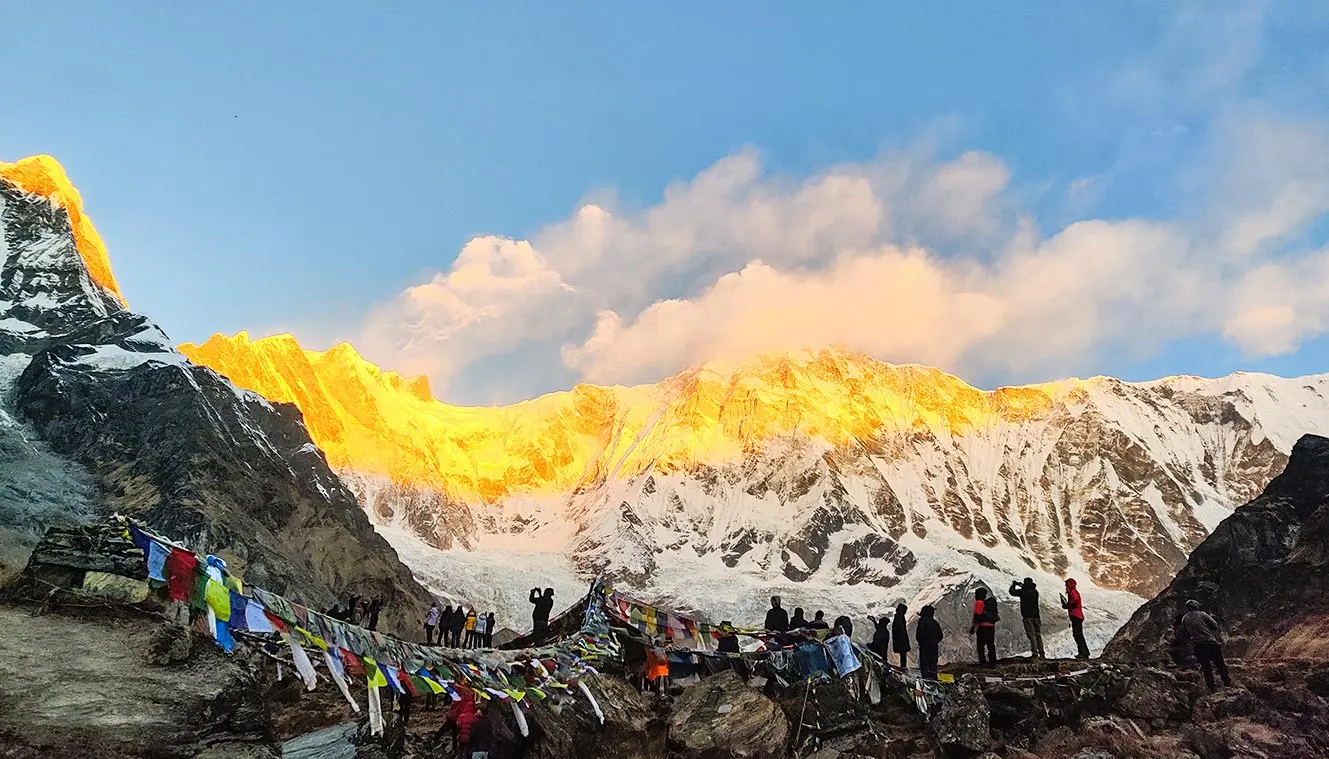
The trail that climbs out of Deurali is a bouldered section. From here the trail opens up to a valley with Modi Khola thundering past you. Another section of the rocky terrain of 40 minutes directs you to Bagar. From here, you will walk past some abandoned lodges, and in about one hour you will come across a bridge over Modi Khola, after crossing this bridge the next halt, Machapuchre Base Camp is 30 minutes away. Keep your eyes on the left and you will see astounding views of the Annapurna Ranges while in your front you will get to see the majestic Machapuchhare Range.
MBC is a stunning place well-known for the mesmerizing moon rise on Machapuchre mountain, do not miss this wonderful night sky. Along with it, other peaks seen are Mt. Hiunchuli, Annapurna South, Annapurna I, Annapurna III, Gandharvachuli, and Gangapurna. Since you will be climbing close to 4,000 ft today, so be aware of signs of AMS. The route takes a sharp 90-degree turn to the left for ABC. The initial trial has a steep ascend followed by a gradual ascend. You will be hiking above the tree line; hence no traces of trees will be seen.
Just as you get closer to the camp, the magnificent Annapurna I becomes bigger and bigger. The ABC is like being on an island encircled by giant peaks and huge never-ending ranges. 6000 and 8000 m peaks surround the base camp and it is an astounding sight to behold. 360-degree spectacles of the magnificent Annapurna range, Gangapurna, Gandharvachuli, and Machapuchare. Enjoy your lunch looking at the white clouds waving over these peaks. If you are lucky enough, you may even spot some Marmuts on your way to the campsite. Spend the rest of the day breathing with the mountains. Live every moment and sleep in their shelter.
Annapurna Base Camp To Bamboo
- Altitude: 2,300 m/ 7,600 ft.
- Trek Distance: 13 km | Duration: 8-9 hrs.
- Retracing the route with gradual ascend and descend.
- Water source: Refill water bottles at teahouses
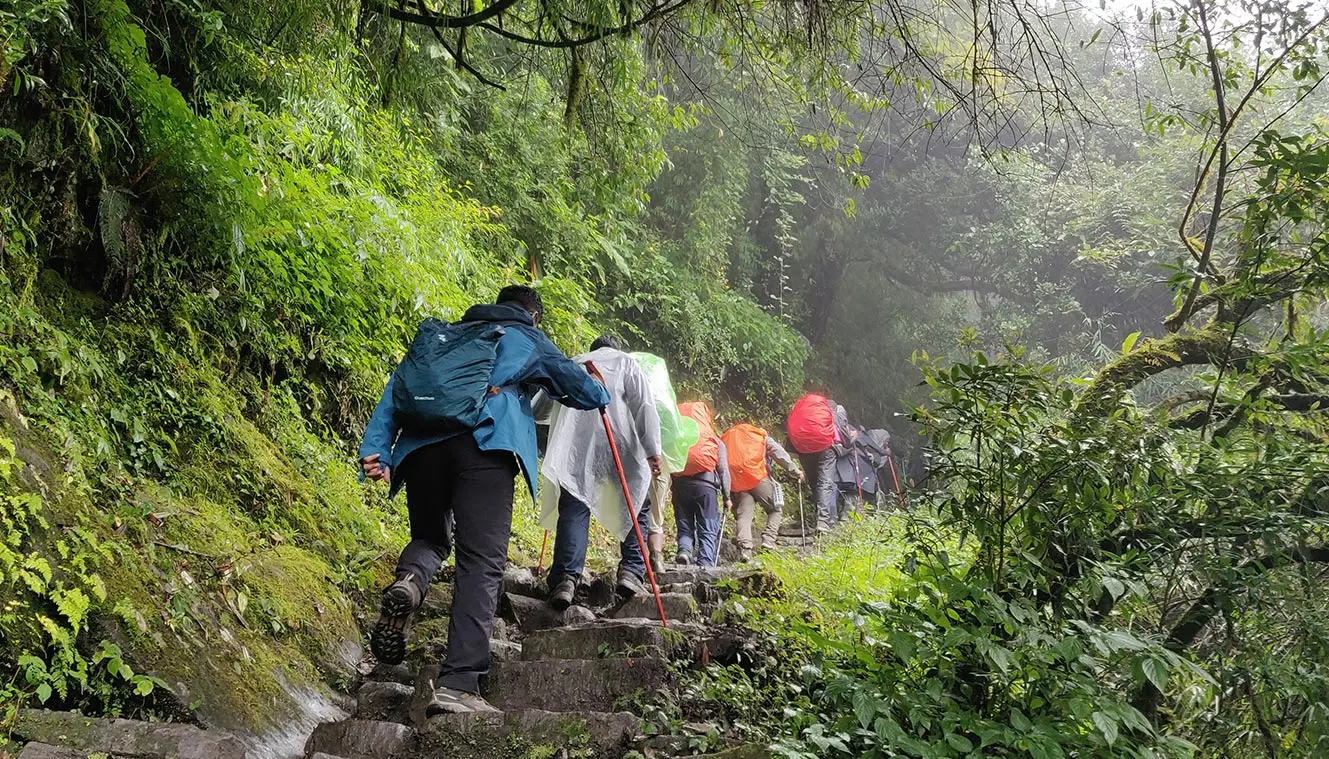
This is the longest day of the trek retracing the steps back to Bamboo. The trail as you know is mostly a descent so is quite easy. Wake up to an amazing sunrise over the Annapurna Massif. This is one of the best sunrises, you will see so try not to miss it. After watching a sunrise and a delicious breakfast, we will begin to head down towards Bamboo. The MBC, Deurali, Himalaya, and Dovan habitats will pop up again as you move down. Relax in your bed at Bamboo lodge after a long day of walking.
Bamboo To Jhinu Hot Spring
- Altitude: 1,700m / 5,600ft.
- Trek Distance: 8 km | Duration: 5 to 6 hrs.
- A mixture of steep ascending and descending trail.
- Water source: Refill water bottles at tea houses.
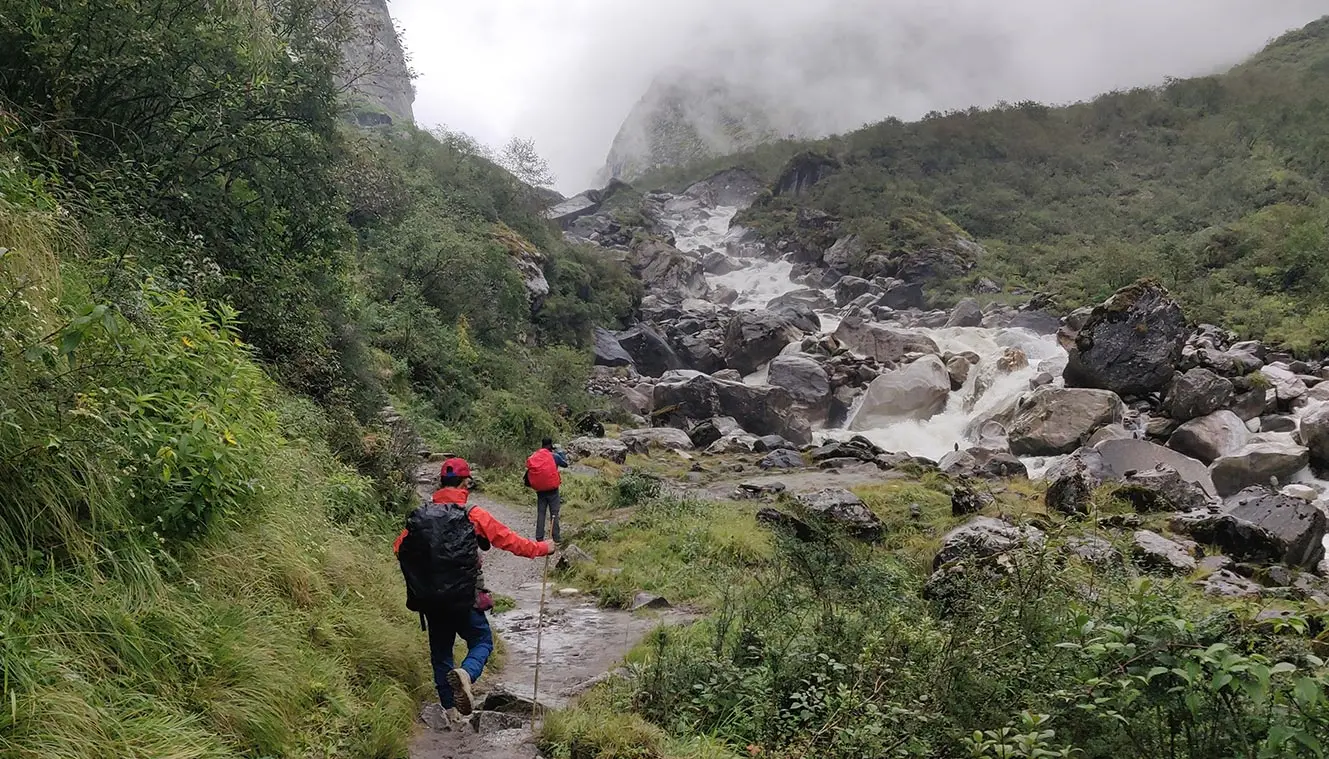
Again retrace your path to Sinuwa followed by a steep descent to Chomrung Khola. It should take around 45 minutes to reach Sinuwa. Cross the same hanging bridge towards Chomrung Khola. Another steep ascent will lead to Chomrung village. It will take about an hour to reach Chomrung Khola and 45 minutes more to Chomrung. Try to re-picture the sights you captured earlier and enjoy them.
From Chomrung take an ascending trail until you arrive at the fork where a signpost reads Jhinu. From here on, you have to take the steep descending steps, all the way, to Jhinu. It will take you around 1.5 hrs to reach Jhinu.
With downhill and then uphill hike Jhinu Danda settlement arrives. Jhinu is popular for its hot springs and you will see a lot of subtropical forests all around. Enjoy the refreshing hot springs of Jhinu 20 minutes away. Cherish your last night of the trek.
Jhinnu Hot Spring To Jhinnu Bridge And Drive To Pokhara
- Altitude Jhinnu Bridge: 1,250m/4,200ft.
- Trek Distance: 2 km | Duration: 45 minutes.
- Easy trail to road-head, from road-head drive to Pokhara.
- Drive Distance: 60 km | Duration: 3 hrs.
- Check-in at the hotel in Pokhara.
- Debriefing and certificate distribution in the evening.
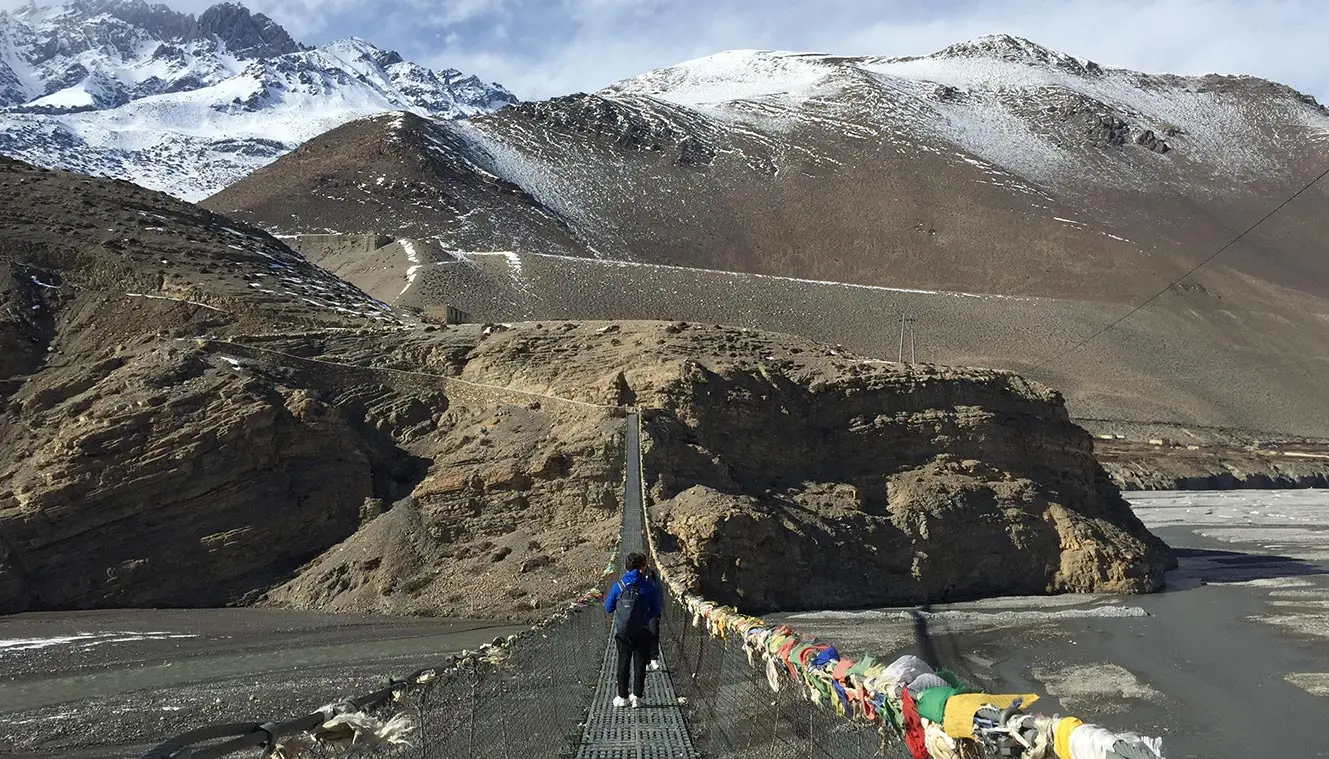
From Jhinnu Hot Spring follow the descending trail to Kimrong Khola Bridge. It will take about 45 minutes. Keep walking on the trail along the houses and you will arrive at a road head. From here, you will board a vehicle to Pokhara. In about 3 hours you will reach your hotel in Pokhara. Spend the evening at your leisure in Pokhara. Your overnight accommodation is arranged in Pokhara as well.
- Checkout time of the hotel is 10:30 am on day 10.
- It is advisable to make any further travel plan on day 10 or after day 10.
- Keep a buffer day in your travel plan.
- If buffer day is not used in the travel then it can be used to Explore Rishikesh.
- Distance, Altitude, and Trekking hours are approximate and rounded off.
- Keep the original and copy of ID proof handy.
Day-1: Arrival in Pokhara
- Altitude: 2,700 ft.
Day-2: Pokhara to Sauli Bazar (Drive) and trek to Ghandruk
- Altitude: 2,000m/6,500ft.
Day-3: Ghandruk To Chhomrong
Day-4: chhomrong to bamboo, day-5: bamboo to deurali, day-6: deurali to annapurna base camp via machhapuchhre base camp, day-7: annapurna base camp to bamboo, day-8: bamboo to jhinu hot spring, day-9: jhinnu hot spring to jhinnu bridge and drive to pokhara.
- Checkout time of the hotel is 12:00 Noon on day 10.
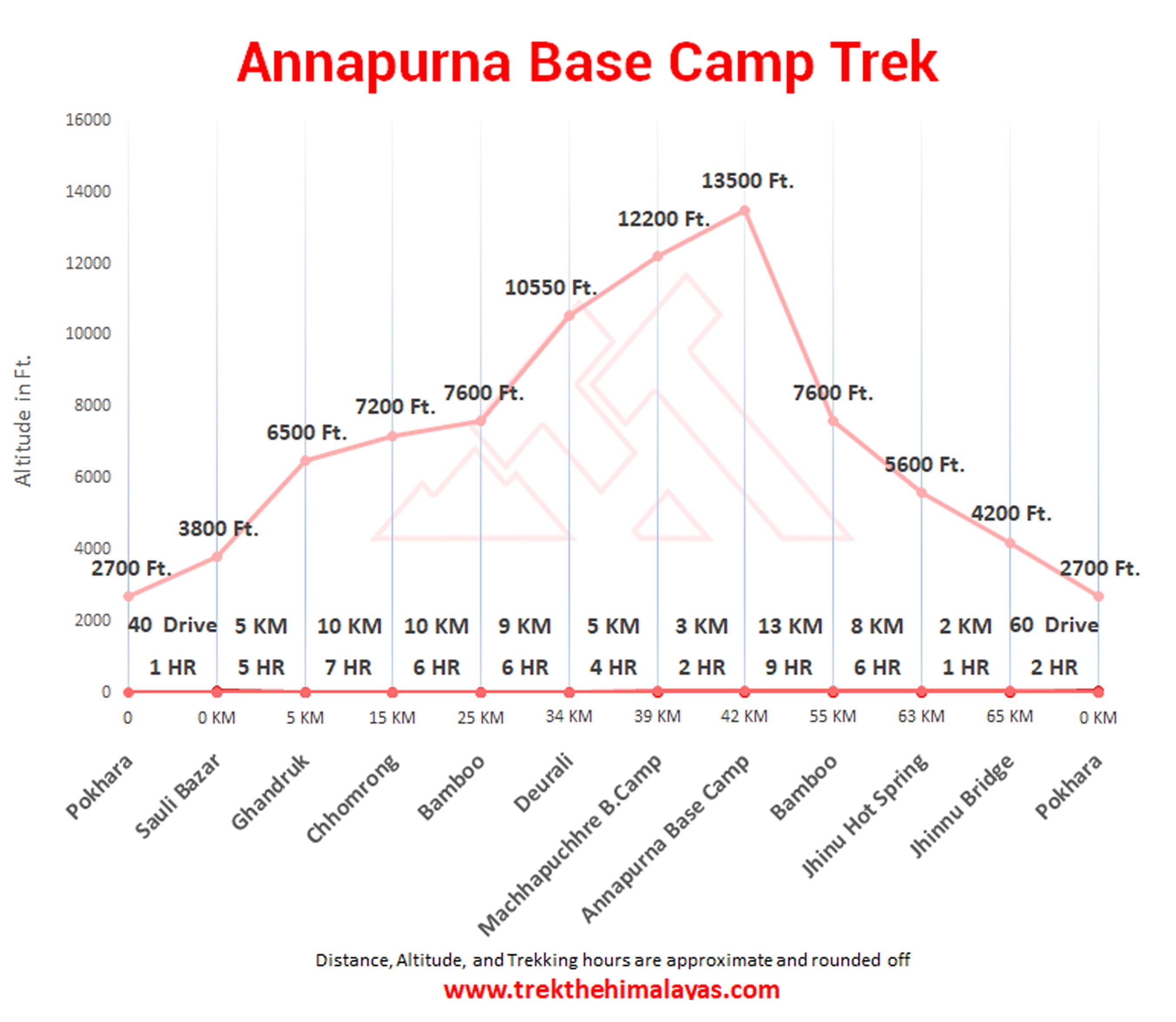
Medical & Disclaimer Form (Mandatory Documents) Click Here.
How To Reach
It is essential for everyone to arrive at Pokhara (1:00 pm).
Upon booking the trek, you are required to come to our hotel. Your trek coordinator will provide you with details such as the name of the Pokhra hotel, its location, and the contact person's number.
Options to reach Pokhara
Tribhuvan International Airport is the only International airport located in Kathmandu, Nepal. There is no Pokhara airport, although it has its own landing field. One can fly to Tribhuvan airport and then can take an additional flight to Pokhara. The distance between Pokhara and Kathmandu is around 200 kms and can be covered in 30 minutes. Popular airlines such as Buddha Air, Yeti Airlines, and Simrik Air serve this Pokhara route.
There is no train option travelling to Pokhara, Nepal. The closest railway stations which one can arrive at are Jaynagar, New Jalpaiguri or Gorakhpur (INDIA). From there crossing the corresponding borders of Panitanki or Sunauli, one can take a bus to Pokhara via Kathmandu.
One can directly travel to the cities like Gorakpur or Varanasi in Uttar Pradesh, and by crossing the Sunauli border can catch a bus or book a private car to reach Pokhara. The journey will take upto 8 hours to complete. Or one can fly to Kathmandu and then take public or private transport to Pokhara. The distance between these two cities is 200 kms which may take upto 6 to 7 hours.
For your return journey from Pokhara, you have the flexibility to choose between road or air transport options. Please note that our services extend only to the hotel, and the standard hotel check-out time is 11:00 am.
.webp)
1. Accommodation (as per the itinerary):
- Day 1 and Day 9 stay in a 3 star Hotel in Pokhara with Breakfast.
- Day 2 to Day 8 Teahouse.
2. Meals (Veg + Egg):
- Day 2 Lunch to Day 9 Lunch, Tea & Cookies on arrival at Tea Houses.
- 3 Cups Tea/Coffee with Meal, Fresh Fruit after Dinner.
3. Support:
- 1 Mountaineering & First aid qualified professional trek Leader.
- 1 Experienced
- Enough support staff.
4. Trek equipment:
- High-altitude sleeping bag.
- Gaiters & Crampon (if required.)
5. First aid:
- Medical kit
- Oxygen cylinder.
- Blood pressure monitor.
- Stethoscope.
6. Transportation (as per the itinerary):
- Pokhra to Nayapul and return.
9. Permits:
- Entire Administration and Local Taxes.
- All necessary permits and entry fees, Upto the amount charged for Indian Nationals.
10. Services from Pokhra to Pokhra. 11. Store room facility in Pokhra for extra luggage. 12. Insurance of Trekking Guide and porters. 13. ABC Trekking Map
1. Any kind of personal expenses. 2. Porters for the personal bag* 3. Wi-Fi, charging batteries and hot showers, warm water for drinking 4. Nepal entry visa (approximately $40 USD) only for foreigners (Not for Indians) 5. Customary gratuities for guides & porters 6. Unforeseen costs due to flight cancellation, weather conditions, etc 7. Evacuation and medical expenses* 8. Drinks: Bottled water. 9. High-altitude Trekking Insurance is mandatory. 10. All costs not outlined under "What's included" 11. Permit and entry fee for Foreign Nationals/OCI/NRI &
Things can be provided on demand and availability (participant has to pay extra for these things) 1- Satellite phone/set phone - is a type of mobile phone that connects via radio links via satellites orbiting the Earth instead of terrestrial cell sites like cellphones. Therefore, they can operate in most geographic locations on the Earth's surface.
2- Gamow/PAC HAPO Bag (Portable Hyperbaric Bag) - is a unique, portable hyperbaric chamber for the treatment of acute mountain sickness (AMS), also known as altitude sickness.
3- AEDs (Automated External Defibrillators) -& are portable life-saving devices designed to treat people experiencing sudden cardiac arrest, a medical condition in which the heart stops beating suddenly and unexpectedly.
Special Offer
Make a single payment and trek the number of times you want.
If you book a trek with Trek The Himalayas and cannot complete it, or if you've successfully completed the trek and wish to do it again, you can repeat it multiple times at no additional cost.
Terms and conditions
- This offer is non-transferable.
- This offer is valid for Trek The Himalayas limited fixed departures.
- This offer is valid for 5 years from the date of booking.
- This offer is not valid if the participant has received a cash refund or voucher at the time of cancellation.
- Participants don’t have to pay for the trek cost but have to pay for transportation and trek permit costs.
To reserve a spot for a trek or adventure program, you can either utilize our online booking form or call us at the provided number. For your confirmation, a deposit must be wired, including the initial payment.
Cancellation terms:
Cancellations prior to 25 days from the start of the Trip
Refund options
- 5% deduction of trek fee
- 100% cash voucher for any trip till one year
- Transfer your trek (any trek, any date) to your friend
Cancellation between 24 days and 15 days to the start of the Trip
- 30% deduction of trek fee
- 100% cash voucher for same trip till one year
- 85% cash voucher for any trip till one year
- Transfer your trek (same trek, any date) to your friend
Cancellation between 14 days and 10 days to the start of the Trip
- 50% deduction of trek fee
- 80% cash voucher for same trip till one year
- 70% cash voucher for any trip till one year
- Book the same trek, in the same season, with any other batch
Cancellation less than 9 days to the start of the trek
- No cash refund
- 20% cash voucher for the same trip till one year
- 10% cash voucher for any trip till one year
- Transfer your trek (same trek, same date) to your friend
Note- If a booking is made using a voucher or discount code, the policies related to vouchers and discounts cannot be modified.
In the unlikely event that TTH cancels a trek prior to the scheduled departure date:
While it is extremely rare for TTH to cancel a trek, we understand that unforeseen circumstances or natural disasters may occasionally require us to do so before the scheduled departure. These circumstances could include continuous rain or snow, thunderstorms, snowstorms, landslides, floods, earthquakes, or any other natural calamity that poses a risk to the safety of our trekkers. Additionally, unforeseeable events such as local riots, curfews, pandemics, lockdowns, government orders, or any similar situations that compromise the safety of the trekking experience may also necessitate a cancellation.
In the event of such a cancellation, TTH will provide you with a voucher equivalent to the amount you paid for the trek. This voucher can be redeemed for any of our treks within the next year, allowing you to still enjoy an adventure with us at a later date.
The issuance of a voucher is not applicable in situations where you are required to descend from the trek for any reason. The trek leader may make the decision to send you down from the trek due to factors such as insufficient fitness level, symptoms of Acute Mountain Sickness (AMS), high blood pressure, exceeding the designated turn-around-time, health concerns, or if you are found smoking, drinking, or violating the rules set for the trek. In such cases, the provision of a voucher does not apply.
In the rare event that TTH shifts a trek:
We would like to emphasize that weather conditions in high-altitude areas are highly unpredictable and can undergo sudden changes at any time, irrespective of the day. Additionally, circumstances beyond our control, such as natural disasters, political unrest, pandemics, and lockdowns, may impact the feasibility of conducting a trek. In cases where we are unable to proceed with an event due to such circumstances that are beyond our direct control, we will make every effort to provide you with an alternative trek that is safer and more suitable.
In such situations, we will issue a voucher to offset the cost difference between the originally scheduled trek and the alternative trek. This voucher can be redeemed at any time within one year from the date of issue. Please note that a refund fee or reimbursement of the cost difference is not applicable in these cases.
- Change of trek batch is dependent on the availability of seats in the batch
- In case of transferring a trek to a friend, he/she should satisfy all the mandatory requirements put forward by TTH
- TTH holds the right to change/cancel the policies, without prior notice
- Cash refund is applicable only in case of bookings made without using any promotional offer code or vouchers
Cash Voucher Terms:
- This is a non-transferable voucher
- The voucher cannot be merged with any other offer of Trek The Himalayas
- The voucher is valid for Trek booked directly with Trek The Himalayas in India
- To avail the voucher please use your register phone number or e-mail id
- All the other Terms of booking a trek with Trek The Himalayas are applicable to the voucher
- Trek The Himalayas holds rights to add/remove any of the Terms and Conditions without prior notice
Itineraries are based on information available at the time of planning and are subject to change. "Trek The Himalayas" reserves the right to change expedition dates, people or itineraries as conditions warrant. If a trip must be delayed or the itinerary changed due to bad weather, road conditions, transportation delays, government intervention, airline schedules, sickness, or other contingency for which TTH or its agents cannot make provision, the cost of delays and/or other changes are the responsibility of the participant. TTH reserves the right to decline, or accept, any individual as a trip member for any reason whatsoever.
Trek Essentials
PDF Of Trek Essential Download
Frequently Asked Questions(FAQ)
How to register/create an account with tth.
To register with TTH, visit our website - www.trekthehimalayas.com and create your account. To create your account you will need to use your email address and fill in all the details, set your unique password and your account is ready to use.
How to book a trek?
- To book a trek with TTH, you first need to register with us and create an account.
- Choose the trek that you want to do and click on available dates.
- You will land at the login page, fill in the required details.
- Add Participants, choose add-on services click on the Pay now button, choose your preferred payment method, and make the payment. TTH accepts multiple payment options, including credit/debit cards, net banking, and UPI.
- You will receive a confirmation email from TTH with all the necessary details about the trek, including the meeting point, transportation, accommodation, and other important instructions.
Made a payment but did not receive any confirmation.
please send an email to us at [email protected] or reach out to the numbers provided in the Help and Support section of your Trek Page. We will ensure that your issue is promptly resolved.
How to book off-load luggage and transportation?
To book services such as off-load luggage and transportation, you can find them listed as add-ons. These additional services can be booked at the time of your initial booking. If you miss booking add-ons during the initial reservation, you can log in anytime and easily book 4 days before the departure date add-ons through the platform.
If I have booked the wrong trek or date, how can I make changes?
In such a situation, please log in to your account and transfer your trek or date to the desired one within 12 hours or drop us an email at [email protected] 10 days before the departure date of the trek. After the initial 12-hour period, any changes will be processed according to the cancellation policy.
I am a beginner and confused which trek to book.
We recommend visiting our "Suggest Me a Trek" page. By filling out the form, our experts will contact you with the best possible trek options based on your preferences and experience level. Alternatively, you can reach out to us via email at [email protected] or give us a call using the numbers provided on our website for personalized assistance and recommendations.
How is family trek different from regular trek?
Family treks differ from regular treks by focusing on ease of difficulty, offering shorter durations for younger participants, Kid-friendly and easily digestible foods, child-friendly activities, maintaining a higher guide ratio for diverse age groups, and implementing additional safety measures for families.
Ideal treks for children.
Family Trek with Kids recommendation Only Dayara Bugyal and Chopta Chandrashila Trek.
Minimum age for children to trek with TTH.
Minimum age for TTH treks is typically 7 years, though this may vary depending on the specific trek.
Can we take children to high altitudes with their guardian?
Yes, you can take a kids to a high-altitude trek with a parent. Discuss with a trek expert before booking a trek.
Can we send kids without Parents/guardian?
Medical & Disclaimer Form (Mandatory Documents) Click here to download medical and disclaimer form
How to prepare a child for a high altitude trek?
Physical Fitness: Ensure your child is physically fit. Engage them in regular exercise, outdoor activities, and hikes to build stamina and endurance. Hydration: Emphasize the importance of staying hydrated at high altitudes. Encourage your child to drink water regularly, even if they don't feel thirsty. Proper Nutrition: Provide a well-balanced diet with sufficient carbohydrates for energy and foods rich in iron to prevent altitude sickness. Adequate Sleep: Ensure your child gets enough sleep in the days leading up to the trek. Quality rest is crucial for altitude adaptation. Educate on Altitude Sickness: Teach your child about the symptoms of altitude sickness, such as headache, nausea, and dizziness. Encourage them to communicate any discomfort immediately. Appropriate Clothing and Gear: Dress your child in layers to adjust to changing temperatures. Ensure they have appropriate trekking gear, including sturdy footwear. Positive Mindset: Foster a positive mindset. Encourage your child, and let them know it's okay to take breaks when needed. Medical Check-Up: Schedule a medical check-up before the trek to ensure your child is fit for high-altitude activities. Consult with a healthcare professional about any potential health concerns.
Kind of food will be served during the trek for children.
TTH takes special care to provide wholesome and nutritious food for children on treks. Here are some of the foods that are typically served for children: Breakfast: For breakfast, TTH serves a variety of options like porridge, cornflakes, bread, butter, jam, honey, boiled eggs, omelettes, and pancakes. Children can choose from these options to fuel themselves for the day's trek. Lunch: For lunch, TTH serves lunch which includes rotis, vegetables, rice, dal, and salad. The rotis are usually made fresh on the trek and are a good source of carbohydrates. The dal and vegetables provide protein and other essential nutrients. Snacks: TTH provides healthy snacks like fresh fruits, dry fruits, energy bars, cookies, and biscuits to keep the children energized throughout the day. Dinner: For dinner, TTH serves a hot and wholesome meal which includes soup, rice, dal, vegetables, and a non-vegetarian dish (if requested in advance). Children can also choose from a variety of desserts like custard, jelly, and fruit salad. Dietary requirements: If a child has any special dietary requirements, TTH can cater to those needs as well. For example, if a child is lactose intolerant or allergic to nuts, the kitchen staff can make arrangements to accommodate those requirements.
How to choose the right trek?
Choosing the right trek for a beginner can be a bit overwhelming as there are many factors to consider such as distance, elevation gain, terrain difficulty, weather, and time of year. Here are some tips that can help you choose the right trek for a beginner:
1. Determine fitness level: Assess the fitness level of the beginner to understand their physical capabilities. This will help you select a trek that is challenging but not too difficult.
2. Choose a well-traveled trail: A well-traveled trail will have more amenities such as signposts, water stations, and shelter. It is also safer as there will be other hikers on the trail.
3. Consider the length of the trek: For beginners, it is recommended to start with a shorter trek that can be completed in a day or two. This will help them get acclimatized to trekking and build their confidence.
4. Look for gradual elevation gain: Choose a trek with a gradual elevation gain rather than steep ascents. This will make the trek easier and more enjoyable.
5. Check the weather: Check the weather forecast before selecting a trek. Avoid treks during the monsoon season or winter when the trails can be slippery or dangerous.
6. Research the trail: Read about the trail to get an idea of the terrain, altitude, and difficulty level. This will help you select a trek that is suitable for the beginner.
7. Consult with an expert: If you are unsure about which trek to choose, consult our trek expert Mr. Nitin (+91 70600 59773) between 10 AM to 6 PM (Tuesday - Friday). Mr. Nitin will provide you valuable advice and guidance.
Overall, it is important to choose a trek that is enjoyable, challenging but not too difficult, and suitable for the beginner's fitness level and experience.
Can a beginner choose a tough trek?
It is not recommended for a beginner to choose a difficult Himalayan trek. Trekking in the Himalayas can be physically and mentally challenging, especially if you are not used to the high altitude, steep slopes, and rugged terrain. Choosing a difficult trek without the proper experience, fitness level, and preparation can be dangerous and put you at risk of altitude sickness, injury, and other hazards.
If you are a beginner, it is recommended to start with an easier trek and gradually build up your skills and experience. This will help you understand the challenges of trekking in the Himalayas, and also prepare you physically and mentally for a more difficult trek in the future. It is also important to choose a trek that matches your fitness level, experience, and interest.
What is the age limit for a beginner trekker?
There is no specific age limit for a beginner trekker. However, it is important to consider your physical fitness, health condition, and personal interests before embarking on a trek. Trekking in the Himalayas can be physically and mentally demanding, and requires a certain level of physical fitness and endurance.
If you have any pre-existing medical conditions or are above a certain age, it is recommended to consult with a doctor before embarking on a trek. It is also important to listen to your body and take breaks as needed during the trek to prevent exhaustion or injury.
If I am solo, can I join the trek in a group?
Yes, you can join the trek. We have fixed departure groups where you can simply book your trek and we will take care of curating a group.
How does my family get updated about my Trek?
Before you start the trek, it is recommended that you make all the necessary phone calls as during the trek you may or may not receive network coverage, once you come back to the Base Camp, you can reconnect with your family via phone once again. You can share your trek coordinator contact detail with your family members to get the latest updates about your trek batch.
What food can I expect?
At TTH, we provide wholesome and nutritious meals during the trek. The food is vegetarian and includes a variety of dishes such as rice, dal, vegetables, chapati, paratha, pasta, noodles, and soup. We also offer snacks such as biscuits, and salty, and dry fruits during the trek. Special dietary requirements such as vegan, gluten-free, or Jain food can also be arranged if informed in advance.
I am allergic to some foods.
If you are allergic to some foods, you need to let us know in advance so that we can make arrangements accordingly.
How safe is trekking with TTH?
TTH is a trekking company that prioritizes the safety of all its participants, including women trekkers. They have a comprehensive safety system in place, which includes a dedicated team of experienced and trained trek leaders and support staff who are equipped to handle emergency situations and provide first aid.
TTH also takes specific measures to ensure the safety and comfort of women trekkers. They have a separate tent accommodation for women trekkers, female trek leaders, and support staff. They also provide separate toilet facilities for women and encourage a safe and respectful environment for all trekkers.
Moreover, TTH has a strict policy against any kind of harassment and has a zero-tolerance policy towards such incidents. They have a designated Internal Complaints Committee (ICC) to investigate and address any complaints related to harassment or misconduct. Overall, TTH has a good reputation for safety and responsible trekking practices, and women can feel comfortable and safe while trekking with them.
How TTH will manage if I am the only woman in the group?
In case you are the only women in the group, we provide a single sleeping arrangement. Also, during the trek, the trek leader will always remain by your side to provide optimum safety and reassurance.
How can I know that other women are in the batch?
You can reach out to the trek coordinator to inquire about the number of female trekkers and their respective states who have booked the trek. Please note that the trek coordinator cannot disclose personal details of any trekker. Once you've confirmed your booking, a WhatsApp Group will be created for all the trekkers in your batch. This allows you to connect with fellow trekkers before the trek begins.
Can I know in advance, which trek is led by a women Trek Leader?
While many of our treks are led by female trek leaders, however, it is not possible to know which trek leader is assigned to which group. But nonetheless, whether the trek leader is male or female you can be completely assured of your safety and security with us.
Can I trek with periods? If yes, then where can I dispose of the sanitary pad?
Yes, it is possible to trek with periods. However, it is important to take some extra precautions and preparations to ensure a comfortable and safe trekking experience.
Here are some tips that can help you trek during your period:
1. Use menstrual hygiene products that you are comfortable with, such as tampons, pads, or menstrual cups. It is recommended to carry enough supplies for the entire duration of the trek.
2. Pack wet wipes, hand sanitizer, and plastic bags to dispose of used hygiene products.
3. Wear comfortable and breathable clothing that allows for easy movement and reduces friction. Avoid wearing tight or restrictive clothing that can cause discomfort.
4. Carry pain relief medication, such as ibuprofen or acetaminophen, in case of menstrual cramps.
5. Stay hydrated and maintain a balanced diet to support your energy levels and overall health.
6. Take breaks as needed and listen to your body. If you feel uncomfortable or experience any unusual symptoms, seek medical attention immediately.
It is also recommended to consult with a doctor before going on a trek during your period, especially if you have a pre-existing medical condition or are taking medication. By taking necessary precautions and being prepared, you can have a safe and comfortable trekking experience even during your period.
We provide proper disposal facilities for sanitary pad disposal during the trek.
How will the accommodation be during the trek?
We offer three person tents with twin-sharing for optimum comfort. A woman trekker will share a tent with another woman trekker and if you are the only woman in the group, you will be given a single accommodation for your comfort and privacy.
Are trek poles, Jackets and other equipment available for rent from Trek The Himalayas?
Yes, we do provide gears on rent. You can book it using you TTH account directly.
Who will be with us on the trek from Trek The Himalayas?
Mountaineering qualified Experienced and first aid certified Trek Leader, First Aid Certify local guide, Cook, helpers and supporting staff.
Who can not join the trek?
People suffering from Bronchitis, Asthma, High blood pressure, Epilepsy (got faints), TB , Heart problem or on higher BMI side are strictly not allowed to go on any Himalayan trek. Apart from this if you had any medical history, please let us know.
When it gets really cold can I consume alcohol?
No. Alcohol and smocking isn’t allowed while on trek. It is totally misconception that it will keep you warm. Your body need to acclimatize properly and for that eat properly and drink enough water; these things will keep you warm.
What type of toilet facility is TTH providing at the trek?
Toilet tents provide a convenient solution for answering nature's call in the great outdoors. Dry toilets, in particular, offer a highly sanitary approach. By digging a pit and utilizing mud and a shovel, you can easily cover up your waste. This method ensures cleanliness and hygiene while camping or exploring in the forest.
Remember to pack essential toiletries to complete your outdoor bathroom kit and maintain proper personal hygiene during your adventures. With these practices in place, you can enjoy nature while also respecting it.
How do I manage the negative temperatures on the trek at higher camps? Do I need special jackets?
Layer Up From Head To Toe Eat Full Meals, never sleep empty stomach You can keep warmee (if you’re more susceptible to cold). Use sleeping bag in right way and don’t leave free space in sleeping bag.
For upper body – Thermal layer – T-shirt (full-sleeves) – Fleece T-shirt (for extreme colds) – Fleece layer – Thick Jacket/Down Jacket – Waterproof or Windproof layer (outermost layer, when it is snowing or raining) - For Lower Body – Thermal layer – Hiking pants (normal) or Winter hiking pants
Based on how warm you feel you can skip any of the above layers. Your outer later should be windproof since it is windy at high altitude. The idea behind layering is that the more insulation you have the less cold you feel, and instead of wearing a very thick jacket if you wear multiple layers, your body will be better insulated against the cold.
Do you provide crampon/micro spikes and gaiters?
Yes, we provide micro spikes and gaiters, if required.
What documents need to carry on trek?
Mandatory documents: 2 xerox of ID having address (addhar card/driving license), 2 Passport size photographs, hard copy Medical form signed & sealed by doctor, disclaimer form sign by trekker and high altitude insurance.
If we come prior the trek date, Do you provide accommodation?
No. We don’t but we can suggest you good hotel/Stay nearby pick up location.
Do we get enough water for drinking?
Yes, trekker must carry 2 water bottles 1 litre each so they can refill it at campsite for drinking and keep themselves hydrate.
What kind of shoes we should buy for the trek?
You should buy shoes which has these three features –Good grip, Ankle Support and additional water resistant layers. Generally, we advise Quechua Trek 100, MH 500 and MH 100.
How do we get back after the trek?
Your return transport is also included in trek fee if you're opting for service Dehradun to Dehradun ; we use Tempo Traveller/ Tata Sumo/Max/Boloero kind of vehicle.
What happens if some members of the team need to turn back before the summit?
No one is forced to go on. There is always enough staff to split the party according to need and regroup later at the camp. Most people have no trouble reaching the highest campsite. If some members decide not to climb the final distance they can wait for the climbers to come back down the same way or take a lateral path to the descent route.
What kind of help is available in case of emergency?
We always have a first aid kit close at hand. Serious injuries are rare. Porters will assist injured climbers to the base of the mountain and onward to a clinic or hospital. Kilimanjaro International Airport is very near Marangu Gate if evacuation to the US or Europe is advisable.
- Date and Price
Rent A Gear
Trek Articles
Quick Links
Trekking & Hiking
Mountaineering
Multi Sports
Himalayan Pilgrimage
Website Privacy
Terms & Condition
Contact Info
Get in touch with us. E-mail us Monday-Saturday (10 AM to 6 PM)
Address: Trek The Himalayas, Kaintura Plaza, Badrinath Road Tapovan, Rishikesh - 249201 Uttarakhand
Phone: 8191004846
Email: [email protected]
2010 Trek The Himalayas. All rights reserved
- Dates and prices

Hike the Annapurna Circuit in Nepal
Since opening its trails to foreigners in 1977, the Annapurna Circuit has been enticing hikers with promise of larger-than-life adventure. With over 100 miles of dense forests, terraced rice fields and dramatic high-altitude walks through the Himalayas, this is one of the most awe-inspiring long-distance treks in the world.
Undertake an epic 15-day journey full of dazzling biodiversity and epic views of the Nepal Himalayas. As you reach the end of the trail, you’ll learn to appreciate the small things in life and understand why so many consider this trek a life-changing experience.

A journey through jungle and clouds
Coursing through the very heart of Nepal, between the towering peaks of the Annapurna Range, the Circuit takes you through four distinct regions and their richly diverse ecosystems.
As you begin your journey from Kathmandu, you’ll visit ancient Buddhist temples and sacred Hindu sites before reaching the starting point in Besisahar.
En route to Pisang, witness the landscape changing from wild banana trees and wet rice terraces to dense alpine forests. Enjoy the views of Annapurna II, IV, and Tilicho until you cross Gunsang, where sub-tropical meadows turn into a chilly alpine environment.
- ANCIENT KINGDOMS
- SACRED SITES
- COLORFUL VILLAGES
- DIVERSE LANDSCAPES
- EXOTIC WILDLIFE

On the edge of the Tibetan Plateau
Immerse yourself in local culture.
The Annapurna Circuit is a pilgrimage along the sacred trails of the Nepali people. Overflowing with history, its remote villages and monasteries display the religious and cultural intertwining of Hinduism and Buddhism. Life has remained almost unchanged here for centuries.
At around 18,000 feet, you’ll reach the pinnacle of the trek—the mythical Thorong La Pass. Enjoy the sweeping views of Mt. Dhaulagiri and the restricted lands of Upper Mustang below.
As you descend, the trail will take you to Muktinath—a sacred pilgrimage site and one of the world’s highest temples.

A life-changing experience awaits

Find bliss in the heart of the Himalayas
Friendships are forged on the trail.
Join a group of adventurous people on a trek through breathtaking nature and quaint locales brimming with life.
From one fascinating landmark and finger-licking delicacy to another, you’ll bond over your mutual admiration for the wonders of Nepal—and the challenge of reaching them.

LEARN TO APPRECIATE THE LITTLE LUXURIES
One of the key reasons for hiking the Circuit counterclockwise are the numerous teahouses scattered along the trail. These traditional symbols of Nepal are both oases of respite and indispensable resting spots that help you acclimatize to the local elevation.
They may not be the Hilton—the higher the altitude, the more basic the lodging—but after a long day of hiking, they’ll seem like it. Factor in the world-class hospitality and they’re like a gift from the heavens!

The Kathmandus and don’ts of hiking in Nepal
One thing Nepal really knows is how to keep its hikers full. The Annapurna region is renowned for its varied, healthy diet ranging from the invigorating Dal Bhat, to baked goods, and even Yak burgers! Just remember: if you’re respectful and open-minded, you’ll receive tenfold in return.
Moreover, try to make a positive impact on the trail. Hundreds of hikers traverse the Annapurna Circuit at the same time, which makes proper waste management even more critical. When done right, traveling can an enriching experiences both for you and the local community.
- TEAHOUSE NETWORK
- WELCOMING LOCALS
- TRADITIONAL CUISINE
- TIBETAN TEMPLES
- ASTONISHING VIEWS

Your guides
Trek Central are a team of young, energetic, and hardworking professionals, helping people from across the globe to experience and explore Nepal — one of the most spectacular natural and cultural destinations in the world. They have been working in this field for more than 6 years with a new vision and direction.
At the core of their business lies a genuine passion to make a difference in the world. They are dedicated to creating a positive impact and actively supporting the local communities we engage with.
Trek Central Nepal is an official member of the Nepal Tourism Board (NTB), Trekking Agents Association of Nepal (TAAN), Kathmandu Environment Education Project (KEEP), and many more local tourism bodies.

More trips like this
Trekking the manaslu circuit in nepal, hike the classic trails of patagonia, hike and sail the mythical faroe islands, hiking the alta via route in the dolomites, hiking iceland’s volcanic trails.

Your guides will welcome you at the Tribhuvan International Airport and take you to your accommodation in Kathmandu. Get some rest and join your group for a welcome dinner at the finest restaurant in the city and taste the delicious Nepali cuisine. Your guides will brief you about the trip details, go over the itinerary and take you back to your hotel. Don’t let the excitement stop you from sleeping — you will need your energy for the next 15 days!
Meals : Dinner Accommodation : Hotel in Kathmandu Altitude : 1300 m/ 4264 ft

Your guides will pick you up after breakfast and drive you to Jagat, a village situated at an altitude of around 1,300 meters (4,265 feet). Your adventure begins with an 8-hour drive through deep gorges as you trace the Trisuli River westwards. You will pass through the small town of Mugling where the Trisuli and Marshyangdi rivers meet before you reach Jagat, where you’ll spend the night. E xplore the village and s pend the night at a lodge.
Driving : 8-9 hours Meals : Breakfast, lunch, dinner Accommodation : Guesthouse in Jagat Altitude : 1300 m/ 4264 ft

After breakfast, begin your hiking portion of the trip in Jagat and set out to reach the village of Dharapani (6375 ft/1943 m). Start your trek by following the path over a suspension bridge into the woods. You will have a steep climb towards the settlement of Sattale but you’ll enjoy good views of the mountain peaks along the way. From here, the path leads you to the entrance to the Manang district. Today’s trip is filled with beautiful natural beauties like waterfalls and riverbeds that seemingly appear roughly every 200 meters , green villages decorated with terrace farms and sloping birch forests. You will also pass beneath the Kaani, a decorated gate arch painted with the traditional colors of the Buddhist prayer flags. Finally, you will reach Dharapani, where you’ll spend the night.
Hiking : 5-6 hours Meals : Breakfast, lunch, dinner Accommodation : Guesthouse at Dharapani Altitude : 1860 m/ 6102 ft

Today you’ll hike along a mule track dotted with hot springs until you reach the village of Timang. Walk along a slanting trail leading to a ridgeline with amazing views of the surrounding peaks. Enjoy the vistas of the Manaslu Peak, the Annapurna II, and many others before you continue trekking along the path. After you pass by villages like Thanchowk and Koto, you will finally reach your destination for the day, Chame.
Hiking : 5-6 hours Meals : Breakfast, lunch, dinner Accommodation : Guesthouse at Chame Altitude : 2670 m/ 8758 ft

Following the Marshyangdi River along the Pinewoods, you will reach the village of Telekhu via Brathang. From there, it is a gradual trek uphill towards Dhukur Pokhari, surrounded by amazing Himalayan views. You’ll have the opportunity to see the landscape transform from wet rice terraces to dense alpine forests until you reach the town of Pisang. Enjoy the amazing views of Annapurna II and Pisang Peak.
Hiking : 5-6 hours Meals : Breakfast, lunch, dinner Accommodation : Guesthouse at Pisang Altitude : 3200 m/ 10,496 ft

Today’s adventure is filled with amazing woodlands that are home to a wide variety of birds and jungle fowls. The pathway follows the hillocks towards the Humde Airport in Manang via the village of Bhraka where houses are built in the Tibetan style, with stacks of stones and thatch roofs. Along the way, you can also come across many Gumbas on the outer ridges of the settlements, and panoramic views of the mountain peaks. Finally, the path takes you to the famous village of Manang.
Hiking : 7-8 hours Meals : Breakfast, lunch, dinner Accommodation : Guesthouse at Manang Altitude : 3540 m/ 11,611 ft

This day is reserved for acclimatization. You can enjoy a leisurely exploration of the village today; Manang is situated in the broad valley of the Marshyangdi River that presents amazing views of the Annapurna Mountain Range. The Marshyangdi River flows towards the village’s east, and towards the north of the village lies the Chulu Peak.
Meals : Breakfast, lunch, dinner Accommodation : Guesthouse at Manang

Wake up, pack up your bags and get ready to hit the road again. Make sure you eat — a hearty breakfast is a must on the Annapurna Circuit! Today you’ll hike up to Yak Kharka. The hike will be long but the views will keep entertaining you. Wander along the paths uphill to the area of Tanki Manang and see how the locals live. Pass through tight alleyways making your way out of civilization and towards the end, prepare for a steep uphill portion. The second portion of the hike will be easier with some incline and beautiful swinging bridges along the way. You will notice animals, most notably yaks and horses, and finally, in the late afternoon, you’ll reach Yak Kahrka.
Hiking : 5 hours Meals : Breakfast, lunch, dinner Accommodation : Guesthouse in Yak Kharka Altitude : 4050 m/13,287 ft

At this point, the lower temperatures inform you that you’re nearing the top. From Yak Kharka, you will be trekking through the rocky-strewn oblique and rough terrains towards the foothill of the mountain pass, the Thorong Phedi. The Thorong Base Camp presents amazing views of the mountains, surrounded by terrace fields and sheer cliffs that are often climbed by the Himalayan Thar. Overnight stay at the guesthouse at Thorong Base Camp.
Hiking : 4-5 hours Meals : Breakfast, lunch, dinner Accommodation : Thorong Base Camp Altitude : 4450 m/ 14,596 ft

This will be one of the more challenging days of the tour. Wake up early in the morning and make your way steadily uphill. You will pass by goat herds and enjoy mesmerizing views of the entire Mount Annapurna and Manaslu massif as well as the valley below. After so many days of hiking, you will finally reach the 5416 m/17,769 ft Thorung La Base Camp. After reaching the top, descend to Muktinath in the historic Mustang Valley.
Hiking : 8-9 hours Meals : Breakfast, lunch, dinner Accommodation : Guesthouse at Muktinath Altitude : 3760 m/ 12,333 ft

Today you will pass through villages on your way to Jomsom, take a walk downhill and then along the bank of Kaligandaki river and face the strong winds on your way to your destination. As you hike through Kagbeni Village (the gateway of Upper Mustang trek), head downhill towards Ekle Bhatti and finally you’ll reach Jomsom. Take a rest and prepare for your night stay at the teahouse there.
Hiking : 4-5 hours Meals : Breakfast, lunch, dinner Accommodation : Teahouse Altitude : 2720 m/ 8922 ft

The traditional route of the Jomsom Muktinath trek has been supplanted by motorable roads extending from Muktinath to Tatopani. Traveling by private jeep to Tatopani, you can relish the spectacular vistas of cascading waterfalls and traverse between the towering peaks of Mount Annapurna and Dhaulagiri. Upon arrival in Tatopani, indulge in a rejuvenating bath in the natural hot springs, followed by an overnight stay in comfortable teahouse accommodations.
Driving : 4 hours Meals : Breakfast, lunch, dinner Accommodation : Teahouse

Start off the day following the Annapurna route, crossing the bridge and walking towards Gharkholagaon. Pass through Ganesh temple and reach Ghara. The walk ahead will take you through Sikha, Chitre and then finally to Ghorepani, where you’ll spend the night
Hiking : 7-8 hours Meals : Breakfast, lunch, dinner Accommodation : Lodge in Ghorepani Altitude : 2860 m/ 9381 ft

Today you’ll head off to Poon Hill early in the morning and reach Pokhara in the evening. Wake up early in the morning and start taking an uphill climb towards the top of the hill — it might seem difficult but it will all be worth it once you see the magnificent sunrise from the top. Enjoy the amazing sunrise along with a view of stunning snow-capped peaks(Mt.Dhaulagiri, Mt.Nilgiri south, Mount Annapurna south, Himchuli, Mt.Fishtail, Mt.Annapurna IV, Mt.Annapurna II, and many other) and take a few photos before you head back to Ghorepani. Reenergize with a hearty breakfast and move towards Nayapul which brings you to the end of the Annapurna Circuit Trek. Your group and guides will take a standard tourist bus ride to Pokhara. You’ve spent the last week on your feet, so use this time to recuperate and get some needed rest. You can either roam around in the lakeside, spend some time alone or enjoy your time with the rest of the crew members and share your experiences so far.
Hiking : 3 hours Driving : 5 hours Meals : Breakfast Accommodation : Hotel in Pokhara

Pack up your bags and head back to Kathmandu. Muse over the exciting trek you had and enjoy a long drive through Nepal. At Kathmandu, your guides will organize a farewell dinner to celebrate the successful completion of the trek and prepare for final departure.
Driving : 6-7 hours Meals : Breakfast, dinner Accommodation : Hotel in Kathmandu

Today is your final day in Nepal — get ready for the departure and take a few last photos before you head for the airport. Your guides can drop you off at the Tribhuvan International Airport. Exchange final greetings and wishes with your group and guides and have a pleasant journey home.

Secure the dates you want with a 30% deposit for this year or 10% deposit for next year. Pick your preferred dates without the risk of your bucket list adventure selling out!
Read about our cancellation policy on our FAQ page.
Book early-bird for the coming year, and secure your spots on time.
Hop on a 15min call with our adventure expert and let us know about your expectations. Whether you want to join a group or go on a fully private experience, we are here to make it happen.
What you get on this adventure:
- An experienced, certified mountain guide with extensive knowledge of the area and a local Nepali certified guide
- Sightseeing tour in Kathmandu
- Transportation from and to the airport
- Kathmandu to Besisahar by private car/van
- Besisahar to Jagat by local private Jeep
- Jomsom to Pokhara domestic flight
- Pokhara private car/van for pick up
- Pokhara to Kathmandu domestic flight
- Hotel accommodations with breakfast in Kathmandu and Pokhara
- Teahouse and mountain hut accommodations with all meals for the duration of the hike
- 1 hour trekkers massage / yoga after the trip completion
- First aid medical kit
- Local sim card
- Company duffel bag, t-shirt, and trekking map
- Down jackets and sleeping bags (upon request)
- Government taxes
- Porter services
- Trekking permits
What’s not included:
- International flight to/from Kathmandu
- Lunches and dinners in Kathmandu
- Luggage transportation for the duration of the hike
- Personal mountain gear
- Guide gratuities
- Trip insurance
Hiking the Annapurna Circuit is a challenging undertaking, and it requires excellent physical fitness .
If you want to fully enjoy your trip to Nepal, you should be able to hike distances exceeding 13 miles (20 km) for multiple consecutive days on steep, rocky, and slippery terrain with over 3,200 ft (1,000 m) of elevation gain. A lot of the hiking will be done in high altitudes , so some experience dealing with high elevation is recommended. Keep in mind that you’ll also be carrying a loaded daypack for the entirety of the 12 days of hiking and that the weather in the Annapurna Circuit can be unpredictable. Given the variable weather conditions, it is strongly advised to bring high-quality waterproof mountain gear.
Every 1000 m/ 3,200 ft you travel above sea level makes aerobic exercise 10% harder. You’ll spend all of the Annapurna Circuit hiking above 3,000 m!
Here are a few tips on do’s and don’ts for adapting to high altitude and avoiding altitude sickness :
- Do not eat heavy food the day before traveling to Kathmandu.
- Make sure you drink between 6-8 glasses of water the days before your trip and during your hike through Annapurna.
- Once you arrive at your accommodation, lie down a few minutes before going out to explore the area.
- Once you are ready to go out and explore the area, try not to become agitated climbing stairs or walking fast. The best thing is to enjoy every corner of Kathmandu with calm and respect.
You should also try to include cardio and strength training in your schedule. Cardio means getting your heart rate up by doing things like running, cycling, skipping and burpees. Strength training means using resistance, weights or your body weight to grow your muscles. The fitter you are, the less oxygen your muscles need to move — something invaluable in low-oxygen environment.
If possible, do some training hikes at high altitudes before heading to Nepal. This will prepare you for the increased strain placed on your body when engaging in high-altitude trekking.
Yes. Embarking on the Annapurna Circuit trek without a porter is an invigorating choice and your guides will provide 1 porter per 2 participants to help with the load. The weight limit for your luggage is 33 pounds or 15 kg . Remember that your luggage will be carried by your porter but you are required to carry a day-pack (with your valuables or anything important) on your own. We also suggest that you pack only what is necessary.
In Nepal it is mandatory to travel with a local certified guide. Your local English-speaking guides have been a travel agency for many years and they are familiar with the area. T hey also have an official and professional mountain guiding education and all the gear you’ll need along the way.
Suitcases or duffel bags are not allowed on this tour as you will be hiking with the backpack. If you want to bring extra clothing and luggage in a suitcase or duffel bag, you will have to leave them in the city.
Ensure that all items fit securely within your backpack without anything protruding, keeping everything dry during the hike. The recommended maximum weight for your backpack is 15 kg/ 33 lbs , with an optimal limit around 8kg/17.6lbs. The quantities listed for specific items are indicative and based on guides’ recommendations.
Here’s a list of personal equipment you need to bring:
- Backpack or duffle bag (50-70 L/3000-4500 cubic inches, can be used for an airplane carryon)
- A small daypack/backpack for carrying your valuables, should have good shoulder padding
- Large duffle bag — optional
- Valid passport & passport scanned photocopies
- Visa (easy to obtain on arrival)
- 2 passport-sized photos for your permits
- Sleeping bag with comfort temperature of -15°C to -20°C / 5°F to -4°F
- Fleece sleeping bag liner — optional
- Waterproof bag for your clothes
- Headlamp with extra batteries and bulbs
- Sunglasses with UV protectio
- Swimsuit and towel
- Personal toiletries
- Personal first-aid kit (make sure to take all you need with you)
- Camera — optional
- Watch or alarm clock
- Hiking poles — highly recommended
- Water bottle and thermos
- Large Ziplocs
- Small personal first-aid kit (simple and light) — first-aid tape, Band-Aids, alcohol-free wipes for cuts, personal medications, etc.
- Tissue /toilet roll
- Anti-bacterial hand wash
- Skin blister repair kit
- Anti-diarrhea pills (Imodium) — one pack
- Anti-altitude sickness pills: Diamox or Acetylzolamide
- One small bottle cough and/or cold medicine
- One course antibiotics for chest infection
- One course antibiotics for stomach infection
- One small bottle of water purification tablets (needs to contain silver-ions & chlorine) or a water filter or UV sterilizer
- Extra pair of prescription glasses, contact lens supplies
- Medium-sized quick drying towel
Here’s a list of clothing you need to bring:
- Waterproof hiking boots with a sturdy sole
- Waterproof jacket & pants (GoreTex recommended, 1)
- Bandana or head scarf, also useful for dusty conditions
- Warm hat that covers your ears (wool or synthetic)
- Polypropylene shirts (1 half sleeve and 2 long sleeves)
- Light and expedition weight thermal tops
- Fleece wind-stopper jacket or pullover
- Waterproof (preferably breathable fabric) shell jacket and pants
- Down vest and/or jacket — optional
- Gore-Tex jacket with hood, waterproof and breathable
- Hiking pants (1-2)
- Short sleeve t-shirts (3-5)
- Long sleeve t-shirts (1-2)
- Hiking shorts (1)
- Hiking trousers (1)
- Lightweight thermal bottoms (1)
- Fleece or wool trousers (1)
- Non-cotton underwear briefs
- Thin, lightweight inner socks
- Heavy poly or wool socks
- Cotton socks for free time — optional
- Gaiters (winter only), optional, “low” ankle high version
- Hiking boots with spare laces (sturdy soles, water resistant, ankle support, “broken in”)
- Trainers or running shoes and/or sandals
- Lightweight poly-liner gloves
- Lightweight wool or fleece gloves
Please do not bring sleeping pills as they are a respiratory depressant. Due to the difficult terrain, it’s highly recommended to bring good quality mountain gear. Your guides will contact you about any additional equipment at the time of contracting the trip.
Group sizes and prices:
- For this adventure, the max client-to-guide ratio is 5:1, while groups usually consist of 10 hikers and 2 guides. The cost does not decrease as the group grows.
- There will be 1 porter for every 2 participants.
Annapurna Circuit trek can be arranged for larger groups. Contact us to make arrangements.
Min. age requirements:
- If you are older than 18, you’re good to go.
- Minors older than 16 may be permitted to join the hike on a case-by-case basis, but must be in the presence of a parent or legal guardian.
- This tour isn’t appropriate for children and minors under 16 years old.
If your group has hikers under the age of 18, contact us prior to booking to make arrangements.
From the moment you step on the trail, you won’t have to worry about food, as all meals, tea and coffee are included—no matter how many cups or how many pots you want to drink! Your guide’s goal is to keep you hydrated at all costs to avoid the altitude sickness and (of course) to have the tranquility of not needing to pay extra money for something as basic as an extra cup of tea.
The accommodation used is always the best possible. In Kathmandu, you will stay at one of the best hotels in town. On the trail, you’ll stay in teahouses, local ones with the best services (rooms, food & facilities) so you can really rest and enjoy after the daily treks.
For set dates, secure your spot with a 30% deposit due upon booking. The remaining 70% of the amount is paid the latest 3 months (90 days) prior to departure.
Secure your spot for the following season with a 10% deposit! This tour gets sold out very quickly, but with early-bird booking, you’ll be the first one to know. Pick the month that suits you best and we’ll let you know once the dates are live—don’t risk missing out on your bucket list adventure!
- Only 10% of the total amount should be paid as a deposit upon booking. This deposit is non-refundable, but can be transferred to another 57hours adventure any time in case the dates don’t suit you.
- Once the dates are set, you can confirm your booking by the end of this year by paying another 20% of the total amount.
- The final balance is due 3 months (90 days) prior to departure.
- Once the trip has been confirmed, your chosen cancellation policy applies.
Tour confirmations are typically sent out 2 months before the start date to ensure all logistical arrangements are in place. For the same reasons, Clients are required to book at least 2 months in advance to secure their spot on the tour.
If you want to formally cancel your participation, the following cancellation policy applies:
- 100% of the price of the trip is refundable before the group is guaranteed
- 50% of the tour price is refundable if canceled 59 days or more before departure, once the trip has been confirmed
- 25% of the tour price is refundable if canceled 30-59 days before departure
- 0% of the tour price is refundable if canceled 0-29 days before departure
All cancellations must be made by e-mail. You can read more about our Terms of service here .
To get to the Annapurna Circuit in Nepal, most people fly into Tribhuvan International Airport in Kathmandu.
Once you and your guide agree on the details of your itinerary, they will arrange for your pickup at the airport and transfer you to your accommodation in Kathmandu. After that, all you have to do is stay safe and have fun on this Nepal trekking tour!
Your guide provides transfers with local vans from Kathmandu to the beginning to the trail, and the last day for going back to the capital. Transportation also include two domestic flights for coming back to Kathmandu, so the group spend less time on the road and more time enjoying and resting once the hike is over. Your guide also offer private transfer from/to the airport in case you arrive by yourself so you do not need to share the transfer with someone that it’s not in your group.
With us, it’s all play and no work for you! 57hours is an open platform that connects you with trained and certified outdoor adventure professionals all over the world. Using our tech-savvy, we make it super easy to find and book adventures worth tackling, with guides worth booking, all gathered from the first-hand experiences of the locals who adventure in these amazing locations.
57hours is committed to providing safe outdoor adventure experiences. We require all guides using our platform to have a COVID-19 safety plan and to make the details of that plan accessible to travelers. In most cases, group sizes will be reduced, guides will avoid overcrowded locations, and other safety measures will be met depending on the location and activity.
We also expect clients to respect local regulations and take measures to protect themselves, their guides, and the communities they’re traveling to. For more information on COVID-19 measures in the Annapurna Circuit, Nepal, please refer to the US Embassy’s foreign travel advice for Nepal.
Please contact us if you have any questions or require further information. We are happy to provide you with the most up-to-date information!
You will receive mail confirmation.
Our guides will contact you as soon as new dates get added or a spot gets freed up.
In the meantime
Choose a currency
- USD - $ US Dollar
- EUR - € Euro
- AUD - AU$ Australian Dollar
- CAD - CA$ Canadian Dollar
- GBP - £ British Pound Sterling
- CHF - CHF Swiss Franc
- JPY - ¥ Japanese Yen
- SGD - S$ Singapore Dollar
- HKD - HK$ Hong Kong Dollar
- DKK - Dkr Danish Krone
- NOK - Nkr Norwegian Krone
- SEK - Skr Swedish Krona
Trekking in Nepal
Annapurna Base Camp Trek – The Definitive Guide
By Suraj Katwal
Updated On Jul 14, 2023
Annapurna Base Camp Trek also known as ABC Trek is undoubtedly one of the best high-altitude treks in Nepal. The spectacular range of Annapurna mountain lies in the Annapurna region, which is the western region of Nepal.
Nepal is home to 8 of the world’s highest peaks in the world, and one of them is the majestic massif of Annapurna mountain. Standing tall at a height of 8,089m, Annapurna I is the world’s tenth tallest mountain.
Annapurna Base Camp has been a significant attraction among trekkers around the world.
Annapurna is a massif that comprises six prominent peaks, and they are Annapurna I (8,091m), Annapurna II (7,937m), Annapurna III (7,555m), Annapurna IV (7,525m), Gangapurna (7,455m), and Annapurna South (7,219m).
The striking Machhapuchhre peak is also the southern part of the Annapurna massif. Trekkers can enjoy both Annapurna Base Camp Long Trek and Annapurna Base Camp Short Trek. The long trek is 12 days long, and the short trek completes in a week, i.e., 7 days.

The Annapurna circuit takes you to the Annapurna Base Camp height of 4,130m. The circuit encircles numerous valleys, dense rhododendron forests, deep rivers, and mountain series.
The name of Annapurna mountain is derived from the name of the Hindu goddess ‘Annapurna’ which means ‘full of grains’ or ‘provider of food.’ Annapurna region has a thick settlement of Gurung and Magar ethnic groups.
Annapurna Base Camp Trek Highlights
- Spectacular view of the Annapurna range, Machapuchare, Hiunchuli, and other high peaks
- Trekking across large waterfalls, rhododendron forests, bamboo forest
- Varieties of animal species and distinct flora and fauna at different altitude
- The local lifestyle of Gurung and Magar people
- The traditional architecture of houses and temples
Best Time for Annapurna Base Camp Trek
The best time to do the trek to Annapurna Base Camp is from March to May and from September to December. The weather during these months is stable and the views are amazing.
However, even during the best months, the weather can be unpredictable. It can be sunny in the morning and cloudy in the afternoon. It can also be the other way around. That’s why it’s important to be prepared for all kinds of weather.
Related: Best Season to Visit Nepal
Short Annapurna Base Camp Trek
ABC short trek completes in 7 days and is equally enthralling as the long trek. ABC short trek is a moderate trek to the lap of the Annapurna range.
The trek starts from Kimche where we will reach Pokhara after 3 hours of driving.
Check out the Annapurna Base Camp Trekking Video on YouTube.
From Kimche, we walk an hour and reach the beautiful village of Ghandruk. We follow a bamboo forest trail and reach Chomrong village, another lovely village with a breathtaking landscape.
The walk along the Modi Khola will take us to the Hinku cave. The trekking trail for the short trek then encompasses Machapuchare Base Camp and finally Annapurna Base Camp.
Annapurna Base Camp Trekking Cost
Among many reasons for the question of why choose ABC Trek, one of the accountable factors for adventure lovers to go for is the cost.
ABC trek is reasonable and every penny of yours will be worth the episodes. Your total Annapurna base camp trek price will range around $900 – $1500. The price fluctuates in peak seasons.
Annapurna base camp trek 7 days cost is comparatively cheaper than 10 days . The pay for the guides and porters may range from $20 to $30 per day.
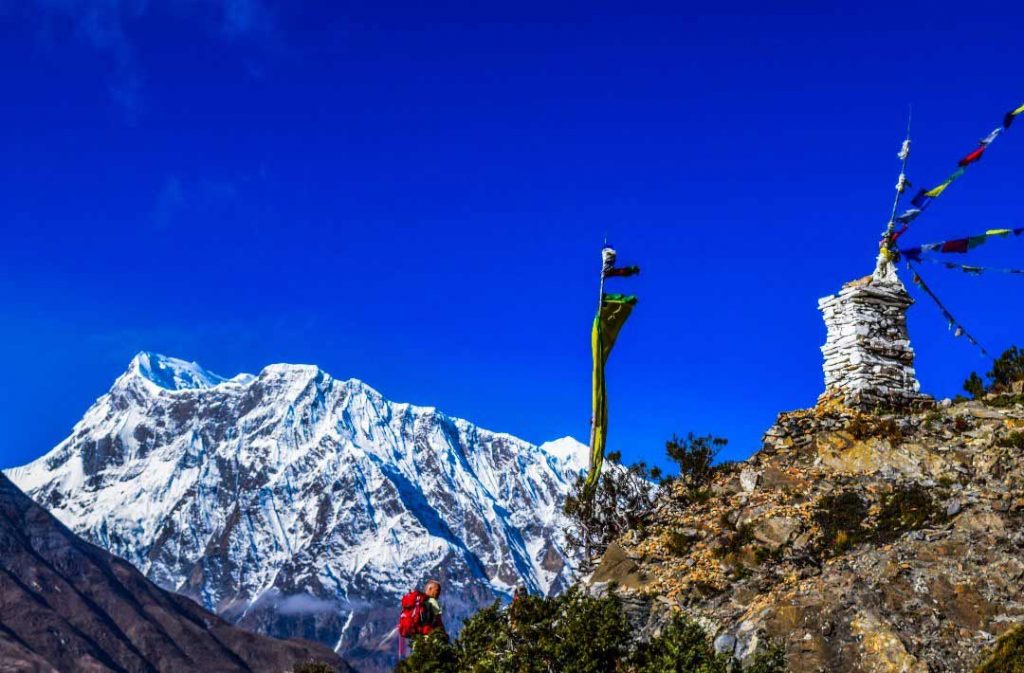
It is cost-effective if you eat your meal where you stay. Dal Bhat is probably the cheapest meal and most filling option too. Around $25 will cover three meals per day, regardless of what you choose to eat, and adding hot beverages.
Annapurna base camp trek cost from Pokhara reduces the cost of the flight from Kathmandu to Pokhara, which merely costs NRs. 9,000 to 10,000.
It takes 30 minutes from Kathmandu to land in Pokhara. The tourist bus fare may take 800 to 1200 rupees, and a local bus may cost 400 to 600 rupees, but it will take you 5 to 7 hours to reach Pokhara.
First of all, you need to fill out and submit TIMS (Trekker’s Information Management) form and ACAP (Annapurna Conservation Area Project) Permit form to receive the TIMS card and ACAP card.
These two forms will cost 5000 rupees, i.e., the TIMS permit costs 2000 rupees, and the ACAP permit costs 3000 rupees. Without a TIMS card and ACAP card, you won’t be able to enter Annapurna Conservation Area.
Accommodation
The accommodation costs around 200-400 rupees per room in teahouses. Solo travelers can plan 1500-2000 rupees expense each day while it reduces for group travelers.
The Annapurna base camp trek cost for Nepali and Indians is the same except for foreigners.
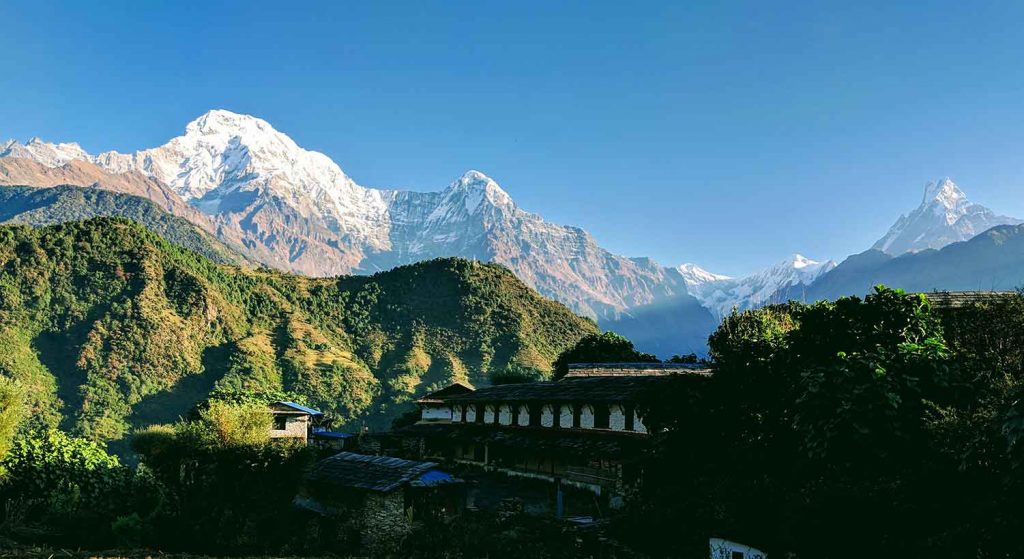
Annapurna Base Camp Trek Difficulty
Regarded as a moderate trek in Nepal, Annapurna Base Camp Trekking does not require tough physical fitness as demanded by other adventurous treks in Nepal .
ABC Trek gives you an excellent opportunity to try various traditional cuisines of Gurung and Magar ethnic groups as well.

It’s lovely to see Annapurna mountain covered with a snow blanket and most importantly, the fantastic view of sunrise from the hill. The best time to enjoy the Annapurna Base Camp trek should be considered if you want the weather to favor you.
Related Reading: Why is Annapurna so Deadly Mountain?
Trekking Tips for Trekking ABC
1. Prepare yourself physically and mentally
Annapurna Base Camp is a moderate type of trek as it doesn’t demand a high level of physical fitness, but it does require a certain level of fitness and enduring strength to complete the trek.
You need to train your body so you can endure the high altitude. Intense training and exercise are recommended 3 months before you head for the trek.
Muscle strength will help you walk for long hours during the trek. Training continuously will also help you prepare mentally. Try to run small uphills nearby and train your breathing.
2. Keep yourself hydrated
Trekking for long hours will definitely make you dehydrated, so you should carry a water bottle with you and drink it frequently. High altitude may cause you to suffer from AMS.
Drinking enough water will prevent you from feeling nauseous. While you train, drink enough water. Keep yourself hydrated daily. Eat lots of fruits and avoid junk foods.
3. Carry Annapurna Base Camp Trek Detailed Map
It is better to be aware of the paths, villages, trekking trails, places, rivers, and temples of Annapurna Base Camp beforehand. So carry the Annapurna trekking route map with you, and you’ll be on track while trekking. You’ll know where to go, and there will be less chance of getting lost for solo trekkers.
Also Read: Kathmandu to Annapurna Base Camp
Essential Trekking Gears and Packing List
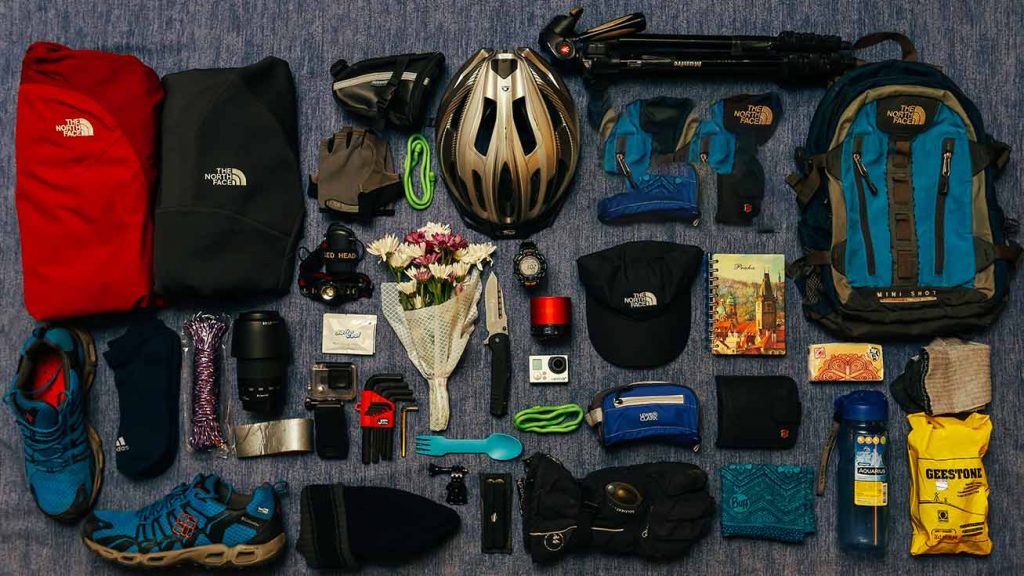
- Annapurna Base Camp Trek Route Map
- Spare battery, Power Bank
- A pair of gloves
- Warm clothes
- Down jacket, Down Pant
- Sunglasses, hat
- Few pairs of socks and underwear
- Trekking boots
- Energy bars and snacks
- First aid kit and essential medicines
- Toiletries, towel
Check out: Annapurna Base Camp Itinerary 10 days
Annapurna Base Camp Trek Altitude Profile
You start from the elevation of 1345m (from sea level) at Kathmandu. You fly from Kathmandu to Pokhara(820m) and trekking basically starts from Nayapul. The Chomrong village is at an elevation of 2170m. Machapuchare Base Camp is at an elevation of 3700m and finally, you reach an elevation of 4130m at Annapurna Base Camp.
That’s the highest elevation you’ll reach. After that, you’ll trek downhill to Bamboo at 2310m. Then, to Jhinu Danda at 1780m, back to Pokhara, and finally to Kathmandu.
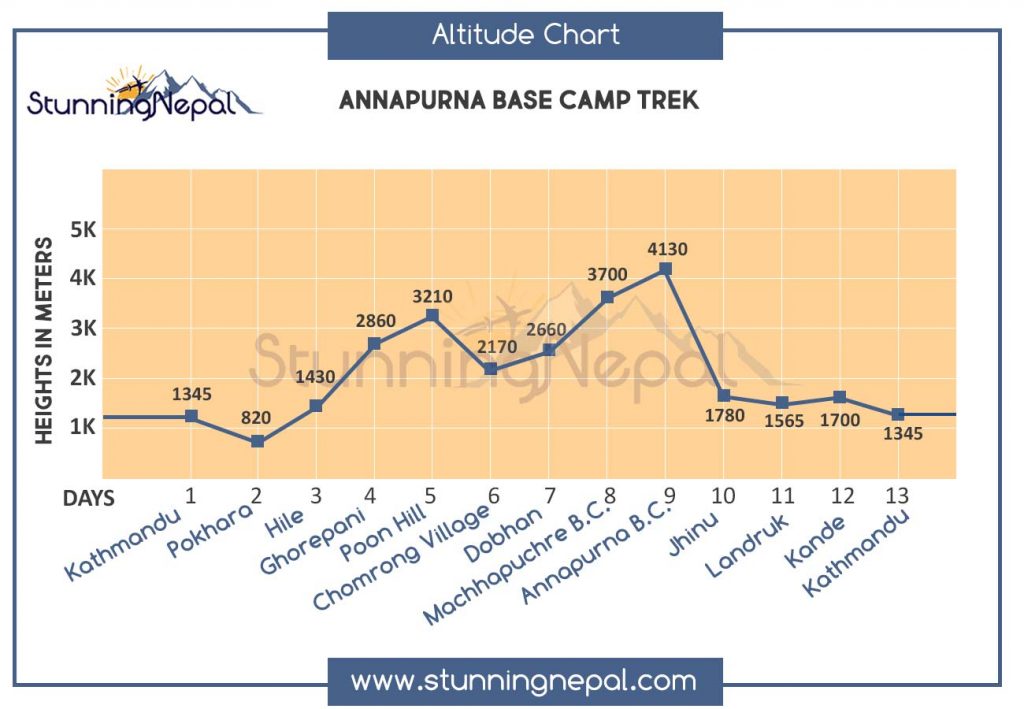
Frequently Asked Questions
Read Annapurna Base Camp Trekking Frequently Asked Questions by Visitors. Here you can view a video or read about it.
How long is Annapurna Base Camp Trek?
ABC trek is designed in such a way that the trek embraces the beauty of the Annapurna region’s landscape, forest, and mountain series. ABC short trek can be completed in 7 days if you stick by the itinerary of the Annapurna Base Camp short trek. Annapurna Base Camp’s long trek can be completed in 12-13 days if there occurs no kind of delay in between. The altitude of 4130 m is the destination of Annapurna Base Camp. There are various trekking packages that you can choose according to your convenience.
How to go to Annapurna Base Camp from Pokhara?
If you want to go to Annapurna Base Camp from Pokhara, then it’s very easy. You can even apply for permits upon arrival in Pokhara. From Pokhara, we will take a ride to Nayapul, from where our adventurous trek begins to Annapurna Base Camp.
How difficult is the Annapurna base camp trek?
Annapurna Base Camp trekking can be categorized as a moderately easy high-altitude trek in Nepal . The Annapurna circuit is moderately difficult. The trekking paths are not offbeat making it one of the chosen trekking destinations among first-timers. First-time trekkers can garner a pleasant experience without much toil. ABC trek does not require tough physical fitness. Anyone with an average level of robustness can reach the base camp within the expected duration. The difficulty also depends upon which time of year you go for the trek. It might not be difficult for experienced trekkers. Annapurna Base Camp trek can be quite easy for experienced trekking lovers.
Is Annapurna Circuit dangerous?
Annapurna is one of the 8000s whose beauty attracts a vast number of trekkers every year. Trekkers choose Annapurna Base Camp to observe the heavenly beauty of Annapurna mountain and other striking mountains in the vicinity, but the rewarding destination costs lots of difficulties. Yes! You might encounter problems in the Annapurna Circuit while passing the dangerous Thorung La, which is the world’s highest mountain pass. The climate of Annapurna is a bit unpredictable. The climatic condition may bring difficulties at times. You should be well-equipped and Eveready to turn back if you see potential danger while crossing Thorung La (5416m). The bad weather, massive snowfall, or storms can block the Thorung La Pass. You don’t want to challenge your life at that time. It’s wiser to return to the lodge. Many trekkers might suffer from altitude sickness. The trekking trails might not be conventional for first-timers. The high altitude of Annapurna may cause Acute Mountain Sickness (AMS), which brings difficulties in trekking. Once you elevate 3,500m, you’ll probably find difficulties in breathing.
Where is the Annapurna Base Camp?
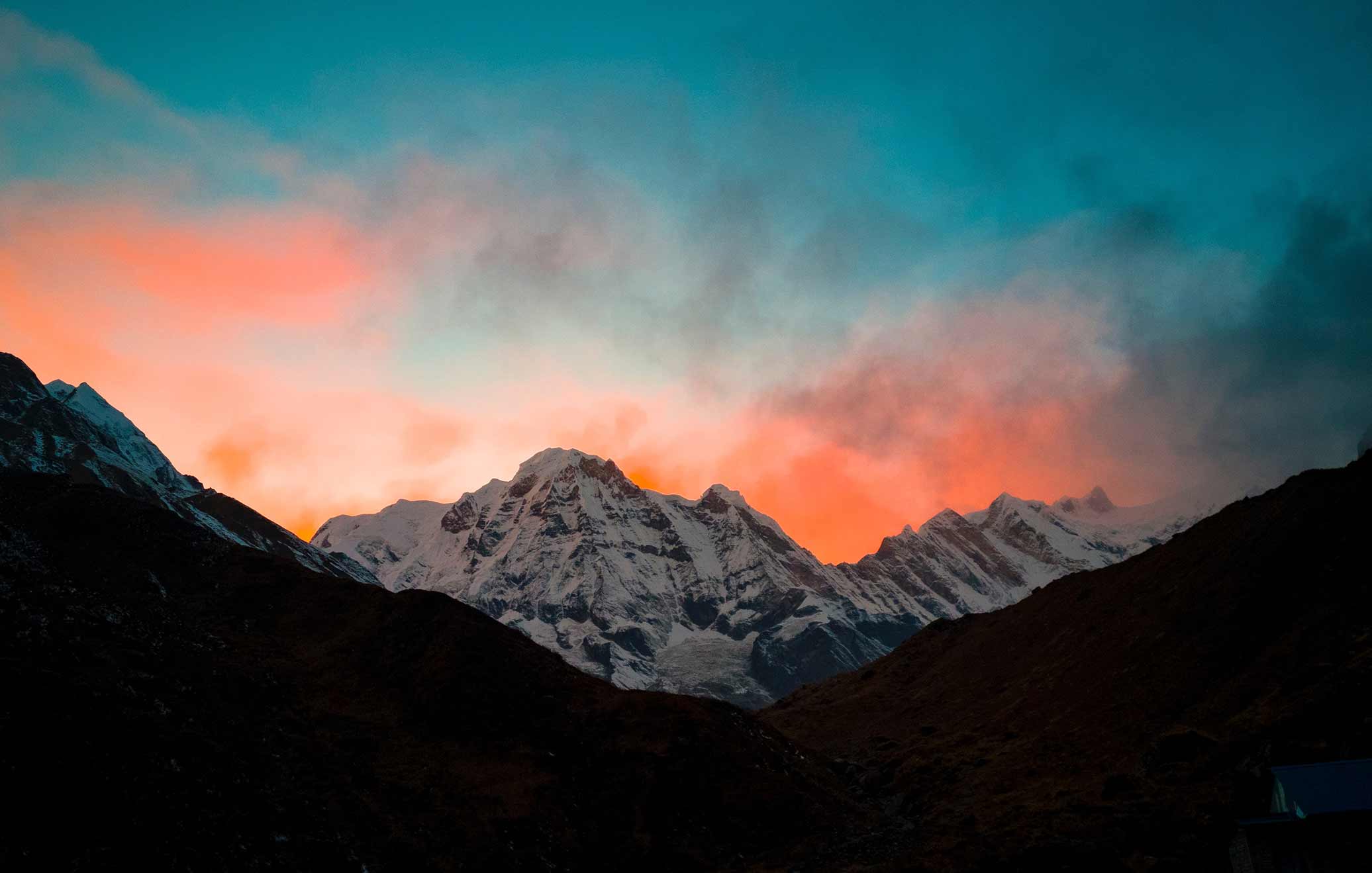
Is the Annapurna Base Camp trek safe?
Yes, Annapurna Base Camp is safe depending on the climatic condition. ABC can be attempted independently as it is safe. It is popular among solo trekkers too. It is a personal preference to go for a solo traveling to Annapurna Base Camp but traveling in a group is recommended. Traveling with a group has more benefits than traveling independently. The climatic condition of Annapurna is uncertain, so the uncertainty may bring difficulties while trekking. During such situations, being alone in the absence of networks can be dangerous.
Are there ATMs available on the way to ABC?
No, there are no ATMs on the ABC trek route. There are many ATMs in Pokhara and Kathmandu city. You can withdraw and exchange cash in Pokhara or Kathmandu as credit cards won’t work in the Annapurna Base Camp route. Don’t forget to carry enough Nepali currency.
Are the internet and charging accessible at ABC?
Yes. You will have enough internet access in some places but would cost you Rs. 200 a day for internet access. It is uncertain whether internet access in towns will be available and fast. Internet access may be slow and might shut down if the electricity goes out. If you are making an Annapurna base camp trek blog or vlog, then you are recommended to carry spare batteries for the camera. Do not depend on the electricity at ABC.
Is it necessary to hire Guides for Annapurna Base Camp trekking?
If you stick to the Annapurna Base Camp itinerary from the start till the end, it might not be necessary to hire a guide, but it solely depends on you. Annapurna Base Camp trek without a guide is appropriate for experienced trekkers but not strongly recommended for first-timers. The trekking guide will be sharing lots of facts and information during the trek. It would be a fun and exciting trek with the guide, and you would have to worry less about getting lost. The guide will be there during a problematic situation. An experienced guide will take care of your adventurous trek very well.
What about Annapurna base camp solo trekking?

How much is Annapurna Base Camp Trek Budget?
Annapurna base camp trekking price ranges from USD 1,000 to USD 1,200 for a 12-13 days trek. USD 500 might be enough for solo trekkers excluding other miscellaneous expenses. The price also depends upon the month you choose.
What are Annapurna Base Camp trek permits and cost requirements?
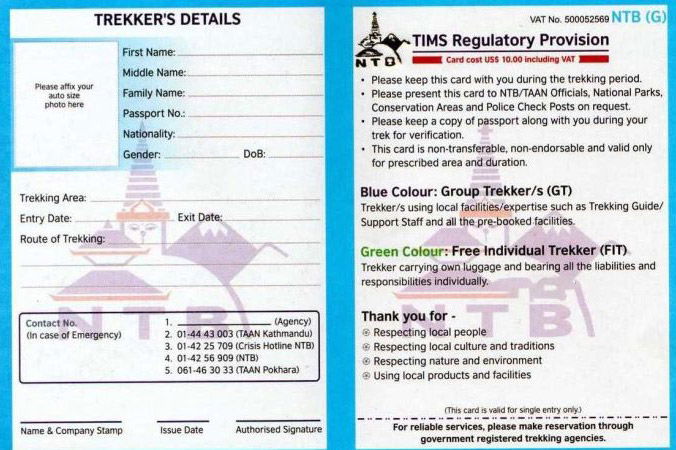
At last, we are going to share quick tips, Annapurna Base Camp trek can be the best choice to utilize your holidays with nature. Annapurna Base Camp is also the most preferred trekking in Nepal due to its unmatched beauty and adventure.
There are numerous trekking agencies in Kathmandu, Nepal that provide various ABC trek packages with various trekking routes and itineraries so one can get confused about finding the best trekking agency in Nepal.
Many trekking agencies have Annapurna base camp trek travel blogs on their website for your convenience. You can check out and solve some of your queries.
When choosing a travel agency in Nepal, do check their authenticity. Review their packages, accommodation facilities, budget, reliability, etc., and if you’re satisfied, only after then book the packages.
Be aware of the trekking map of the package you pick. You can contact travel agencies via telephone or other social media and gain information.
While inquiring, learn about the trek that you’ll be dealing with. You should feel comfortable and have a good rapport with them.
Moreover, if you are considering trekking at Annapurna Base Camp then this guide is definitely going to help you. Also, please leave a comment/feedback if you have any regarding ABC Trekking.
Happy Trekking and Traveling.
Love this post? Pin it for later
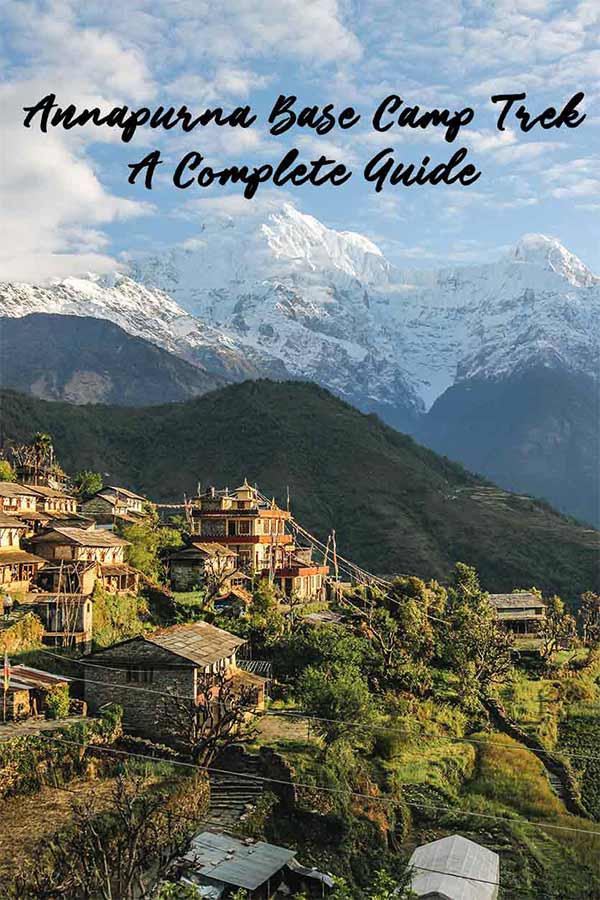
Suraj Katwal
Suraj is a travel enthusiast who believes in finding solace in the heart of nature. He enjoys exploring new destinations, different culture, and encouraging people to travel.
Travel Resources
Hotel & Flight
Searching for the best hotels & flight tickets to visit Nepal? Check out the best deals.
Related Articles...
5 Best One Week Treks in Nepal
Annapurna Base Camp Trek Cost for Nepali
Annapurna Base Camp Trek vs Everest Base Camp Trek
30 Interesting Facts About Mount Everest
Why is Annapurna so Deadly Mountain?
How to Find Travel Agency for Everest Base Camp Trek?
Annapurna Base Camp Trek Weather
Top 5 Family Trek in Nepal
4 thoughts on “Annapurna Base Camp Trek – The Definitive Guide”
Very well explained. Thanks for wonderful and detailed blog.
Welcome and Thank you for visiting my blog.
I’m very glad to have found this blog! What a great blog. Thanks!!! Wish to see more in the coming days.
Nice blog, very informative. Thanks
Leave a Comment Cancel reply
About stunning nepal.
Stunning Nepal is a travel blog that intends to provide travel tips, references & guides, things to do & also your guide for hiking & trekking in Nepal.
Travel Guide
Things To Do
Food and Festivals
Privacy Policy
Get in Touch
Stunning Nepal
Address: Dhanawantari Marg, Kathmandu 44600, Nepal
+977-9808211139
© 2024 Stunning Nepal. All Rights Reserved

The Nepal Trekking Company

Annapurna Base Camp Trek
- Best season March to May and Sept to December.
- Fitness level Normal
- Maximum Altitude 4,130 m
- Accomodation 3*** Accomodation in Kathmandu and Pokhara, normal accomodation in lodge / guest house during a trekking.
- Transportation Car and Tourist Bus.
- Meals Breakfast in the city and Breakfast, Lunch and Dinner in a mountain.
- Tour type Private or group Join.
- Group Size 02 pax to 50 pax.
- Departure City Kathmandu.
- Difficulty Medium
Annapurna Base Camp trek is considered as one of the ideal and most popular treks in the Annapurna region of Nepal. It is a mountainous region in the north central of Nepal.
Annapurna Base Camp is also known as Annapurna Sanctuary that collects highest peaks like Machapuchhre (6,993m), Mt. Annapurna I (8,091m), Mt. Annapurna II (7,939m), Mt. Annapurna III (7,555m), Mt. Annapurna IV (7,525m), Mt. Hiuchuli (6441m), Mt. Lamjung Himal (6,986m) and many other small and big Peaks.
During the Annapurna base camp trek you can see the various ethnic groups such as Brahman, Chhetri, Magar and Gurung community sharing their culture together. This is what the unique thing that you can see in different parts of Nepal. Here you can explore unique culture and lifestyle of people and also you will enjoy this place with natural hot spring which is another center of attraction. The visitors who comes here, completely feels new with tremendous environment.
Our trek to Annapurna base camp will be 10-12 days. We will reach at the maximum elevation of Annapurna Base camp which is 4140m. This trek takes you to a journey to discover beauty of lush rhododendron forest, various mountain ranges, more than 100 types of birds and animals, untouched remote villages, terraced rice paddies, high altitude landscapes and incredible forest region of the Annapurna. The Trekking route to Annapurna base camp provides you a true sense and pleasing nature and culture also local peoples are inhabitations to the foreigner style.
You can plan to go for the Annapurna Base Camp in all seasons but sometimes during winter the Base Camp is closed due to the high level of snow. But in spring time, the huge rhododendron forest in full bloom gives the trek an extra charm. Upon reaching the villages you will be warmly welcome by the people living here who make your heart refresh and delight. The trek begins from Pokhara where you will get opportunity to spend some times then will head toward Annapurna Base Camp Trekking passing through beautiful villages.
So, you are most welcome to explore Annapurna region with The Nepal Trekking Company. Similarly we have popular treks in Everest Region, Everest Base Camp Trekking is very popular one.
Trekking Itinerary
Day 01: Arrival at Kathmandu International Airport, Transfer to hotel
Day 02: Sightseeing Kathmandu Durbar square, Pashupatinath and application for the permits
Day 03: Kathmandu to Pokhara by regular tourist bus.
Day 04: Drive to Nayapul and trek to Ulleri (2,960m) 5hrs walk
Day 05: Trek from Ulleri from Ghorepani (2,780m) 5hrs walk
Day 06: Morning excursion to Poon Hill (3,210m) and treks to Tadapani (2,590m) 4hrs walk
Day 07: Trek from Tadapani to Chhomrong (2,340m) 5 hrs walk
Day 08: Trek from Chhomrong to Himalayan hotel (3,280m) 5 hrs walk
Day 09: Trek from Himalayan hotel to Annapurna Base Camp (4,130m) 5 hrs walk
Day 10: Trek from Annapurna Base Camp to Bamboo (2,335m)
Day 11: Trek from Bamboo to Jhinudada (1,610m) 4 hrs
Day 12: Trek from Jhinu Danda to Nayapul and drive back to Pokhara
Day 13: Drive back to Kathmandu
Day 14: Departure!!!!
The Nepal Trekking company has almost a decade of experience in tour, trekking, and expedition.
From touring the historic cities of Kathmandu, Pokhara, and Lumbini in Nepal, gently exploring nature through bird watching and hiking, to adventurous trips such as bungee jumping, trekking, or climbing, we have got you covered.
We have been rethinking, reshaping, developing, and conducting trips to Nepal, Tibet, Bhutan, and India. Once you sign up with us, you can sit back and have the time of your life.
We take care of everything from dealing with authorities and travel planning to safety measures. We strive to make your trip an unforgettable experience. If you are looking for short and sweet Annapurna Base Camp Trek, just click her.
Details Itinerary
On the very first day you will arrive in Tribhuvan International Airport, Kathmandu where you will be received by the representative staffs from The Nepal Trekking Company. Then, you will be transferred into the hotel in private vehicles. Taking some rest you will get to know the detail itineraries. Stay overnight in hotel.
On the following day we will wake up early as we have to set out for sightseeing and together with sightseeing we have to take trekking permits and carry out trek preparation as we are heading towards restricted areas. As a part of sightseeing we will cover Kathmandu Durbar Square, Pashupatinath temple and other places seeing the time. Stay overnight in hotel.
On the following day you will set out from Kathmandu to Pokhara taking a 6 / 7 hours, seeing your convenience. Arriving in Pokhara you will check into hotel and then after freshen up you can set out in the evening to explore Pokhara, the city of Lakes. Stay overnight in Pokhara.
On the next day you will take another illustrative drive towards Nayapul which is also recognized as the New Bridge. The voyage does not end here you will start an additional trek to Ulleri and it is positioned at an elevation of 2,960 meter, consuming 5 hours of walk. Ulleri is the village where you will discover several Magar communities. Stay overnight in Ulleri.
Spending a night at Ulleri today you will move to trek Ghorepani (2,780m), taking 5 hours. Ghorepani is an amazing destination from where you can have pleasant view of Annapurna range along with remarkable sceneries. Many visitors along with trekkers cannot stop themselves without praising Ghorepani. Stay overnight in Ghorepani.
On the following day you will wake up early in the morning so that you can carry out the morning excursion to Poon Hill which is to be found at an elevation of 3,210 meter. Taking some rest and breakfast you will trek into Tadapani and Tadapani is positioned at an elevation of 2,590 meter. The trek will make you to walk 4 hours of short stroll. Stay overnight in Tadapani.
From Tadapani you will move further on for trekking in Chhomrong (2,340m). The trek to Chhomrong consumes 5 hours. The trek is formulated all through the sharp downward all the way through the forests that will take hold to the Gurung village where the striking Gurung will be standing there with an eye-catching smile. Stay overnight at Chhomrong.
On the following day you will set out from Chhomrong to Himalayan hotel with an elevation of 3,280 meter. The representative staff will make you to walk 5 hours so that you can have rest in the hotel with warm greeting and services. In the evening you can move out to explore the surrounding areas. Stay overnight in Himalayan hotel.
On the next day you set into motion from Himalayan hotel to Annapurna Base Camp taking 5 hours of stroll. Here, the trail will make you appear with your dream completely covering Elevated Mountain which is too renowned as the Annapurna Sanctuary area. Towards the end of trek you can move to the Machhapuchhre Base Camp or trek on the Annapurna Base Camp after 2 hours. Stay overnight in Annapurna Base Camp.
On the next day you will take some time to stroll around in the vicinity of the Annapurna Base Camp. You will trek to look at the hidden valley after having the breakfast. Then from there you will carry on the trek to Bamboo by captivating 7 hours of extensive walk. Stay overnight in Bamboo.
Taking downward movement on the following day you will head to Jhinudada which is situated at an elevation of 1,610 meter and the trek covers 4 hours of short stroll. Jhinudada is the small and beautiful village which will later take you to Pothana. Stay overnight in Jhinudada.
On the next morning you will head to Nayapul after you depart from Jhinudanda and you will inward to Pokhara, taking a taxi another two hours. Being in Pokhara. Stay overnight in Pokhara.
On the following day you will wake up early Then, taking breakfast you will drive to bus station to back to Kathmandu. Then, you will be transferred into the hotel. Stay overnight in hotel.
On the last day of departure you will have breakfast and then check out from the hotel. Our representative staff will transfer you to the airport. From TIA, Kathmandu you will return your home town or towards next destination.
Service Includes
- Airport pick up and drop off.
- Kathmandu City sightseeing with car and tour guide.
- 3 nights twin share tourist standard hotel in Kathmandu on B.B plan.
- Ktm - Pok - Ktm tourist Bus.
- 2 nights twin share tourist standard hotel in Pokhara on B.B plan.
- Hotel to bus station and hotel car.
- Pokhara to Nayapul and Nayapul to Pokhara by Car.
- 08 nights mountain accomodiation and Daily Meals (Breakfast,Lunch and Dinner 3 cups of Tea/Coffee).
- 1 English Speaking,licence holder, frendly Guide, payed their foods and salary.
- Trekkers Informations Management System (Tims) card.
- Annapurna Conversation Area Project Permits.
- All land transfer as per itinerary.
- Company t-shirt.
- Company duffle bag.
- Trekking map.
- Company Service Charge.
- Farewell Dinner at authentic Nepalese restaurent with cultural show.
- First aid kit.
Service Excludes
- Nepal Visa fees.
- Entrance fees at UNESCO World Heritage Site. Approx $ 26 USD per person.
- Lunch and dinner in the city and highway.
- International flight tickets,airport departure tax.
- All the drinks such as bar and beverage bills,bottled water,desserts.
- Hot Shower during a trekking.
- Battery charge and internet / wifi.
- Bar and bevrage.
- Personal expenses, personal insurance for helicopter evacuation,additional accommodation or transportation land or air due to unforeseen,airport transfer.
- Tips for guide and crews.
- Anything not include on service includes column.
You can send your enquiry via the form below.
- Best Price Guaranteed
- No Booking Fees
- Professional Local Guide

Related Trips

Gosaikunda Pass Trekking
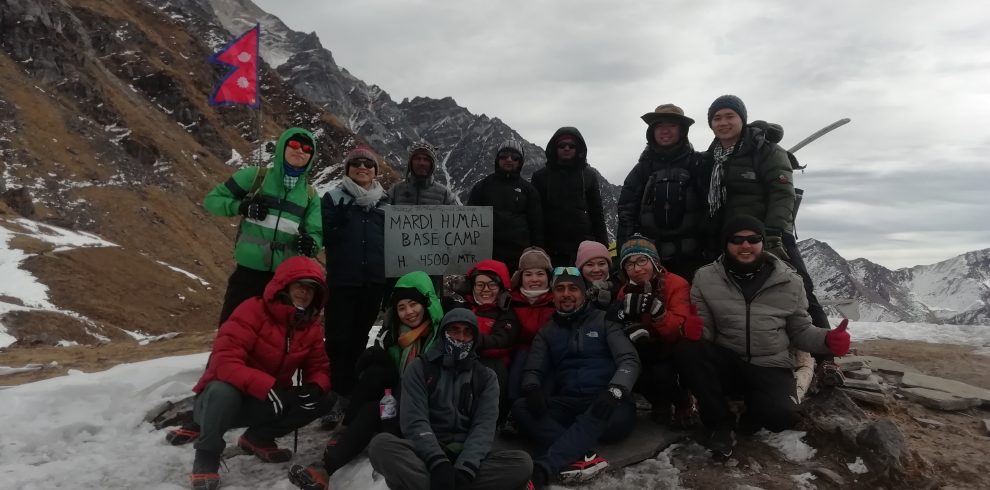
Mardi Himal Base Camp
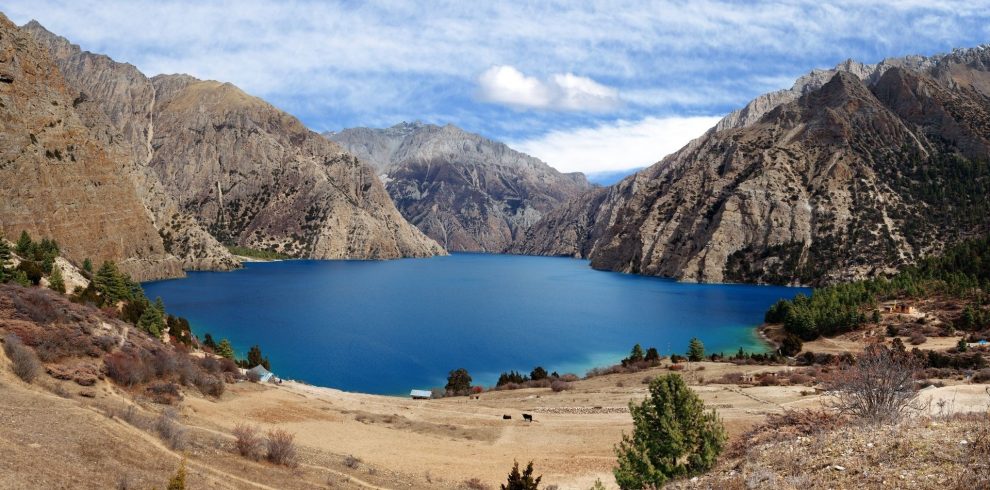
Lower Dolpo with Phoksundo Lake Trek

IMAGES
VIDEO
COMMENTS
Day 18: Trek from Tadapani (2,710 meters) to Naya Pul (1,070 meters) via Gandruk and then catch a short bus ride back to Pokhara. Please Note: From Muktinath onwards the classic Annapurna Circuit has been severely impacted by the road that joins Jomsom to Muktinath.
It's one of the world's classic long-distance hiking trails, and still one of Nepal's most popular treks. The Annapurna Circuit, a 12 to 21-day route that begins in the lush green villages of the Himalayan foothills.Taking trekkers over the 5,416m Thorong La Pass and down to the Tibetan-influenced temples and communities of the Mustang Valley.
The Annapurna Circuit and Beyond: Ultimate Guide to Hiking in Nepal (2024) Until 1951, Nepal was off-limits for foreign travellers; a secretive, isolated kingdom kept under wraps from outsiders…. But a change of regime gave birth to a new era of travel, and Nepal has remained a magnet for intrepid adventurers for over 70 years.
Annapurna Circuit Trek is a popular classic trek of Nepal. Each year, more than 60,000 trekkers come for this trek from all around the globe. In this trek, you encircle the Annapurna massif and cover between 110-130 miles by walking.
What Is the Annapurna Circuit? Located in central Nepal, the Annapurna Circuit is a long-distance trekking route that begins in the town of Besisahar and ends in Birethanti, encircling much of the Annapurna Massif along the way. The trail's namesake mountain is amongst the tallest in the world, standing some 8091 meters (26,545 ft) in height.
Since the trail opened in 1977, most trekkers have followed an Annapurna Circuit itinerary that begins in Besishahar and heads in an anti-clockwise direction over the Thorong-La Pass and down into the Jomsom Valley. The main reason for this is acclimatisation. When following the trail anti-clockwise, you have almost 2 whole weeks of ...
Days required: 10-13 days. Total Incline: 8000 meters. Total Decline: 7000 meters. The highest point on the trek: The two highest points on the trek are Tilicho Lake (4,919m) and the Thorong La Pass (5,416m). Difficulty: The difficulty of the Annapurna Circuit Trek depends a lot on how many days you have.
The Annapurna Circuit trek was once the most popular tea house trek in Nepal. In about a month it was possible to walk around the Annapurna mountain peaks. This trek was famous for its ethnic villages, natural beauty and easy access from Kathmandu or Pokhara. But the Annapurna Circuit trek has changed tremendously in recent years.
The Annapurna Circuit Trek is undoubtedly one of the most extraordinary and unparalleled experiences a trekker can avail themselves of. With an extensive length of 160-230 km that covers four distinct districts, comprising Lamjung, Myagdi, Manang, and Mustang, this trekking route stands out as the most preferred circuit through the diverse natural vegetation, cultural beliefs, landscape ...
The diverse landscape of the Annapurna region makes for a perfect trekking experience. It is an extensive range of peaks that has something distinctive and awe-inspiring. Therefore, it is one of the best trekking regions in Nepal, and trekkers globally make sure to do at least one Annapurna trek. Annapurna region offers varieties of hikes.
Rivalling Everest Base Camp for the title of most popular trek in Nepal, the Annapurna Sanctuary Trek is a 10-day extravaganza of non-stop mountain vistas culminating in a great cirque of massive mountain peaks seven to eight kilometres high. If you're looking for a short, relatively easy and simple-to-organise trek that doesn't venture too ...
Annapurna Circuit Trek. For scenery and cultural diversity, this has long been considered the best trek in Nepal and one of the world's classic walks. It follows the Marsyangdi Valley to the north of the main Himalayan range and crosses a 5416m pass to descend into the dramatic desert-like, Tibetan-style scenery of the upper Kali Gandaki Valley.
Trek through the incredible Annapurna region and be awed by the Nepalese Himalayas. These snow-capped peaks, mist-shrouded valleys, isolated communities and remote monasteries will inspire those with a bold spirit and a yearning for a definitive nature experience. Reach altitudes of more than 5000 metres, discover the ancestral traditions of ...
J oin The Explorer's Passage for one of the most extraordinary treks on the planet: the Annapurna Circuit. Stay at local tea houses as you follow this ancient Himalayan trade route, climbing through jungle-like terrain and rice fields, past canyons and waterfalls, and trekking among snowy peaks at Thorung La pass (17,768 feet / 5,415 meters ...
The Annapurna Circuit is a trek within the mountain ranges of central Nepal. The total length of the route varies between 160-230 km (100-145 mi), depending on where motor transportation is used and where the trek is ended. This trek crosses two different river valleys and encircles the Annapurna Massif. The path reaches its highest point at ...
Annapurna Base Camp (ABC) Trek is one of the most popular treks in Nepal. It is quite easy and shorter trek than other high altitude treks in Nepal. This trek incorporates diverse terrain, culture, and wildlife. Along with the most spectacular and close up view of Annapurna range, Machhapuchhre, Hiunchuli, and Dhaulagiri. In Spring, it...
Stingy Nomads (Campbell & Alya) at Annapurna Base Camp in Nepal. Trekking in Nepal is an incredible experience. ABC trek is one of the most spectacular routes in the region. Many trekkers choose this route as a shorter and cheaper alternative to the Everest Base Camp trek.Annapurna Base Camp is surrounded by some of the highest peaks in the world; Annapurna I (8091 m), Annapurna South (7219 m ...
The Annapurna Sancturary Trek costs anywhere between $2,000 and $3,500. Ideally, you should complete the trek using a top trekking agency in Nepal. However, you also have the cheaper option of completing the trek unsupported. which could be done for as little as $1,000.
The Everest trek gets you closer to the heart of the high mountains than the Circuit, which offers more in the way of traditional village life. Finally, Everest Base Camp is an out-and-back trek, so you'll repeat some sections, whereas Annapurna is by its nature an A to B loop. Annapurna's trails start an hour's drive from the town of Pokhara ...
Why Annapurna Base Camp Trek is a must do trek. Panoramic Vistas: The trek unfolds a mesmerizing panorama of the Annapurna Massif, including Annapurna I (8,091m), Machapuchare (6,993m), and Hiunchuli (6,441m). ... Nepal entry visa (approximately $40 USD) only for foreigners (Not for Indians) 5.
The Annapurna Circuit is a pilgrimage along the sacred trails of the Nepali people. Overflowing with history, its remote villages and monasteries display the religious and cultural intertwining of Hinduism and Buddhism. Life has remained almost unchanged here for centuries. At around 18,000 feet, you'll reach the pinnacle of the trek—the ...
Annapurna Base Camp Trek also known as ABC Trek is undoubtedly one of the best high-altitude treks in Nepal. The spectacular range of Annapurna mountain lies in the Annapurna region, which is the western region of Nepal. Nepal is home to 8 of the world's highest peaks in the world, and one of them is the majestic massif of Annapurna mountain.
Annapurna Base Camp trek is considered as one of the ideal and most popular treks in the Annapurna region of Nepal. It is a mountainous region in the north central of Nepal. Annapurna Base Camp is also known as Annapurna Sanctuary that collects highest peaks like Machapuchhre (6,993m), Mt. Annapurna I (8,091m), Mt. Annapurna II (7,939m), Mt ...
A royal trek by Britain 's Prince Charles - now King Charles - in 1980 through the foothills of the Annapurna, plus a stopover by Prince Philip at Tiger Tops in 1986, further elevated Nepal ...
72 likes, 0 comments - nepal_mountain_trek_guide on April 23, 2024: "Annapurna CIrcuit Trek 2024 Thorongla Pass Trek 5416m Manang Valley Trek If you want to do this trek feel free to contact us.Booking Op ...